
Home » Travel Guides » Vietnam » 25 Best Things To Do In Hue (Vietnam)

25 Best Things To Do In Hue (Vietnam)
Hue is one of the most charming towns in Vietnam and is located on the banks of the beautifully named Perfume River. This part of Vietnam has a long and illustrious history as it used to be one of the main royal capitals of the country. As such, history lovers will find a huge amount to enjoy here, from the rambling ancient architecture to the engaging museums that will fill you in on all the details. Many people come here in particular to check out the ancient tombs of former emperors which are dotted all over the city and provide you with a fascinating insight into Hue in the days of old.
As this is a riverfront town, you will also be able to spend time enjoying the cool breezes and the pretty vistas as you stroll along the riverside walkway, and if you want to get out of the town center than you will also be spoiled for choice. There are a number of fascinating day trip locations close to the city, which means that can happily spend a week in Hue and still not see and do everything that this pretty part of Vietnam has to offer.
Here are the best things to do in Hue …
1. Visit the Tombs of the Ancient Emperors

One of the big draws in Hue is the tombs of the Ancient Emperors and this is the main reason why so many visitors travel here every year.
Anyone with an interest in ancient architecture and history needs to visit the tombs which were built in honor of famous emperors of Hue.
The tombs mostly date from the 19th and 20th centuries and are carved to tell the stories of Buddhist legends.
Some of the main tombs not to miss include the Tomb of Tu Duc, the Tomb of Minh Mang and the Tomb of Khai Dinh.
If you are not sure which tombs to visit on a trip here then you can take a dedicated guided tour.
Included in : Hue Full-Day City Group Tour Including Lunch
2. Visit the Tu Hieu Pagoda

Tu Hieu Pagoda is one of the most famous in all of Hue and dates from 1843. This pagoda was also the home of eunuchs during the times of the Ancient Citadel in Hue and nowadays some 70 monks live here.
When you visit you can enjoy two towering temples and also listen to the monks chanting throughout the day as part of their religious rituals.
3. Walk along the Perfume River

The Perfume River is one of the most famous waterways in Vietnam and Hue is the perfect place to take it all in.
There is a delightful waterfront promenade along the banks of the river and this makes a great place to come for a scenic walk in the evenings.
You can also take to the water yourself if you want to get a closer look at the river and rent a paddleboat or opt for an elegant dinner cruise.
This tour includes a dragon boat trip on the Perfume River: Hue Full-Day City Group Tour Including Lunch
4. Sample the food

Hue is often said to have some of the best food in Vietnam and with that in mind you need to make sure that you sample all the delights on a trip here.
As Hue was once one of the most important royal cities in Vietnam, it was also one of the premium producers of famed Imperial Banquets.
Many restaurants all over town still serve these in the traditional style and you can sit down and enjoy a meal that unfolds over multiple courses.
If you are looking for a sweet treat in the city then make sure to check out the local candy which is made of sesame seeds.
Suggested tour : Hue: 5-Hour Street Food Tour by Motorbike
5. Explore Huyen Tran Princess Temple

The Huyen Tan Princess Temple consists of a large complex which is covered with lakes of lotus flowers.
The monastery of Emperor Tran Nhan Tong is also located here and you will also be able to stroll in picturesque orchard gardens when you visit.
Other highlights include a library which holds important documents relating to previous kings and historical figures during the Tran Dynasty.
6. Visit the Imperial Citadel

The Imperial Citadel in Hue would have been the previous center of the government and is made up of a vast complex.
When you walk around you can admire the moats, carved gates and royal pavilions, and there are also a clutch of engaging museums on the grounds.
If you like Vietnamese costumes, textiles and art then make sure not to skip the main galleries here.
7. Have a blind massage

If you want to support the local community and also relax and unwind at the same time, then you need to make an appointment at the Institute of the Blind.
Here you will find a number of blind massage staff who will give you a massage and all the proceeds go to helping those who live at the institute find employment.
At the end of the massage you will also get to spend time in the onsite herbal steam room.
8. Admire the Thien Mu Pagoda

Another famous pagoda in Hue is the Thien Mu Pagoda.
This temple sits overlooking the Perfume River and is known for its gold and silver images of the Buddha.
The pagoda is so well known in Vietnam that it is also the official symbol of Hue and you can take in beautiful views over the city from this spot.
Other highlights to look out for inside include a huge bells that was cast in 1710 as well as a stone turtle which dates from the 17th century and holds a marble stele.
9. Visit Phu Bai Airport

Phu Bai Airport is actually no longer a working airport but a museum dedicated to Vietnamese war history.
The airport would have operated as an American garrison during the Vietnam War and you can tour around the complex and even walk on the old, deserted airstrip here.
As well as the former runway, you will also find other historical relics such as bunkers and outbuildings that would have been used by the American military.
10. Soak in the Alba Thanh Tan Hot Springs

If you want to get outside Hue then head to the Alba Thanh Tan Hot Springs which is around 30 kilometers from the city center.
Here you will find one of the most famous hot springs resorts in Vietnam and there are a number of outdoor tubs available here.
You can also enjoy designated therapy rooms where you can get a soothing massage or other spa treatments.
There are also other quirky activities on offer here such as a high wire and a zip line, or you can play water games in the aqua park.
11. Visit the Royal Theatre

The Royal Theatre was constructed in 1826 and the National Conservatory of Music was then built on these foundations.
You can come here to watch a performance of traditional Vietnamese dance and music, or you can visit to tour the spacious galleries.
The exhibitions are made up of traditional masks as well as local Vietnamese musical instruments.
The performances are held according to a rotating schedule and usually last around 45 minutes.
12. Cycle around the city

Hue is often said to be one of the nicest cities in Vietnam to cycle around.
You will find far less traffic here than in other parts of the country and you can also cycle along the lush banks of the Huong River and visit all the key attractions for which Hue is famous.
You can either just rent a bike and go it alone, or you can also join a dedicated cycling tour with a guide that will take you around Hue or out into the surrounding countryside.
13. Take a photo at the Hue Sign

Anyone looking for a modern side of Hue needs to head to one of its newest attractions with is known as the Hue Sign.
Visitors flock to this spot in the city which is located in February 3 Park and includes a colorful illuminated sign that says ‘I Love Hue’. This installation is known as a premium place in the city for a photo opportunity and you can also enjoy the leafy park at the same time.
14. Shop at the Hope Center

The Hope Center is a project that has been set up to help disabled and disadvantaged residents in Hue find employment.
The center makes a number of garments and you will find amazing local handicraft items.
Some pieces to look out for include cloth which is woven by hand by A Luoi women and you will also find other items like bags, purses, scarves and even traditional jewelry for sale.
15. Journey to Bach Ma National Park

Bach Ma National Park is located at 1,450 meters above sea level and encompasses some of the prettiest scenery in all of Hue.
On a visit here you will find towering waterfalls as well as pretty hiking trails and there are several crumbling French villas to observe along the way.
The park is part of the wider Annamite Range and this part of Vietnam is known for its lush landscapes.
You can also combine a trip here with a stop off at the Cau Hai Village.
There is also the option to stay overnight here at the camp ground of you can just spend the day swimming in limpid pools and taking in the flora and fauna.
16. Visit the Ho Quyen Tiger Fighting Arena

The Tiger Fighting Arena is situated around three kilometers outside of the center of Hue proper and was erected in 1832. As such, it was built during the time of the Minh Mang Dynasty and would have been the venue for dramatic fights between tigers and elephants.
Nowadays you won’t find any more fights here (luckily!) as these were stopped in the 1900s but you can still take in this great monument to history and if you look closely there are even claw marks pocking the crumbling walls.
17. Admire Hon Chen Temple

Hon Chen Temple is dedicated to Po Nagar who is the Goddess of the Cham population who would have been based in Ngoc Ho Village in the days of old.
The shrine sits in on top of a craggy cliff in Ngoc Ho Village and was restored several times, first in 1832 and then again in 1886. The temple now has several antiques of interest such as a number of ancient vases, some Chinese calligraphy and ornate animal carvings.
If you come here on the third and seventh lunar month of the year then you will also find local music and dance performances.
18. Take a trip to Elephant Springs

Located between Hue and neighboring Da Nang, Elephant Springs is a top spot for anyone who wants to visit a famous springs in the area without the crowds.
Elephants Springs is far less visited by tourists than other springs around Hue and this attraction got it name thanks to the boulders that surround the waters and are said to resemble elephants playing.
There is also a carved elephant stone which has water squirting from its trunk and the pools here are cool but also make a great place to come if you want to relax in the middle of the jungle.
19. Take a Huda Brewery Tour

If you want to get a drink in Hue then consider signing up for a Huda Brewery Tour.
Located close to Phu Bai Airport, you can come here and see how Danish technology is being used to make a variety of delicious local brews.
You can tour the factory and learn about the history of the Huda brand and you will also get the chance to sample some of the different beverages available.
20. Shop at Dong Ba Market

Dong Ba Market is one of the premium shopping spots in Hue if you are looking for a dose of authenticity in the city.
Here you will find a flea market as well as a number of toothsome local food stalls.
This spot was made famous when celebrity chef Anthony Bourdain came here and filmed an episode of his show ‘No Reservations’. Bourdain sampled the Bun Bo here but you will find a huge number of other dishes including noodle soups and spring rolls.
21. Sunbathe on Thuan An Beach

Around 14 kilometers outside of Hue is Thuan An Beach, so if you fancy some sea and sun then this is the spot for you.
Part of the Phu Van District, Thuan An Beach consists of a long strip of fluffy sand and many locals claim that this is one of the most beautiful beaches in Vietnam.
Activities here include swimming and sunbathing and the main season here runs from May to September when temperatures in Hue rise.
22. Visit the Royal Antiquities Museum

If you like antiquities then head for the Royal Antiquities Museum where you will find a wide variety of different pieces that date from the Nguyen dynasty from 1802 to 1945. As you walk around the different galleries you will be able to enjoy traditional furniture as well as textiles, jewelry and other antiques that used to belong to the royal family.
There are seven different zones inside the museum and you should make sure to check out the ornate beams which are carved with sculptures of dragons.
23. Walk across the Thanh Toan Bridge

Thanh Toan Bridge is the most famous bridge in Hue and is said to date back some 200 years.
The bridge spans the Nhu Y River and is made up of a wooden platform which is topped with a tiled roof.
The bridge only stretches for 17 meters but it also has a shrine located inside which is dedicated to the patron of the structure.
You will find the bridge around 10 kilometers to the north of the city and this is a great place to come to see a more authentic side of Hue as this is also a residential neighborhood.
24. Visit the Healing the Wounded Heart Shop

The Healing the Wounded Heart Shop is the place to come in Hue if you want to pick up some gifts or souvenirs while also helping the local community.
The shop sells a range of handicrafts which were made by disabled artisans in Hue and many of these use recycled materials such as soda cans.
All the profits of any items you buy are then funneled back into the local community and used to fund heart surgery for local impoverished children.
25. Have dinner at Ancient Hue Royal Cuisine and Gallery

One of the best known restaurants in Hue is Ancient Hue Royal Cuisine and Gallery which serves delicious food and is located inside an ancient housing complex.
The food is a mix of local and international faer and although it is a little pricier than other restaurants in the city it is more than worth it if you are in the mood for some upscale dining.
They also serve cold beer so this is a great place to unwind after a day of sightseeing.
25 Best Things To Do In Hue (Vietnam):
- Visit the Tombs of the Ancient Emperors
- Visit the Tu Hieu Pagoda
- Walk along the Perfume River
- Sample the food
- Explore Huyen Tran Princess Temple
- Visit the Imperial Citadel
- Have a blind massage
- Admire the Thien Mu Pagoda
- Visit Phu Bai Airport
- Soak in the Alba Thanh Tan Hot Springs
- Visit the Royal Theatre
- Cycle around the city
- Take a photo at the Hue Sign
- Shop at the Hope Center
- Journey to Bach Ma National Park
- Visit the Ho Quyen Tiger Fighting Arena
- Admire Hon Chen Temple
- Take a trip to Elephant Springs
- Take a Huda Brewery Tour
- Shop at Dong Ba Market
- Sunbathe on Thuan An Beach
- Visit the Royal Antiquities Museum
- Walk across the Thanh Toan Bridge
- Visit the Healing the Wounded Heart Shop
- Have dinner at Ancient Hue Royal Cuisine and Gallery

25 BEST Things to Do in Hue, Vietnam (2024 Edition)
- Last Updated: January 25, 2024
You’ll be blown away with this ultimate list of the best things to do in Hue, Vietnam, from the Imperial Citadel to the Dong Ba Market and more!
The ancient city of Hue, located on the Perfume River, may not be as famous as Hoi An or Hanoi but it is just as captivating.
The former Imperial City was the intellectual and cultural heart of Vietnam until the early twentieth century.
There are plenty of amazing things to do in Hue and it is a rewarding addition to any Vietnam itinerary.
Exploring the city gives glimpses into the luxurious lives of Vietnam’s former emperors plus a great introduction to modern Vietnamese life.
The must-see sights of Hue, Vietnam include crumbling, ornate royal tombs hidden away in sublime jungle settings, an imposing citadel filled with carefully restored gardens and palaces, and iconic pagodas famous throughout Vietnam.
History aside, modern Hue is a wonderfully diverse and dynamic city.
Table of Contents
1) Walk Through the Imperial Citadel (Kinh Thanh)
2) visit the forbidden purple city, 3) stroll through the imperial city, 4) take in a performance at the royal theatre , 5) walk around the thien mu pagoda , 6) enjoy the co ha gardens , 7) walk around the thai hoa palace, 8) explore the to mieu temple complex, 9) visit the royal tomb of minh mang , 10) marvel at the hue museum of royal fine arts, 11) enjoy the hue festival, 12) relax along the riverside promenade , 13) try some royal delicacies, 14) eat with the monks, 15) meander around the dong ba market, 16) pay respects at the khai dinh tomb, 17) go on a motorbike tour, 18) take a detour to thanh toan bridge , 19) take a lunchtime or dinner cruise along the perfume river, 20) chill out on the beach, 21) discover the story of one of vietnam’s darkest hours , 22) learn about war history just minutes from the citadel, 23) visit the royal tomb of tu duc , 24) shop for social justice , 25) visit bach ma national park, wrapping up what do in hue, vietnam, the best things to do in hue, vietnam.
Accommodation options range from luxurious modern hotels competing with crowded alleyways full of cheap backpacker hostels.
An attractive promenade lines the banks of the Perfume River and museums, handicraft centres and renowned restaurants will keep tourists busy all day and well into the night.
Regardless of what brings you to the city, you are not likely to run out of things to do in Hue, Vietnam!
READ MORE: Plan your trip to Vietnam with our Vietnam Travel Guide !
The Imperial Citadel is definitely a Hue top attraction. Built two hundred years ago during the Nguyen Dynasty, the fascinating Citadel is in the process of being carefully restored to its former glory.
A UNESCO World Heritage site , the Imperial Citadel and its vast contents will need at least a day to fully appreciate.
The sturdy security features designed to protect the Vietnamese royal family are crumbling but still impressive.
The deep moat, 10 impressive gateways, and thick stone walls that once kept enemies out, now entice tourists in.
It’s recommended that visitors buy a “package tour ticket” valid for two days when they arrive.
This joint ticket includes entrance to all areas of the Imperial Citadel, including the Imperial City and several of the Royal Tombs located just outside Hue.
If you don’t enjoy walking around in the heat, there are bicycles and golf-cart tours available near the entrance.
This is among the many places that make Hue a great city to explore with children .
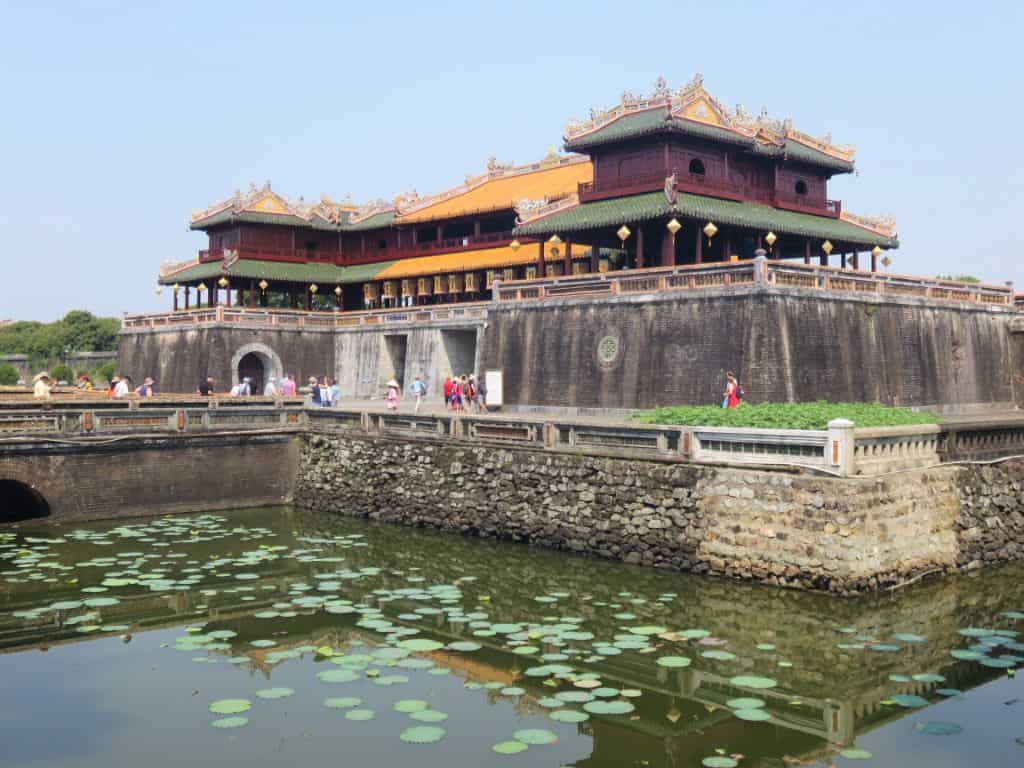
The heart of the Imperial City Enclosure was the Forbidden Purple City, a private space accessed only by royalty and select servants.
However, due to war damage, almost nothing remains today of the Emperor’s personal rooms. The overgrown remains are atmospheric.
Take a moment to imagine the eunuchs once serving the Emperor in this lost palace.
The only part of the Forbidden Purple City to survive the twentieth-century wars is the Emperor’s Reading Room .
The exquisitely decorated outer walls and roofs are adorned with poems and mosaics.
Here, visitors can get a taste of the opulence in which the Emperors lived.
Whilst the Citadel might be at the heart of the city, the Imperial City is the heart of the Citadel.
Badly damaged in the Vietnam War, what is left of the Emperor’s private residences and temples are nonetheless magnificent.
The remains of the Imperial Enclosure will take at least a few hours to really explore and get off the beaten track.
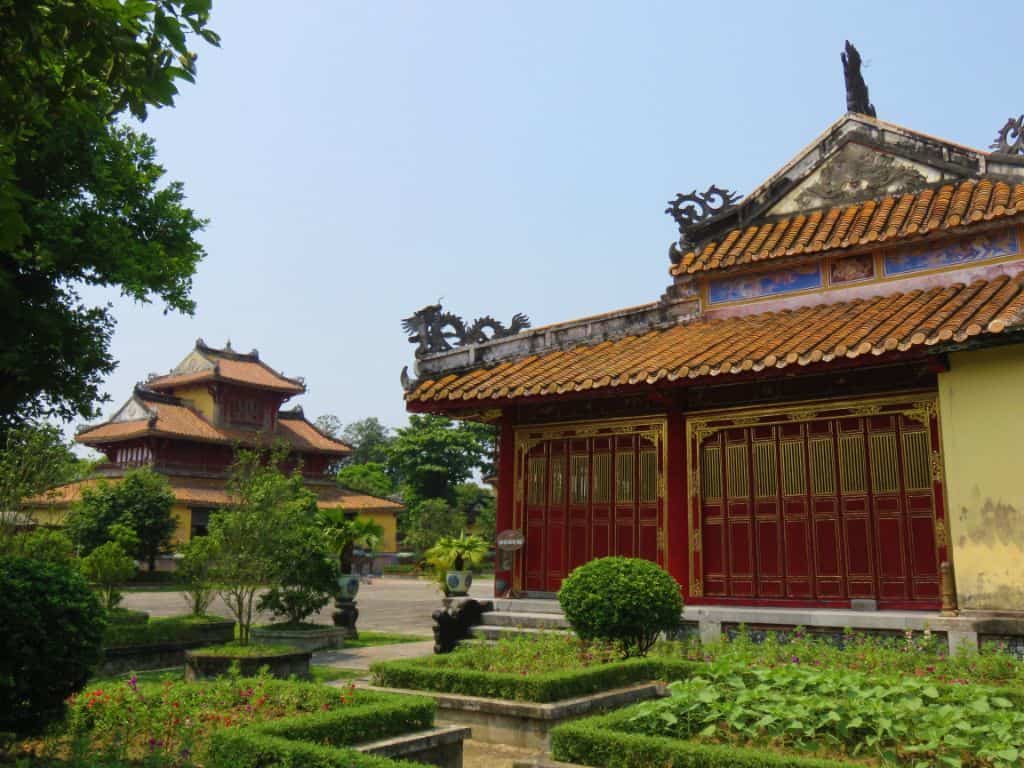
Interested in what to do in Hue that demonstrates the beautiful culture of the Vietnamese people? The living soul of the restored citadel is the Royal Theatre.
Every day, lavish cultural dances and plays are performed for tourists resting like royalty in the plush chairs.
Performances take place at 9 am, 10 am, 2.30 pm, and 3.30 pm. Entrance fees apply.
One of the most famous pagodas in Vietnam is the Thien Mu Pagoda.
Occupying a striking position on a hill on the bank of the Perfume River, the 21-metre tall tower was built in 1844.
The pagoda has eight sides and seven stories. The pagoda gets very busy and it’s difficult to tell if the tourists or the cicadas are noisier!
Dieu De National Pagoda and Bao Quoc Pagoda are also worth visiting for fine architecture and fantastic views. All three pagodas are free to visit.
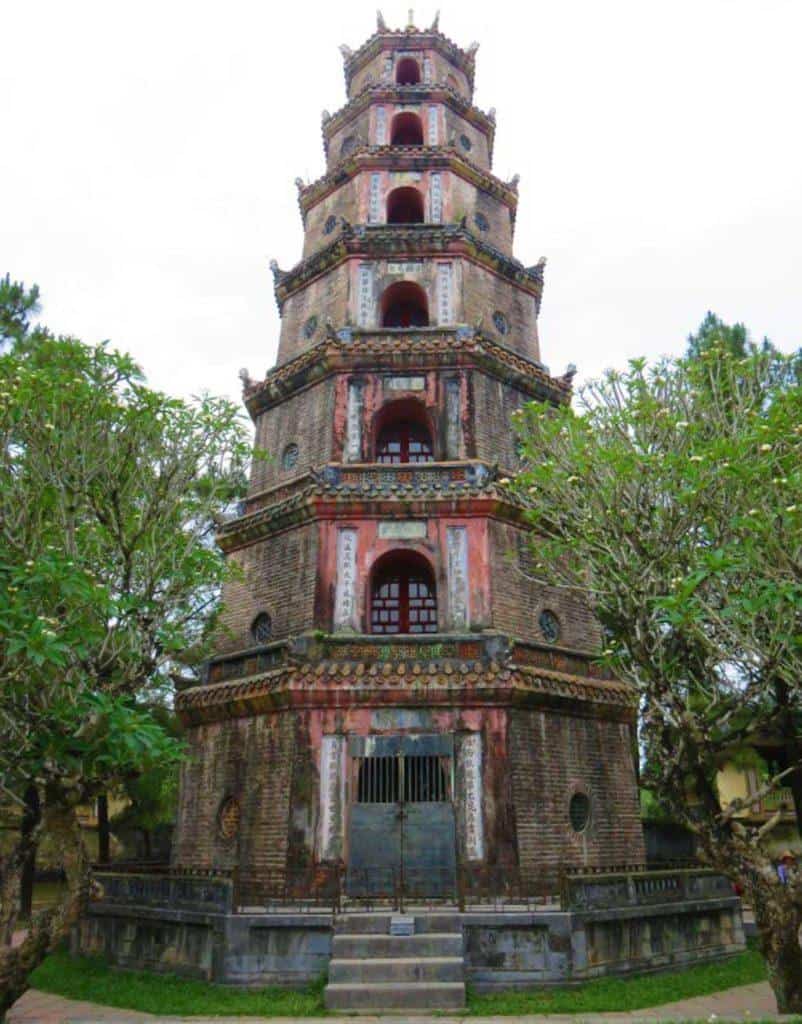
These wonderful gardens in the Northeastern corner of the Imperial Enclosure have been carefully restored.
Tranquil streams, ornate gazebos, and colourful flora will entice you to linger and enjoy the fresh air.
Aside from the armies of gardeners maintaining the gardens, the Co Ha Gardens are a peaceful and relaxing spot to wander around just as the Royal families once did.
READ MORE: Be sure to check out these 33 must-do things to do in Vietnam !
Historically, Thai Hoa Hall was the location for the Emperor’s official functions when he would greet visitors from his throne.
The inside of the palace is decorated with luxurious red and gold lacquer.
The palace has been carefully restored and visitors can watch audiovisual shows to find out more about the Citadel’s history and architecture.
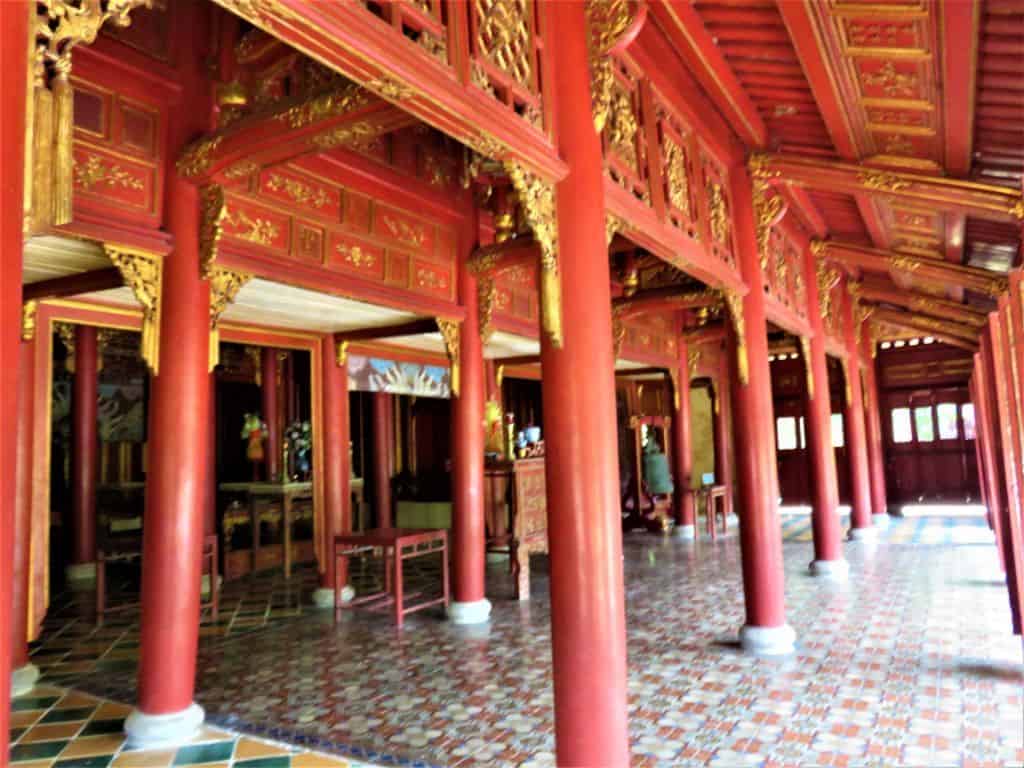
As part of your Hue sightseeing, you should plan to visit the To Mieu Temple complex.
Entering this walled complex within the Imperial Enclosure leads visitors to the stunning Hien Lay Pavilion , a three-tiered pavilion that has been beautifully restored and painted.
Opposite the pavilion is the To Mieu Temple which contains shrines commemorating each Emperor.
Also in the To Mieu Temple Complex, watch out for the famous Nine Dynastic Urns .
Each giant urn (dinh) is dedicated to a Vietnamese emperor.
Other memorable parts of the Citadel to visit are the imposing Ngo Mon Gateway (near the ticket office), the attractive Dien Tho Residence, and the recently restored Halls of the Mandarins filled with golden Buddhas and elaborate murals.
The reach of the former Emperors extends far beyond the Citadel and Hue itself.
Each emperor commissioned an imposing mausoleum to be built in their honour.
Situated along the Perfume River are seven (known) tombs dedicated to the Emperors.
Four of the tombs, Gia Long , Thieu Tri , Duc Duc , and Dong Khanh are less well-known and not usually included on popular tour itineraries.
It is possible to visit them but bear in mind that they may not be well looked after.
The main Royal Tombs visited by tourists are Khai Dinh , Tu Duc , and Minh Mang , all of which are beautifully cared for and open daily.
The best way to visit this place is by booking a Hue city tour on Klook .
A huge complex this tomb deserves dedicating some real time to explore.
Said to contain more than 40 structures, Emperor Minh Mang didn’t live to see his tomb completed but he would have been proud.
The surroundings are beautiful and it is a much more peaceful place to visit than the other main tombs.
As well as the Royal Tombs and Citadel, Hue boasts several famous pagodas to add to its exhaustive collection of Royal buildings.
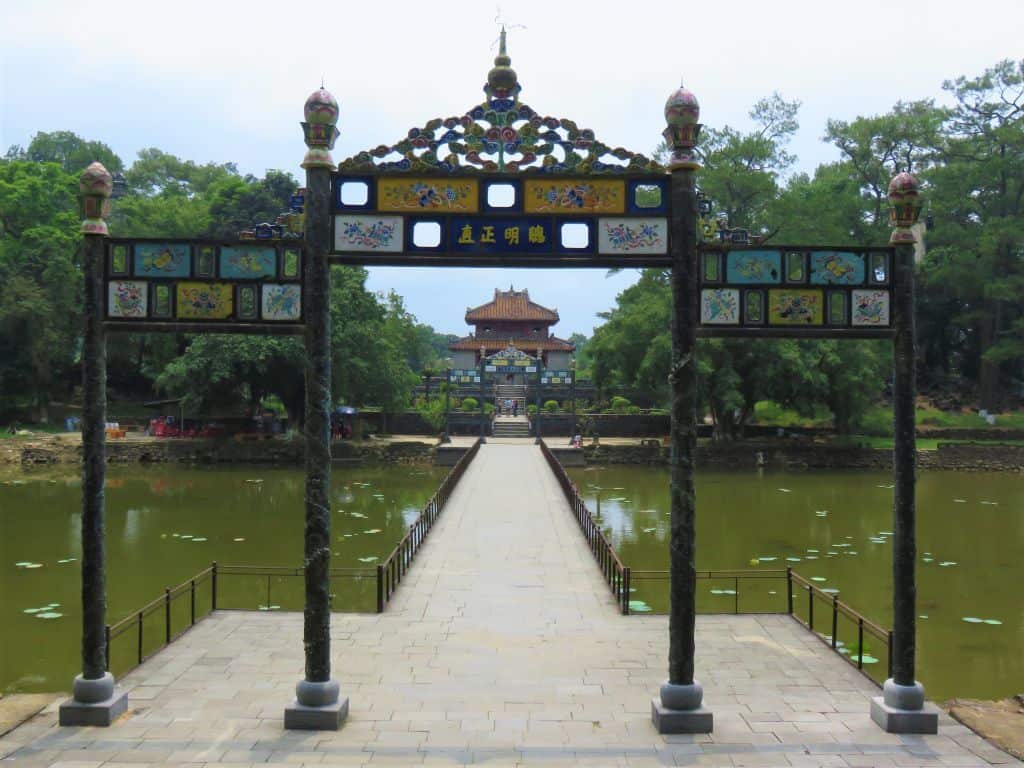
To escape the heat whilst still learning about Hue’s dramatic past, you couldn’t ask for more.
This Hue Royal Fine Arts Museum displays artifacts from Hue’s past as well as many pieces of important Vietnamese art.
Although Hue, Vietnam is famous for its history, the modern city is dynamic, charming and deserves to be explored.
The bi-annual Hue Festival celebrated every other April showcases the very best of Hue’s culture, music, and arts.
The 2020 Hue Festival is expected to attract tens of thousands of visitors from around the world.
Part of the redevelopment of Hue city centre has focused on upgrading the promenade that runs along the river.
Dotted with food stalls and landscaped gardens, the promenade is a top Hue attraction that is a lovely place to enjoy an evening stroll once the heat of the day has passed.
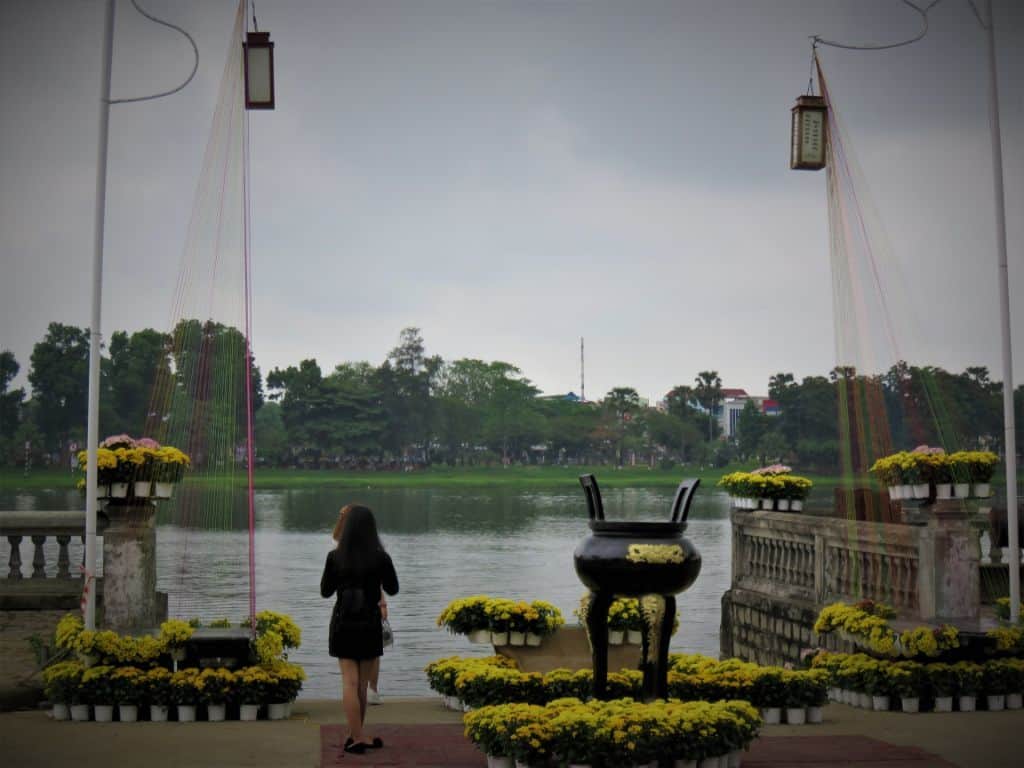
The former Imperial city is a great place to try some of Vietnam’s most ‘regal’ food.
Hue is famous for Bun Bo Hue (a popular noodle dish), shrimp and pork dumplings called Banh Bot Loc and many sweet desserts once favoured by the Emperors.
Vegetarians and vegans will love Lien Hoa on Le Quy Don.
This very traditional and simple restaurant serves Vietnamese food primarily to local Buddhist monks.
Try some local plant-based dishes and mingle with the monks over lunch.
READ MORE: Check out these awesome things to do in Da Nang !
A great activity in Hue is to visit the Dong Ba Market. First-time visitors to Vietnam will be captivated by the markets.
Dong Ba Market is a bustling local market selling everything you can imagine, from souvenirs to homegrown vegetables.
If you’re wondering what to see in Hue, a personal favourite of mine is the Tomb of Khai Dinh.
The blue-grey stone soldiers and elephants greet visitors as they climb the stairs between terraces.
The atmospheric jungle setting makes the mausoleum incredibly photogenic and memorable.
Khai Dinh Tomb took 11 years to build and was only finished in 1931. The buildings today seem much older.
As well as its attractive scenery, the unique blend of European and Oriental architecture makes this tomb clearly stand out.
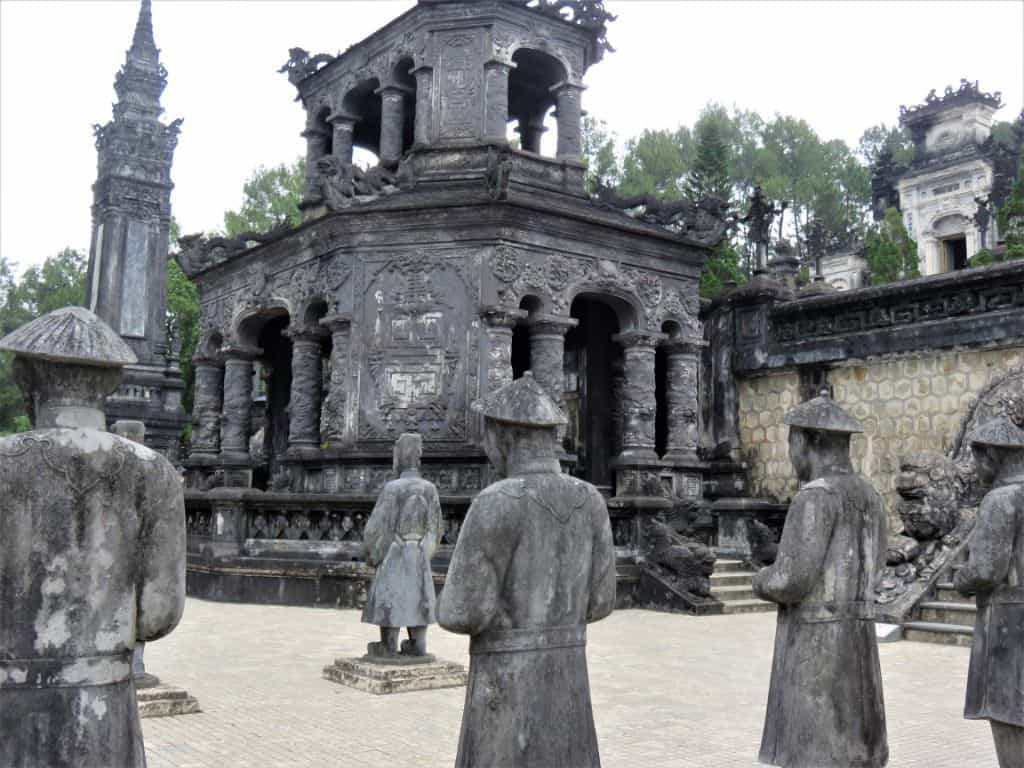
One of the speediest (and most exhilarating) ways to see the many Hue attractions is to experience it from a motorbike.
There are several tour companies around the city that offer motorbike tours of Hue .
Tours can be designed to cater to tourists with interests in history, food or nightlife.
Many of the best companies use their profits to help fund social enterprises and support local residents.
Outside of Hue city centre, there are many traditional neighbourhoods worth exploring.
One trip worth making is to the famous Thanh Toan Bridge (the Japanese Bridge).
This historic wooden bridge with a tiled roof spans the river Nhu Y. It is a very picturesque and little-known spot far away from the tourist crowds.
Savour the scenery as well as the view on a cruise along the river. We opted for a lunchtime cruise on a traditional houseboat back from Thien Mu Pagoda towards the city.
But if you have time, we definitely recommend doing a dinner cruise down the Perfume River instead .
Spot the water buffalo grazing on the banks and enjoy a homecooked meal on the water.
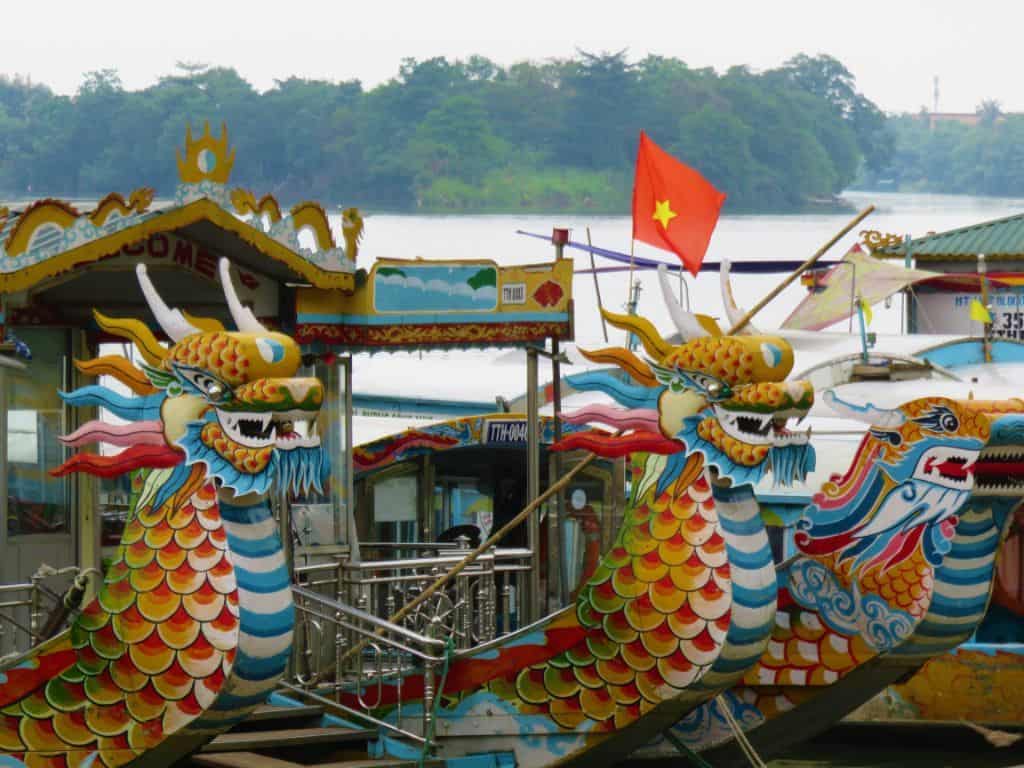
Although not technically in Hue, Thuan An Beach is close enough for an easy day trip.
Stroll along the beautiful white sand beach or enjoy the view from one of the many laid-back seafood restaurants.
READ MORE: Consider these 8 day trips from Ho Chi Minh City !
The Battle of Hue was one of the longest – and bloodiest – battles of the Vietnam War.
History buffs can find dozens of sites around Hue where they can learn more about this decisive battle.
The Vinh Moc Tunnels at Quảng Trị are a huge complex of tunnels worth exploring.
There are several companies running DMZ / war history tours from Hue although you can also travel independently around the various sights in the region.
If you don’t have time for a tour, the Hue Provincial Museum (also referred to as both the Hue War Museum and the Historical and Revolutionary Museum), is a small museum dedicated to war history.
You can spot captured army vehicles and planes rusting in the grounds from the roadside.
If you want to enter (for a small fee) you can learn more about the war in the local area through photographic displays.
The museum is a little run-down but interesting nonetheless.
Beautifully set around ponds, this is one of the most popular tombs to visit and with good reason.
Stroll around the grounds as Emperor Tu Duc once did (he built it before his death).
There are musical performances throughout the day and beautifully landscaped lakes to walk around.
The life of Emperor Tu Duc is absolutely fascinating and it is well worth paying a guide to relay the Emperor’s life story to you.
Tu Duc allegedly had over a hundred wives, ordered everyone who knew his exact burial place to be beheaded and used so much forced labour to build his tomb that the workers tried to overthrow him.
The coup failed but his legend lives on as a difficult and narcissistic ruler.
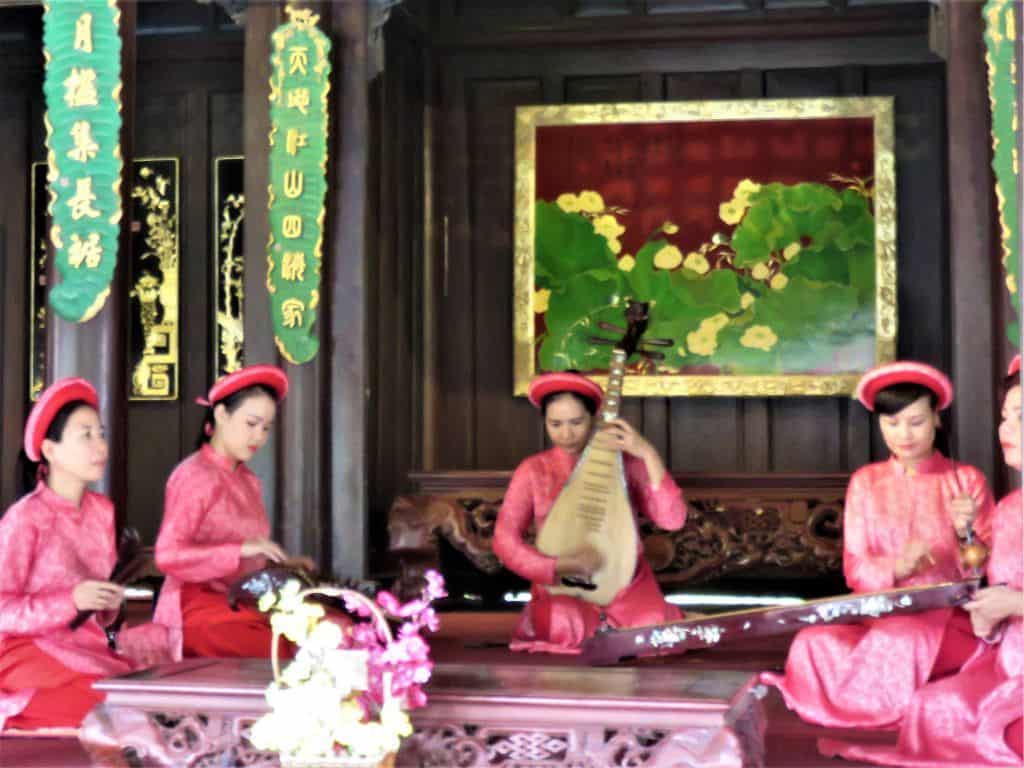
Hue is home to a number of inspiring social projects. The Wounded Heart Shop sells handicrafts made by disabled residents.
Profits are then used to pay for local children who need heart surgery. The Hope Center sells weaving produced by women from the A Luoi region bordering with Laos.
Profits help fund training and education for disadvantaged Vietnamese.
Give back to local residents by buying your souvenirs from one of these worthy organisations.
Bach Ma National Park, located in central Vietnam, is a captivating natural reserve renowned for its rich biodiversity and stunning landscapes.
Spanning an area of about 37,500 hectares, the park encompasses lush tropical rainforests, cascading waterfalls, and panoramic mountain vistas. The diverse ecosystem within Bach Ma National Park is home to an array of flora and fauna, including rare and endangered species.
Visitors can explore a network of well-maintained trails that lead to scenic viewpoints such as Hai Vong Dai, providing breathtaking views of the surrounding mountains and coastline.
Nature enthusiasts, hikers, and birdwatchers alike find solace in the serene beauty and ecological significance of Bach Ma National Park.
Hue, Vietnam really is a city deserving a place in every visitor’s Vietnam travel itinerary.
The history, culture, and people will entice you and keep you returning.
The number of things to do in Hue alongside the delicious local food and easy access to the beach and mountains makes Hue a great base for a few days in central Vietnam.
If you only have one day in Hue, the Royal Tombs and Citadel are must-see relics of Vietnam’s rich past.
DISCLAIMER: Some of the links in this article are affiliate links, which means if you book accommodation, tours or buy a product, we will receive a small commission at no extra cost to you. These commissions help us keep creating more free travel content to help people plan their holidays and adventures. We only recommend the best accommodations, tours and products that ourselves or our fantastic editorial team have personally experienced, and regularly review these. Thanks for your support, kind friend!
Kirsty - World for a Girl
Hi, We’re Alesha and Jarryd!
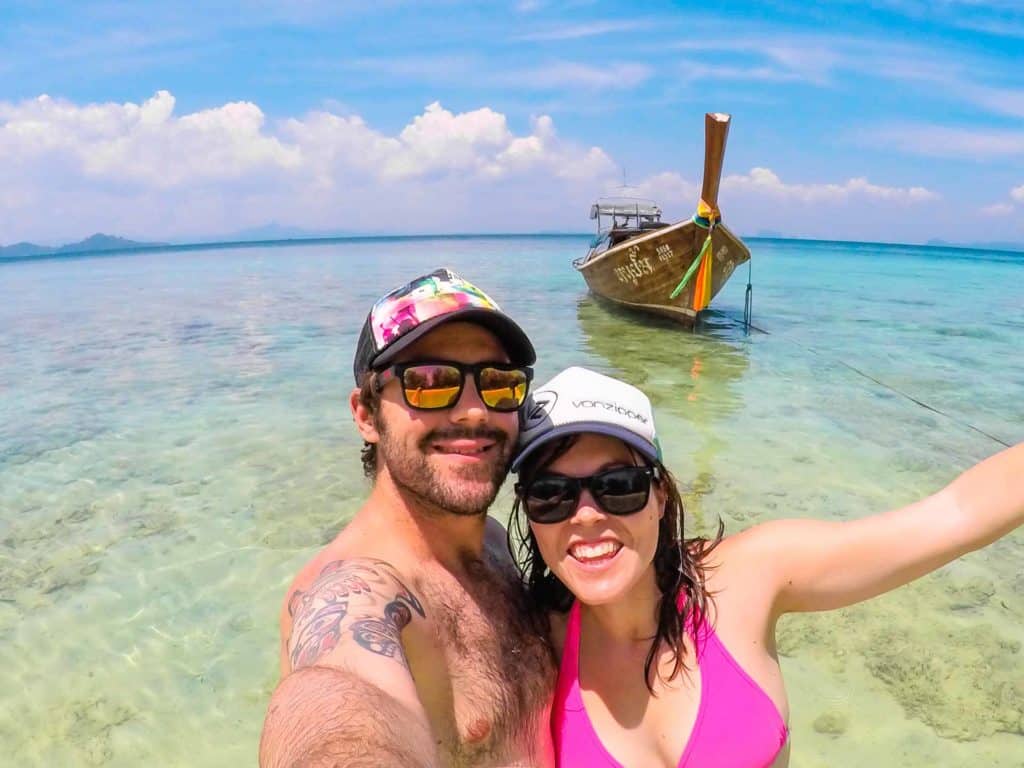
We’ve been traveling the world together since 2008, searching for the planet’s best destinations and adventures.
Love Travel?
Sign up for our free weekly newsletter for the best travel tips, ideas and deals!
We respect your privacy. Unsubscribe at any time.
READ MORE...
The Perfect Vietnam Itinerary for 1, 2, or 3 Weeks
Canyoning In Dalat – What It Is Really Like
A First-Timer’s Guide to Trekking in Sapa
Related Posts
Cuc phuong national park’s wasted problems, ba be national park – the lake, trekking and happy water, a photo journey inside hang son doong – the world’s largest cave, southern vietnam motorcycle adventures, leave a comment cancel reply.
Save my name, email, and website in this browser for the next time I comment.

13 Top-Rated Attractions & Things to Do in Hue
Written by Diana Bocco Updated Jan 20, 2023
The ancient city of Hue was the country's capital during the mid-1700s and then again for over a century starting in the early 1800s. The bloodiest battle of the Vietnam War was fought in Hue, and the city's ancient monuments, including 19th-century Imperial City complex , were severely damaged. Today, visiting this historic attraction is one of the top things to do in Hue.
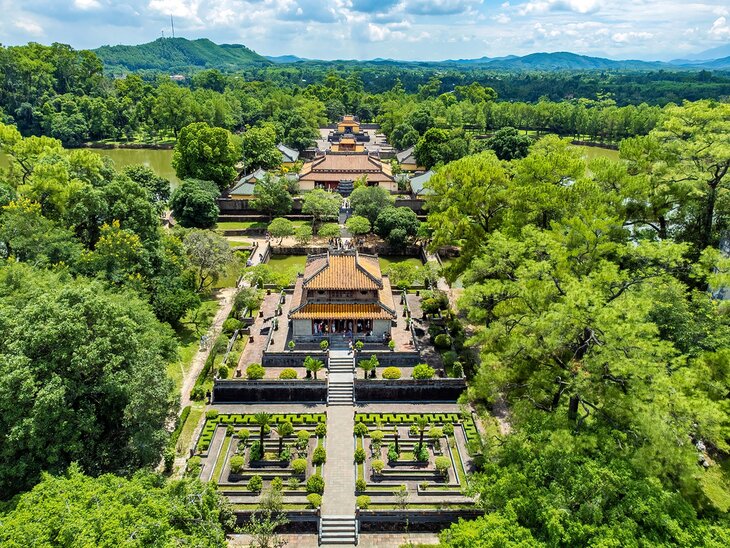
Hue sits on the banks of the Perfume River , so-called because during spring, the local orchards shed their flowers into the river, causing the water to smell like perfume. The river is an essential part of the history and heritage of Hue, but it's also a vital part of modern Hue.
The Trang Tien Bridge is a popular background for nighttime photos when it's completely illuminated, and the waterfront offers plenty of things to do in the form of cafés and restaurants for those out on an afternoon stroll. Most of Hue's main tourist attractions are set against or within minutes of the river.
Hue is home to many sites worth visiting, including emperors' tombs; a number of pagodas, including the famous Thien Mu Pagoda ; and French-colonial buildings set along the river. For more ideas on the best places to visit in this ancient capital, take a look at our list of attractions and things to do in Hue.
Imperial City Hue
Thai hoa palace, thien mu pagoda, royal tomb of emperor khai dinh, dieu de pagoda, hue museum of royal fine arts, hope center, the to mieu shrine, thanh toan bridge, dong ba market, an hien garden house, royal theater, alba thanh tan hot springs, map of attractions & things to do in hue.
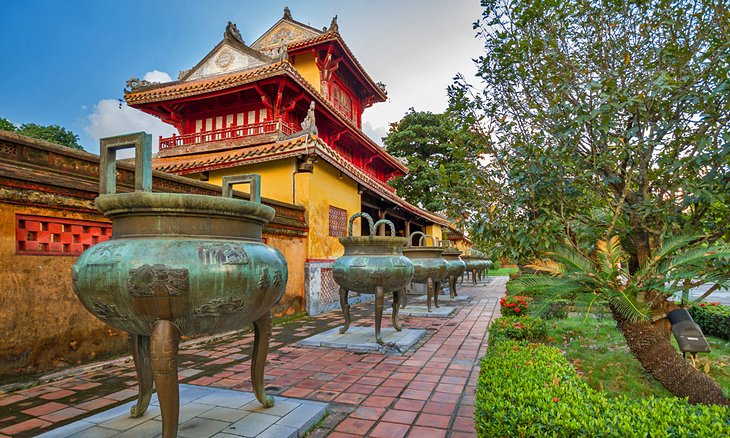
A UNESCO World Heritage site of bright reds and yellows, the Imperial City is Hue's most important attraction and the first stop in your discovery of the city.
A walled area inside the historical citadel of Hue, the Imperial City was on ce the capital of Vietnam . In 1804, Emperor Gia Long consulted geomancers to decide on the most auspicious location for the 10-kilometer-long walled citadel, which was eventually placed southeast to face the Perfume River.
The grounds of the imperial city are surrounded by towering walls and a moat and include temples, gardens, palaces, and residences. However, of the original 160 large buildings that dotted the grounds of the city, only 10 survived Vietnam War bombings.
Many of the buildings that still stand are now empty and can be explored freely by visitors, but some have been restored (or are under restoration), including halls, city gates, and shrines.
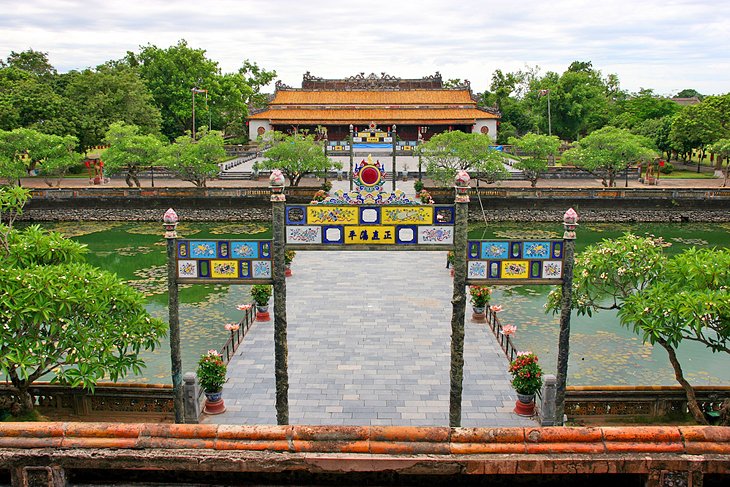
Perhaps the most important construction of the Nguyen dynasty—the last dynasty in Vietnam—the design of this palace is meant to represent a deep yin/yang balance , where both the physical and the spiritual are in perfect harmony.
Although the palace survived the Vietnam War bombings, extensive repairs had to be done to the inside to restore the damage caused during the battle of Hue.
The Thai Hoa Palace sits at the heart of the Hue Citadel , right after crossing the Ngo Mon Gate. A lotus lake and a long courtyard walkway provide an impressive welcome to the palace.
The main room of the palace is a large hall with a timber roof and 80 timber columns. Originally meant for royal ceremonies and events, it was also the crowning place for Emperor Gia Long and the area where he received visitors—both during official business meetings and when the doors were, in rare occasions, open to the public. A covered golden throne sits in the center of the hall.
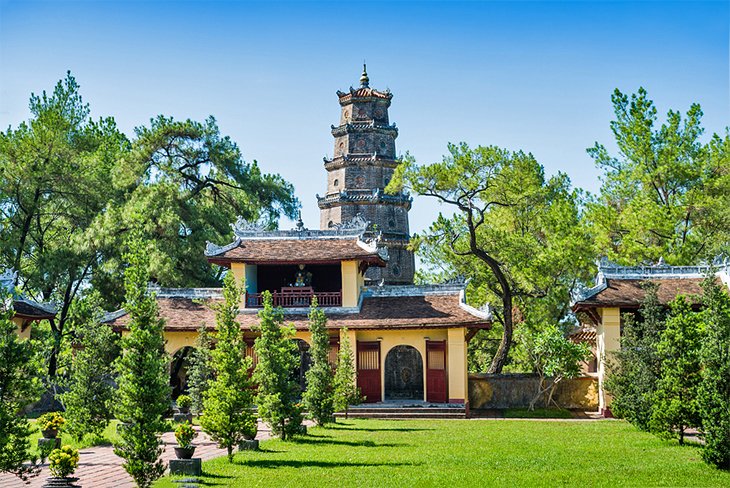
Also known as the Pagoda of the Celestial Lady , this seven-story pagoda is one of the most recognizable symbols of the city of Hue. It was built in 1601 by Lord Nguyen Hoàng, who was told about a local legend.
According to the legend, an old lady dressed in blues, greens, and reds foretold a pagoda would be built in that place and people would come to it to pray for Vietnam's prosperity.
Over the next two centuries, the temple was expanded, and special details and buildings were added, including a massive bell that can be heard 10 kilometers away and a number of additional praying halls, towers for storing sacred texts, and meditation halls.
Beautiful gardens, including a bonsai garden , are set around the buildings—many of them hidden from view at first until you take this path or that path towards another area of the pagoda grounds.
Parked under an open space, you'll also find a car used during the Diem Regime protests. In a fight for religious freedom, Quang Duc, a monk from Hue, drove to Saigon, parked this car and then set himself on fire. The story of his life and self-immolation are told through words and pictures posted on this temple.
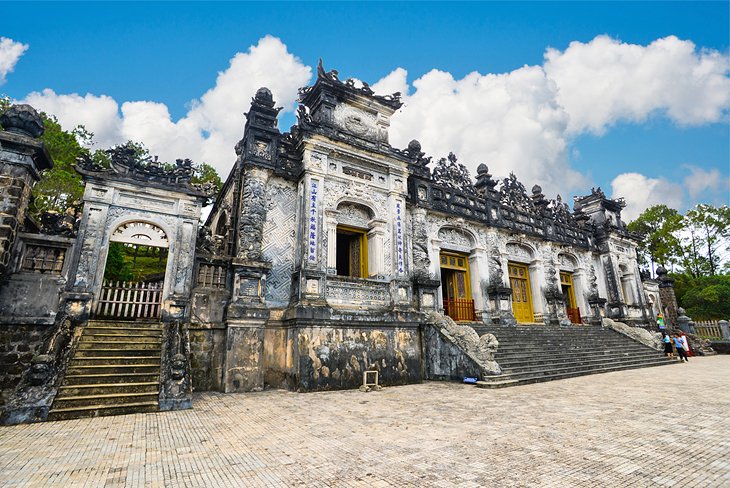
Located just outside Hue, on the steep Chau Chu mountain, the tomb was built for the twelfth Emperor of the Nguyen dynasty , who died in 1925.
Emperor Khai Dinh was actually highly disliked by his people, since he sympathized with French colonizers and ordered many nationalist leaders to be arrested. He's also responsible for forcing a change to a Romanized Vietnamese alphabet in 1918, which resulted in people abandoning the original local language (a mix of Chinese and Sino-Vietnamese); there are almost no people left alive who can read the original old Vietnamese language.
Emperor Khai Dinh's tomb is one of the most imposing tombs ever designed in Vietnam , perhaps because he oversaw the construction himself with funds raised by increasing taxes by 30 percent. The result is an imposing and elaborate construction that mixes Eastern and Western details.
The tomb is flanked by two giant dragon sculptures and features an imperial audience court, 12 statues that serve as bodyguards, a palace room richly decorated with porcelain and glass, and a small temple with an altar where the actual grave is located.
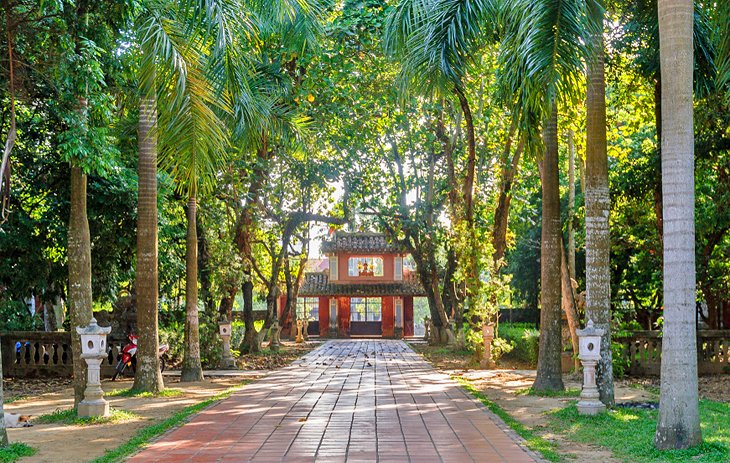
Named after the "Four Noble Truths" of Buddhism, this small golden pagoda in the center of Hue has been the site of activism, protests , and some political violence during the 1960s—the best-known case being in 1963, when civilian Buddhists confronted Diem's army trying to protect the pagoda from being raided. Thirty people died and 200 were wounded in one night.
Today, the pagoda has become a symbol for freedom , and it's visited not only by Buddhists but also activists from all around the world. Sitting right on the Dong Ba canal and surrounded by lush vegetation, the pagoda provides a peaceful escape from the heat and the tourist crowds.
Four towers surround the temple and provide a home for bells, while the main hall houses a Gautama Buddha statue.
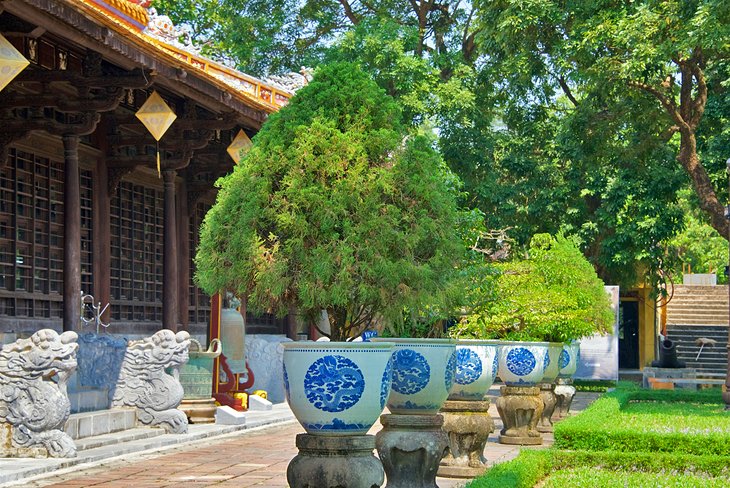
Housed inside the former Long An Palace, this museum offers a fascinating look into the culture and history of the city . The massive collection of over 10,000 objects includes everything from ceramics and silver objects to personal belongings and royal clothing of former Vietnam Emperors, furniture, Phap Lam enameled metal art, and lots of paintings and detailed murals.
All exhibits are labeled in English, and many include background details to help visitors better understand the history behind it and who used it.
While photography inside the museum is not allowed, this one-story wooden palace and the beautiful gardens around it provide plenty of picture-worthy corners waiting to be discovered.
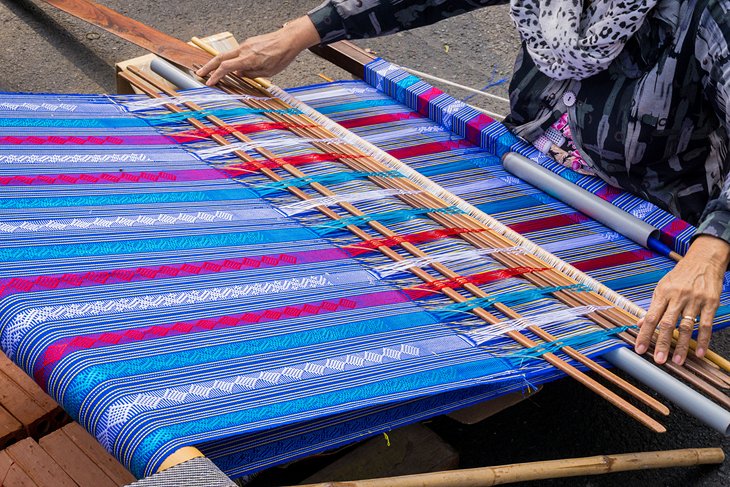
The Hope Center was created to help disabled and disadvantaged people , as well as ethnic minorities in Hue, by offering them a chance to learn to sew. The center produces uniforms for schools and hospitals, as well as a number of handicrafts, including basket making, textile weaving, and handmade jewelry and bowls.
Most textile items are produced using A Luoii fabric, dyed and produced by the Ta Oi ethnic group.
Visitors can see weaving and work being done on-site and buy items to take with them. It's also possible to practice shaping and firing your own pottery or making handmade, recycled products you can then take home.
All classes, tours, and events here are organized and guided by the people who work at the center, so you'll get a chance to interact with them and learn how the place is changing their life.
Official site: http://hopecenterhue.com.vn/index.php
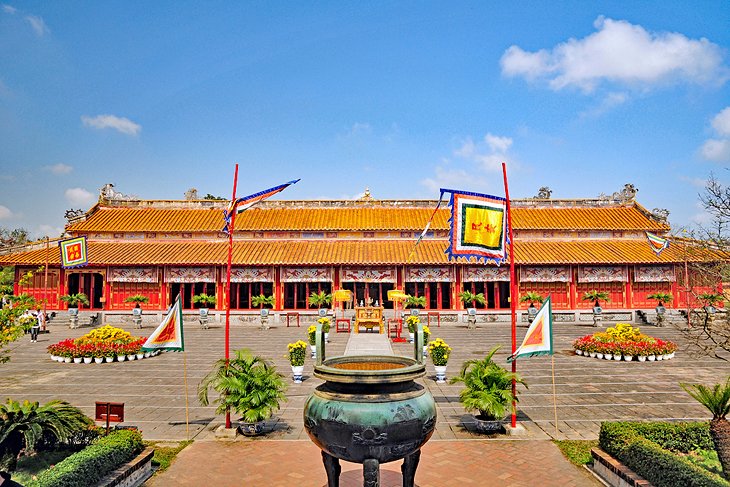
Modeled after the Imperial Ancestral Temple in China's Forbidden City, the To Mieu temple was built to allow ancestor worship of past emperors. Although no actual remains of the emperors themselves are buried here, there are nine urns to represent nine Nguyen emperors.
Each emperor also has his own altar, with photos of himself and the empress (or empresses for those with more than one wife), small offerings, and incense.
A massive stone gate, sweeping grounds, and lots of solitude make this temple a favorite sightseeing destination of those exploring Hue. Only a quarter of the original structures survived the Vietnam War, and very little work has been done to restore the ruins, so the place is a quiet reminder of difficult times while allowing you a chance to admire the grandeur of the temple still there.
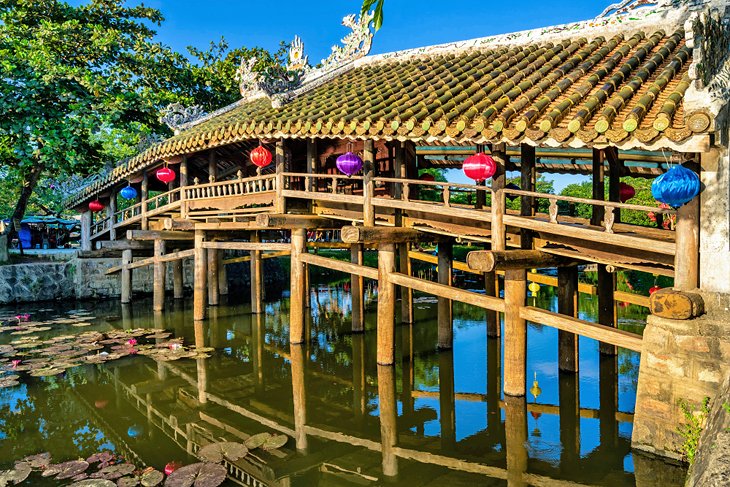
This wooden, 18th-century, tile-roofed footbridge is located around seven kilometers outside Hue. The Japanese-style bridge was built over a small river, allowing locals to cross over from one side to the other without a boat, but also providing an escape from the heat for rural workers who would otherwise spend all day in the sun.
Inside the bridge, a small altar is dedicated to the memory of Tran Thi Dao, the rich widow who originally paid for the construction of the bridge.
Although the bridge itself is interesting, the trip to the sleepy village of Thuy Thanh village, where the bridge is located , is just as special. The ride to the village takes visitors through rice paddies, temples, and lots of examples of what local life is like here.
Once at the village, you can stop by to see the beautiful columns of the city gate or hop on a boat to ride under the bridge and experience the river a different way.
The local Farming Museum , where you can see ancient farming tools used to cultivate rice and how they impacted local life, is another great stop before heading back to Hue.
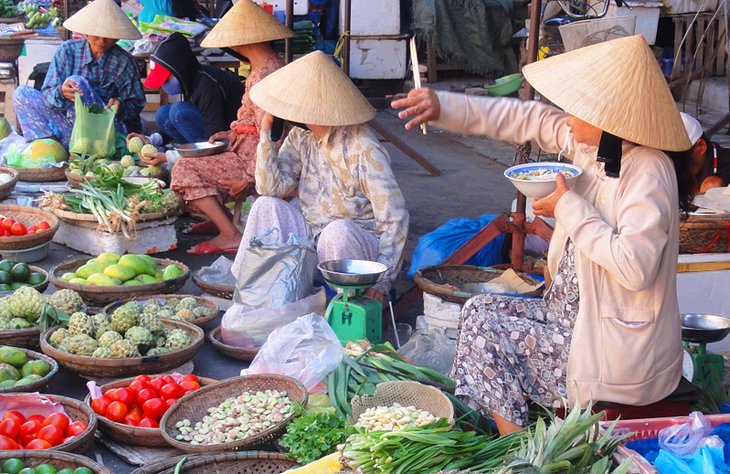
Outdoor markets are a staple of Vietnamese culture, and the Dong Ba market in Hue is no exception. The oldest and largest market in the city , Dong Ba covers 16,000 square meters of chaotic space, where stalls selling fresh vegetables sit next to handicrafts or souvenirs.
The market opens in the very early hours of the morning (3am) to cater to locals shopping for fresh seafood and other foods, but you can arrive during the day or afternoon to pick up mementos to take home.
If you're after clothes or wearable souvenirs, the market does have an entire second floor dedicated to this, where you can find all types of textiles plus many examples of non la bai tho (the typical conical leaf hat worn in Vietnam).
Other great Vietnamese souvenirs you can find here include lacquerware items; bamboo products; and guoc moc, a type of simple clogs made of bamboo or wood.
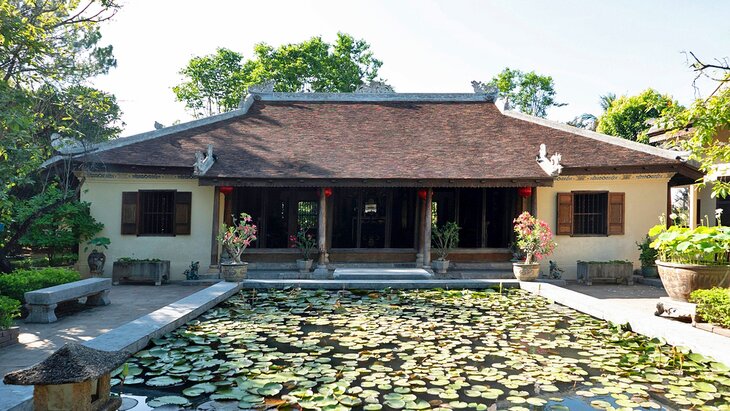
Garden houses are a very unique architectural feature found in Hue. They usually consist of small wooden houses, sometimes on stilts, surrounded by ponds and lush gardens. These houses are particularly common on the banks of the Perfume River, where they get both fresh air and quiet surroundings.
An Hien (House of Peace) is Hue's most famous garden hous e—over the decades, it has been both a private home and the official residence of the governor of Ha Tinh province.
The entire design of the building is based on yin/yang principles: the screen on the main door drives away evil energy, while the water in the pool ensures harmony.
The house can only be reached after crossing a stone gate and walking down a 34-meter-long road surrounded by trees. Inside the 19th-century home, much of the original furniture, timber columns, and ancestor altars remain as they were over 100 years ago.
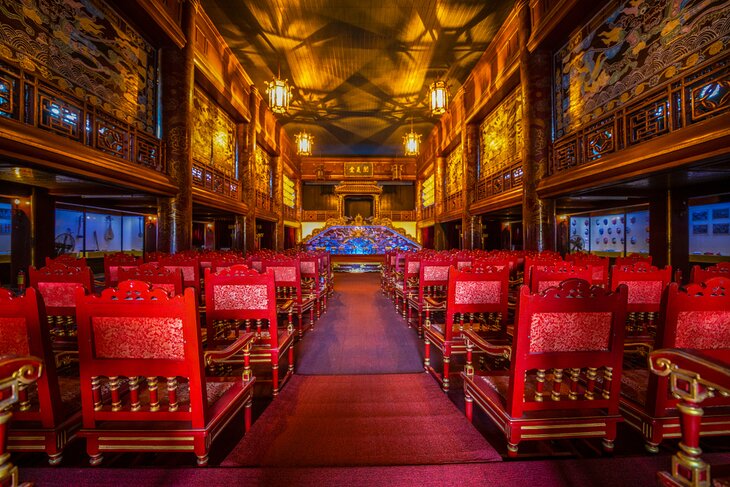
The beautiful red and golden Duyet Thi Duong Royal Theater was built in 1826 exclusively for the royal family to enjoy traditional art performances in an elegant, regal setting. Only the emperor and those close to him ever saw the inside, though banquets and performances were sometimes held for special guests visiting the court.
After much reconstruction, the theater finally opened to the public in 2004.
As the oldest still-operating theater in Vietnam , this is the perfect spot to catch a performance of Nha Nhac-Royal Music. When there are no performances, the theater is open to visitors who want to explore the displays of theater masks and traditional musical instruments. You can even sit on the plush red chairs and get up close to the stage.
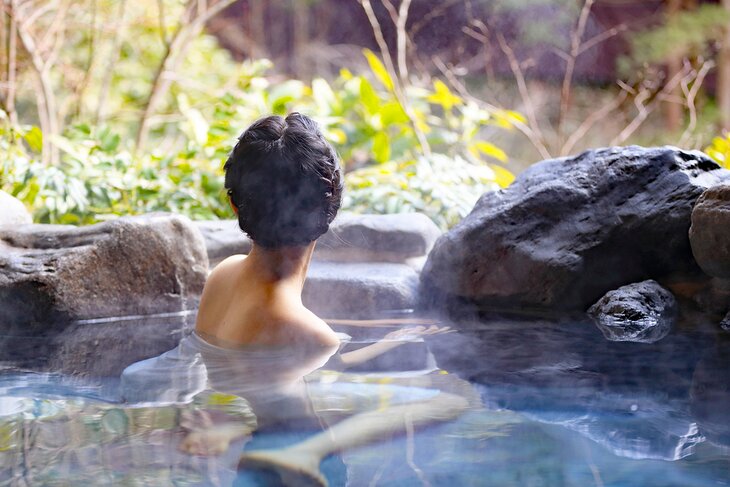
About 30 kilometers outside the city of Hue , these popular hot springs are a great way to relax and unwind. Although technically part of a resort that also includes accommodations and a number of other attractions, it's possible to visit just for the day to try the hot springs. Even better, there's a free resort shuttle bus that goes from the city to the hot springs, making it easier to transfer back and forth.
The springs have a natural temperature of 68 degrees Celsius at the source, but this is controlled through a series of streams and natural pools until they achieve the perfect temperature, so you can soak in all the physical and mental benefits of the mineral-rich waters while relaxing under the whispering of the trees in the breeze.
For those wanting to stay around a little longer, there's also a 560-meter-long zipline through the lush rainforest and an adventure rope course to test your balance. Stick around for a quiet meal overlooking the ponds at the end of the day.
More Related Articles on PlanetWare.com
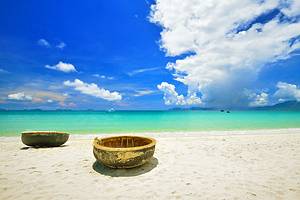
What to See Nearby: Hue is located about two hours north of Da Nang. To the south of Da Nang, just under three hours from Hue is Hoi An , another destination worth seeing. If you are interested in sun and sand, have a read through our list of the best beaches in Vietnam to find one near you.

More on Vietnam
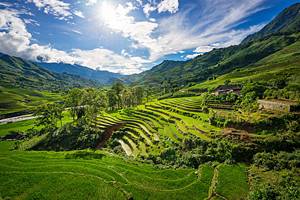
- Customized Tour
10 Things To Do In Hue, Vietnam

The palaces of the Imperial City, boaters on the Perfume River, and gentle waves along the sandy coast all welcome you to the heart of central Vietnam: Hue City. The city holds incredible importance in Vietnam’s history, and it’s no surprise there are so many wonderful things to do in this former royal capital. Here are the 10 best things to do in Hue as you explore the unique places, sights, and flavors that wait around every corner…
Table of Contents
1. Explore the Imperial Citadel
2. visit tombs of the ancient emperors, 3. seek peace at thien mu pagoda, 4. see dong ba market, 5. sample the local cuisine, 6. cycle around the city of hue, 7. cruise in a boat on perfume river, 8. visit the royal theatre, 9. journey to bach ma national park, 10. enjoy panorama view on hai van pass.
Even if you have got just 1 day in Hue , you need to visit the Imperial Citadel as this is the most important site of Hue historical monuments. Also known as the Imperial City, this amazing complex is where Vietnam’s emperors used to live, protected by the thick stone walls and moat surrounding them. Construction began in 1804 and although many of the buildings have been damaged over the years, they still make for an impressive sight.

You can spend hours wandering around the Imperial City, marveling at the impressive gates, endless array of temples, courts, gardens and beautiful landscaping. And thankfully most of the walkways are covered so you’ll get some respite from the blazing midday sun.
To create a civilized tourism environment that respects national and cultural values, tourists are urged to wear respectful clothing when entering the site. It means offensive shorts, tank tops and short skirts will be absolutely prohibited.
The entrance fee is 200,000 VND for adults and 40,000 VND for children aged from 7 to 12.
A stay in Hue would not be complete without a visit to the stunning Imperial tombs. The tombs are the elaborate resting places of the Nguyen Dynasty, who ruled over Vietnam from 1802 until 1945.

There are seven known royal tombs in Hue, six to the southeast of the Hue Citadel on the other side of the Perfume River and a single tomb on the same side. Of these seven tombs, three are significantly more popular compared to the rest due to their relative good condition and better accessibility. They are tombs of Minh Mang, Tu Duc, and Khai Dinh. The individual entry fees for each tomb are 150.000VND but if you plan to visit all these tombs and the Imperial Citadel, it is suggested to buy a package ticket of only 530.000VND for adults and 100.000 VND for children (from 7 to 12 year old).
* Minh Mang’s Tomb : best for history and culture.
Minh Mang tomb is the last resting place of the second Nguyen Dynasty, Emperor Minh Mạng. Considered to be the largest tomb in Hue with an impressive lake and monument systems, the tomb attracts visitors for its nature and historical value. Just about an hour, you will have a great chance to learn about the history of Vietnam as well as explore the original beauty of a magnificent work under Nguyen Dynasty.
* Tu Duc’s Tomb : best for dreamers and romantics.
Emperor Tu Duc had a strong affinity for art and poetry. So that is the reason he channeled to craft his romantic, illustrious tomb. Tu Duc wanted his final resting place to blend harmoniously with nature. Coming here, you will get lost in a labyrinth with the fragrance of flowers and the soft sound from the royal music show. No doubt, this place used to serve his elegant pleasures of the Emperor. Thus, a nostalgic and artistic space is what you will feel when visiting the tomb.
* Khai Dinh’s Tomb : best for something completely different.
Constructed between 1920 and 1931, it is a proud work of Khai Dinh himself combining both
Eastern and Western styles. Khai Dinh was the Nguyen Dynasty’s most eccentric and unusual king, who reportedly embraced French colonialism. Much like his father, Khai Dinh favored imported luxuries, spent a large sum of money on his tomb, and was the subject of ridicule by nationalist leaders.
Most Nguyen Dynasty’s royal tombs are quite far from Hue city center. Therefore, you can travel by motorbike, taxi or contact us for a private tour with our experienced guide and driver to have a deeper insight about these historical attractions.

Thien Mu Pagoda, Hue
Located on the bank of the poetic Perfume River, 5 kilometers from Hue City center, Thien Mu Pagoda with its ancient architecture is one of the most fascinating and ancient pagoda in Hue City. Not only does it go on romantic poems or Hue characterized lyrics, Thien Mu is also considered as a sacred pagoda and the sight not to be missed by any tourists when setting foot in the ancient capital. It is recommended to visit this pagoda in the afternoon so you can observe the monks’ praying time inside the pagoda as well as enjoy the beautiful sunset on the Perfume River.
If you would like to snap a photo free from other tourists, head to Thien Mu Pagoda in the early morning hours. The tour bus crowds descend by mid-morning.
If you are in Hue, there is a place that you should really pay a visit is Dong Ba Market, the biggest and oldest market in Hue.

What consists in the attraction towards this market is the preservation of ancient distinctiveness. Tourists can see all the typical features of a traditional Vietnamese market, for example, the sampan landing, the bus station and the bazaars. Dong Ba market is considered as a paradise for snapshots of daily activities as well as for shopping with everything from souvenir items to bronze goods, Hue sesame sweetmeat, conical poem hats…
Because the market is so crowded, please be careful with your belongings. Also, comfy shoes and clothing are suggested because the market have no air conditioning and sometimes the floors gets damp or wet.
If you love Vietnamese food, you will love Hue’s cuisine. This peaceful, ancient city in central Vietnam has a distinctive cuisine, a ton of great restaurants, and some seriously unique dishes. It’s one of the favorite foodie destinations of tourist when visiting Vietnam.

Read more: 18 Best Things To Do in Vietnam
Unlike other big cities in Vietnam such as Hanoi and Ho Chi Minh City which are so crowded with numerous means of transportation, Hue is so quiet with a small number of traffic. As such, it is said to be the nicest place in Vietnam to cycle around.

Although not technically in the center of Hue City, Hai Van Pass, or ocean cloud pass, connects two major tourist destinations Hue and Danang, and it is one of the best things to do for those traveling in this central part of Vietnam. Two sentry towers along the pass, with one left by French colonists and the other by American troops during the Vietnam War, seem to tell a detailed account of Vietnam’s two sad histories. The winding mountain highway of Hai Van Pass and Lang Co Bay along the road have been selected by National Geographic magazine as one of must-go places in life.

Motorbiking and bicycling are often the two most popular way to explore Hai Van Pass. Or simply make a stop if traveling by car/ bus between Hue and Danang/ Hoian, you can enjoy the spectacular views of the coastal line.
The history, culture and people will entice you and keep you returning. If you are planning a trip to Vietnam, make sure Hue historical former capital city to be included in your itinerary as that will introduce you with the true colors and culture of Vietnam. Also, engage in the above-mentioned things to do in Hue for a thorough tour of the quaint city. Still looking for other information and useful tips for your Vietnam vacation? Check out our travel guides !

Related Posts

Overview of Hue, Vietnam

Hue Weather

Nightlife in Hue

Bun Bo Hue (Spicy Vietnamese Beef Noodle Soup)

Coffee shops in Hue
Leave a comment cancel comment, request a free quote, thank you we have received your travel request. you will receive an email shortly. please check your email and verify the information. your request will be processed after your confirmation..
You have chosen a tour duration longer than 20 days. Please specify the exact number of days you want to travel in the message box below, so that we can have enough information and make a program for you. Thank you for your cooperation.
You have selected a number of travellers greater than 20. Please let us know the exact number of people in your group in the message box below so that we can quote you accurately. Thank you for your cooperation.
You have selected a number of travellers and duration greater than 20. Please let us know the exact number of people in your group and the exact number of days in the message box below so that we can quote you accurately. Thank you for your cooperation.
- Vietnam Travel Guides
- Travel Planning
- Festivals & Events
- Food & Drinks
- Tourist Maps
- Travel Blog
- Travel News
Our Recommendations

Guideline to get Vietnam E-visa

Vietnam Weather: General information & Best Time to Visit

50 Things You should Know before Traveling to Vietnam

Best Vietnam Private Tours you should know before traveling

Info for travelers on Covid-19 in Vietnam: Entry requirements & Restrictions
You May Also Like

But Thap Pagoda – Special National Monument in Bac Ninh

Top 10 Waterfalls In Vietnam

8 Best Rooftop Bars in Hanoi with Stunning Views

Places to visit in South Vietnam

Best Destinations for Trekking and Hiking Adventures in Vietnam

Binh Dinh Province: Discovering the Coastal Marvels of Vietnam

Tran Quoc Pagoda – Oldest pagoda in Hanoi

Bach Ma National Park: How to get there and What to do?

Best Beach Hotels And Resorts In Vietnam

How to get to Hue from Hanoi
Sign up today and receive a customized itinerary based on your own travel style, budget… by our Vietnam Travel consultants
* To be sure you'll receive our itinerary (email failure case...)
(We'll get back to you within 8 business hours)
Hue best things to do & travel guide
The ancient city of Hue was the capital of Vietnam during the Nguyen dynasty at the beginning of the 19th century and during the Vietnam-US war some of the most intense conflicts took place in this region. One of the main tourist attractions of Hue is the Royal Palace of the imperial city. There are also a number of places of interest left over from the Vietnam War, such as a military base and tunnels in the DMZ.
5 reasons to visit Hue
- Explore the ancient buildings and ruins of the Imperial City
- Sail the Parfum River by boat
- Learn more about the Vietnam War in the DMZ
- Cycle around the city
- Take a day trip to Bach Ma National Park
What is in this Hue travel guide
Practical information, best time to visit.
- 10 best things to do
- Best hotels & hostels
Food & drinking
How to get there, how to get around, book your local hue experience, recommended days to stay.
Most of the temples and city you can see within one day. You can choose to stay another day or two if you want to make a day trip to the DMZ or Bach Ma National Park.
ATM's & money exchange
Hue is a big city, there are plenty of ATMs to be found.
Local events and holidays
- Hue Festival : This art festival is held in even years with local and international artists at historic buildings, street parades, sampan races and markets.
- The best travel time : From January to April, with 20 to 25 degrees and almost no rain.
- Dry season : The complete season that there is little or no rainfall is from March to August.
10 best things to do in Hue
The city is a beautiful mix of old and new buildings that are mainly separated by the Parfume River. Hue was the imperial capital of Vietnam between 1802 and 1945. Although many beautiful buildings have been lost as a result of the wars, Hue is busy restoring various highlights in the city.
1. Hue Imperial Citadel
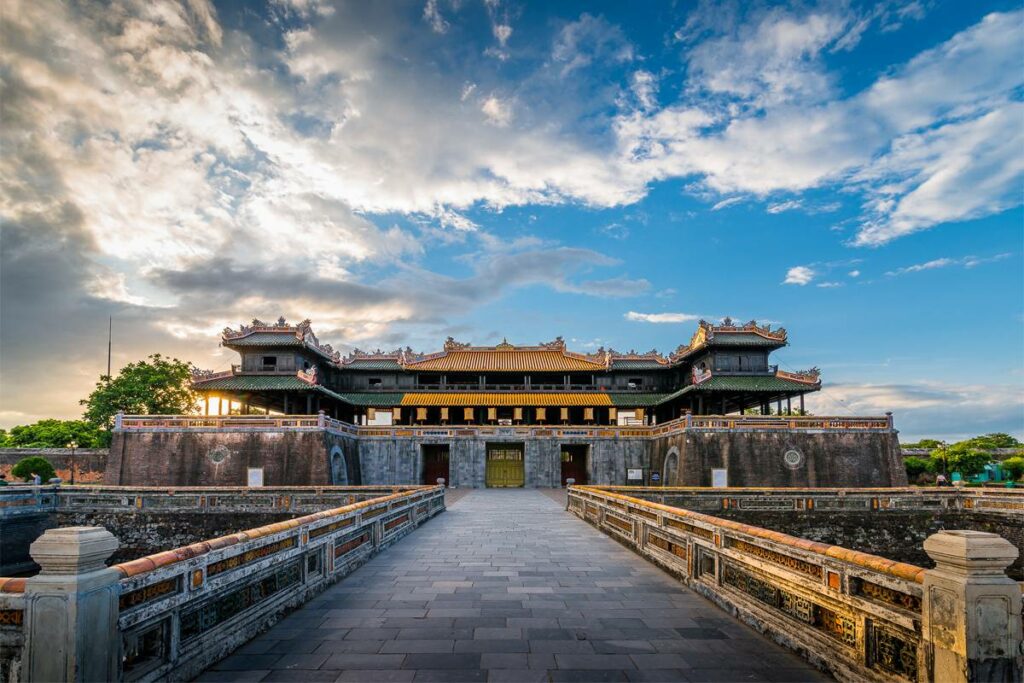
Without a doubt, the most impressive and best thing to do in Hue is a visit to the Imperial City. In the walled Hue Imperial City, also known as the Citadel, you will find the Forbidden Purple City, dozens of royal tombs, pagodas, temples, royal rooms, a library and a museum.
You can easily walk around here for 3 hours to visit everything. A guide is not necessary but recommended if you want to learn more about the history and the times when there was fierce fighting here during the Vietnam War.
2. Lang Co beach
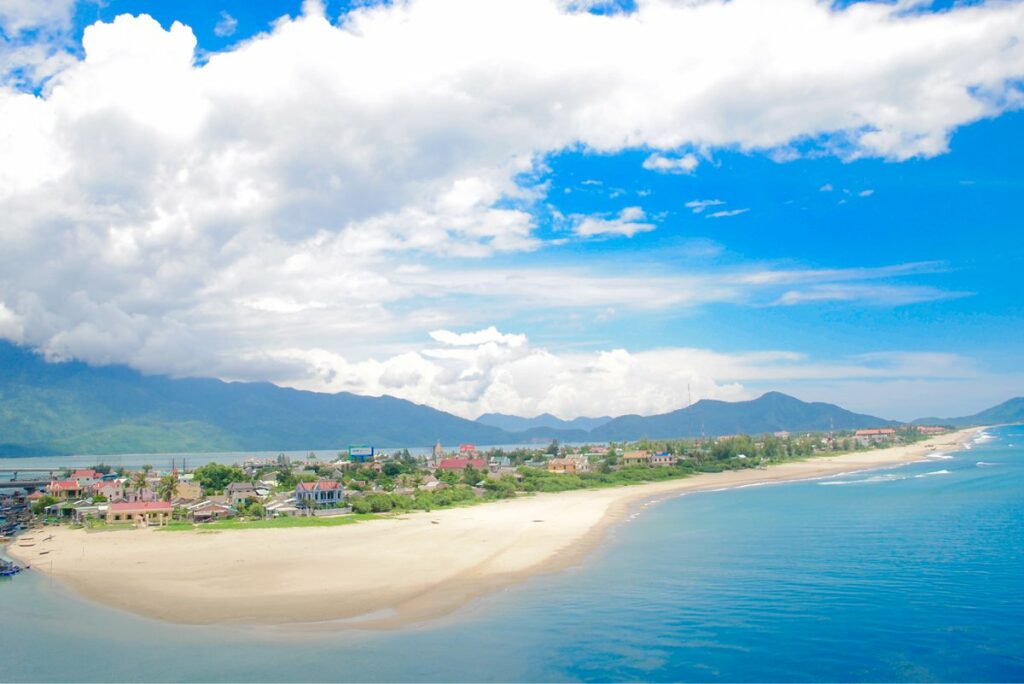
One of the best beaches in Vietnam can be found close to the city of Hue. The beach is 10 kilometers long with palm trees, clear water and a number of good resorts. It is still a 60 km drive from the center. You can also choose to stay here for a night, a day trip or a stop on the way between Hue and Da Nang just before the Hai Van Pass.
3. Tombs and temples
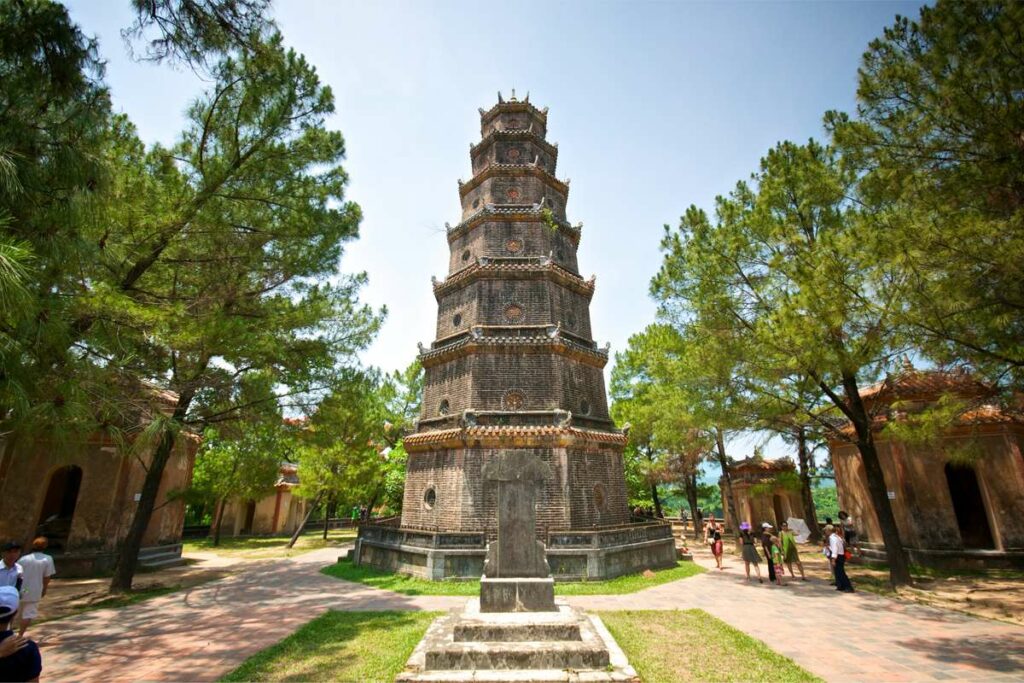
Besides the Imperial City, you can find many other tombs, temples and pagodas in and around the city of Hue. The tombs of the emperors of the Nguyen Dynasty are scattered on hills south of the city and can be reached by boat or bicycle. In total there are seven tombs: the other emperors died in exile and were buried.
The best known and most impressive are the Minh Mang Tomb, Tu Duc Tomb, Hon Chen Temple and The To Mieu Temple.
4. Hai Van Pass
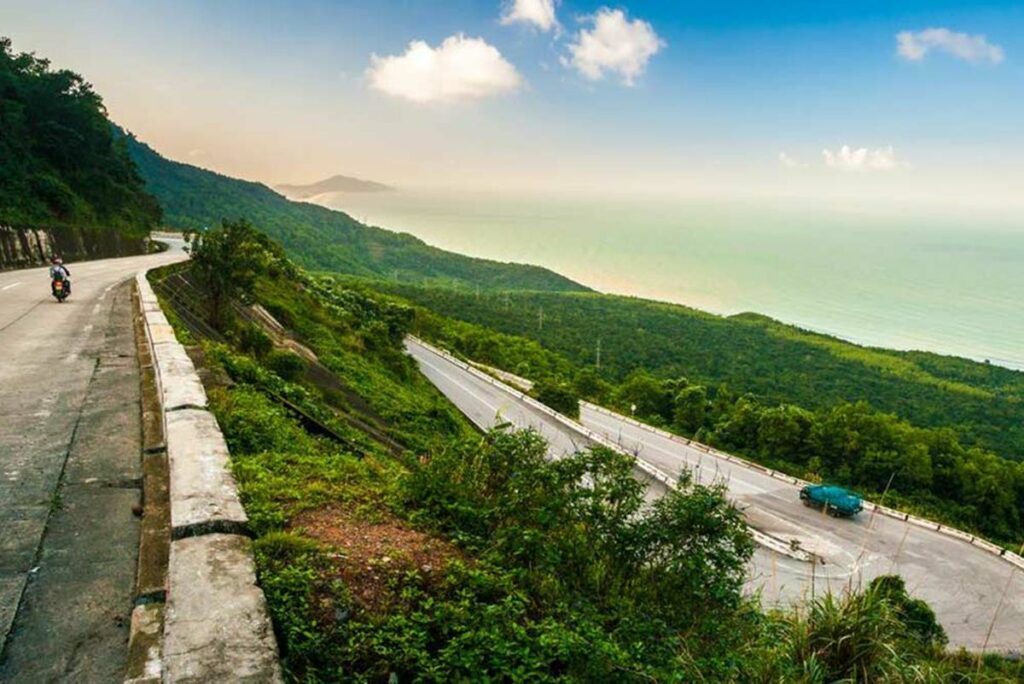
The Hai Van Pass is located between Hue and Da Nang and is one of the most stunning coastal roads in Vietnam. It is very popular to drive the road by motorbike (or on the back of one), but you can also go by car or an old army jeep. The views along the way are spectacular and you can combine to drive with a visit to some other sights along the way, such as Lang Co beach, fishing villages, the Marble Mountains and a small waterfall.
- Tip: Excited to go? Check out our Hai Van Pass tours here, including behind on the motorbike of an Easy Rider, a comfortable car or by military jeep!
5. Bach Ma National Park
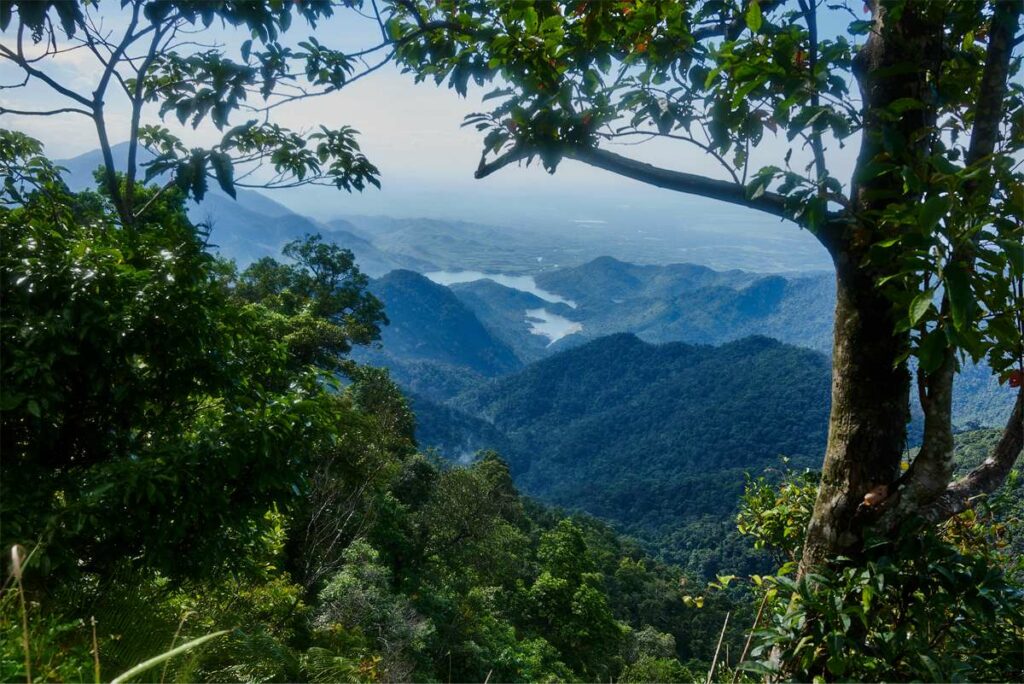
Bach Ma National Park is an old French hill station that extends over 40,000 hectares and offers great hiking trails, dilapidated French villas, waterfalls, a campsite and lots of wildlife.
The best way is to go on a Bach Ma national park trekking tour through the forest. There are several routes to choose from. The nicest routes bring you along some small lakes and waterfalls. Also make sure to visit the peak with amazing views over the forest.
6. Dong Ba market
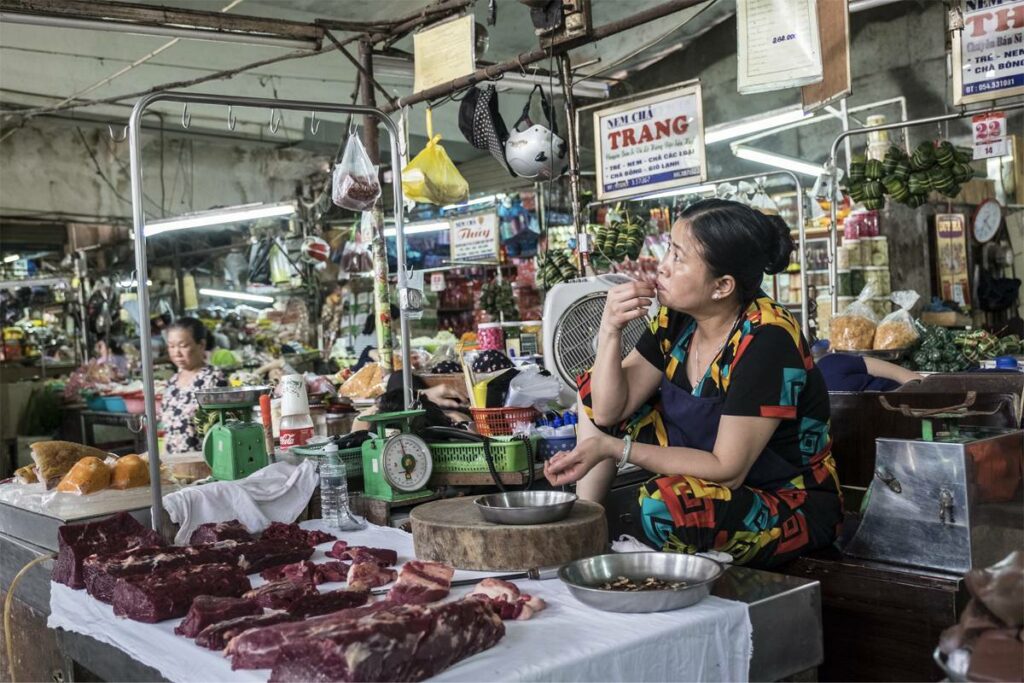
Dong Ba market is the largest market in Central Vietnam and is the perfect place to see the local life. It is a lively market hall where you can buy handicrafts, vegetables, fruit, meat and clothing.
The market is not far from the citadel and on the Perfume River, so you can easily combine a visit with other sights. Walk around the market to watch locals negotiate and get their daily groceries. It is a unique and above all authentic experience.
7. Dragon boat trip on the Perfume River
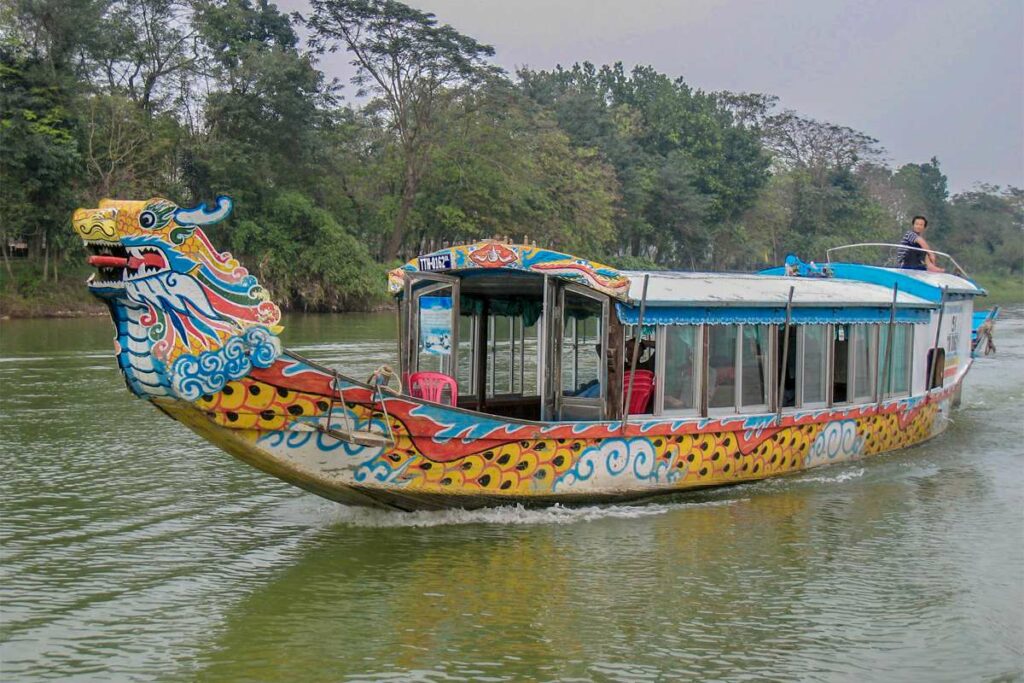
The perfume river flows through the middle of the city and can be a relaxing break from city life. Boat trips, pedal boats and dinner cruises are available.
The best way to discover the river is by a dragon boat ride – they are not to be missed. From the boat you can see the local life on shore and the fishermen and transport boats on the water. There are also a number of riverside temples that you can visit on a dragon boat tour.
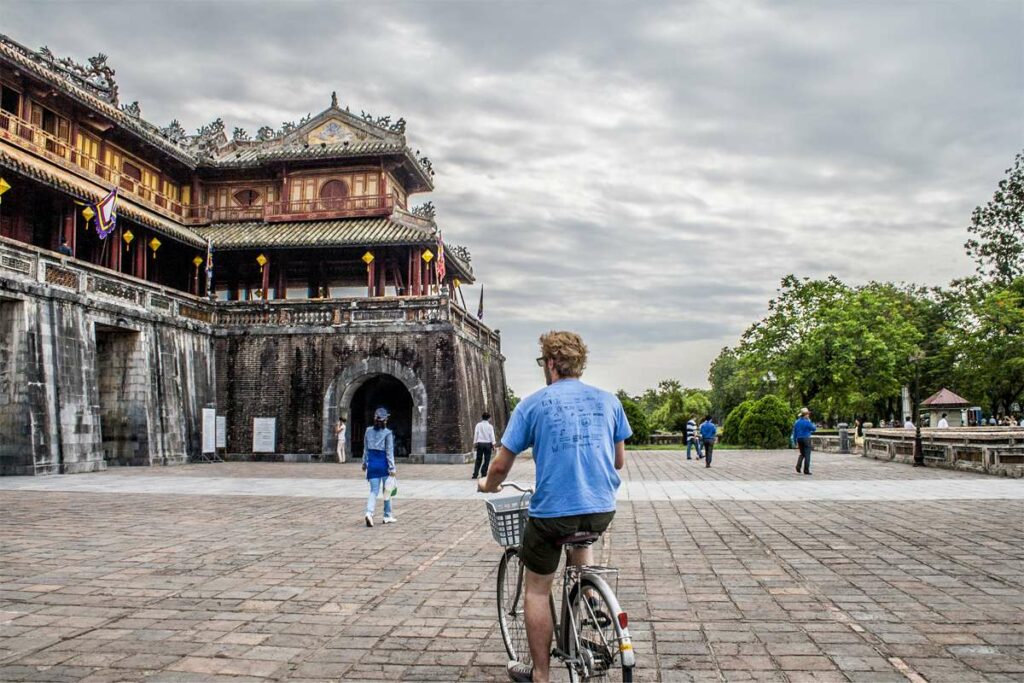
With less traffic than other major cities, Hue is arguably the best city for cycling in Vietnam . Many tourists choose to ride a bicycle along the banks of the Huong River, to the Citadel. You can also visit a number of temples a little further from the center. Some accommodations lend bicycles for free, otherwise you can rent a bicycle cheaply in the center of the city.
If you are a fanatic cyclist, you can also choose to cycle out of the city and explore the quiet countryside. You can also take a bike tour through Hue countryside so a guide can show you the way. It’s a very calming experience, and quite authentic, as you pass through areas where few other travelers go.
- Tip: If you prefer not to cycle yourself, you can enjoy a traditional cyclo ride. A cyclo is a three-wheeled bicycle taxi that appeared in Vietnam during the French colonial era. Local Vietnam offers various cyclo rides in Hue. View all tours in Hue here to see your options.
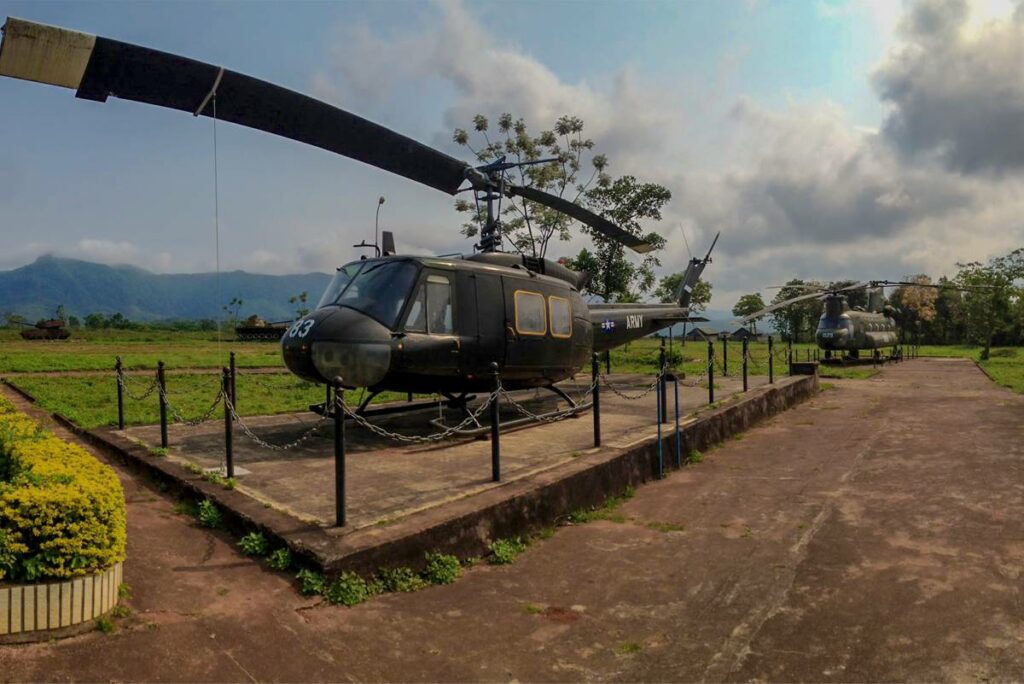
- Tip: If you want to see this area, have a look at our DMZ tour by small group. If you are also planning to go to Phong Nha after or before Hue, you can also do a sightseeing transfer through the DMZ between these two destinations.
10. Hue abandoned water park
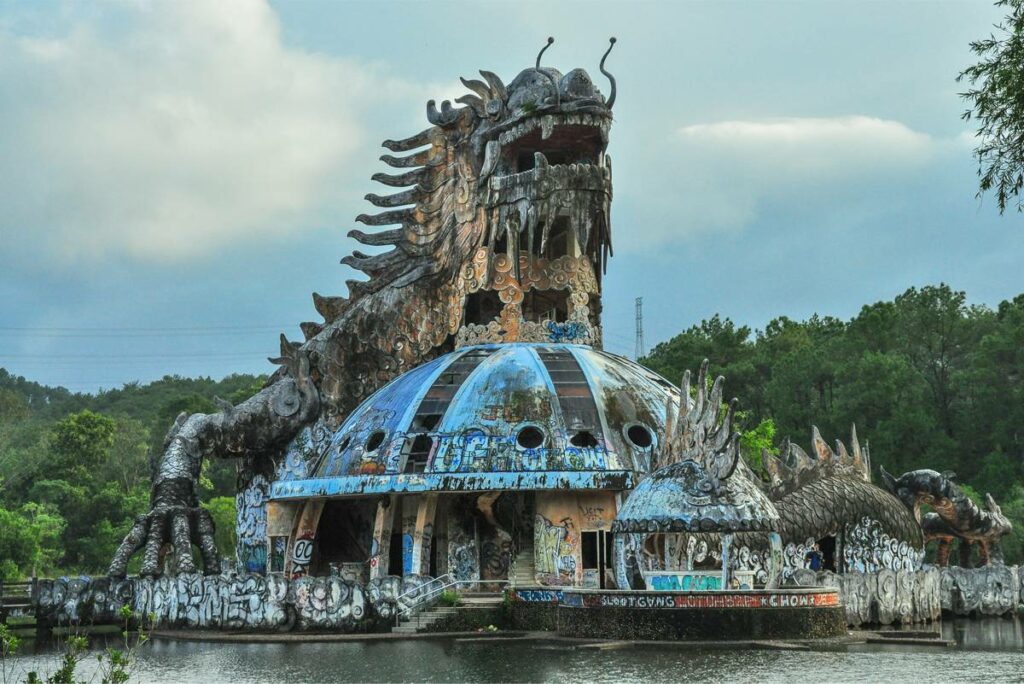
Photography enthusiasts and urban explorers will want to go here. Ho Thuy Tien is a small abandoned water park on a lake not too far from the city.
The water park has been abandoned for over 10 years. Certain parts are ruins, overgrown and broken, it feels a bit like you’ve walked into a horror movie. In the middle of the lake is a dragon’s head, the main attraction. All around you will find empty swimming pools and dirty slides.
It is not an official tourist attraction and in some places there is glass on the floor, so watch out and don’t wear flip flops.
Best hotels & hostels in Hue
Where to stay.
The best area to stay in Hue is the city center, in the area closest to the imperial city, the main attraction of Hue, located on the banks of the river. Here you will find the vast majority of hotels in the city. The area also offers a wide variety of restaurants, bars and shops nearby.
Budget hotels & hostels
- Hue Happy Homestay
- Sunny A Hotel
- Jade Hotel Hue
- Hong Thien Ruby Hotel
Mid range hotel
- Beaulieu Boutique Hotel
- The Scarlett Boutique Hotel Hue
- Moonlight Hotel Hue
High end hotel & resort
- Pilgrimage Village Boutique Resort & Spa
- Vedana Lagoon Wellness Resort & Spa
- Indochine Palace Hotel
Restaurants
Hue is known for its imperial cuisine, originally prepared for the emperor. Although the food emphasis more on presentation than on taste, an imperial banquet is worth it. If you are a street food lover, then Hue is also the right place for you.
- Serene Cuisine Restaurant
- Risotto Restaurant
- ZUCCA Restaurant
- Golden Rice
- Elegante Restarant
- Madam Thu Restaurant
- Family Home Restaurant
- Nina’s Cafe
- Les Jardins de La Carambole
- Hanh Restaurant
There is is a lot to do at night in Hanoi. You can join the locals with a beer on the street, go clubbing, chill in a bar or enjoy a impressive performance in the Opera House.
- Explore the illuminated sights in the evening
- Why Not? Bar
- Secret Lounge Hue
- Le’s Garden Hue
- Brown Eyes Bar
- One For The Road
Lorem ipsum dolor sit amet, consectetur adipiscing elit. Ut elit tellus, luctus nec ullamcorper mattis, pulvinar dapibus leo.
Flights to Hue
Hue has a small international airport, with daily flights from Ho Chi Minh City and Hanoi. Hue’s Phu Bai International Airport is currently served by Vietnam Airlines, Vietjet and JetStar Pacific.
Buses to Hue
Hue is connected by bus to other cities in Central Vietnam. Buses run daily from Hoi An and make the journey to Hue in about three and a half hours. There are also daily buses from other cities, such as Ninh Binh, Phong Nha, Dong Hoi, Da Nang and even from Ho Chi Minh City and Hanoi.
Trains to Hue
Hue train station is one of the many stops on the Hanoi to Ho Chi Minh City train route that goes through the largest part of Vietnam. The train journey from Hue to Da Nang is a very beautiful route that is even worth doing as an excursion.
Private transportation
A great alternative is getting private transportation. The route between Hue and Da Nang/Hoi An goes over the Hai Van pass, a stunning coastal road. On the way there are a few sights that you can visit too.
If you go north to Phong Nha, you can visit the sights that are located in the DMZ.
You can either go by Easy Rider or private car for both routes.
Taxis are everywhere in Hue, although there are a few that take you on a rather detour if you don’t know the area. To prevent this, look out for the Green Mai Linh or yellow Taxi Vang, which use both meters.
Cyclos and motor taxis are very popular. Drivers will name an amount they think they can get, so you have to come up with a price that you think is reasonable.
Cycling is best suited for those who want to visit the sights themselves in and around the center of Hue. There are numerous hotels with bikes and bicycle shops.
Itinerary 2 days in Hue
The first morning in Hue you start with a walk around Hue Citadel and the imperial city. In the afternoon you rent a bike or a motor-taxi to the Thien Mu pagoda along the romantic Perfume River. If you have more time, you can cycle even further. At night you take a boat trip along the Perfume River, where you can enjoy live music.
Take a day trip. Choose to go through the DMZ and visit the Vinh Moc Tunnels and the Khe Sanh Combat Base.
Or make a trekking in Bach Ma national park.
More tips for traveling in Hue
Where to go next.
Hue is located in central Vietnam. When you are traveling south from here you can head to the beaches of Da Nang or the old historical town of Hoi An . Up north you can visit the Phong Nha , with some of the biggest caves in the world or head even further up to Ninh Binh .
Hue with kids
Hue is a great city to visit with children. It is one of the most peaceful cities in the country. You can cycle together to the temples or take a boat trip on the Perfume River. And if you want to relax for a while you can go to the beach.
How to dress
Please keep in mind that the ancient tombs and pagodas are sacred and you must dress appropriately to visit them.
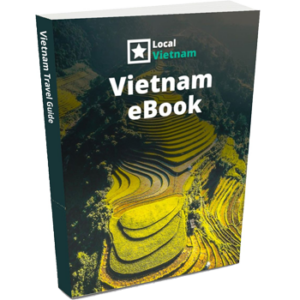
- Destination Guide
- Essential Guide
- Getting Around
- Vietnam Month by Month
- Inspiration
- Vietnam blog
- Travel tips
- Custom Made Trip
- Day- & Multiple Day tours
- Holiday Packages
- Local Meo Vac Homestay
- Local Dong Van Homestay
- Our Team & Company
- Our Customers & Reviews
Copyright © 2023 Local Vietnam
Start typing and press enter to search
Free ebook vietnam travel guide.
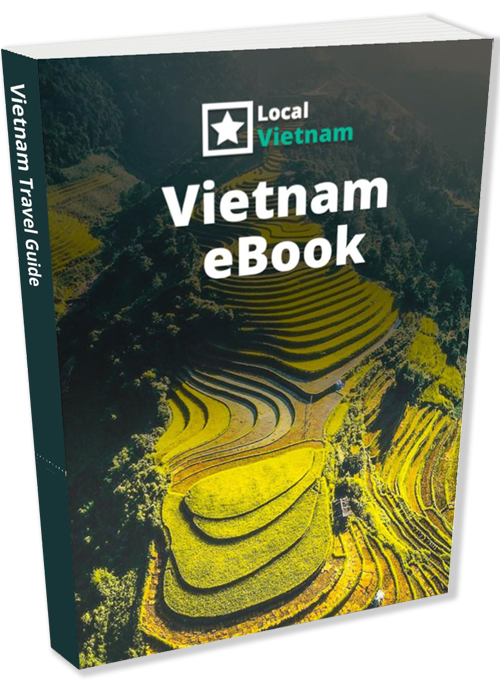
You are using an outdated browser. Please upgrade your browser to improve your experience.

- 3 days in Hue for culture seekers
Detail in the Hue Citadel. All photos by Aaron Joel Santos
Enchanting Hue is one of Vietnam’s most overlooked destinations. Imperial opulence, colonial relics, and picturesque landscapes set the scene for a sensory-rich getaway. Hue residents are proud but warm, eager to share their exceptional cuisine and the city’s monumental history with visitors.
This three-day itinerary will show you the top highlights, plus some little-known neighbourhoods, rarely-visited attractions and local eateries. grab a map and enjoy , day 1 - street scenes, hue citadel and imperial tombs.

Morning – Set off early on your first morning to explore the Hue Citadel. As early as you can, take a bicycle or cyclo and venture into the enticing streets surrounding the Imperial City. Photoworthy stops include Nguyễn Văn Trỗi park and Hiển Nhơn gate, tranquil Tịnh Tâm lake, and the twin ponds of Tấn Miếu and Võ Sanh, where pink lotus flowers bloom from April to July.
TIP: Cafe lovers might like to check out Then Café, a contemporary art space-cum-café, and Bình An Đường Café, which overlooks the Imperial City moat.
Finish your route at the entrance to the Imperial City, a magnificent walled area of tree-lined avenues, parks and canals crossed by ancient bridges. You’ll get more out of your time here with the aid of a guide. You’ll get more out of your time here with the aid of a guide so consider arranging one at your hotel to meet you there. Exploring the royal courtrooms, administrative buildings and religious structures of this UNESCO-listed site takes around two hours.
Lunch : Scope out Hue’s famed vegan food at the idyllic Ngự Hà Garden, or for something a little more upmarket, try Les Jardins de la Carambole.

Afternoon – After resting from your morning jaunt, it’s time to encounter Hue’s legendary royal tombs . The tombs can be reached by boat, car, motorcycle or even bicycle if you’re up for it. All seven royal tombs offer something special. Rather than trying to visit them all, select two or three that appeal most and take time to absorb these singular structures. Here’s a quick rundown:
- The remote tomb of Emperor Gia Long is the oldest, the most haunting, and the least visited.
- Emperor Minh Mạng oversaw great expansion to his empire, and his large, ordered tomb is a representation of military might, successful conquest, and cultural conservatism.
- Emperor Thiệu Trị shared his father’s staunch conservatism and there are clear similarities between his tomb and his father’s.
- Emperor Tự Đức was a passionate poet, and his beautifully landscaped tomb blends harmoniously with nature.
- The tomb of Emperor Dục Đức is within the city limits and is a good option if you don’t want to venture too far, but is also the least grand of all the royal tombs.
- Emperor Đồng Khánh rests in a well-preserved tomb occupying a quiet hill with glorious countryside views.
- The tomb of Emperor Khải Định tends to split opinion with its striking blend of Eastern and Western styles.

TIP: Tự Đức, Minh Mạng, and Khải Định tombs see the highest number of visitors, whereas you’ll likely have the Gia Long, Thiệu Trị, Dục Đức, and Đồng Khánh tombs to yourself.
After seeing a few tombs, you may want to add a visit to the Nam Giao Esplanade or Từ Hiếu Pagoda — both are memorable, rarely-visited sites full of Hue history.
Dinner: Make your way to Thiên Tâm vegan restaurant or Không Gian Xưa for some traditional Hue cuisine.
Day 2 - Pagodas, Palaces and Garden Houses

Morning – Enjoy a later start this morning. After breakfast at your hotel, strike out to find the Bảo Quốc Pagoda. This 17th-century pagoda has seen many changes over time, but is still an active place of worship. After checking out the pagoda, stroll down the leafy canal to Bến Ngự Market, poke your head into Phủ Cam church, or stop for a mid-morning coffee at hip Nghĩa Cafe.
Newly re-energized, you'll want to spend the rest of your morning at the must-see An Định Palace , a stunning royal residence built towards the end of the Nguyen Dynasty. If you’re without a guide you can hire one at the entrance on Nguyễn Huệ street.
Lunch : Try Hue’s savoury royal cakes at Bánh Bèo Hương, next to An Đinh Palace.

Afternoon – After resting for lunch, it’s time to explore Kim Long, a garden house district north of the river. You’re best off exploring this area by foot, bicycle or cyclo as it’s a wonderful opportunity to absorb Hue’s quiet atmosphere. Allow yourself to get lost down the winding countryside lanes but keep an eye open for the historic garden houses, all of which have signposts. If there’s a sign, assume you can enter no matter how private the house seems. Some are ticketed with English-speaking owners, others are simply ancient homes now open to the public.
TIP: Cung Đàn Xưa Café is a charming French-style garden house selling deliciously sharp passionfruit juices and good local coffee -- when it's open. If you’re lucky, the English-speaking owner will proudly show you around his tidy garden.
Just before sunset, make your way to serene Thiên Mụ Pagoda. Late afternoon is the best time to arrive as the crowds will have disappeared and you can watch the sun gently sink beneath the mountains, painting the sky pink and purple (an excellent photo opportunity.)
Dinner: For your second evening in town, choose between Hue delicacies at Huyền Anh or treat yourself at La Residence Hotel, a restored 1930s art-deco mansion with a sublime fine-dining restaurant near the river. Both restaurants are on your way back from Thiên Mụ.
Day 3 - Hue Beaches, Hến Island and the Chinese Quarter
Morning – Make the most of your final day by getting up early and heading straight to Thuận An Beach. The beach is easily accessed by taxi or motorbike from the city. The road passes over two bridges as well as the scenic Tam Giang Lagoon. At the main beach you’ll meet with a flurry of activity: families, retirees and students out for an early morning swim. Wile away the rest of the morning at the beach, enjoy a seafood lunch and return to your hotel for a rest.

TIP: Thuận An beach is great for the sunrise but there are better, quieter beaches if you head south. Beach Bar Hue occupies a beautiful spot that draws an international crowd.
Afternoon – Discover another fascinating corner of Hue: Hến Island and the Chinese Quarter. Cross Ưng Bình Bridge and you’ll find yourself on Hến Island, a rural corner of the city that completely disappears when the city floods. The island is small and it takes less than half an hour to explore. If you’re feeling hungry, stop at one of the c ơ m h ến or bún hến stalls. Hến means “mussel” and the locals catch this tiny shellfish on the banks of the island.
If you have time, cross the river and seek out Chi Lăng and Bạch Đằng street , looking out for Chinese and Vietnamese shophouses, pretty French buildings, and impressive temples, such as Phúc Kiến Temple or Diệu Đế Pagoda.

This is an excellent neighbourhood for some delicious afternoon bites. Gobble up Hue’s signature beef noodle soup at Bà Phụng, or munch on grilled pork rice paper rolls with a sweet peanut and sesame sauce at Bà Tý. To experience Hue’s oldest and most atmospheric café, pull up a seat at Dạ Thảo.

To wrap up your stay in Hue, enter the Citadel and head towards the front gate of the Imperial City that you visited on day one. In the late afternoon this open space is packed with children flying kites and teenagers on skateboards. As the sky fades, lights turn on around the Noon Gate, illuminating the entrance to the ancient city of the Nguyen Kings.
Want more Vietnam travel ideas? Sign up for our newsletter to receive our best stories in your inbox.

- You are here:
- Things to do
- Culture - Arts & Culture -
Create an account
Already have an account? Click here to sign in
By clicking submit, you agree to our Privacy Policy and Terms of Use
Sign in with your social accounts
Sign in with your email
Forgot password? Click here to get it back
Don't have an account? Sign up here
Forgot Password
The entered email has subscribed for Vietnam Tourism monthly newsletter

ROOTS ABROAD

The Best Things to Do in Hue, Vietnam + 2-day itinerary
Set along the banks of the Perfume River lies Hue, once the ancient capital and heart of the imperial Nguyen dynasty . Despite its rich history and plenty of fascinating things to do, Hue often remains off the radar for many backpackers exploring Vietnam.
However, this city, steeped in history yet surprisingly trendy, offers an ideal opportunity to delve into Vietnam’s captivating culture. Wander through ancient tombs, admire exquisite pagodas, and marvel at the majestic walled imperial city. But beyond its historical significance, Hue is a paradise for foodies and coffee lovers . Immerse yourself in the local coffee culture, including the unique Cà Phê Muối or Salted Coffee. With its heritage as the imperial capital, Hue boasts a royal cuisine, featuring delicacies not found elsewhere in Vietnam. For the adventurous traveler, Hue holds another allure— the infamous abandoned waterpark with its iconic Dragon head , which adds an extra layer of intrigue to your journey.
Whether it’s your first time in Hue or a return visit, this comprehensive travel guide aims to assist you in planning your trip. It provides essential information on accommodation options, the most fascinating things to do, a ready-to-use 2-day itinerary , and, of course, recommendations on where and what to eat in Hue.
* Disclosure: This post contains affiliate links. We will receive a small commission if you book through our links. This is at no extra cost to you. This way you’re helping us write awesome travel guides and keep providing you with free content. We only recommend products we like and trust ourselves.
Vietnam Trip Planning Essentials
VISA | Vietnam requires a visa for citizens of certain countries. Make sure to check the visa requirements on ivisa.com for your nationality before you go.
TRAVEL INSURANCE | Consider getting travel insurance from Heymondo when backpacking Vietnam. It’s our top recommendation for comprehensive and trustworthy coverage. Get 5% OFF through our link .
STAY CONNECTED | Buy a SIM CARD at the airport the moment you arrive or get an E-sim with Airalo to secure reliable internet access in advance.
HOW TO GET THERE | Discover the best flight deals to Vietnam on Skyscanner .
GET AROUND | For the ultimate convenience and hassle-free travel in cities, we highly recommend the Grab App .
ACCOMMODATION | Browse Booking.com to discover budget-friendly hostels and hotels.
TOURS & ATTRACTIONS | For booking the best & cheapest city tours and day trip excursions, check out GetYourGuide or Viator .
TRANSFERS | Ready to travel to your next destination in Vietnam? Book your bus or train tickets via 12go .
Best Time to Visit Hue
Hue, nestled amidst lush greenery and encircled by hills, holds the title of Vietnam’s highest rainfall city. It’s a place where you might find yourself reaching for an umbrella or putting on a rain poncho, yet luck may smile upon you with fair weather. The climate in Hue experiences two distinct seasons: wet and dry.
- The dry season runs from March to August , bringing scorching temperatures that can soar up to 40 degrees Celsius. July typically takes the crown as the hottest month, with midday temperatures often reaching unbearable heights.
- Come August, the rainy season kicks in, lasting until January and bringing with it heavy downpours and occasional storms. Temperatures during this period tend to dip to around 20 degrees Celsius.
Although Hue isn’t far from Hoi An or Danang, its weather tends to be hotter and rainier, needing a daily glance at the forecast.
Avoiding Hue from May to July spares one from the intense heat while steering clear from December to January minimizes encounters with torrential downpours.
For optimal conditions, plan your visit between February and April when the weather is typically dry and pleasant. March, in particular, stands out as an excellent time to traverse Vietnam.
For travelers seeking adventures beyond Hue, our Vietnam Travel Tips offer a comprehensive guide to the best times for exploring various destinations across the country.
TIP | Ensure you obtain your visa before embarking on your Vietnam trip!
READ MORE | Vietnam Travel Tips | Complete Trip Planning Guide For First Timers
How many days to spend in Hue?
Situated in Central Vietnam, just a bit north of Da Nang and Hoi An, Hue stands as another essential stop on your Vietnam itinerary . While many travelers opt for a day trip to Hue from Hoi An , we advocate for a more immersive experience by dedicating at least two days to exploring this gem. Despite its underrated status, Hue offers a plethora of captivating things to do, making it well worth extending your stay. Spending two days in Hue allows ample time to uncover its top attractions and immerse yourself in its rich history as a former imperial capital.
JOIN A DAY TRIP TO HUE FROM DA NANG / HOI AN
While joining a day trip from Da Nang or Hoi An is a feasible option, it might not provide the most comprehensive experience. However, for those with limited time, there’s still the possibility of embarking on a day tour to Hue , which covers key sites such as the Imperial Citadel, Thien Mu Pagoda, and the Mausoleum of Emperor Khai Dinh, complete with a satisfying lunch break. Along the journey, you’ll also have the opportunity for scenic photo stops at iconic locations like the Hải Vân Pass and Lap An Lagoon.
How to get around in Hue
To make the most of your time in Hue, we suggest opting for a bike rental to navigate the inner city . The distances between the imperial city and other attractions are often too far to cover on foot. For those planning to explore sites like the tombs and the abandoned waterpark, renting a motorbike can offer even greater convenience as these locations are situated a bit farther from the city center.
Fortunately, most hotels and guesthouses can arrange bike or scooter rentals for the day. Alternatively, bicycle rental shops are also available within the town. If you lack experience with motorbike driving, fret not—utilize the ride-hailing app Grab to effortlessly reach your desired destinations. Just ensure you have an internet connection, either by obtaining a local SIM card upon arrival or acquiring an E-Sim from Airalo for instant connectivity .
Another option for getting around in Hue is to hire a driver for the day . This allows you the flexibility to visit various attractions at your own pace, with the convenience of having someone waiting for you at each stop. Private transfers are particularly advantageous for exploring spots on the outskirts of Hue , such as the abandoned waterpark or the tombs, enabling you to tailor your itinerary to your preferences.
Travel Insurance Make sure you’ve got travel insurance sorted for your Vietnam adventure! Heymondo offers coverage for medical emergencies, theft, delays, cancellations, lost luggage, and much more. With 24/7 worldwide assistance and access to medical chat, you can travel with peace of mind. Plus, as a reader of Roots Abroad, we’ve got you covered with a 5% discount !
Best Things to Do in Hue
Hue, a city rich in history and trendy vibes, invites you to dive into Vietnam’s captivating culture. As the ancient capital and heart of the imperial Nguyen dynasty, it stands tall as one of Vietnam’s most historic cities , often overlooked but ready to enchant.
The grand citadel is a striking symbol of Hue’s past glory, but it suffered significant damage during the Vietnam War , especially during the TET offensive. However, in recent years, Hue has bounced back, thanks in part to a rise in tourism. Today, you’ll find a lively cityscape with trendy hotels, cool bars, and plenty of delicious dining options.
1. Explore the grandeur of Hue’s Imperial Citadel
Undoubtedly one of the best things to do in Hue is visiting the Imperial City of Hue. This walled enclosure, built in the early 1800s, served as the imperial capital of Vietnam in centuries past . Designated as a UNESCO World Heritage Site in 1993, the Imperial City remains the most famous and visited monument in Hue, despite suffering significant damage during past conflicts. While about 80% of the site was partly destroyed by American forces, ongoing restoration efforts are underway. Make sure to keep your eyes open for bullet holes that are still visible in the outer walls.
Covering a vast area of 520 hectares, the Citadel complex is a sight to behold, featuring an array of impressive gates, walls, watchtowers, and moats. The main entrance, Ngo Mon Gate , leads to the Forbidden Purple City , the inner sanctum of the citadel, where visitors can explore gardens, palaces, pavilions, and historic gates.
For over a century, the Imperial City was accessible only to the Nguyen emperors , their families, and select individuals, with severe penalties for trespassers. Today, visitors can enjoy a royal experience by dressing as kings or queens and posing for photos on the throne, available for a small fee.
Practical information for visiting Hue’s imperial citadel
To beat the scorching heat, it’s advisable to visit early or late in the day. Sun protection like a hat and sunscreen is also recommended, as shade is limited. Remember to dress respectfully , as the site holds significant historical and cultural importance.
Depending on your accommodation location, you can reach the Citadel by walking , renting a bicycle, or using a ride-hailing service like Grab. You can explore the grounds independently or opt for a guided tour to learn more about this UNESCO World Heritage Site . While audio guides are available for an additional fee, we personally think they didn’t add much value to the visit and a guided tour would have been a better option. You can find a comprehensive map near the entrance that provides an overview of different routes to ensure you don’t miss any highlights.
ENTRANCE FEE | 200,000 VND (~$8) per person
OPENING HOURS | Every day from 7:30 AM to 5 PM
BUDGET TIP | A visit to the Citadel alone will set you back VND 200,000. However, if you’re planning to explore more of Hue’s imperial history, consider opting for a combo ticket . The combo ticket offers access to Hue’s imperial citadel along with 2 or 3 emperor tombs, depending on the option you choose. The prices for these combo tickets are VND 420,000 and VND 530,000 respectively. If you prefer to visit the tombs separately, each tomb entrance fee is VND 150,000 (around $6) per tomb.
2. Visit the ancient royal tombs
The Nguyen emperors, who reigned over the city of Hue, commissioned the construction of elaborate tombs along the Perfume River to serve as their eternal resting places. While there are a total of 7 tombs in existence, only three— Tu Duc, Khai Dinh, and Minh Mang —are commonly visited by tourists. You can easily pair exploring these tombs with a countryside excursion and a visit to the intriguing abandoned waterpark.
Getting to these attractions is straightforward— either hop in a Grab taxi or consider renting a scooter through your accommodation. That’s exactly what we did, Hue was the only place where we rented a scooter (you know as Vietnam is crazy when it comes to traffic) but here it was very doable. Biking around the tombs was a highlight of our trip, providing a memorable experience. However, we wouldn’t recommend cycling due to the distance between the city and the tombs.
Minh Mang Tomb
Situated 12 kilometers outside of Hue, the Tomb of Minh Mang resides within a walled enclosure spanning several hectares. King Minh Mang, the second ruler of the Nguyen Dynasty, governed southern and central Vietnam from 1820 to 1840. As part of his ambitious construction projects, he commissioned the construction of his own funeral complex in the southwest corner of the city.
Upon arrival, visitors are greeted by expansive grounds adorned with beautiful gardens , pavilions, and statues, all exuding a sense of symmetry and tranquility. With approximately 40 buildings including palaces, pavilions, and temples, the tomb complex resembles a royal palace rather than a traditional burial site . Remarkably, the tomb was completed in just three years and boasts a unique architectural style, characterized by its simplicity and Chinese influences.
Exploring the entire tomb complex can easily occupy an hour or more, allowing ample time to appreciate its beauty and historical significance. However, it’s worth noting that access to the king’s tomb itself is limited, with the gate opened only once a year on the anniversary of Minh Mang’s death.
ENTRANCE FEE | 100,000 VND (~$4)
OPENING HOURS | 7:30 AM–5 PM
Royal Tomb of Khai Dinh King
Located across the river from Minh Mang tombs, you’ll discover the Royal Tomb of Khai Dinh King, renowned as one of the best-preserved tombs in the area. The ascent to the main hall is truly striking, featuring black stone stairs flanked by warrior statues reminiscent of the famed Terracotta Warriors in Xi’an, Ch i na .
In contrast to other imperial tombs, Emperor Khai Dinh’s tomb stands out for its unique use of dark-colored concrete , a departure from the traditional white or yellow hues. Upon climbing 127 stone steps, visitors are greeted by the king’s tomb, where a remarkable statue of King Khai Dinh seated on a throne captivates with its intricate adornments of colorful inlaid glass and porcelain.
Inside the tomb, opulent mosaics depicting cavorting dragons adorn the walls, showcasing the extravagant taste of Emperor Khai Dinh. Despite its relatively small size, Khai Dinh’s tomb stands as the most labor-intensive and expensive tomb of the Nguyen Dynasty. To fund its construction, King Khai Dinh imposed a nationwide tax increase of 30%, a decision that drew criticism from history.
Although Emperor Khai Dinh faced disapproval from the Vietnamese people for his extravagant lifestyle, his tomb remains one of Hue’s most visited sites . Completed in 1931 after 11 years of construction, Khai Dinh Tomb serves as Vietnam’s final imperial tomb.
Influenced heavily by French colonialism in Vietnam, Emperor Khai Dinh’s tomb reflects a blend of Eastern and Western architectural styles. Perched on a steep hillside , its stark white and black exterior provides a striking contrast to the colorful and ornate interior, making the Tomb of Khai Dinh a truly impressive sight to behold.
OPENING HOURS | 7 AM–5:30 PM
Tu Duc Tomb
Another beautiful tomb to visit in Hue is the royal tomb of Emperor Tu Duc, known for his poetry and philosophical writings. Completed in 1867, it is the most famous and grand among the royal mausoleums in the area. Unlike typical tombs, Tu Duc’s tomb feels more like a park , featuring stunning ponds, lakes, pagodas, and pavilions.
Emperor Tu Duc himself designed the tomb before his passing, intending it not only as his final resting place but also as a retreat where he could spend leisure time, much like a second Imperial City. However, the construction of the tomb incurred significant costs and involved forced labor, leading to a failed plot to overthrow the emperor.
Despite his luxurious lifestyle, which included 104 wives and numerous concubines, Emperor Tu Duc faced the sorrow of being unable to have children. The complex reflects his deep love for nature and poetry , with a large lake surrounded by wooden pavilions and tombs dedicated to his wives and favored courtesans.
One interesting aspect of Tu Duc’s tomb is that the emperor chose not to be buried here in the end but instead requested an undisclosed location, a mystery that remains unsolved. Plan to spend around an hour and a half exploring the tranquil grounds of this captivating tomb.
OPENING HOURS | 7 AM– 5:30 PM
3. Embark on an adventure to Ho Thuy Tien Abandoned Waterpark
Hue’s abandoned water park has gained quite a bit of attention online lately, mainly because of its massive dragon-shaped statue in the middle of Thuy Tien Lake . Despite being run-down and covered in graffiti, the dragon has become a hit spot for Instagrammers looking for cool photos. If you’re into checking out weird or deserted places, visiting this spooky water park is a must-do activity in Hue. It’s seriously one of the coolest places to take pictures in all of Asia.
Originally opened back in 2004, the Thuy Tien Lake water park didn’t last long before it shut down. They put a lot of money—about USD 3 million—into building it, hoping to give locals and tourists something fun to do in Hue. But it didn’t work out as planned. There weren’t enough things to do, and there were even rumors about crocodiles living in the lake (though who knows if that’s true).
Even though the park is technically off-limits, lots of people still go there, both locals and tourists. Some folks have even talked about being hassled by people pretending to be guards and demanding money to let them in, so watch out for that. Getting in is pretty easy, though—some people just ride their scooters right in. Just be careful because parts of it are falling apart, especially inside the dragon’s head where there’s broken glass and wires everywhere.
If you’re up for an adventure, rent a motorbike and use Google Maps to find the water park. But keep in mind, there’s talk that they might tear it down soon. So, if you want to see the dragon before it’s gone, you might want to hurry!
4. Indulge in Hue’s imperial cuisine
Exploring the local cuisine is definitely one of the top things to do in Hue, and trust us, you won’t be disappointed. Thanks to its rich royal heritage, Hue boasts a unique royal cuisine , showcasing dishes that stand out from the rest of Vietnam. With flavors crafted by skilled chefs during the Nguyen Dynasty, Hue’s specialty foods are renowned for their distinctive taste. Even acclaimed chef Anthony Bourdain sang praises for Hue’s cuisine.
When you’re in Hue, the options are endless, and trying everything might seem like a daunting task. That’s where a tasting menu comes in handy —it lets you sample a bit of everything and truly experience the variety.
Here are some traditional Hue foods you absolutely must try:
- Bún bò Huế: This famous spicy beef noodle soup is a Hue specialty, distinct from Hanoi’s pho. Expect thicker, more slippery noodles and bold, robust flavors.
- Cơm hến: A flavorful combination of rice and clams, topped with bean sprouts, green onions, fried peanuts, pork rind, chili, and other herbs.
- Bánh khoái: A traditional Hue pancake made with rice flour and filled with pork, shrimp, bean sprouts, and eggs, served with dipping sauce.
- Bún thịt nướng: Vermicelli noodles served with grilled pork, fish sauce, and peanuts.
- Bánh bèo: Steamed rice cakes topped with various toppings like shrimp, mung bean paste, scallion oil, fried shallots, and fish sauce.
- Nem Lui: Grilled pork skewers made from finely minced pork mixed with aromatic herbs and spices, served with rice paper, fresh herbs, and dipping sauce.
- Banh Bot Loc: Also known as tapioca dumplings, these steamed dumplings are filled with pork and shrimp, wrapped in banana leaves, and steamed until translucent.
JOIN A STREET FOOD TOUR
Feeling overwhelmed with all the options? Consider joining a street food tour to sample the best local dishes without the hassle. These tours often include iconic dishes like “bun bo Hue” (spicy beef noodle soup) and other specialties like banh khoai (Hue-style pancakes) and banh bot loc (translucent shrimp and pork dumplings). It’s the perfect way to dive into Hue’s culinary scene and satisfy your taste buds to the fullest.
5. Cross the amazing Hai Van Pass
This day is bound to be one of the highlights of your Vietnam itinerary , just as it was for us! If you’re traveling between Hue and Danang, you absolutely cannot miss the opportunity to conquer the Hai Van Mountain Pass, one of the most breathtaking passes in Vietnam . Known as the Ocean Cloud Pass, this approximately 12-mile stretch of roadway between Da Nang and Hue offers awe-inspiring views.
The Hai Van Pass gained worldwide fame after being featured in an episode of Top Gear, showcasing a road that winds along the mountainside with stunning views of the ocean below . It truly lives up to its reputation and is often hailed as one of the most scenic roads in the world . With its countless bends, the drive from Hue to Da Nang or Hoi An (or vice versa) offers an unforgettable journey through Vietnam’s natural beauty.
Exploring this part of Vietnam on a motorcycle is undoubtedly one of the best ways to appreciate its splendor. You can choose to rent a motorcycle or scooter yourself or opt for an easy rider tour —a fantastic option for those who want to feel the wind in their hair without navigating the roads themselves.
What to expect on an Easy Rider Tour?
On an easy rider tour , you’ll ride on the back of a motorcycle driven by an experienced professional who will take you from Hue to Danang or Hoi An (or vice versa), making stops at all the incredible viewpoints along the way. Acting as your personal guide and driver for the day, they’re familiar with all the hidden gems and perfect photo spots along the route .
While there are several companies offering day trips along the Hai Van Pass, we highly recommend the private Easy Rider Tour that we booked . Our experienced drivers, Dan and Tuan, prioritized our safety and ensured we had an unforgettable experience. They even shared some secret spots and viewpoints that made our journey even more memorable compared to other tours.
6. Visit the Thien Mu Pagoda
The Thien Mu Pagoda, also known as the “Pagoda of the Celestial Lady,” is a famous landmark in Hue, offering stunning views of the Perfume River from its hilltop location. Originally built in 1601, this 7-story pagoda has a long history of destruction and reconstruction due to political unrest. Despite its tumultuous past, the pagoda remains a sacred site, often frequented by monks who can be seen wandering the grounds. Notably, the grounds also house the Austin car famously driven by Thich Quang Duc, the burning monk who tragically set himself ablaze at the Ho Chi Minh intersection to protest for Buddhism’s cause.
For a peaceful photo opportunity, consider visiting Thien Mu Pagoda in the early morning before the tour buses arrive. Alternatively, sunset offers a beautiful view over the river. No entrance fee is required, and you can expect to spend about an hour exploring the pagoda and its surroundings.
Getting to Thien Mu Pagoda is easy. You can easily reach it by bicycle , perhaps after visiting the Imperial Citadel. Another enjoyable option is to hop on a traditional dragon boat and cruise along the Perfume River, as the pagoda is conveniently located along its banks.
ENTRANCE FEE | Free
OPENING HOURS | 8 AM–6 PM
READ MORE | The Ultimate 3-week Vietnam Itinerary for First-Timers
7. An Bang Cemetry City of Ghosts
Nestled away from the usual tourist spots lies An Bang Cemetery, a remarkable burial site known as the City of Ghosts . Its nickname perfectly captures the eerie yet captivating ambiance of the place, making it one of the most intriguing things to do in Hue. In fact, it holds the distinction of being the largest cemetery in the entire country , making it truly an awe-inspiring sight to behold.
Unlike traditional graveyards, An Bang Cemetery features elaborate and vibrant colored tombs resembling miniature houses or temples . These structures are adorned with intricate designs and decorations, reflecting the rich beliefs and cultural traditions of the local community.
What sets An Bang Cemetery apart is its deep-rooted association with the belief in the afterlife. According to local folklore, the souls of the departed reside within the tomb structures , and it’s believed that these spirits can influence the lives of the living. This connection to the supernatural adds an extra layer of fascination to this already captivating site, inviting visitors to explore its mysteries and immerse themselves in Vietnamese folklore.
An Bang Cemetery is around 20 km from Hue center, so you will need a scooter or hire a grab to get here.
8. Visit Thuy Xuan Incense Village Hue
You’ve probably seen stunning images of vibrant incense villages in Vietnam, and now, near the Mausoleum of Emperor Tu Duc in Hue, you can experience one firsthand. The area is adorned with colorful bamboo incense sticks , emitting a fragrant blend of scents like sandalwood, cinnamon, and lemongrass. This traditional craft is a feast for the senses, with locals engaging in the art of incense making.
Legend has it that this incense is among the finest in Vietnam , revered by the Nguyen Dynasty. It held a special status as the sole village entrusted with supplying fragrant incense to the royal court, dynasty officials, and the entire country.
The incense sticks are skillfully arranged into stunning formations, making it a haven for photographers and anyone seeking unique experiences in Hue City. They often offer traditional Vietnamese attire rentals, complete with the iconic conical hats, allowing you to fully immerse yourself in the experience for a small fee.
9. Wander through the Night Walking Street
Just like Bui Vien in Saigon and Ta Hien in Hanoi, Hue also has its popular night spot, Hue Night Walking Street. It might not share the same lively spirit though as in the main cities, it’s still a fun place to hang out at the end of the day . Situated near the Perfume River, it’s right in the heart of Hue City, nestled between the bustling streets of Pham Ngu Lao, Vo Thi Sau, and Chu Van An.
These three streets are known hubs for foreign tourists visiting Hue. Stretching approximately 1 kilometer long, it opens its doors on Friday, Saturday, and Sunday nights , from 6:00 pm to 2:00 am.
During these vibrant evenings, the street comes alive with activity. Motor vehicles are prohibited from entering, creating a pedestrian-friendly environment perfect for strolling , exploring, and soaking up the lively atmosphere. Whether you’re in the mood for street food, live music, or shopping for souvenirs, Hue Night Walking Street offers a diverse range of experiences to enjoy.
READ MORE | The Ultimate Vietnam Packing List | What To Wear For All Climates
10. Experience Local Life at Dong Ba Market
Dong Ba Market stands as the largest and oldest shopping destination in Hue City, with thousands of stalls spanning from Gia Hoi Bridge to Truong Tien Bridge . Dating back to 1899, this market holds significant historical value as both a trading center and a cultural landmark.
Today, Dong Ba Market is a bustling destination for locals and tourists alike, offering a wide range of goods from clothing to food . Strolling around local markets like Dong Ba provides a glimpse into the unique cultural identity of the region. Personally, we find the chaotic charm of Asian markets captivating, enjoying the authenticity and interactions with local vendors . We also love discovering new fruits and vegetables we have never seen before. You can buy almost anything here at the Dong Ba market, so it is also a perfect place to score some awesome souvenirs.
The market’s food court is particularly noteworthy, featuring a variety of Hue’s signature dishes such as ‘banh beo’, Phu Hoa fried spring rolls and Banh Canh Nam Pho. It’s also famous for dishes like Com Hen and Bun Bo Hue, which even caught the attention of Anthony Bourdain . For food enthusiasts, Dong Ba Market is a must-visit, offering a chance to savor the diverse flavors of Hue cuisine all in one place. Consider joining a food tour for a guided culinary experience with explanations provided by knowledgeable guides.
11. Immerse yourself in Hue’s Coffee Culture
We already mentioned that Hue is THE place for history enthusiasts as well as all our foodies out there. But we discovered on our trip that Hue is also heaven for all those coffee addicts out there! We had no idea we would stumble upon so many cute and cozy cafés. Sleek trendy cafés to boho chic or rustic alongside the water.
Besides the city’s historical charm and scenic beauty, coffee shops in Hue offer more than just your daily caffeine fix – they provide a space for relaxation, socialization, and cultural immersion. From traditional Vietnamese drip coffee to trendy espresso drinks, Hue’s coffee scene caters to all preferences . Visitors can sip on a steaming cup of ca phe sua da (Vietnamese iced coffee with condensed milk) while soaking in the serene ambiance of a quaint café or indulge in a coconut coffee or matcha latte at a modern coffee shop.
But the real gem of Hue’s coffee culture? Cà Phê Muối, or Salted Coffee . This unique brew has become our new favorite, reminiscent of the indulgent flavors of salted caramel or salted brownies. The addition of a pinch of salted foam to the traditional Vietnamese coffee, paired with creamy condensed milk, creates a delightful contrast of flavors. Some places even serve it with ice on the side, allowing you to customize your drink to perfection.
Have you tried Cà Phê Muối before? Share your thoughts with us in the comments!
2-day Hue Itinerary
Here’s an ideal 2-day itinerary to make the most of your time in Hue:
- Rent a bike to get around the city and explore the grandeur of Hue’s Imperial Citadel , a UNESCO World Heritage Site showcasing the city’s grandeur and history.
- Dive into Hue’s vibrant coffee scene and treat yourself to the unique flavors of Cà Phê Muối or Salted Coffee at a local café .
- Pass by Dong Ba market to get a feel of local market life, roam around through the stalls, sample local delicacies like Bun Bo Hue, and soak up the bustling ambiance.
- Head to Thien Mu Pagoda , an iconic Buddhist site offering stunning views of the Perfume River and immerse yourself in its serene surroundings at sunset.
- End your day with a culinary adventure at Maison Trang , where you can savor the flavors of Hue’s imperial cuisine with a tasting menu.
- Rent a scooter or order a grab car and embark on an adventure beyond the city limits.
- Discover the eerie beauty of Ho Thuy Tien Abandoned Waterpark , famous for its captivating Dragon head sculpture and perfect for some Instagram-worthy photos.
- Visit the Royal Tombs of Emperor Minh Mang, Khai Dinh, and Tu Duc , each offering a glimpse into the history and grandeur of the Nguyen Dynasty.
- Before heading back to the city pass by Thuy Xuan Incense Village and witness colorful bamboo incense sticks
- Conclude your day by wandering through the Night Walking Street , where you can soak up the lively atmosphere, indulge in street food delights, and browse through local crafts and souvenirs.
With this itinerary, you’ll get to experience the best of Hue’s history, culture, cuisine, and natural beauty in just two days!
Where to stay in Hue
Hue may not be a very large city, but it’s packed with many fantastic things to do. While many of these sights are a bit of a trek from the city center, except for the Imperial Citadel, arranging transportation is necessary regardless. For a hassle-free experience, we suggest staying near the center, particularly south of the Perfume River. This strategic location allows easy access to restaurants and cafes, perfect for winding down after a day of adventures without the need for a taxi. With a diverse range of accommodations available, from budget-friendly guesthouses to exquisite retreats, there’s something to suit every traveler’s preferences in Hue.
HIGH-END | Senna Hue Hotel
Situated in the heart of Hue along the scenic Perfume River, Senna Hue Hotel provides an affordable yet luxurious experience. With the historic Citadel just a stroll away, guests can delve into Hue’s rich history before unwinding by the hotel’s inviting swimming pool.
RETREAT | Pilgrimage Village Boutique Resort & Spa
Even though located in the tranquil outskirts near the tomb area, the Pilgrimage Village Boutique Resort & Spa offers a luxurious escape that’s too enchanting to overlook. If you crave an opulent immersion into Vietnamese culture, complete with top-notch hospitality, indulgent spa treatments, and a variety of onsite dining options, then this resort is your ultimate haven.
Despite its serene location, the resort provides convenient access to the town center via a complimentary shuttle service. Guests can choose from a range of beautifully furnished accommodations, including bungalows, huts, villas, and houses, all surrounded by lush greenery. For added luxury, some rooms even boast private pools.
Beyond relaxation, the resort offers enriching experiences such as Vietnamese cooking classes, Tai Chi sessions, and curated tours, ensuring a truly memorable stay amidst the natural splendor of Hue.
BOUTIQUE HOTEL | The Scarlett Boutique Hotel
Located in the heart of the city, The Scarlett Boutique Hotel offers a blend of elegance and convenience. With spacious rooms and excellent amenities, guests can enjoy a comfortable stay close to the old town’s attractions and vibrant dining scene.
MID-RANGE | Hue River Side Villa
Ideal for couples seeking a tranquil yet budget-friendly getaway, Hue River Side Villa boasts a serene riverside location. Guests can relish meals in the on-site restaurant or amidst the peaceful garden while enjoying picturesque river views from their private balconies.
HOMESTAY | Le Robinet Homestay
For budget-conscious travelers seeking comfort and warmth, Le Robinet Homestay in Hue is an excellent choice. Offering superb value for money, this charming homestay is renowned for its cleanliness and friendly staff. Reflecting the serene pace of Hue, it exudes character and warmth, providing guests with a home away from home experience. The lush garden and cozy sitting areas offer perfect spots to unwind after a day of exploration. With its proximity to the imperial citadel and local eateries, convenience is ensured. Moreover, guests can enjoy complimentary amenities such as free bikes, books, and games, enhancing their overall experience. Le Robinet Homestay truly stands out for its excellent location, welcoming atmosphere, and exceptional value, making it a highly recommended option for families and budget-conscious travelers alike.
BUDGET | Candy Inn
Nestled in a quiet side street in the city center, Candy Inn offers cozy and well-maintained rooms along with a delightful breakfast. As it is close to restaurants and bars, this charming guesthouse provides a peaceful base for exploring Hue’s attractions. Furthermore, the hospitable owners are dedicated to ensuring a comfortable stay for their guests. Always available to offer assistance, they provide valuable tips and can facilitate various rental services, including bikes and scooters.
Where to eat in Hue
We mentioned it already and will emphasize it again, Hue is THE place in Vietnam for foodies and coffee lovers. Eating and drinking your way through Hue City is just one of the best things to do. For a taste of the region’s unique cuisine, we highly recommend trying the imperial tasting menus at the first two restaurants listed below. And of course, no visit to Hue would be complete without indulging in a salted coffee at one of the cozy cafés .
Best Restaurants in Hue
Madam Thu Restaurant – Specializing in regional dishes unique to Hue, “Madam Thu” offers precisely these unique local delicacies. A popular choice along the night-walking street, this restaurant offers a delicious option for a tasting menu. Be sure to make a reservation in advance to avoid long waits, especially during peak hours.
Maison Trang – Dive into the flavors of imperial cuisine with a tasting menu at Maison Trang. This family-owned establishment boasts a warm atmosphere and generous portions. Our favorite was Bánh bèo, would order a gigantic plate just of those!
Bà Gái Hue Beef Noodle Soup – Don’t be fooled by its humble appearance; this spot is renowned for its Hue beef noodle soup, a favorite among tourists. Plus it’s always packed with locals so also a good sign!
Nook Eatery – Satisfy your burger cravings and indulge in Western favorites at Nook Eatery. After traveling in Asia for a while, we understand the longing for familiar tastes, making this spot our guilty pleasure. They also offer amazing breakfast options and mouthwatering coconut coffee.
Cozy Restaurant – A favorite among travelers, Cozy Restaurant is always bustling with activity. With options ranging from vegetarian and vegan dishes to local Vietnamese cuisine, there’s something for everyone to enjoy.
Nhà Hàng Chay Vạn Hạnh – Located conveniently along the road to the tombs, this cozy restaurant is perfect for refueling. Offering a variety of vegetarian options, it’s an ideal spot to recharge before continuing your explorations.
Best Cafés in Hue
Hiên Cà Phê – Discover this beautiful café just down the road from Nhà Hàng Chay Vạn Hạnh for a fix of salted coffee between tomb raiding.
DAUDO – Nestled along the riverbank, DAUDO offers a cool ambiance and captivating views. Don’t miss their unique salted peanut coffee, perfect for a refreshing break.
Trầm Cafe – After a stroll around the imperial palace, unwind at Trầm Cafe with a coconut coffee or one of their homemade delights.
Ca Phe Muoi – Located behind the imperial citadel, Ca Phe Muoi is renowned for its famous salted coffee, making it the perfect stop during your explorations.
Mayla – healthy bread – This place was around our corner and we loved it for a quick, delicious & affordable snack such as Banh Mi or a granola bowl. Of all places, their salted coffee was our favorite!
Binancians Coffee – A chill coffee store with a great vibe, they also have some nice refreshing drinks like passionfruit juices.
Hanok Café – Located in a small alleyway, it almost feels like a hidden gem. This Korean-style café is very aesthetic and has a fresh outdoor area, which lends itself perfectly to relaxing, reading a book, or hanging out with friends. They serve beautiful drinks, which come with a snack on the side.
How to get to Hue
Hue, located in Central Vietnam, serves as the capital of the coastal province of Thua Thien Hue. Situated approximately 2 hours northwest of Da Nang, another significant city in the region, Hue boasts easy accessibility from various parts of Vietnam. With its own airport bearing the code HUI, flying into Hue is a convenient option for travelers coming from Hanoi or Ho Chi Minh.
Here are a few examples of how to reach Hue from different cities across Vietnam:
How to get to Hue from Hanoi
By Plane: Opting for a flight from Hanoi to Hue is the quickest and most convenient option, taking approximately 1.5 hours. Prices range from $50 to $100. For the best flight deals, check out Skyscanner .
By Train: For a scenic and cost-effective journey, consider taking an overnight train . Though it spans 13 hours, it saves you a night’s accommodation and offers a unique experience. Ticket prices vary between $22 and $80.
By Bus: The most economical choice is an overnight bus ride , which typically lasts around 14 hours. Prices range from $20 to $30, depending on the bus type. There are these VIP buses available via 12Go , which we took to Sapa, where you have your own cabin, a very comfortable way to travel!
How to get to Hue from Ninh Binh
The journey from Ninh Binh to Hue takes about 11 hours. The most recommended mode of transport is the night train from Hanoi , which passes through Ninh Binh. Alternatively, you can get back to Hanoi first, and fly to Hue. But for efficiency and savings, overnight transport options like trains or sleeper buses are preferable. We chose to book the sleeper train through 12go and were pleasantly surprised by the experience. It proves to be the most cost-efficient option, offering cleanliness and punctuality. To secure your spot, it’s crucial to book at least two weeks in advance , especially during the high season when availability tends to fill up quickly.
How to get to Hue from Hoi An & Da Nang
To travel between Hue, Da Nang, and Hoi An, you have multiple options. The train is available but only stops in Da Nang , so you’ll need to arrange transport from Hoi An to Da Nang first. The train ride takes about 2.5 hours and costs between $6 and $8.
Alternatively, buses or minibusses are available , taking around 2 to 3 hours and costing about VND 170,000 to VND 200,000 ($7 to $10). Da Nang is the city closer to Hue, about 90 km away.
For a truly adventurous and unforgettable experience, consider joining an Easy Riders tour , like we did. Riding on the back of a motorcycle across the legendary Hai Van Pass is an absolute thrill, offering unmatched views and excitement. Check out the section above for more information on this option. If you’re confident in your abilities, renting a scooter or motorcycle is another great option. This iconic journey takes you along charming countryside roads, past verdant rice fields, and along the stunning Vietnam coastline, featuring the breathtaking 21km stretch of the Hai Van Pass.
How to stay safe in Vietnam
While Vietnam is generally safe for travelers, it’s wise to be prepared for unforeseen circumstances such as petty theft. In case you are thinking of renting a scooter or motorbike it’s definitely advised to look into travel insurance . Having reliable travel insurance is a smart move to ensure a smooth journey and coverage in case of accidents or injuries on the road, providing peace of mind whether you’re on a short backpacking trip or a more extended stay abroad.
Choosing travel insurance that includes medical expenses, trip cancellation or interruption, and protection against lost or stolen belongings is crucial. Review the coverage and policy details carefully to align with your specific needs.
Heymondo , a recommended provider, offers comprehensive coverage and flexible monthly plans. Their user-friendly app simplifies policy management and communication, even through WhatsApp. Coverage includes Emergency Medical Assistance, insurance for stolen or damaged luggage, Travel Disruption coverage, and Trip Cancellation Coverage. Heymondo also provides additional coverage for items like electronic equipment and adventure sports at an extra cost.
TRAVEL INSURANCE | Make sure to check out Heymondo for your upcoming Vietnam trip and enjoy 5% OFF through our link CLICK HERE .
Practical Booking Resources
TRANSPORTATION | For booking ferry, bus, and train rides online, we recommend using the website 12go . This platform has been our go-to across Asia, saving us from the hassle of queuing at travel agencies or bus stations. If you’re traveling during peak season, consider booking tickets ahead, some routes in Vietnam can get booked out quickly.
ACCOMMODATION | Finding affordable places to stay in Vietnam is a breeze with Booking.com . It’s the ideal platform to discover budget-friendly hostels and hotels.
FLIGHTS | Discover the best flight deals to Vietnam on Skyscanner . We love that they highlight the days with the cheapest prices for a destination, and the ability to search by month or region for flexibility.
TRAVEL INSURANCE | When it comes to travel insurance, especially for backpacking in Vietnam, consider Heymondo . It’s our top recommendation for comprehensive and trustworthy coverage.
INTERNET | Secure reliable internet access for your Vietnam trip with Airalo . Simply install it on your eSIM-compatible smartphone before your journey.
TOURS & ATTRACTIONS | For the best and most affordable city tours, day trip excursions, food tours, and cooking classes in Vietnam, check out GetYourGuide or Viator .
VISA ORGANIZATION | Before your trip, ensure you check the visa requirements for your passport nationality. Explore details on travel documents at iVisa.com .
We hope this Hue travel guide helps you out when planning for your exciting upcoming trip. You can show some ❤ and support for the blog and help us share more adventures! Our travels are entirely self-funded, so any show of support is greatly appreciated. It allows us to keep writing helpful travel guides and gather information to make it easier for people to discover the world.

The Ultimate Vietnam Packing List | What To Wear For All Climates

The Best Hanoi Street Food Places | Ultimate Vietnam Food Guide

The Best Cafes in Hanoi | The Ultimate Vietnam Coffee Guide

The Ultimate 3-week Vietnam Itinerary for First-Timers
Your blog has become my daily dose of positivity and inspiration It’s a space that I always look forward to visiting
Your blog is a breath of fresh air in the often stagnant world of online content. Your thoughtful analysis and insightful commentary never fail to leave a lasting impression. Thank you for sharing your wisdom with us.
Leave A Comment Cancel reply
Your email address will not be published. Required fields are marked *
Save my name, email, and website in this browser for the next time I comment.

26 Incredible Things to Do in Hue + Tips for Your Historical Trip

Wondering what the best things to do in Hue on your first visit are? Here’s all I got up to on my long awaited trip and then a subsequent trip where we tried to do Hue in a day !
Back during my two and a half weeks in Vietnam in 2016, I remember being in Hội An and scanning a list of tours at our hotel and wondering where and what Huế was. At 3 hours away, it wasn’t exactly a good day tour option, but I was intrigued by this historical city and knew I’d want to visit someday even though I didn’t even know if I’d be back to Vietnam!
I finally managed to make my way to Huế over Christmas, first spending two days with friends at the end of their central Vietnam trip and then spending two more days as I worked with Azerai La Residence Huế at their stunning Art Deco property. A few months later I went back for what wound up being a day with Alyshia as we squeezed in to her going-away trip!
Here’s all I got up to and a few things I didn’t manage but want to if I make it back for a third trip!

A Brief History of Hue
Huế actually reminds me a lot of Jeonju in Korea with all its more recent history. While Jeonju is a good representative of the Joseon dynasty, which is what has shaped much of Korea’s cultural traditions, Huế is a good representative of the Nguyễn dynasty, which is what has shaped much of Vietnam’s cultural traditions! Much of what you’ll want to visit in Huế relates to the Nguyễn emperors and their very, very tumultuous rule over the country.
But I’m getting a little ahead. To really get a full idea of Huế’s history, we have to go back to a time long before the Nguyễns had control.
Pre-Nguyen Dynasty
The area that Huế is part of first came into Vietnamese hands via the marriage between Chế Mân, part of the Cham people , with Vietnamese princess, Huyền Trân. In order to marry her, he offered her father the Cham areas called O and Lý, which he renamed to Thuan and Hóa.
Almost 300 years later, there was a series of wars and rebellions before the Nguyễns took full control. Basically, the Mạc dynasty fled Cao Bằng in NE Vietnam after the Lê emperors came into power under Nguyễn Kim. Because Nguyễn Kim was then poisoned by the Mạc dynasty, his son-in-low, Trịnh Kiểm, became the leader, assassinating Nguyễn Kim’s eldest son to ensure his legitimacy.
One of Nguyễn Kim’s other sons, Nguyễn Hoàng, pretended to be crazy and got his sister, Trịnh Kiểm’s wife, to convince him to allow Hoàng to go south to Thuan-Hóa to govern and try to pacify the Mạc loyalists.
Trịnh Kiểm allowed him to go, and he went to work making the region loyal to the Nguyễn family before rising up against Trịnh. Soon it became the Nguyễn lords vs the Trịnh lords with the Trịnh lords taking northern Vietnam and the Nguyễn lords taking southern Vietnam. This was all under the Later Lê dynasty.
Anyway, it was during this period, in 1687 specifically, that the Nguyễn lords began to construct the Citadel in what is now known as Huế, beginning to establish the city’s role in their later dynasty.

The Nguyen Dynasty
In the latter part of the 1700s, the Tây Sơn rebellions rocked central Vietnam so that Huế fell under different rules pretty rapidly before Gia Long (then Nguyễn Ánh), considered the successor of the Nguyễn lords, took back control and reunited the country.
The Nguyễns would go onto rule over Vietnam from 1802 – 1945 when the last emperor, Bảo Đại abdicated to Hồ Chí Minh. If you know anything about the 1800s and 1900s anywhere in the world, you know this was kind of a crazy time in Vietnam was well. Colonialism was alive and well, and Vietnam eventually fell under French control, becoming a part of their French Indochina.
The Nguyễn emperors varied between being completely against the French and basically puppets of their regime, but through it all they used Huế as their capital until Bảo Đại declared Saigon his capital in 1949.
Huế would go on to see some of the worst of Vietnam’s fight for independence in the latter half of the 1900s. Since it’s so central, it’s incredibly close to what was then the DMZ of Vietnam , and the Battle of Huế is considered one of the worst of the Vietnam War (or the American War, if you’re in the country).
For a while, much of the Nguyễn landmarks in Huế fell to neglect as they represented the type of regime the now communist Vietnam had just fought against. Luckily, they did not go the way of China’s cultural revolution and instead decided to restore these stunning buildings so visitors can peak into Vietnamese history.
To help you visualize where everything I talk about below is, here’s a little Google map to guide you:
Cool Sightseeing Things to Do in Hue
And now for the fun stuff — what exactly to do in Huế!

1. Go out to the Royal Tomb of Minh Mang first
- Vietnamese Name: Lăng mộ Hoàng đế Minh Mạng
- Address: QL49, Hương Thọ, Hương Trà, Thừa Thiên Huế
One of the big things to do in Hue is visit at least one of the many royal tombs sprinkled around Huế. We planned ours so we would visit three in the morning, starting with the Royal Tomb of Minh Mạng .
He was the second Nguyễn emperor (reign: 1820 – 1841), and it’s under him that the Champa kingdom came to its final end and a number of foreign missionaries were executed. His tomb is the farthest from the city of Huế at about 10km away. It’s a very symmetrical area, where you pretty much go straight back to see everything. You also won’t see his actual resting place as it’s behind a huge stone fortress that’s only open once a year on his death anniversary.

2. Visit the Royal Tomb of Khai Dinh next
- Vietnamese Name: Ứng Lăng Khải Định
- Address: Khải Định, Thủy Bằng, Hương Thủy, Thừa Thiên Huế
After Minh Mạng, head to the much different-looking Royal Tomb of Khải Định. Khải Định was the twelfth Nguyễn emperor (reign: 1916 – 1925) and wildly unpopular for how close he was with French colonists. Under him, the Vietnamese writing system changed from Chinese symbols to its current Romanized form.
His tomb actually took longer to build than he was alive, and if you notice it looks very unique for Vietnam. This is because Khải Định wanted it to look like a medieval European castle. Kind of? It’s much smaller than the other two tombs we visited, but it does feel very Western and it’s on a steep incline of 127 steps, so prepare to climb!

3. End with the Royal Tomb of Tu Duc
- Vietnamese Name: Lăng mộ Hoàng đế Tự Đức
- Address: Thôn Thượng Ba, Thành phố Huế, Thừa Thiên Huế
Our last royal tomb was that of Tự Đức , who was the fourth Nguyễn emperor (reign: 1847 – 1883). At 36 years, he had the longest reign, and his is seen as a turning point in Vietnamese history. No longer was being anti- French and anti-West seen as characteristics of a strong leader, and his suppression of missionaries would lead to war with both the French and the US. Under him, the Treaty of Saigon (1862) was signed, creating Cochinchina and beginning French colonial rule of Vietnam.
His tomb is pretty sprawling, you’ll definitely want to allot more time here than the other two. It was initially used as an out-of-the-way palace, built while he was still alive, and then used as his tomb after the fact. Kiến Phúc, who was the seventh emperor but died young, is also buried here.

4. While near Tu Duc, check out the Incense Village
This is definitely one of the best things to do in Hue! On your way back from Tự Đức, stop in the little incense village! It’s probably much more hoppin’ closer to Tết, but there are still quite a few places you can visit. Many of them know tourists like to come and see all the colorful incense sticks, so they encourage photo taking and will even show you how the sticks are made. If you don’t buy anything, I do recommend giving them a small tip to say thanks!
I wound up buying some of the yellow incense sticks because they smell like lemongrass. We stopped at a shop called Be Ti — the owner and her mom were super cute and friendly! This is their specific address.

5. Spend the morning wandering the Imperial City of Hue
- Vietnamese Name: Kinh thành Huế
- Address: Phú Hậu, Thành phố Huế, Thừa Thiên Huế
I mean if you just look at the map, the Huế Citadel is massive . Some posts on things to do in Huế will break up parts of the citadel into each bullet point, but it’s all one in the same and within the citadel walls, and I truly couldn’t tell you where exactly the Purple Forbidden City (Tử cấm thành) starts within the Imperial City (Hoàng thành). If I ever feel like digging my heels in and re-tracing my steps to tell you every single building, temple, and landmark we walked by, I’ll make a whole separate post :p.
But anyway, just walk around the Citadel and allot yourself a whole morning and then some if you want to try to see everything there is. One important note is that you do not exit the same way you enter, which is extremely annoying if you only discover this after walking around for 3 hours and just want to find a taxi to get lunch.
To enter, you’ll go through Ngọ Môn gate. I recommend turning right and seeing the right side, the center, and then the left side. The exit is on the left side through Cửa Hiển Nhơn gate. It’s nowhere near Ngọ Môn gate, so if you make our mistake, you’ll have quite a walk just to leave!

6. Visit the Royal Antiquities Museum
- Vietnamese Name: Bảo tàng Cổ vật Cung đình
- Address: 03 Lê Trực, Phú Hậu, Thành phố Huế, Thừa Thiên Huế
If you want some more history on Huế, I would pop over to the Royal Antiquities Museum. You could do this right after walking around the Citadel as it’s right outside the exit. The main building is all about the Nguyễns while there’s a side exhibit about the Champa Kingdom history.

7. Walk along the Perfume River
- Vietnamese Names: Sông Hương, Hương Giang
Since I visited the museum a different morning than the Citadel, I actually decided to walk back along the Perfume River and towards Azerai La Residence after eating lunch. It’s such a nice river to walk along and on the way you’ll see some different monuments or interesting buildings. It might be too hot for this in the summer, but in December it was the perfect temperature.
Side note: apparently the Perfume River is so named because in the autumn, flowers will fall into the water and create a floral scent. Given how bad air pollution is in Vietnam, nooooot sure that still holds true today, but if anyone who’s been during this season can attest, let me know!

8. Spot the French architecture in Hue
There are a number of French-designed buildings sprinkled through Huế, Azerai being one of the Art Deco styles. I also walked by the UBND tỉnh Thừa Thiên Huế. This blog post has some more spots to check out. I kind of want to get the train to Huế just to visit the pinkish railway station?

9. Visit the abandoned water park!
A very cool spot to visit is the Thuy Tien Lake Abandoned Water Park . It was opened in 2004 and shut down by 2006 but parts of it remain like the most popular spot, the giant dragon head! It seems like your success on getting in really depends on the day. I guess because it had been raining, we were able to just walk right in. No guards or anything! Our taxi just waited outside for us and we walked the 10 minutes over to the dragon head. When we were leaving, we did see guards giving the people coming in a hard time, so who knows?

Foodie Things to Do in Hue
There are so many foodie things to do in Hue, you’ll be in heaven. It’s such a good city to visit if you love Vietnamese cuisine! I ate very well, and I probably didn’t even get to most of the different dishes and cuisines you can find all over.
We did a food tour one afternoon that we booked through Pilgrimage Village, but I don’t know that I’d recommend it as it was pretty expensive and the communication wasn’t great. Instead check some of these out:
- Huế Street Food Tour
- Flavors of Huế Motorbike Tour
- Huế Food Walking Tour
- Evening Cycle Food Tour
- Vegetarian Food and Night Tour by Motorbike
Or map out these foodie things to do below and DIY it!

10. Have a cup of salt coffee
If Hanoi has egg coffee, Huế has salt coffee or cà phê muối ! I became quite a fan of salt coffee by the time I left getting, stopping by Le Gare Coffee and asking for it for my last breakfast. It’s pretty much exactly as it sounds — strong Vietnamese coffee, condensed milk, and a heavy dose of salt for a unique taste.
The coffee is a newer invention but has quickly become as synonymous with Huế coffee as egg coffee has with Hanoi. You can get it pretty much anywhere, but the original cafe that invented it is apparently this cafe , aptly called Cà Phê Muối.

11. Try bun bo where it came from
I meannnnn — how can you go to Huế and not try bún bò Huế ? I’ve eaten this dish quite a few times in Saigon, so naturally I had to try it in its namesake city. If you translate it, bún bò Huế is literally “Huế beef noodles.” Its made by simmering the broth with beef bones and lemongrass and then mixed with fermented shrimp sauce, sugar, and spicy chili oil. Like the name suggests, it comes with beef and noodles (sometimes also including congealed pig blood, which is better than it sounds).
Funny story about our picture above (and a smaller example of why our food tour guide…wasn’t my favorite). Bún bò is a fairly spicy dish, and we were warned Huế cuisine as a whole is spicier than other regions. So we asked that our bowl not be too spicy and… somehow in the translation our lady took out all the spice. Like your bún bò broth should not look like this! It should be much darker.
There are honestly a million bún bò spots all around Huế, so just walk out of your hotel and you’re sure to find one with in 5 minutes. If not, ask your hotel for local spots — someone there definitely knows and has a favorite.

12. Fall in love with banh khoai
Banh khoai, banh khoai, you are the apple of my eye
Kidding (a little)! In Saigon, bánh khoái is better known as bánh xeo , though I do think the two are a bit different beyond just their names. I had bánh khoái twice in Huế and it’s a lot crispier than the bánh xeo I’ve had in the south. Either way, I’m a bit addicted to both and have gotten bánh xeo too many times to count since getting back.
Basically, it’s a sort of rice flour – water- turmeric powder base filled with different veggies or meat. You break it apart and eat it with leafs and some sauce and yum .
I had bánh kháoi at Bánh Khoái Thượng Tứ and Quán Bánh Khoái Hạnh .

13. Look a bit silly slurping down banh beo
You ever try eating oysters for the first time? Like you kinda feel a bit silly trying to eat them! For me that’s how bánh bèo is, though, again, it didn’t stop me getting them like four different times — at Pilgrimage Village, Quán Bánh Khoái Hạnh , Bánh Khoái Thượng Tứ , and this spot nearo TOVO Hostel.
Bánh bèo also originates from Huế and is made by combining rice and tapioca flour with some salt. You then make a well in the middle and fill with warm water before kneading the dough and adding more water until it’s a thin batter. Then you put them in their little steam it to make the base before adding on the rest of the ingredients like dried shrimp and crispy pork skin.
When you eat it, you kind of loosen it from the little bowls it comes in with your spoon, pour a little bit of nước mắm sauce and sort of slurp it down! Definitely not a first date kinda dish (or maybe if that’s what you’re into), but something not to be missed in Vietnam.

14. Dig into banh canh ca loc
On my last night, walking back from Le Gare Coffee, I decided I wanted to eat some proper street food for dinner — outside on plastic stools and all. I saw a sign for bánh canh cá lóc and decided to stop in! Where I ate is literally in an alleyway. I marked it on the map above, but don’t get it confused with the actual restaurant listed (though I’m sure that spot is also delicious). I also got it at another place right before we left Hue on my second visit and was still so good!
When you order your dish, you’ll literally watch the owner make the noodles from scratch, rolling out the dough, which is made from tapioca or rice and tapioca flour. This is the “bánh canh” part of the dish. The “cá lóc” is snakehead fish. Once the noodles have been cooked, she’ll start putting the soup together with a delicious broth, the fish, veg, and, of course, the freshly made noodles.

15. Try (or eat 20 of) banh bot loc
YUM! Alyshia introduced me to these as their her favorite Vietnamese food. Bánh bột lọc is sort of like a chewy tapioca outside with a shrimp on the inside all steamed together. You then dip it in sweet chili fish sauce and eat. I’m warning you, it’s very easy to just power through like 20 of these. Again you can find these in a ton of restaurants but we got ours across the way from Tovo.

16. Try nem lui Hue
At Quán Bánh Khoái Hạnh , I also had a chance to sample the unique nem lụi Huế . These are basically grilled pork skewers but instead of a stick, they’re packed around lemongrass stalks. You’ll dip it in a sauce before wrapping it in a leaf with some veggies and eating. You can eat the lemongrass or take it out!

17. Try some com hen!
I know, Huế really comes through with the interesting dishes! It might actually be my favorite place to eat in Vietnam now? This is cơm hến (well bún hến because it’s made with noodles, not rice) which translate to mussel rice. It’s made with a lot of the usual Vietnamese ingredients but one of the special things I liked were the roasted peanuts! We got it at the most random spot near the Citadel. Obviously not really on the map, but it was by (or may be at) this place .

18. Try the vegetarian options in Hue
There are actually quite a few vegetarian options in Huế. We stopped at Lien Hoa which is attached to a Buddhist temple. We got the above dishes, but a lot of people were having hot pot around us. Hue Grit also has a good list of vegetarian spots that look mouthwatering!

Things to do in Hue that I Didn’t Do
19. cruise along the perfume river.
While I did walk along the Perfume River, I did not actually cruise it! Something to do on another trip. Better yet, I’d probably try to plan a sunset cruise with dinner and/or drinks! I know Azerai has a gourmet dining experience and a cocktail cruise experience that you can book with them, but if they’re full, you could also try this dinner cruise option.
20. Visit other museums in Hue
There are a few other museums in Huế I would’ve liked to visit but didn’t make it to. I thought the XQ Hand Embroidery Art Museum looked really interesting as you can learn more about embroidery in Vietnam and even watch some women at work. On that same street, is the Diem Phung Thi Art Museum , all about Dieng Phu Thi who was a huge sculpture artist during wartime.
Near the Royal Antiquities Museum is the General Museum Complex, which is what I think I tried to visit but was definitely under construction. Next to Azerai is the Hồ Chí Minh Museum , which is about Uncle Ho, though I’m not sure how it differs from the Hồ Chí Minh museums in Hanoi and Saigon.

21. See a show at the royal theater
In the Imperial City is the Duyệt Thị Đường Royal Theater (Nhà hát Duyệt Thị Đường) and you actually can go watch a show! They have the times listed outside, and I remember one being more in mid-afternoon. Otherwise you can pop in and see some of the exhibits which give a bit of history to the theater itself and the shows that have gone on here.
22. Visit An Dinh Palace
An Định Palace (Cung An Định) was once the home of Khải Định and later Bảo Đại. This is where he lived after abdicating in 1945. Given that it was renovated under Khải Định, it’s no wonder it looks so European! Definitely somewhere to visit on a return trip or if you’re going, maybe combine with the royal tombs since it’s out that way!
23. Check out the many temples around Hue
One of the first photos I saw of Huế was actually of a huge pagoda at Thien Mu Pagoda. There are quite a few temples that seemed worth visiting — Bao Quoc, and Tu Dam are some I had starred.
24. Specifically visit the temple of Princess Huyen Tran
- Vietnamese Name: Trung Tâm Văn Hóa Huyền Trân
- Address: 151 Thiên Thai, An Tây, Thành phố Huế
Okay, I went on quite the journey looking up Princess Huyền Trân, whose marriage to Champa king, Chế Mân, gave the Vietnamese the areas that hold Huế long before the Nguyễns were in power. I smell an interesting love story depending on who you believe!
Anyway, while in Huế, you can visit her temple (or cultural center?). Even without knowing who she is or her story, it’s a gorgeous area, not quite as far out as the tomb of Minh Mạng.
25. Visit more of the royal tombs
There are so many more tombs you can visit! I mean the Nguyen dynasty had thirteen emperors, and only two (Bảo Đại and Ham Nghi) were initially buried abroad. This means you can also see the tombs of Gia Long , Thieu Tri , Duc Duc (which is shared with Thanh Thai and Duy Tan), and Hiep Hoa (can’t seem to pinpoint it on a map).
26. Enjoy Nam Giao Esplanade
The Nam Giao Esplanade looks like a very cool area, especially from aerial photos. It was built under Gia Long and was meant to be a place for the emperors to present offerings (including animal sacrifices) to Thuong De . Ceremonies lasted up until Bảo Đại’s abdication in 1945. If you go during the Festival of Huế, you can see a re-enactment of the ceremony.
Hue Travel Tips
Where to stay in hue.
When figuring out where to stay in Huế, I’d take a look mainly at areas around the Citadel if you want to be able to walk more. If you want something quieter, there are few places further out, though they do basically require you to motorbike or get a taxi anytime you leave.

Azerai La Residence Hue
I wrote a whole review of Azerai La Residence Huế if you want to dive into more of why I enjoyed my stay and all the cool aspects of its history. If you enjoy luxury hotels, you 100% do not want to miss staying here, especially right now with all their offers . The staff is lovely and you really cannot beat its location on the Perfume River. Opt for one of the river view rooms and at the very least do not skip afternoon tea. If you really want to splash out, check out their gourmet dinner and sunset cruise!

Pilgrimage Village Hue
A lovely option if you want to stay further away from town is Pilgrimage Village. We stayed here over Christmas before I went to Azerai, and had such a lovely time! Just a shame it wasn’t quite warm enough to totally enjoy the pools (though that didn’t stop us from getting in the warm pool twice). The staff here is absolutely wonderful as well and they even fetched my camera cap for me as I was checking out even though it was at pretty much the opposite end of the resort!

TOVO Hostel
For those on a budget, TOVO Hostel is also super cute! Alyshia found it, and it’s in such a nice spot in town plus the owner is super friendly. I like the cute Santorini-inspired decor! Just a warning, there’s no elevator so you will have to carry your suitcase up some flights of stairs!
Other Places to Stay in Hue
Another place I heard about but didn’t stay is Alba Wellness Resort ! It’s pretty far out of Huế and not necessarily a good base if you plan on packing your days with sightseeing. However, they have hot springs so it could be a nice way to finish your trip, especially if do some sort of Central Vietnam route from Hội An – Đà Nẵng – Huế.
For more midrange and budget options, check out Huế River Side Villas , Tùng Homestay , AnAn Homestay , and Tâm Homestay .

Tours in Hue
It’s pretty easy to DIY your own tour in Huế based on my suggestions above! At least the taxis we experienced were really fair and only charged us when they were driving, not for the whole day. However, I do think it’d be nice to visit Huế with someone versed in its history a bit more since I mostly learned by reading the signs in English and massive Wikipedia and Googling afterwards!
Her are some tour options:
- Full Day Tour
- Half-Day Tour
- Photo Tour by Motorbike
- Motorbike Tour

How to Get Around
If you stay closer to the Citadel, it’s super easy to get around on foot, especially if you want to find some good street eats. The tombs are way too far out to walk, but the Citadel and some museums and, of course, the river are all easy to walk around.
This is your best bet if you don’t want a tour or to rent anything on your own! The taxis know all the major points even if you don’t speak Vietnamese, and your hotel can help you arrange where you want to go. And, of course, if all else fails, just call your hotel and hold up the phone LOL.
Taxis are also what Grab will connect you to, unlike in Hanoi or Saigon. Works kinda like Kakaotaxi in Korea.
And, of course, the ultimate option, as it is anywhere in Vietnam, is to rent a motorbike! Most people I know will rent motorbikes for the tombs, though I wouldn’t recommend it unless you have some experience and/or are with someone with more motorbike experience. Huế is still a city and the roads can get busy!

How to Get into Hue
I personally flew from Saigon to Huế . It’s super easy to fly in and Phu Bai Airport is maybe 30ish minutes from the center of Huế. Book transfer here
Pro-tip — If you set Vietnam Airlines to the US, you’ll get an option to pay via Paypal which isn’t available on the Vietnam version of the site.
You could also opt for the train from Đà Nẵng to Huế, which is what my friends did. I already did mostly trains on my first trip, and wasn’t about to do the Saigon – Đà Nẵng – Huế route which will take forever. Any bus or train I like to book on Baolau .
Private Transfer
If you’re coming from Đà Nẵng, you could also easily book a private transfer if you want to avoid public transport in general. And for the more adventurous, there’s also a Hai Van Pass motorbike tour , which is on my list!

Packing Tips & What to Wear
Some areas in the tombs and temples are more conservative and have specific dress code signs. It’s not everywhere, but always good to keep a scarf or jacket with you to put on. I had a jean jacket because some days were actually quite cool!
Otherwise, as always, think linen and cotton for the humidity (it’s very weird being a bit cold but also sticky). I like long linen pants and my midi-skirt as they’re easy to wear and cover my knees just in case I run into a more conservative area!

Sample Packing List
- Light jacket – for coverage and cooler weather (maybe less necessary in the summer)
- Sweaters – if you go in colder weather. It really cools down when it rains here in the winter, and if the weather had stayed the way it did when I arrived, I would’ve froze.
- Easy linen or cotton tops – for humidity and just easy to throw on. I’m very pro finding ways to not wear a bra so I had a few shirts I love.
- Longer pants and skirts – just to be on the safe side for dress code! Before you come to Vietnam, check out buying some good linen pants and skirts. If you’re already here, try getting it tailor made!
- Mosquito repellent – need I say more?
- Sunscreen – even if you have gray skies, everything is pretty much outdoors so you’ll want coverage
- Wet shoes – like jelly Birkenstocks or rain shoes, Huế and central Vietnam have been dealing with a ton of rain, so you’ll want something that won’t get ruined if you get caught out in a storm.

And there you have it! All the best things to do in Hue as well as some tips for your trip. Anything to add? I really do want to go back and really dig into the culinary scene here!
For more Vietnam travel, read these posts next:
I’ve been able to explore a lot of this country, so here are all my other guides:
General Vietnam
- 50 Vietnam Travel Tips
- How to Plan a Trip to Vietnam
- 22 Photos to Inspire You to Visit Vietnam
- How to Plan the Ultimate Leaving Vietnam Trip
Northern Vietnam
- The Best Things to Do in Hanoi
- Hanoi to Halong Bay: How to Get There
- A Day Cruise Along Halong Bay
- Mu Cang Chai Travel Tips
- A Secluded Sapa Itinerary
- Hiking & Herbal Baths with the Red Dzao in Sapa
Central Vietnam
- Hue in One Day: A Speedy Itinerary
- Azerai La Residence Hue Review: A Luxury Stay
- How to Visit the Marble Mountains in Da Nang
- A Semi-Relaxing Phong Nha Travel Itinerary
- Quirkiest Things to Do in Dalat
- How to Visit Yok Don National Park
- Top Things to Do in Hoi An
- How to Spend 3 Days in Hoi An
- Hoi An Tailors: Tips for What to Get Made
- The Vietage: A Luxury Train in Vietnam
- Anantara Quy Nhon Villas: A Luxury Review
Southern Vietnam
- Best Things to Do in Ho Chi Minh City: A Bucket List
- Coolest Things to Do in District 1, HCMC
- A Guide to District 5 & Cho Lon, HCMC
- Hem 15B Le Than Thon: Guide to Little Japan Saigon
- What to Do in Mui Ne and Phan Thiet
- Anantara Mui Ne: Best Resort for a Girls’ Getaway
- Mekong Delta Day Trip: What to Expect
- A Guide to Vinh Long in the Mekong
- Con Dao: An Island Travel Guide
- Azerai Can Tho: A Luxury Stay in the Mekong
- Odys Boutique Hotel Review: A Chic Mid-Range Stay in HCMC
SHARE THIS ON PINTEREST

want to support?
I’m always grateful when friends and readereach out wanting to support There She Goes Again . Truthfully, I’m just happy my posts are helping people travel! If you’d like to support the blog, here are some companies and brands I’m affiliated with. Simply click the links, and I receive a small commission at no extra cost to you!
- Booking (Hotels)
- Sixt (Car Rental)
- Klook (Tours)
- Viator (Tours)
- Get Your Guide (Tours)
- Trazy (Korea Tours)
- Tiqets (Entrance Tickets)
BLOGGING / SOCIAL MEDIA
- WPX Hosting (Advanced)
- Bluehost (Beginners)
- Lezé the Label (Clothing)
- Printfresh (Pajamas, etc)
- Promptly Journals
- Encircled (Clothing)
- Girlfriend Collective (Athleisure)
- Birkenstock (Sandals)
- Bookshop (For Local)
- Amazon Books
Hi. I just found your blog on internet and it is very interesting to read through your post. Thank you for sharing your travel experiences!
Leave a Reply Cancel reply
Your email address will not be published. Required fields are marked *
This site uses Akismet to reduce spam. Learn how your comment data is processed .
14 Places to Visit in Hue + Things To Do

Hue is the capital city of Thừa Thiên Huế province in Central Vietnam. It was the seat of the Nguyen Dynasty until 1945 and as such, features an array of historical sites, like palaces and shrines and fortresses.
Hue’s top attraction is the 19th-century Đại Nội Citadel, encompassing the Forbidden City and the Imperial City, a UNESCO World Heritage Site. Apart from war sites, you may also enjoy exploring Hue’s imperial tombs, palaces, and pagodas and uncovering their beauties. For nature lovers, you may want to walk along the promenade or hop on a paddleboat at Perfume River and take all the scenic views in.
Hue is accessible from other cities in the country and all over Asia. Phu Bai International Airport serves a network of domestic and international connections to help develop Hue and the entire province as the next tourism destination in the country.
To help with your trip planning, I’ve added links to the locations on Google Maps. Feel free to click/tap on the links posted below. Then, use the “save” feature on the Google Maps app for easy reference. But before you start ticking goals off your bucketlist, here are travel essentials & discounts you’ll need to check. Pre-book online for a hassle-free trip!
Hue travel essentials
Click below to compare rates & read reviews:
Hue Hotels Tours + discounts Flights
Popular tours & discounts booked by other travelers:
Hue Private Day Tour from Da Nang
Hue heritage sites join-in tour
Phong Nha Cave Exploration from Hue
Hoi An Private City Transfers for Da Nang, Hue & Ba Na Hills
Hue – Phu Bai Airport (HUI) Private Transfers
Hue Street Food Walking Tour
View all travel tips on: Hue .
1. Hue Imperial City (Forbidden Purple City)

Location : Thành phố Huế, Thua Thien Hue, Vietnam . Save on Google Maps .
See rates & book online
Hue City Cyclo Tour
For more travel inspiration, follow Detourista on :
Instagram Facebook tiktok Pinterest
2. Thien Mu Pagoda

Location : Hương Hòa, Thành phố Huế, Hương Hòa Thành phố Huế Thừa Thiên Huế 532761, Vietnam . Save on Google Maps .
Royal Tombs of Ancient Emperors
3. Minh Mang Tomb

Location : QL49, Hương Thọ, Hương Trà, Thừa Thiên Huế, Vietnam . Save on Google Maps .
4. Khai Dinh Tomb

Location : Khải Định, Thủy Bằng, Hương Thủy, Thừa Thiên Huế 530000, Vietnam . Save on Google Maps .
5. Tu Duc Tomb

Location : thôn Thượng Ba, Thành phố Huế, Thua Thien Hue, Vietnam . Save on Google Maps .
6. Gia Long Tomb

Location : Hương Thọ, Hương Trà District, Thua Thien Hue, Vietnam . Save on Google Maps .
7. Thieu Tri Tomb

Location : Thủy Bằng, Hương Thủy, Thua Thien Hue, Vietnam . Save on Google Maps .
8. The Flag Tower

Location : Imperial City,, Thuận Hoà, Thành phố Huế, Thừa Thiên Huế, Vietnam . Save on Google Maps .
9. Phu Cam Church

Location : 1 Đoàn Hữu Trưng, Phước Vĩnh, Thành phố Huế, Thừa Thiên Huế, Vietnam . Save on Google Maps .
10. Hon Chen Temple

Location : https://goo.gl/maps/erzSn6XmAxqDSP4CA . Save on Google Maps .
11. Hue Food & Coffee

Flavors of Hue Motorbike Tour
12. Perfume River

Location : Thua Thien Hue, Vietnam . Save on Google Maps .
Perfume River Private Dinner Cruise
13. Nam Giao Esplanade (Esplanade of Sacrifice to the Heaven and Earth)

Location : Trường An, Thành phố Huế, Thua Thien Hue, Vietnam . Save on Google Maps .
14. Hai Van Pass

Location : Đèo Hải Vân . Save on Google Maps .
Where to go near Hue & beyond
15. Da Nang

Location : Central Vietnam . Save on Google Maps .
Da Nang Travel Essentials
Where to stay Tours + discounts
Shared City Transfers between Hue and Da Nang via Limousine
Top discounts
Ba Na Hills and Golden Bridge Day Tour
Da Nang Airport (DAD) Private Transfers for Da Nang, Ba Na Hills & more
Cham Islands Day Tour from Da Nang
See more : Da Nang travel tips

16. Phong Nha Caves
Location : Bố Trạch District, Quang Binh Province, Vietnam (Central Vietnam) . Save on Google Maps .
Phong Nha Travel Essentials
Phong Nha River Cruise Day Tour in Quang Binh
Phong Nha National Park and Paradise Cave Day Tour in Quang Binh
See more : Phong Nha Caves travel tips

Location : Old Town, Hội An, Quang Nam Province, Vietnam . Save on Google Maps .
Hoi An Travel Essentials
Da Nang or Hoi An Sightseeing Bus Day Tour from Hue
My Son & Hoi An Private Day Tour from Da Nang
Cham Islands day tour
Hoi An – Da Nang Airport (DAD) Private Transfers
See more : Hoi An travel tips

What places have you added to your bucketlist? Have you been to beautiful places in Hue that should be on this list? Feel free to share your thoughts!
Places to visit in Hue
Hue tourist spots, things to do in Hue, where to go in Hue & more.
Note: Destinations featured above are not listed by rank.
Where to Stay in Hue
Click below & search recommended Hue hotels/hostels/home rentals within your budget. Remember to set your min/max price , travel dates, and sort by review ratings . I often book online with these trusted booking sites below for rock-bottom prices & convenient bookings.
Agoda Booking.com
Book sooner rather than later if you already have your dates set. Cheaper-priced rooms and hotels with high reviews tend to get fully booked faster, especially during busy days like weekends, holidays & peak tourist seasons.
Don’t Stop Here
Click below for more travel inspiration:

Don’t leave yet. There’s more!

Discover more blogs and travel tips in:
- Southeast Asia
Leave a Reply Cancel reply
Your email address will not be published. Required fields are marked *
This site uses Akismet to reduce spam. Learn how your comment data is processed .

The Top 8 Things To Do in HUE, VIETNAM
- Facebook 18
- Pinterest 1.1K
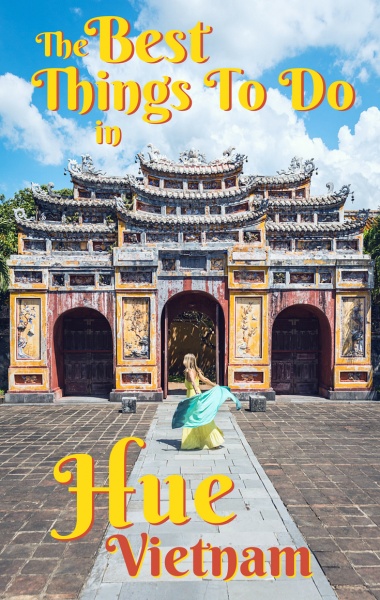
Hue (pronounced “h’way”) is located in central Vietnam and a city that history buffs will find particularly intriguing. Not only was it the seat of Nguyen Dynasty emperors from 1802 to 1945, but it was also the site of the longest and bloodiest battle of the ‘American War’ (or, as we like to say in America, the ‘Vietnam War’).
Sadly, when the war was over much of the damage in Hue was neglected because they were seen by the communist regime as “relics from the feudal regime”. But today, slowly, work is progressing to repair the historical monuments that have led to this city being recognized as a UNESCO World Heritage Site in 1993.
If you plan on visiting Central Vietnam, two days in Hue should be enough time to see the highlights. Read on to learn all about our top 8 things to do in Hue, Vietnam!
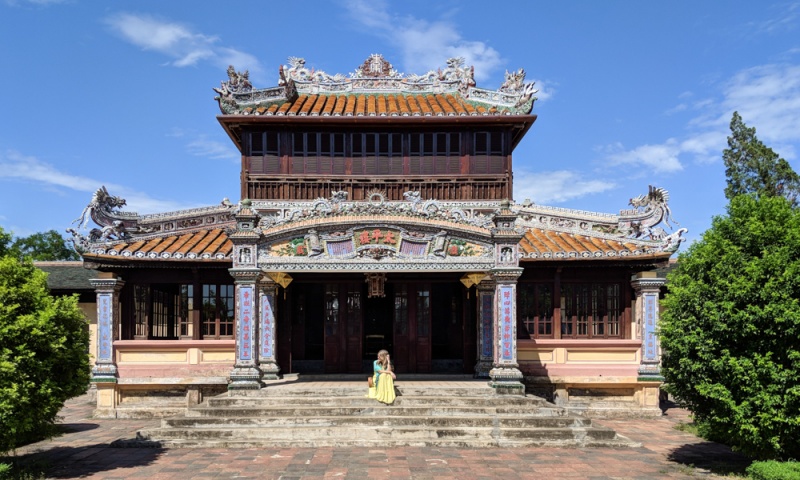
Disclaimer: This post may contain affiliate links. If you make a purchase or booking through one of our links we may earn a small commission (don’t worry, it’s at no extra cost to you).
Hue, Vietnam Travel Basics
Currency in vietnam.
Vietnam is an easy and inexpensive country to travel around! The currency of Vietnam is the Dong (VND). Don’t worry about bringing a lot of cash from home, there are plenty of ATMs around Hue.
Getting to Hue
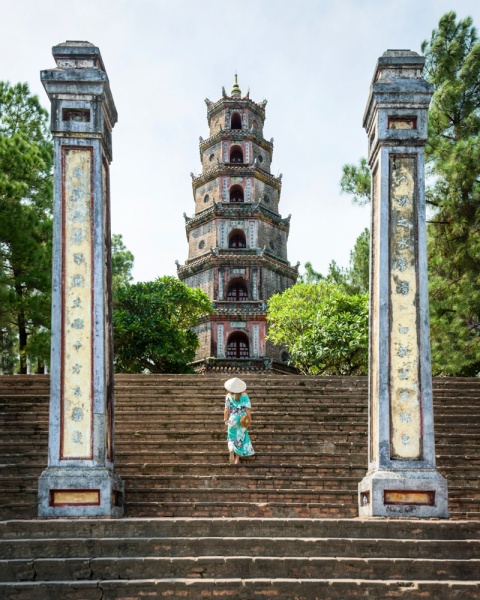
Hue is home to Phu Bai International Airport and there are dozens of domestic flights – operated by Jetstar Pacific, Vietnam Airlines, and VietJet – into and out of the city daily. Unfortunately, there are not any international flights into Hue directly. The closest truly international airport is the much larger Da Nang International Airport an hour south of Hue.
If you’re coming from Da Nang to the south, then you can travel to Hue by Bus, Train, or Private Car.
If you’re on a budget, then a bus is your best option. We always use Bookaway to book our bus tickets in Vietnam. You can see all the bus schedules as well as ratings and reviews.
Check Bus Times on Bookaway
And if you’re a history buff or a ferroequinologist, then you’ll certainly want to take the train. The railway running between Da Nang and Hue is considered to be the most scenic stretch in Vietnam.
That being said the trains in Vietnam are rather slow and rarely run on time. So, unfortunately, it’s not the most efficient way to get between the two cities. For some reason, buying train tickets through Bookaway is actually cheaper than buying them directly through the Vietnam Railways website.
Buy Train Tickets on Bookaway
You can also just hire a private driver to take you to Hue. The advantage to this is you can have them take you over the Hai Van Pass for some seriously scenic views!
Hoi An is just 45 minutes further south from Da Nang and your best transportation options are bus or private car. The train doesn’t run to Hoi An so if you’re set on taking the train to Hue you’ll first need to hire a driver to take you to the train station in Da Nang.
Getting Around Hue
The best way to get around Hue is by using the ride-hailing app Grab – it’s the Uber of Southeast Asia. Of course, you’ll need the internet to use Grab and we always recommend buying a local Vietnam SIM card as soon as you arrive in the country.
Best Time to Visit Hue
The hot/dry season in central Vietnam lasts from April until October with high temperatures ranging from 95 – 104 °F. July is generally the hottest month of the year and temperatures in Hue can be unbearably hot in the middle of the day. You can expect some rainfall from September until January.
You’ll find the weather to be the driest and most pleasant from February until April.
Where to Stay in Hue
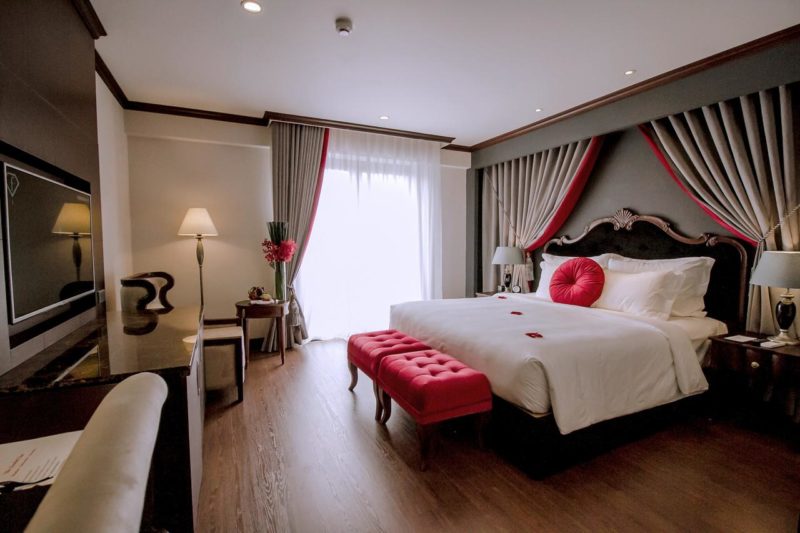
The Scarlett Boutique Hotel
The Scarlett Boutique Hotel is a gorgeous hotel located right in the heart of the city – close to the old town and plenty of bars and restaurants. The rooms are large and spacious and your bed will be so luxurious you’ll never want to leave! Be sure to book early, this is a popular property in Huế.
Check Prices on Booking.com
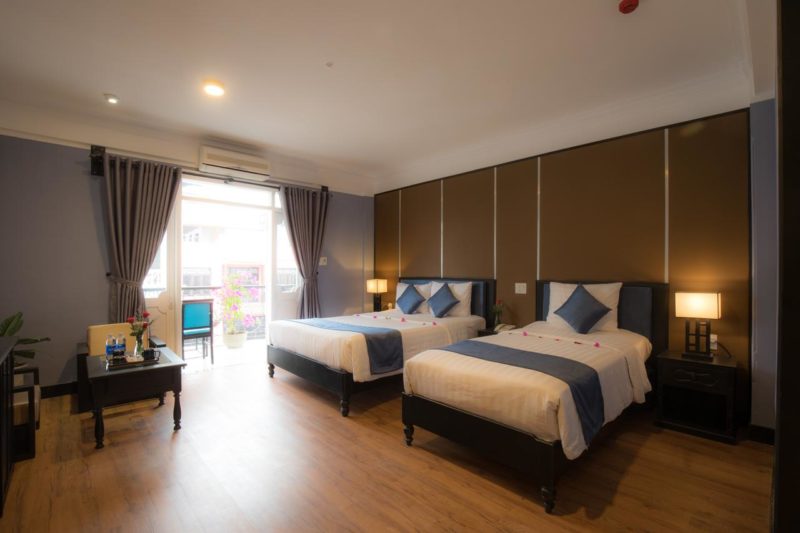
Beaulieu Boutique Hotel
You’ll feel right at home at the Beaulieu Boutique Hotel . The staff is so warm and welcoming and will assist you with anything you need during your stay. The rooms are huge and clean with simple decor. You’ll love the large bathroom and shower which can be quite uncommon in SE Asia! Plus their prices are quite reasonable.
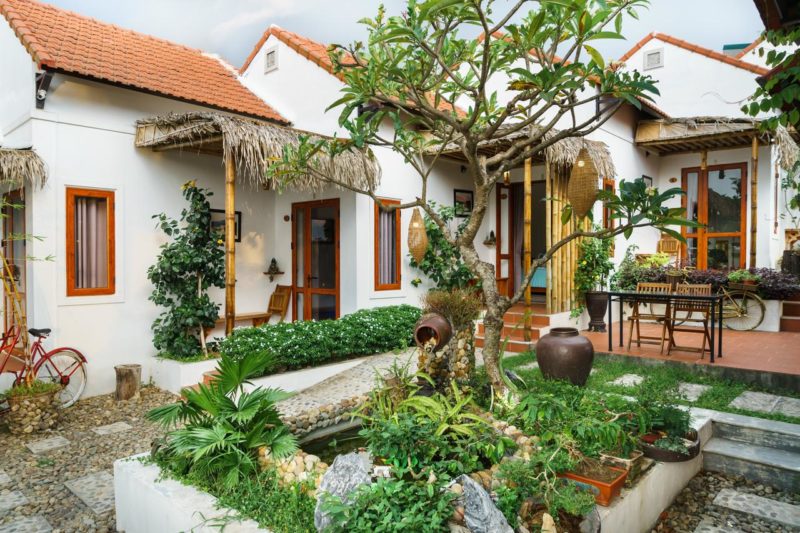
Hue River Side Villa
If you’re looking for a peaceful respite from the hustle and bustle of the big city, then Hue River Side Villa is the perfect spot for you. Offering gorgeous river views and a tranquil garden, you’ll love spending afternoons enjoying a cup of coffee while watching the boats cruise by. The host is amazingly friendly and the breakfast is divine.
The 8 Best Things to do in Hue, Vietnam
1. explore the imperial city.
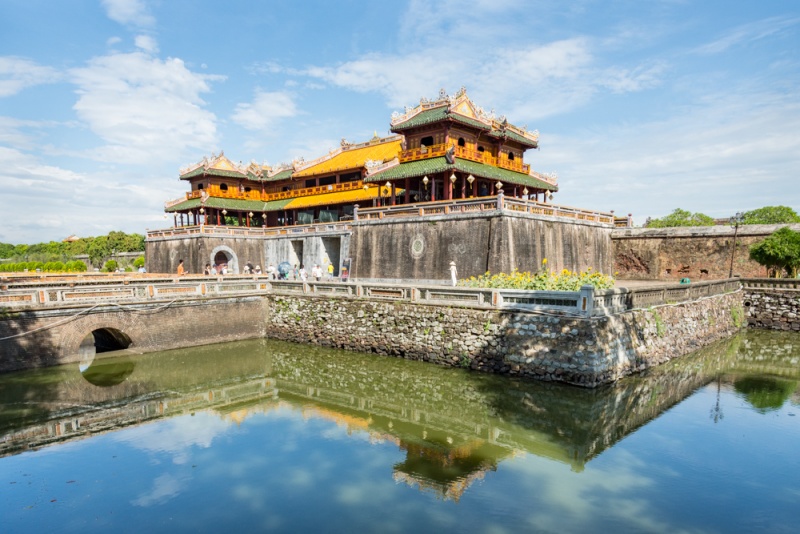
Nguyen emperors occupied the Imperial City of Hue for over a century. This walled city is a private complex of buildings that at the time was only accessible by the emperors, their families, concubines, and those granted special permission. The penalty for trespassing was death.
The Citadel is the outer area of the Imperial City and is surrounded by brick walls and a moat. You’ll pay an entrance fee of 150,000 VND (~$6.50 USD) and once you venture inside, you’ll find the Noon Gate which has been restored to its original beauty. This impressive entrance was used for grand royal ceremonies during its heyday. And at the very center of the city is the Forbidden Purple City where the emperor’s consorts lived.
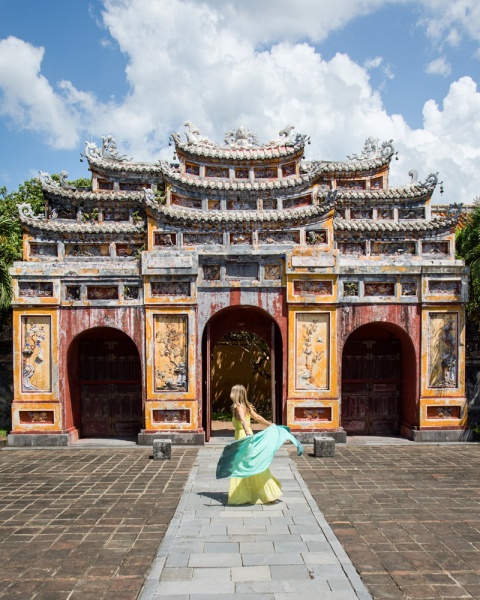
You can spend hours wandering around the Imperial City, marveling at the impressive gates and beautiful landscaping. And thankfully most of the walkways are covered so you’ll get some respite from the blazing midday sun. Be sure to stop for an iced coffee at the shop near the coy pond to relax your feet before continuing your tour. If you only have time for one activity, a visit to the Imperial City is the best thing to do in Hue.
2. Visit the Thien Mu Pagoda
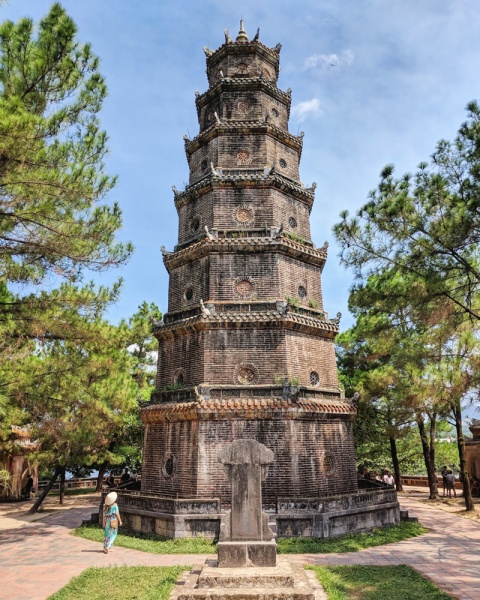
The Thien Mu Pagoda, also known as the Pagoda of the Celestial Lady, is a stunningly beautiful 7-tiered tower right on the banks of the Perfume River. The pagoda was originally constructed in the 1600s and has been reconstructed, damaged, and restored several times over the centuries. It’s not as large as it once was but it’s impressive to behold nonetheless.
If you would like to snap a photo free from other tourists, head to Thien Mu in the early morning hours. The tour bus crowds descend by mid-morning.
3. See the Ancient Emperors Tombs
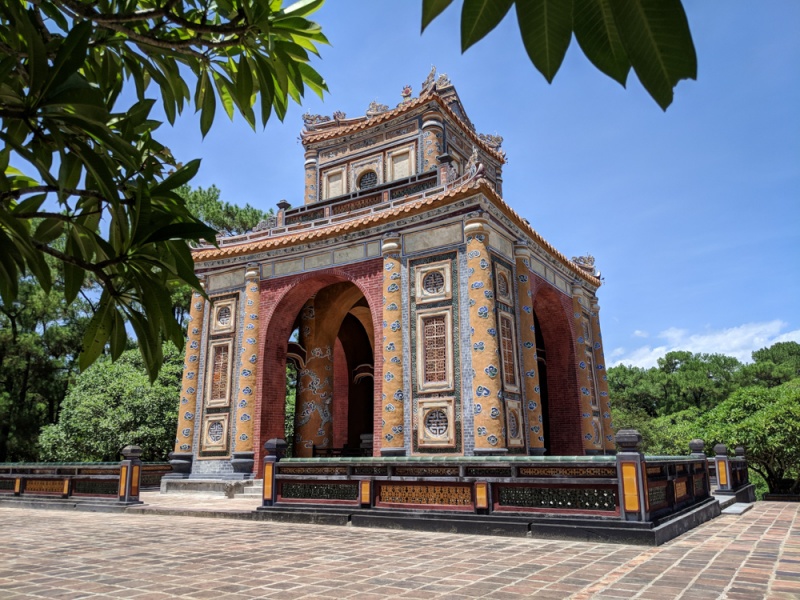
The Nguyen emperors ruled over the city of Hue and constructed elaborate tombs along the Perfume River to serve as their final resting place. There are 7 tombs that are available although only 3 are frequently visited by tourists – Tu Duc, Khai Dinh, and Minh Mang.
Emperor Tu Duc’s mausoleum is the most impressive of the seven and one of the things you must do in Hue. After paying the entrance fee of 100,000 VND (~$4.30 USD) , you can enter this gorgeously landscaped area that is quite massive considering the relatively small size of his actual tomb. The tomb was constructed between 1864 and 1867. Tu Duc designed it himself for use both before and after his death.
There is a lovely lake in the middle of the grounds filled with lily pads. Bring an umbrella to shield you from the unrelenting sun and plan on spending at least an hour and a half wandering around the grounds, admiring the landscaping and the beautiful architecture.
4. Cruise in a Boat on the Perfume River
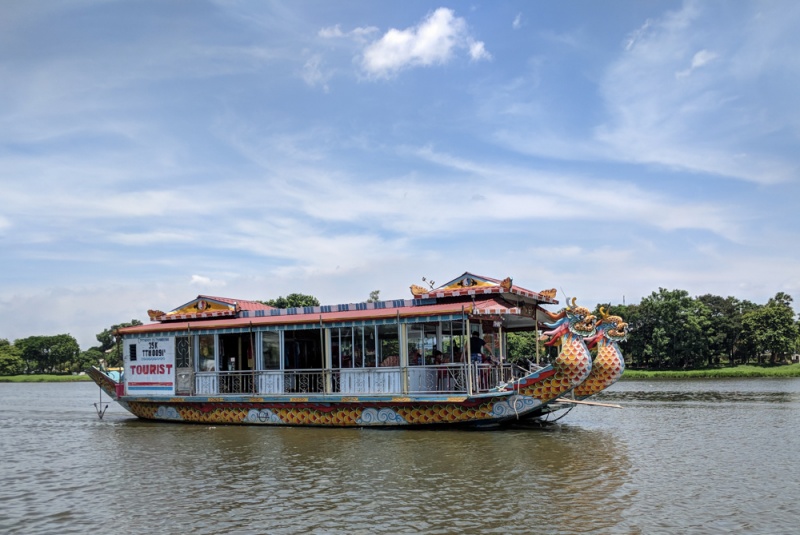
Another one of the best things to do in Hue is cruising the historic Perfume River! While the emperor’s tombs and the Thien Mu Pagoda are easily accessible by taxi or motorbike, you may prefer to hire a boat for several hours instead. You’ll have the opportunity to cruise on the Perfume River, soaking in the Hue countryside as you pass. It’s a relaxing way to visit the sites and you’ll get to see the city from a different vantage point.
Negotiating the price of your boat can be a hassle. Ignore the touts when you first arrive at the marina (Bến Thuyền Du Lịch Tòa Khâm) and note that there is no “official” boat booking booth as they will have you believe. If you can get the aggressive ladies to leave you alone, you will be able to find a boat driver that will offer a fair price. We paid 900,000 VND (~$38 USD) for a 4-hour boat ride for 4 people.
5. Tour the DMZ
After the Imperial City and the Royal Tombs, the thing that brings most international visitors to the ancient capital city of Hue is its proximity to the Demilitarized Zone . This area, sometimes referred to as the 17th Parallel, separated Northern and Southern Vietnam before the country’s reunification in 1976. There were a number of military installations in and around this area that you can still visit, and, for history buffs, a visit to the DMZ will likely be the best thing to do in Hue.
We are all for exploring things on your own, but in this case, the easiest way to see DMZ is to book a tour . A full-day tour will take you to most of the major DMZ sites, including a portion of the Ho Chi Minh Trail, the Vinh Moc tunnels, Khe Sanh Combat Base, Hien Luong Bridge (Peace Bridge), The Rockpile ( Thon Khe Tri ), and Doc-Mieu-Station.
6. Sample the Local Cuisine
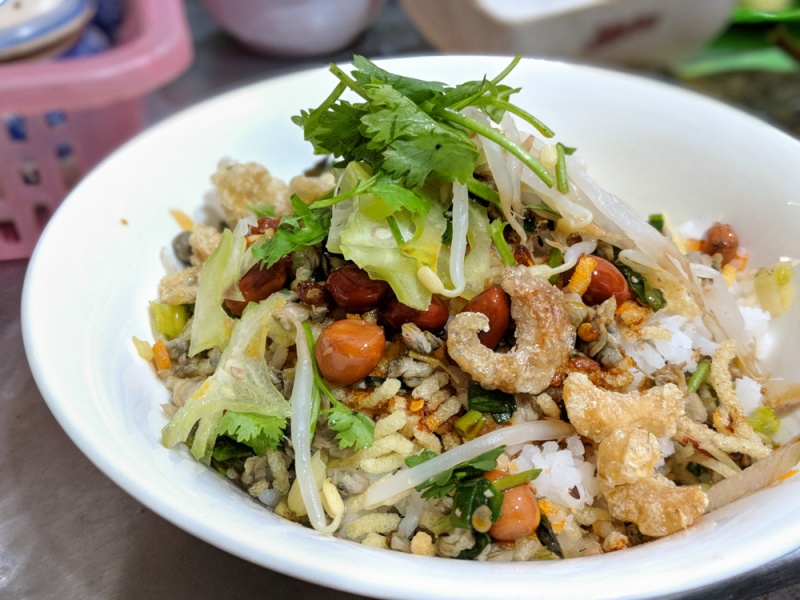
We love writing about food – especially Vietnamese food. We have thoroughly explored the Vietnamese cuisine of Hanoi and Saigon. And while there will always be a debate about Vietnam’s best city for food, there are several Vietnamese dishes that you simply must try in Hue, the city of their origin.
Cơm hến (clam rice) is a popular dish with locals and is generally eaten for breakfast. The primary ingredients are rice and baby clams. It is simple, cheap, and delicious. If you would prefer noodles over rice, ask for “bún hến” instead.
There are countless modest restaurants along Trương Định street serving up inexpensive bowels of com hen. If you have trouble choosing one, Ba Hoà and Quán 26 are both popular with the locals.
You’ll find bún bò huế (spicy beef noodle soup) served all over Vietnam, but it was originally associated with the cooking style of the royal court of Hue. This soup has a broth made from beef bones, beef shank, and lemongrass and is seasoned with fermented shrimp sauce. It has a rich flavor that is salty, spicy, and slightly fishy.
The soup generally contains rice vermicelli noodles, beef shank slices, oxtail chunks, pig’s knuckles, and congealed pig blood cubes – yum! Add lime, onions, chili, and other greens to taste.
Grab a plastic stool and a can of Huda Beer, and enjoy the Imperial City’s unique, flavorful Vietnamese food – it’s the best thing to do in Hue for all you foodies out there!
7. Visit the Abandoned Water Park at Thuy Tien Lake
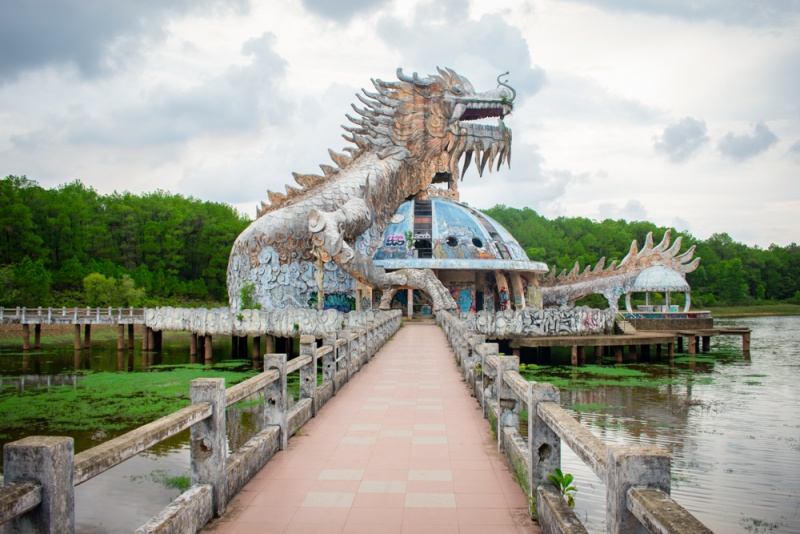
Hue’s abandoned water park has become somewhat famous recently due to the gigantic dragon-shaped tower at its center. This unique building – crumbling and covered in spray paint – has become a favorite photo location for Instagrammers. And if you love exploring weird attractions or abandoned buildings, then visiting this creepy, deserted water park will be the best activity in Hue for you!
This water park is (obviously) closed, and is officially off-limits to all visitors. Some visitors report being able to bribe the water park guards to let them in for as little as 20,000 VND. Other reports seem to indicate the guards can’t be bought for any price. If you want to try your luck hire a motorbike and head to the waterpark yourself – it’s easy to find on Google Maps.
If that doesn’t work, you should try hiring a local motorbike guide. Rumor has it that the Easy Riders will take you there.
8. Take a Ride in a Cyclo
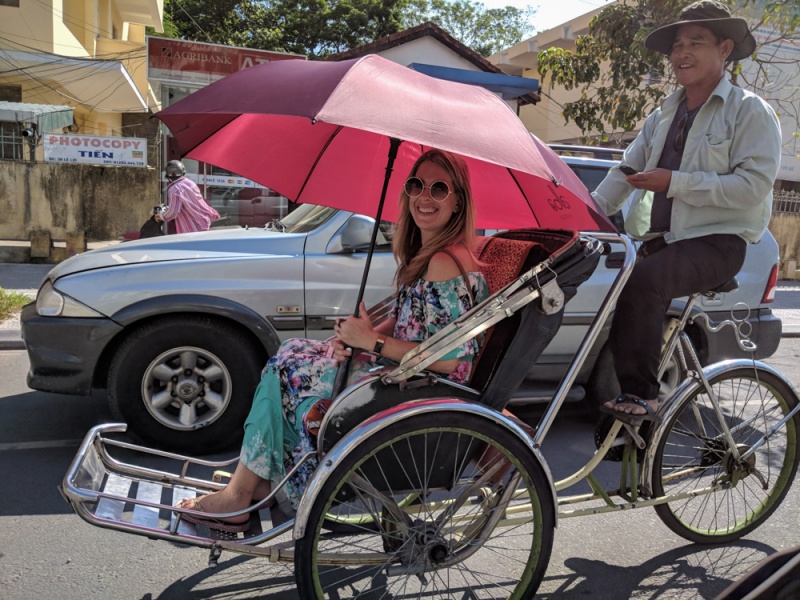
The “cyclo” is Vietnam’s take on the ubiquitous rickshaw of Southeast Asia. These 3-wheeled bicycle taxis have a front seat for the passenger and the driver sits behind. While you’ll see cyclos in the larger cities of Vietnam, you’ll have a more pleasant experience in Hue. Traffic isn’t nearly as crazy.
They gather near the entrances to popular tourist destinations around the city. They are a fun way to go short distances. Be sure to negotiate the price upfront and plan on spending more than you would on a taxi or Grab.
Other Things to do in Hue, Vietnam
- Shop and eat at the Pham Ngu Lao Walking Street. Note that it’s closed to car traffic from 6 pm – 2 am Friday and Saturday and 6 pm -12 am on Sunday
- Go on a photography tour
- Check out the ancient bridge of Truong Tien, designed by Gustave Eiffel (creator of the Eiffel Tower in Paris)
- Ride over the Hai Van Pass on a motorbike on your way south to the beaches of Da Nang and Hoi An’s Old Town .
We hope you enjoy your time in the beautiful city of Hue, Vietnam!
Share this on pinterest.
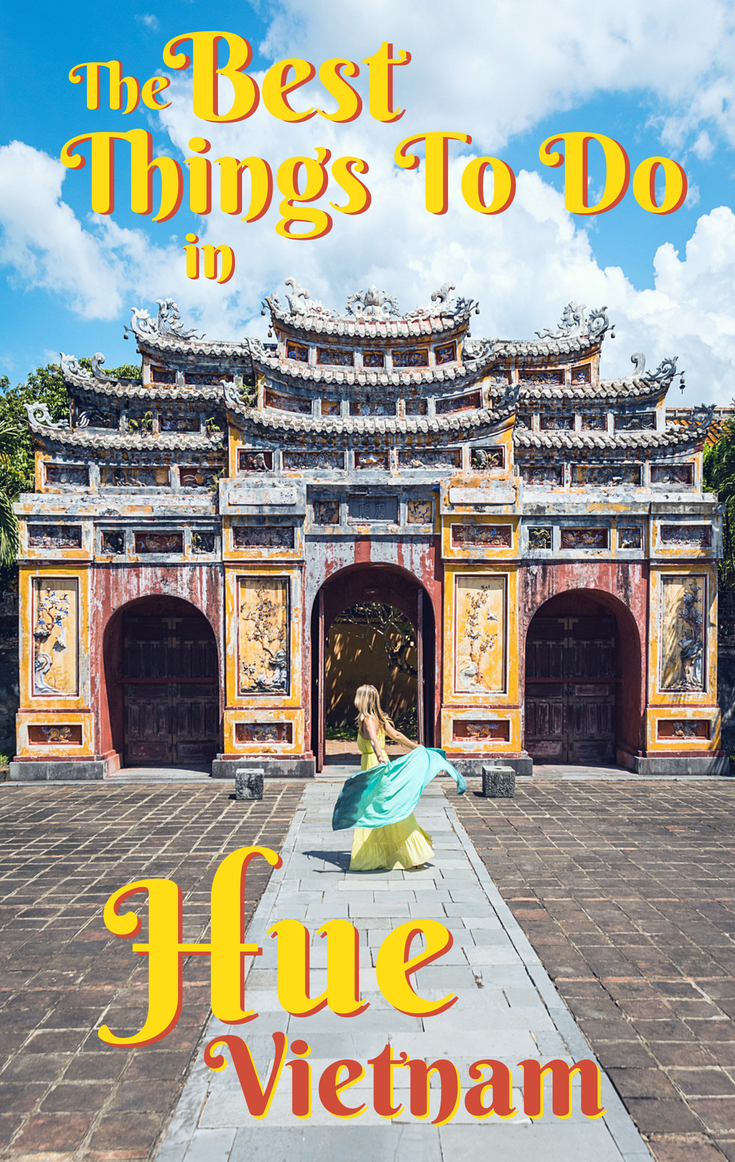
Val grew up in Portland, Oregon but moved to Oahu on a whim back in 2013. She sold her house and all of her belongings and bought a one-way ticket. Since then she’s taken two around-the-world trips and has visited 60-ish countries while living out of a duffel bag. Val started documenting the Wandering Wheatleys travels back in 2013 as a way to update friends and family about her whereabouts and to relay humorous daily interactions. The only readers were her mom and her mother-in-law but that didn’t stop her! These days you’ll find Val dreaming up future trips, creating new travel content, managing a team of amazing travel enthusiasts, and chasing around her two adorable but naughty kids.
Related Posts
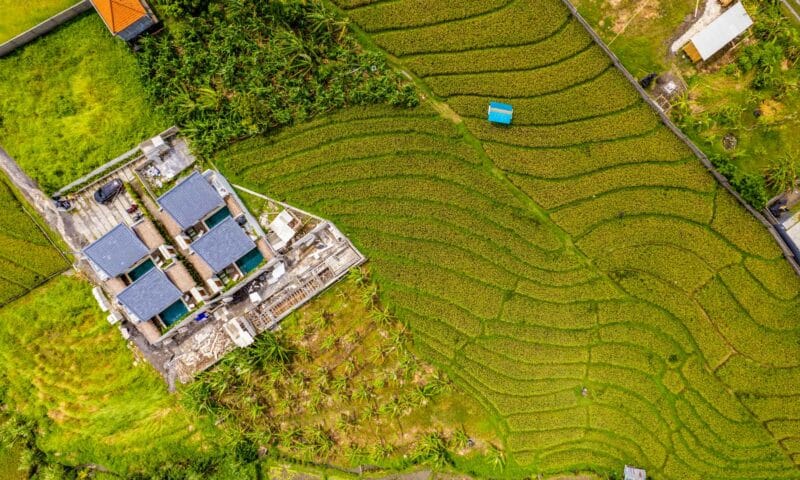
The 12 Best Boutique Hotels in Canggu, Bali
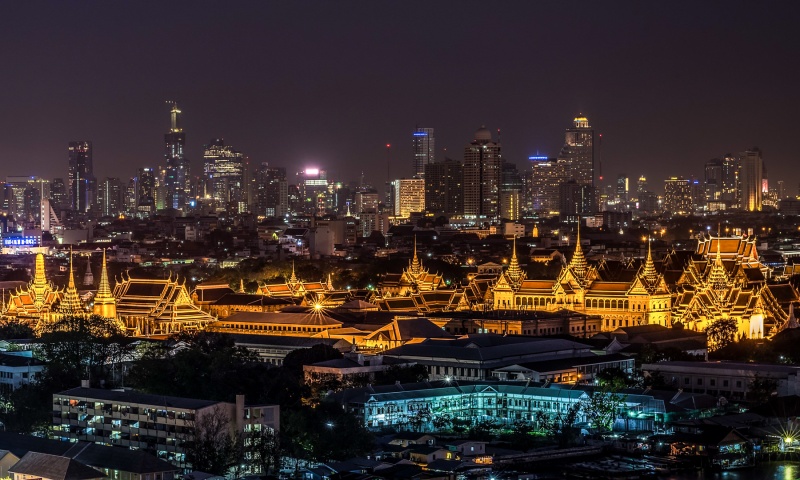
Where to Stay in Bangkok: The Best Neighborhoods & Hotels
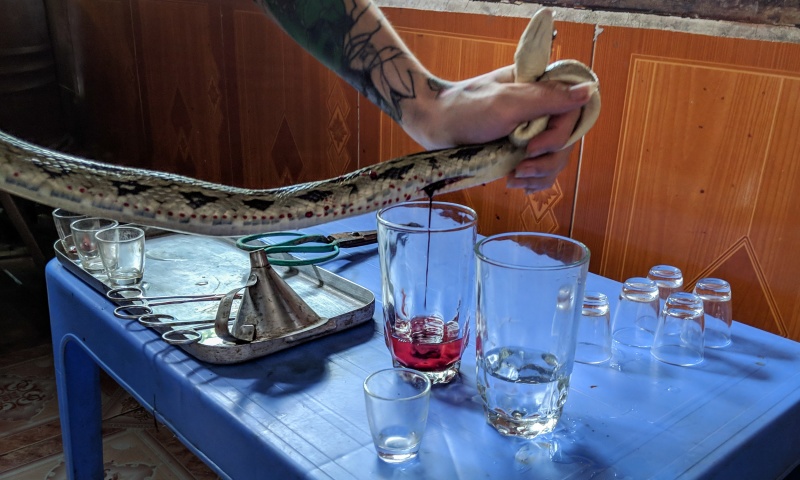
Eat a Snake in Hanoi, Vietnam: Everything You Need to Know
2 thoughts on “the top 8 things to do in hue, vietnam”.
Thank you for your sharing. I’m Vietnamese but I haven’t had opportunity to visit Hue. I’m planning to come to Hue this Summer. I’m wondering How many days should I stay in Hue to visit all the places in your list? Thank you!

I think 3 days in Hue should give you sufficient time to see everything on our list. Have a great trip!
Leave a Comment Cancel Reply
Your email address will not be published. Required fields are marked *
Travel, Hiking, Food
2 Days in Hue: The Ultimate itinerary on how to see the best Hue tourist attractions
Have 2 days in hue and wondering what hue tourist attractions to see this essential two day hue itinerary shows you the best things to do and eat in hue, vietnam..
Hue is a historical city in Central Vietnam that is a must-visit for history buffs. With its imperial past, breathtaking architecture, and delicious local food, Hue offers a royally fun experience and should be added to any Vietnam itinerary .
Hue served as the seat of power for the Nguyen Dynasty, Vietnam’s last ruling family, from 1802 to 1945. The city’s imperial legacy is evident in its magnificent citadel, royal tombs, and ancient pagodas. Moreover, its picturesque setting along the Perfume River adds to its charm, making it a perfect destination for pretty much anyone who wants to experience this ancient and historically important city.
While many people visit Hue as a day trip from Hoi An , I truly think you can appreciate Hue a lot more if you spend 2 days there and explore on your own.
With two days in Hue, you can discover the best attractions and things to do in this former imperial capital as well as some Instagram worthy photo spots. This super detailed Hue itinerary and travel guide also shows you other useful information to help plan your trip.
This blog contains occasional affiliate links, where I receive a small commission on sales of the products/hotels that are linked at no additional cost to you. In addition, as an Amazon Associate, I earn from qualifying purchases .
General Hue Pre-Travel Information You Should Know
- Currency : Vietnamese Dong
- Don’t forget your Vietnam Visa before traveling
- Whatsapp is your best friend. Hotels, taxi drivers and tour guides use Whatsapp to contact you
- Credit Card can be used at Hotel and some restaurants
- You need cash to pay for attraction tickets, taxi drivers (if not already pre-paid), food at markets, and other smaller restaurants
- Download Grab app before you land in Vietnam. It works the same way as Uber
- Get a Vietnamese Sim card ahead of time as the attractions in Hue do not have wifi
- Consider getting travel insurance especially if you are planning to ride a scooter around Hue
Where is Hue and How to Get to Hue?
Hue is a city in Central Vietnam and the capital of the coastal province of Thua Thien Hue. It is about 2 hours northwest of Da Nang, another major city in Central Vietnam.
It is easy to get to Hue from different parts of Vietnam since Hue is well connected by train and air. There is an airport in Hue with the code HUI, making it convenient to fly there.
Below are some examples of how to get to Hue from different cities in Vietnam:
Hoi An to Hue
Hoi An is about 130 km (81 miles) from Hue. You can take a car or bus from Hoi An to Hue directly or you can take a bus to Da Nang then take the train from Da Nang to Hue.
You can book train, bus and shared van tickets here .
- By private car or shared van: ~3 hours. Private car costs VND 900,000 ($40 USD) and shared van costs VND 300,000 ($12 USD)
- By bus: ~3 hours, costs about VND 170,000 – VND 200,000 ($7 – $10 USD) in a day time sleeper bus. There are luxury and non-luxury sleeper buses.
- By train: There is no train station in Hoi An, so you will need to take a bus from Hoi An to Da Nang first, then take the train from Da Nang to Hue
Da Nang to Hue
Da Nang is more north of Hoi An, so it takes a shorter amount of time to travel from Da Nang to Hue. Da Nang is about 90 km (56 miles) from Hue, making it a super easy trip.
- By private car or shared van: <2 hours drive. Private car costs about $45 USD (maybe less if you ask your hotel to book one), and a shared van costs $10 USD. You can book a shared van here or here .
- By bus: it takes much longer to get to Hue on a sleeper bus from Da Nang and they cost between $7 USD – $10 USD. It probably is better to just take a shared van if the cost is not too different. You can check the bus costs and options here .
- By train: 2.5 hour train ride with Vietnam Railways and costs between $6 – $8 USD (depends on train class).
The most scenic route from Da Nang to Hue is to take a car or bus since the drive will be through the famous Hai Van Pass along the coast, so you will have a beautiful view part of the way. If you hire a private driver you can probably request the driver to stop at the beach and various other spots and make the trip a fun drive!
Hanoi to Hue
Hanoi is in Northern Vietnam so it would take a lot longer to get to Hue from Hanoi. The most direct way is to fly from Hanoi to Hue, it takes about 1 hour to fly and costs around $50 – $100 USD. We took Vietnam Airlines and it was very smooth and fast and costed about $50 USD.
- By train: about 14 hours. Costs between $22 – $80 USD depending on the train you take and what class and how many people are in a cabin. Check prices and options here . Sleeper trains would make the most sense so you don’t waste the whole day on a train.
- By Bus: also about 14 hours. Costs between $20 – $30 USD depends on whether it’s a luxury sleeper bus or not.
Read Next : The ultimate guide to taking a sleeper train in Vietnam .
How to Get Around Hue
Hue is a decent sized city in Vietnam. Although not as big as Hanoi or Da Nang, it is not possible to walk everywhere in Hue.
Many people suggest renting a bike (and by bike I think they mean small motorcycles) to ride around Hue. It is probably the most convenient way to get around Hue and the surrounding areas (note that all the royal tombs are in the outskirts of Hue). If you are renting a bike you should consider getting travel insurance !
However, you should only attempt to ride a motorbike in Hue if you are very comfortable with it. If you are from the US like me and have never touched a motorbike before, I really do not suggest riding one as it can get quite overwhelming fast!
With riding a bike out of the question, the other two options to get around Hue is to either book a tour or hire a private transfer or take Grab to take you around.
The best tour website for Hue is Klook , as they specialize in tours in Southeast Asia. They are highly reliable with cheap prices and offer so many different options for tours to fulfill your needs.
We used a combination of Grab (works like Uber) and private transfer for our two days in Hue. We used Grab when we first arrived in Hue to take us to the Imperial Palace and dinner.
You should set up the app before arriving in Vietnam. You should definitely bring some cash with you just in case your credit card doesn’t work with the app (mine did with an American credit card).
Private transfer is great for taking you to various spots on the outskirts of Hue, so you can customize what you want to see in whatever order you want to see it.
We had a private transfer to take us around the second day and it was great! We could spend as long as we wanted and not have to worry about making other people wait for us.
What Months to Visit Hue
The best time to visit Hue is during the dry season from February to April . The worst time to visit Hue is during the rainy season from August to December as well as the Tet holiday since attractions will be closed.
Even when you visit Hue in February or March, it is possible you may encounter rain, but it generally would not be a downpour like it is in September and October.
Below is the average temperature and rainfall level in Hue throughout the year.

We visited Hue at the end of February and it rained the first day (just slightly), and it was super hot and sunny on the second day, so you can get very different weather.
Keep in mind that if you visit April to May the weather will be pretty hot and humid. Even on a sunny day in February we ended up feeling really hot and sweaty under the sun.
Read Next : The Ultimate 10 day Vietnam itinerary and travel guide
Where to Stay in Hue
One of the most important things to decide when visiting Hue is where to stay. Unlike Hanoi or Hoi An, there is no “Old Quarter” or “Old Town” with a concentration of hotels for tourists in Hue.
In addition, most attractions in Hue are quite far from the city (with the exception of the Imperial Citadel), so it is a little hard to figure out the one best area to stay in Hue.
This and this are the best hotel booking site for Hue. These two are my go to sites for Asia travels and I compare prices on both to see which is cheaper.
Based on our research and personal experience, the areas I highly recommend in Hue are near the Citadel or the south side of Perfume River where many bars and restaurants are.
Hotels near the Imperial Citadel that I would recommend include Le Robinet Homestay and Spatel d’Annam (more luxurious). Both of these hotels are within walking distance to the Imperial Citadel.
Hotels South of Perfume River : We stayed at Melia Vinpearl , which is probably in the tallest building in Hue. The rooms were super nice and the hotel has excellent breakfast and a pool. We were able to easily get a taxi and Grab to the imperial citadel and the restaurant and bar area south of Perfume River.
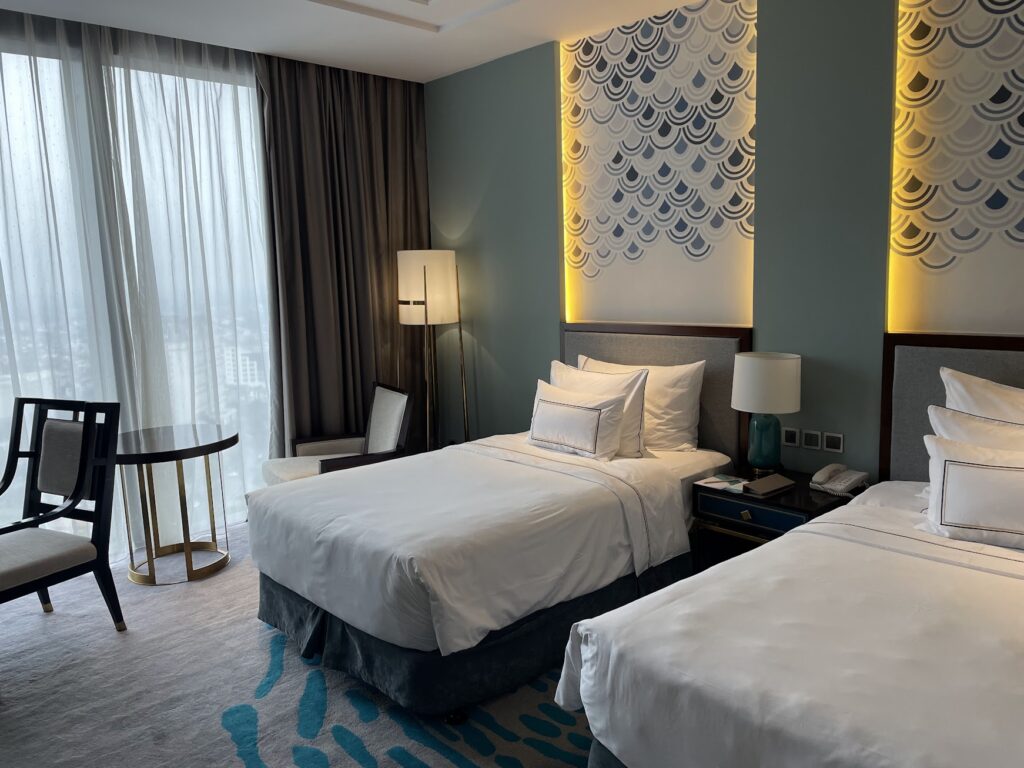
Other hotels I would probably stay at if I were to visit Hue again would be Jade Scene Hotel , located within walking distance to restaurants and bars.
How Many Days in Hue Do You Really Need
Hue is a great destination for both international and local tourists and it totally deserves more attention from visitors than it currently gets. There is a lot to see in Hue especially if you like history and ancient architecture.
You need at least 1.5 – 2 days to see the main attractions of Hue . 3 to 4 days in Hue is also recommended for anyone who likes a slow pace and wants to explore the off-the-beaten paths places (or simply just relax) in Hue.
Read Next : Is Halong Bay Worth It? A Complete Halong Bay Cruise Guide
Best Hue Attractions For This 2 day Hue Itinerary
Depending on your pace, you can do as many as 4 attractions a day while in Hue or as little as one to two things. If you are really into history and architecture, it may be worth it to take it slow and fully explore and learn the history behind everything you see.
Overview of 2 day Hue itinerary Day 1 in Hue : – Thien Mu Pagoda – Hue Historic Citadel – Dong Ba Market Day 2 in Hue : – Abandoned Water Park – Khai Dinh Tomb – Minh Mang Tomb – Tu Duc Tomb
Day 1 – Explore the essence of Hue in the City Center
Thien mu pagoda.
Thien Mu Pagoda, also known as the “Pagoda of the Celestial Lady,” is one of the most iconic sites in Hue. The Pagoda complex is located on the northern bank of the Perfume River, about 10 minutes drive (5 km) west of the Hue Historic Citadel.

Legend has it the celestial lady Thien Mu appeared in a dream and said that a Buddhist pagoda will be built here. Therefore Nguyen Hoang, the governor of Thuan Hoa Province (nowadays Hue), founded the Thien Mu Pagoda.
There are several buildings in the Pagoda complex. The most famous one being the 7 story octagonal tower, known as the Phuoc Duyen Tower. Each of the 7 floors of the tower is dedicated to a different Buddha.
No ticket is needed to visit and you should expect to spend at least an hour at Thien Mu Pagoda.
Hue Historic Citadel
The most important attraction in hue is the Imperial Citadel. Located just north of Perfume River, the Hue Citadel was the political and administrative center of the Nguyen Dynasty, Vietnam’s last ruling dynasty, from 1802 to 1945.
It was built during the reign of Emperor Gia Long, the founder of the Nguyen Dynasty, and it took almost 30 years to complete (it was completed under the reign of Minh Mang). It is now a UNESCO World Heritage Site due to its historical significance and architecture.

The Citadel is massive, covering an area of 520 hectares. The Citadel complex includes a series of impressive gates, walls, watchtowers, and moats. The main entrance is the Ngo Mon Gate , which leads to the Forbidden Purple City , the innermost section of the citadel. You will also find gardens, palaces, pavilions, and historical gates within the Citadel.

How much does the Hue Citadel Cost?
The Citadel costs VND 200,000 ($8.5 USD) to visit or you can get a combo ticket for 3 or 4 sites (tombs of different emperors) for either VND 420,000 or VND 530,000. You have 2 days to use the combo ticket. Payment is only in cash. You can expect to spend at least 2-3 hours in the Hue Citadel.
How to get to the Hue Citadel?
Depending on where you are staying, you can either walk to the Citadel or ride a motorbike. We got a taxi from our hotel and then called a Grab on the way back. But I have to say that it took us at least 10-15 minutes just to get a Grab back, which was surprising.
Dong Ba Market
Dong Ba Market is the most famous market in Hue. Located just about 20 minutes walk east of the Hue Citadel, Dong Ba Market is a multi-story market with a wide variety of stalls and vendors.
You can find cooked food, fresh produce, meat, seafood, clothings, souvenirs and other household items in Dong Ba Market.
Some of the most famous Hue local foods can be found at Dong Ba Market since there are many restaurants here. These local food include bun bo Hue, a flavorful and spicy beef noodle soup, Hue-Style pancake (Banh Khoai), steamed rice cakes (banh beo), and local fruits.
You can take this Dong Ba Market food tour to try all the local cuisines without having to worry about what is good or not. The guide will also explain all the dishes to you so you know exactly what you are eating.
Dong Ba Market is open from 5am and closes at 10pm everyday, so you can come to Dong Ba Market pretty much any time of the day. Be aware that Dong Ba Market can be quite expensive especially if you are a foreigner.
Day 2 – Visit the Outskirts of Hue to see the Tombs and the Abandoned Water Park
Hue abandoned water park.
You may have seen this really cool dragon building in Hue all over Instagram and Tiktok. This is in the Abandoned Water Park, otherwise known as “Thuy Tien Lake Water Park” in Hue.
Located about a 30 minute drive from the Hue Historic Citadel, this abandoned water park of Hue was made Instagram famous after it was shut down.
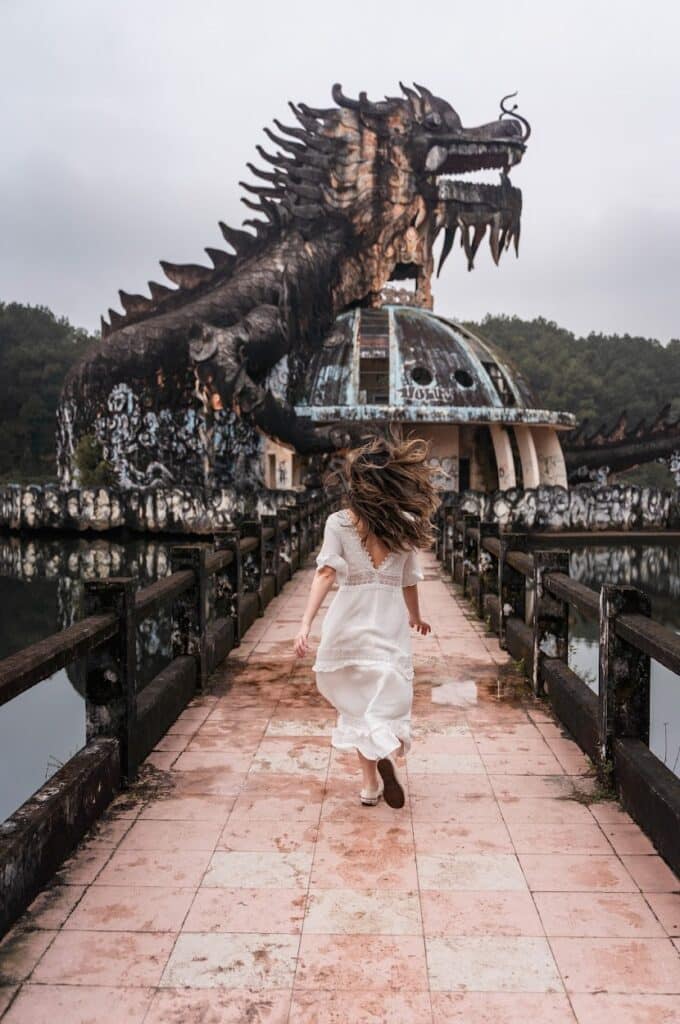
The Thuy Tien Lake waterpark was originally opened in 2004. It was intended to provide entertainment and recreational facilities for both locals and tourists in the Hue area. There was about $3 million USD of investment poured into the construction of this waterpark.
Unfortunately all that investment went to waste as the park was not efficient. There were not a lot of attractions in a large area, and there were rumors that the lake where the dragon building is built is infested with crocodiles (not sure how true this is as we didn’t see any).
How to get to the Hue Abandoned Water Park
Since it is abandoned you are technically not supposed to visit as the gates are shut and there are guards guarding the place. We asked our taxi driver to drop us off at the back entrance Near Nano Eco-Hostel . There was nobody guarding this gate.

We continued walking until we saw an intersection, we turned left and continued to follow the path until we saw the small lake on our right side. After walking for another 5-10 minutes you will see the famous Dragon building.

There was one guard that was riding a scooter around the park. He saw us, told us “5 minutes”, and left us alone. He did not ask us to pay him or anything, and he didn’t come back for another 15 minutes or so. But even then he didn’t ask us to leave even though we quickly left after we got our photo.
You can walk around the park (as long as nobody stops you) to see other abandoned structures at this water park. But to be honest we just wanted the photo with the Dragon building and we didn’t care to see other things. The whole place does feel creepy after all.
I suggest going early in the morning to avoid other photographers (although not sure how many people actually show up) but we figured the earlier we go the better the mood the guards might be in.
Our private taxi driver waited for us at the entrance and then drove us to the next attraction: the Tomb of Emperor Khai Dinh.
Mausoleum of Emperor Khai Dinh
The Mausoleum of Emperor Khai Dinh, also known as the “Khai Dinh Tomb”, is one of the several imperial tombs and mausoleums in the region, each dedicated to a different Nguyen Dynasty emperor.
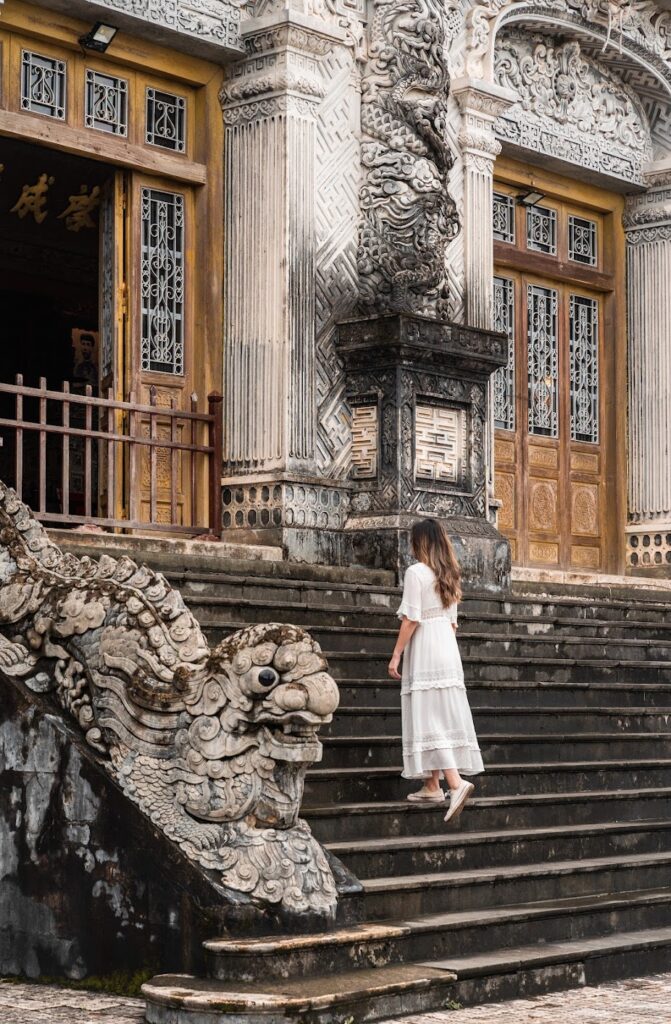
Emperor Khai Dinh ruled Vietnam from 1916 to 1925 as the 12th emperor of the Nguyen Dynasty. His tomb is actually one of the most unique tombs we visited in Hue.

Unlike the other imperial tombs, the tomb of Emperor Khai Dinh is characterized by its dark-colored concrete, which was a departure from the traditional white or yellow colors of other imperial tombs. You also need to climb a steep flight of stairs to reach the tomb’s main building. The main building’s colorful and lavish interior is a sharp contrast to the dark exterior outside.

There is a small stand selling water at the tomb and you can also find a bathroom at the tomb as well.
You will need at least an hour at the tomb to explore it in its entirety.
This tomb is included in the 4 attraction package pass if you purchased it when you visited Hue Citadel. If you did not buy the combo ticket, the individual ticket cost VND 150,000 ($6 USD).
Mausoleum of Emperor Minh Mang
The second tomb you will visit on Day 2 in Hue is the Tomb of Emperor Minh Mang. Set alongside the shore of the Perfume River, Emperor Minh Mang’s tomb is probably the prettiest tomb to visit in Hue.
Emperor Minh Mang was the second emperor of the Nguyen Dynasty and ruled from 1820 to 1831.

Compared to the Tomb of Emperor Khai Dinh, the Minh Mang tomb is much larger and much more colorful. The tomb includes about 40 buildings, including palaces, pavilions, temples, etc. If you didn’t know this was a tomb, you’d probably mistaken this as a royal palace of some sort.

You can spend a good 2 hours exploring the Tomb of Emperor Minh Mang and there are plenty of beautiful photo spots as well.
When we visited mid day at the end of February, there weren’t actually many tourists around. So you can totally enjoy the complex in peace.
The Mausoleum of Emperor Minh Mang is also included in the 4 attraction combo ticket. Without the combo ticket it costs VND 150,000 ($6 USD).
Mausoleum of Emperor Tu Duc
Another beautiful tomb to visit in Hue is the royal tomb of Emperor Tu Duc. He ruled from 1848 to 1883, making him the longest reign during the Nguyen dynasty. Unfortunately he was unable to have any children despite having more than 100 wives and concubines.

Emperor Tu Duc’s tomb is one of the largest royal tombs in Hue, with about 50 buildings over 12 hectares of grounds. The tomb felt more like a park than a tomb, with beautiful ponds, lakes, pagodas and pavilions.
Our favorite place at the Royal Tomb of Tu Duc is the pond, where you can feed koi fish and rest by the lake.
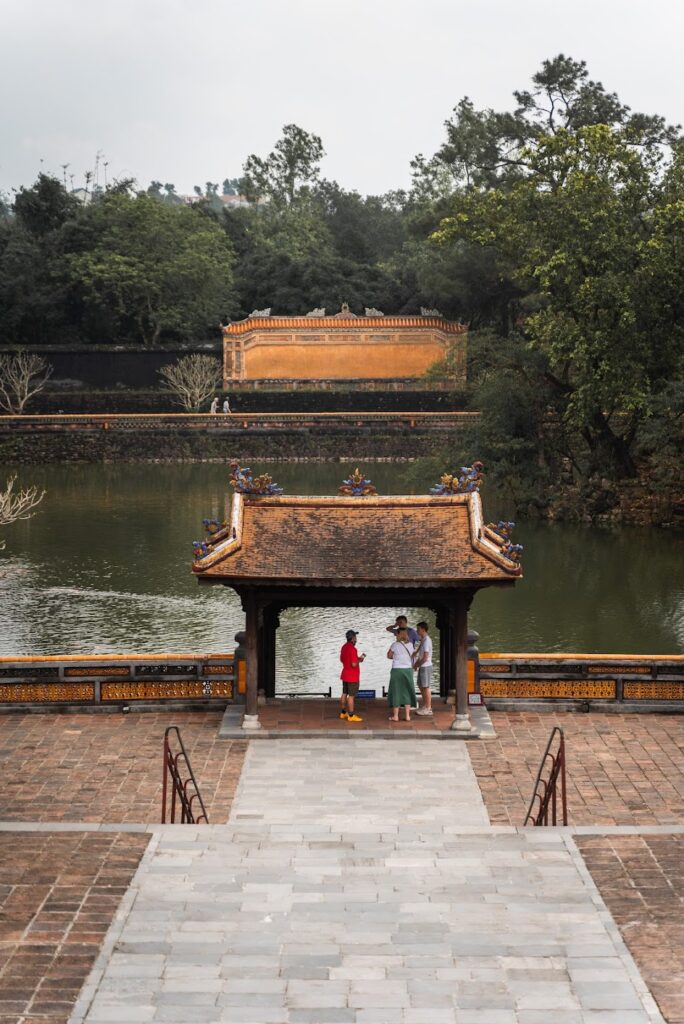
Because of his fear of theft, his actual burial place is not at this royal tomb. In fact to this day, nobody knows where he was actually buried.
The Mausoleum of Emperor Tu Duc is also included in the 4 attraction combo ticket. Without the combo ticket it costs VND 150,000 ($6 USD).
Royal Tomb of Emperor Gia Long
We only visited 3 tombs but another popular tomb is that of Emperor Gia Long . He was the first emperor of the Nguyen Dynasty. He unified the different territories of Vietnam during his reign and laid the foundation of what is modern day Vietnam.
If we had more time we would have visited his tomb, as there are many unique and beautiful structures in his tomb. There are also rivers and lotus filled lakes at the tomb, making it beautiful to visit.
The tomb of Emperor Gia Long is also included in the 3 attraction combo ticket . Without the combo ticket it costs VND 150,000 ($6 USD). It is not part of the 4 attraction combo ticket, so you may have to pay out of pocket if you want to visit all 4 tombs.
What to eat in Hue
Although 2 days is quite short to try all the delicious food in Hue, you can still find some amazing places to eat and try the local cuisine.
There are several local dishes that are famous in Hue, and you will not be able to find them elsewhere in Vietnam.

Traditional Hue food you have to try
- Bún bò Huế , the famous spicy beef noodle soup in Hue. These are different from pho in Hanoi. The noodles are often thicker and more slippery and the flavors stronger and more pronounced. If there is only one thing you eat in Hue, this should be the one.
- Cơm hến , a flavorful and unique combination of rice and clams. You will usually find overnight white rice topped with bean sprouts, green onions, fried peanuts, pork rind, chili, other herbs and clams.
- Bánh khoái , a traditional Hue pancake, made with rice flour and filled with pork, shrimp, bean sprouts and eggs and dipping sauce.
- Bún thịt nướng , vermicelli noodles served with grilled pork, fish sauce and peanuts.
- Bánh bèo , another Hue steamed rice cake topped with a variety of different things, such as shrimp, mung bean paste, scallion oil, fried shallots, and fish sauce.
- Nem Lui , grilled pork skewers made from finely minced pork mixed with aromatic herbs and spices. They are served with rice paper, fresh herbs, and dipping sauce.
- Banh Bot Loc , also called tapioca dumplings, are steamed dumplings filled with pork and shrimp. The skin is translucent and the dumplings are wrapped in banana leaves and steamed.
- Chè, a sweet soup, which can be served warm or cold with various ingredients like beans, fruits, and jellies.

Too overwhelmed with what to eat in Hue or simply short on time to try every restaurant? Check out this and also this Hue street food tour to try all the best local dishes.
Best restaurants to eat in Hue
- Huyen Anh Restaurant on 50 Kim Long, known for the Bún thịt nướng (noodle with grilled pork)
- Madam Thu Restaurant , probably one of the most popular restaurants for tourists in Hue. They offer a little bit of everything, including Bun Bo Hue and a platter with all the Hue specialty food. Reservation is needed unless you go super early (like 5pm) to avoid a long wait.
- Bà Gái Hue Beef Noodle Soup , as the name implies, their specialty is the Hue beef noodle soup. This restaurant does not look like a fancy place, but many tourists go there for the noodle!
- Ancient Hue Garden Houses : if you are looking for fine dining experience in Hue, this is the place to be. This hotel serves a “royal tasting menu” which is a multi-course meal accompanied by traditional costume change.
- Nook Eatery , if you are craving a burger or western food then this is the place to go. I understand the craving for some burgers after traveling in Asia for a while.
A word on peanut allergies in Vietnam Many dishes in Hue (and in Vietnam in general) uses peanuts and some restaurants even use peanut oil. If you have a peanut allergy (or other food allergies), I would recommend that you stick to these very well reviewed restaurants frequented by foreigners. We did not have an issue with peanut allergy in Vietnam, but I have read that it could be a problem in Vietnam. You should always let them know and emphasize. Also ask about the oil to see if they use peanut oil (places we went to did not).
What to Wear (and Not Wear) in Hue, Vietnam
There is no “dress code” when visiting Hue but it is always a good idea to dress moderately and respectfully when visiting pagodas and royal tombs in Hue.
In general, you should avoid wearing tank tops and mini skirts and super short shorts (like the type that you can see your butt).
When visiting temples, pagodas and other historical sites in Hue, you should wear clothes that cover your shoulders, knees and do not show cleavage. Many Vietnamese tourists actually wear their traditional clothing when visiting these historical sites (many also dress up for photoshoots there).
When we visited the Hue Historic Citadel, there are buildings in the Citadel that require you to take off your shoes before entering. You should also remove hats when visiting religious sites.

What to Pack for Hue, Vietnam
Hue generally has warm weather and you should always check the weather forecast before you go. But below are a few essential things you should pack when visiting Hue.
- Cash : You need cash for the market and entrance tickets to these Hue tourist attractions
- Umbrella/ rain jacket : Hue rains quite a bit, especially between August and December. Even when we visited in February during the dry season it rained a little bit. It’s always a good idea to be prepared for rain when visiting Central Vietnam.
- External Battery : You are going to be spending a lot of time outside in Hue, and if you take photos on your phone, your phone battery will run out even faster. Always carry an external battery with you so you don’t have a dead phone and get stranded if you need to call a Grab.
- Sunscreen : Since you are spending most of your time outside at citadels and tombs, you should protect your skin. It can get really sunny and hot in Hue outside of the winter months, so be prepared and not get sunburned. I always recommend this cheap physical blocker (better for you and better for the environment).
- Bug repellent : there are mosquitoes, especially if you visit the Abandoned Water Park.
- Travel first aid kit : bring this mini first aid kit since you never know when you’ll need it.
- Medication : don’t forget your medication! Even though you can buy generic medicine in Hue, if you have specific needs you should definitely bring them with you.
- Sim Card/ eSim Card : if you are planning to rely on Google Maps and Grab to get around Hue, then you definitely need to have data on your phone. I recommend either getting a physical sim card when you land in Da Nang or getting an eSim card.
Is Hue Worth Visiting
Hue is absolutely worth a visit even if it’s just for a day or two. This historical city is so underrated and I’m not sure why more tourists do not visit.
Hue has such amazing architecture and food scene, with its historical citadel, beautiful royal tombs, mysterious abandoned water park and much more. It is a shame that it does not get the same number of visitors as Da Nang even though it is easy to get to.
If you want to have an unique experience in Hue, I would highly encourage you to visit even if it’s just a day trip from Hoi An or Da Nang .
Booking Resources for Hue, Vietnam
If you found this article useful, please consider using the links below to book your hotels and tours. We earn a small fee from referring you at no cost to you. With your support we can continue to provide useful information for travelers like you to plan that perfect trip to Vietnam.
- Best hotel booking sites for Vietnam : this or this
- Best tours booking sites for Vietnam : this or this
- Best travel insurance <- covers more than 1 country for the duration of your time abroad.
- Best train and bus booking site
Other Vietnam Travel Guides
If you are still planning that perfect trip to Vietnam, you would probably find my other Vietnam travel guides helpful.
- 10 Days in Vietnam: The Ultimate Vietnam itinerary
- How to spend 1 day in Hoi An
- Is the Golden Bridge at Ba Na Hills Worth it?
- How to get the Vietnam 30 day and 90 day tourist eVisa for cheap
- A complete Halong Bay cruise guide
- How to survive a Vietnam sleeper train
- 3 Week Vietnam and Thailand itinerary
- 2 Week Southeast Asia Itinerary – 4 options and routes
Like this post? Pin this Hue itinerary and travel guide to Pinterest!

Read my privacy policy .
- Kale by LyraThemes.com.

- Culture & Arts
- Ho Chi Minh City
- Attractions
- Phu Quoc Island
- Mekong Delta

Hue Attractions
Guide to Hue Attractions
Hue, located in the central region of Vietnam, is considered the centre of the national cultural heritage. This ancient town boasts an ancient history. Amongst ancient capitals of the country, Hue may be the only city keeping intact the appearance of historic sites like a UNESCO-listed complex of monuments, imperial Citadel, royal tombs, and countless pagodas, etc. Antique and tranquil attributes of the atmosphere, the fragrance of colorful lotus flowers in the lakes, petals of shiny caesalpinia ferrea spreading a bright yellow carpet on the brid road, all give Hue a romantic and dreamy appearance. Wondering what to do in Hue for a perfect vacation, read on our list of things to see and do in Hue.
All Hue Attractions
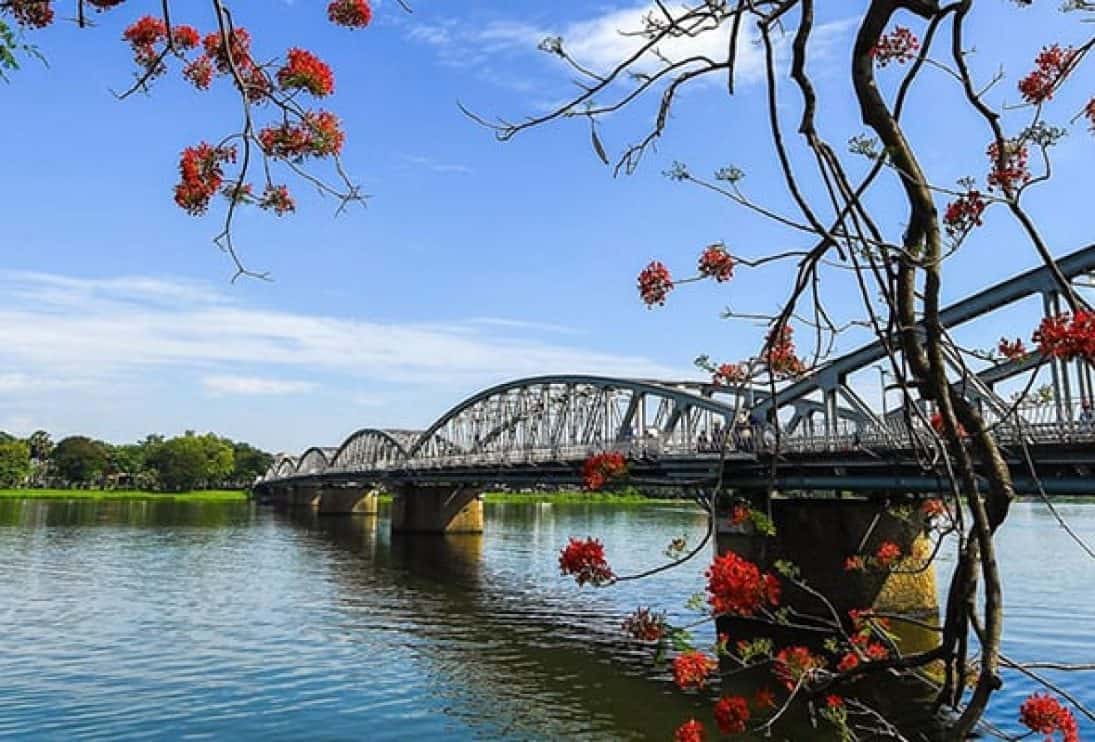
Perfume River in Hue, Vietnam
A visitor to Hue once remarked after his vacation here: “A visit to Hue would not be complete…
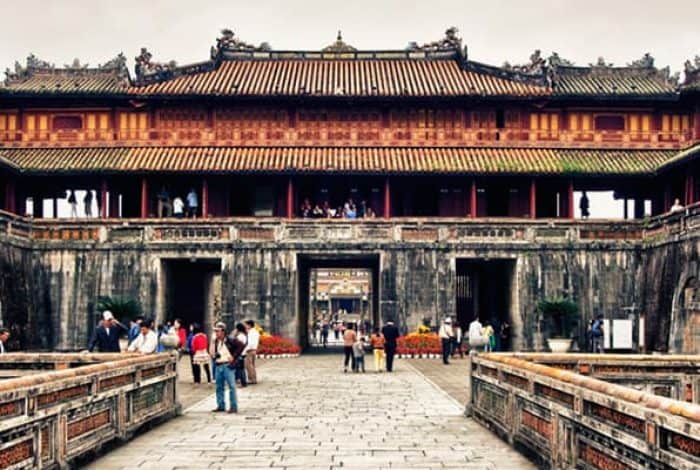
Purple Forbidden City in Hue – A Nostalgic Look…
If you are a fan of history, you shouldn’t miss the last citadel of Vietnam, which is located…
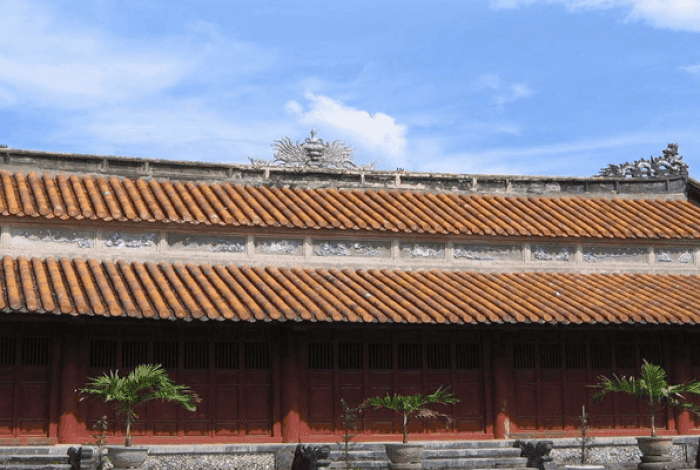
Royal Fine Arts Museum – The Earliest Museum In…
Hue, a city in central Vietnam and also once the capital of Vietnam, is chosen to be the…
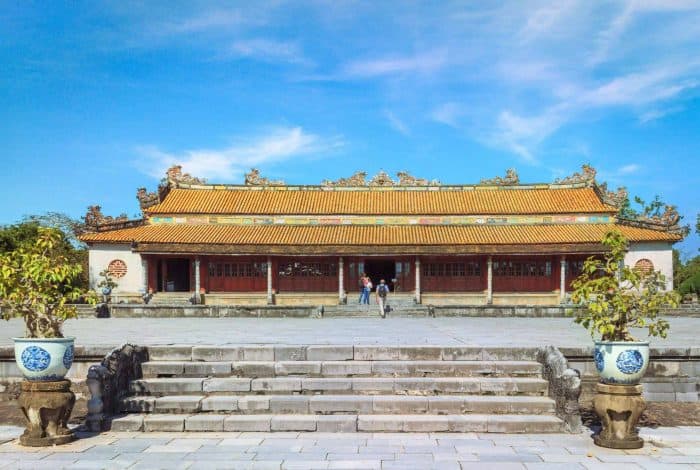
Thai Hoa Palace (Throne Palace) in Hue Citadel
Hue, the imperial citadel of Vietnam, has been known for the historical values that were preserved for hundreds…
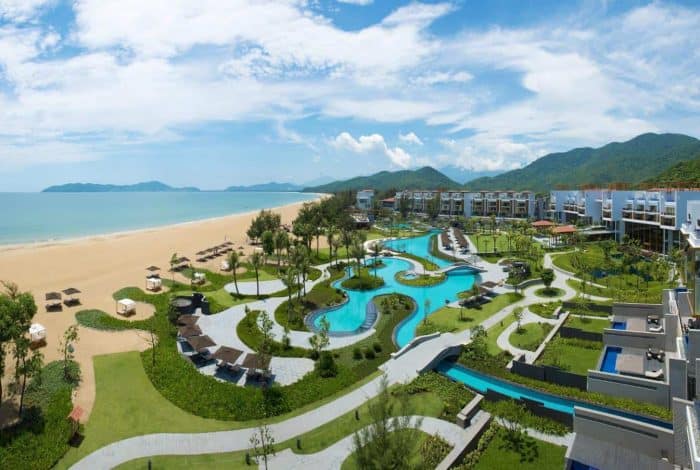
Spectacular Beauty of Lang Co Bay
A trip to central Vietnam cannot be perfect without a stop-over at Lang Co Bay, which lies between Danang…
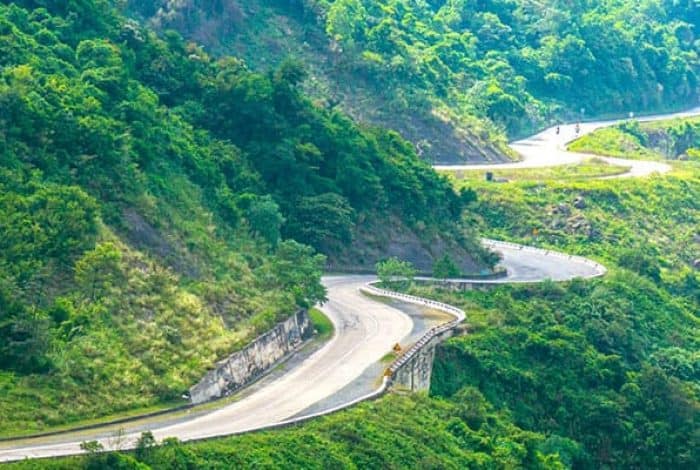
Journey through Hai Van Pass – The Highest Pass…
Hai Van Pass is one of the most scenic hillside roads in Vietnam. When braving the steep winding…
Famous Royal Tombs in Hue
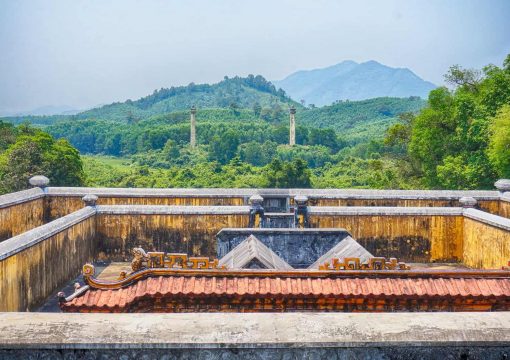
Travel Guide to Tomb Of Gia Long (Thien Tho Lang) in Hue
Hue Imperial and the system of tombs there is not strange to visitors who are interested in the…
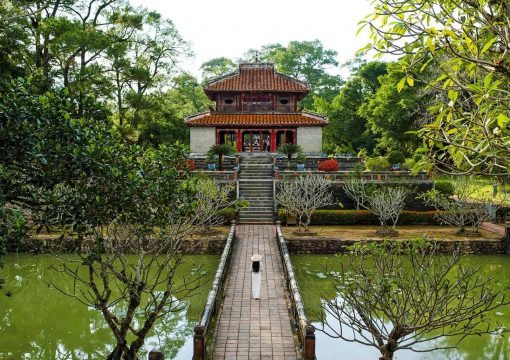
Tomb of Minh Mang with Its Artistic Ideological Values
Hue, the ancient citadel of Vietnam, is an attractive destination for those who are interested in the architecture…
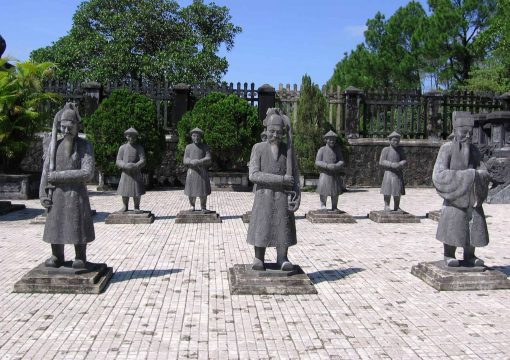
Khai Dinh Tomb, Hue: Smallest but Most Costly amongst Nguyen Royal Tombs
Khai Dinh Tomb, officially known as the Ứng Mausoleum, is situated in Chau Chu mountain, about 10km away…
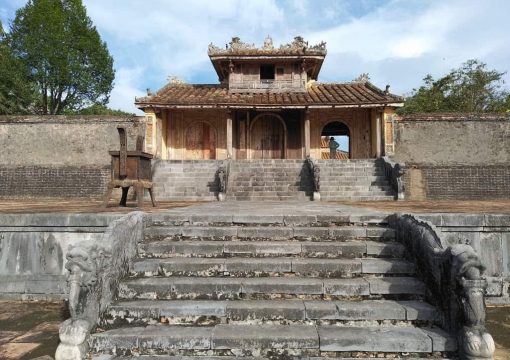
Tomb of Thieu Tri: an Ancient Construction in Hue Citadel
Hue, the ancient citadel in Central Vietnam, has long been well-known for its historical constructions built under the…
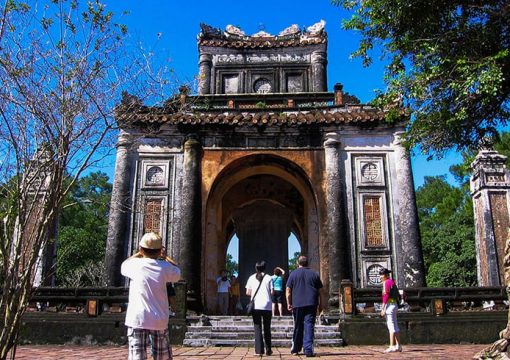
Tu Duc Tomb – a Romantic and Royal Resting Place for an Emperor
With unique architecture and perfect harmony with the natural landscape, Tu Duc Tomb becomes one of the buildings…
Destinations
Tours by style.
- Shore Excursions
Travel Guide
- Best Time to Visit
- Getting around
- Transportation
- Best Beaches
- Vietnam Honeymoon
- Travel esim to Vietnam
Our Company
- Responsible travel
- Terms of use
- Privacy Policy
- Recruitment
Connect with us:
- (+84) 989 383 767
- Email: [email protected]
- Hanoi, Vietnam: 23rd Floor, TASCO Building, Pham Hung road, Me Tri, Tu Liem, Hanoi.
- Ho Chi Minh City, Vietnam: 2nd Floor, VIPD Building, No. 4 Nguyen Thi Minh Khai, Da Kao Ward, District 1, HCMC
- Hong Kong: Vietnam discovery Travel Limited Room 1D, 2/F, Fu Tao Building,98 Argyle Street, Mongkok, Kowloon, Hong Kong
Where Do You Want to Go?
- Tell us details of your holiday plan.
- Get multiple quotes from our expert agents, compare, then customize further.
- Select & book the best deal.

12 Most Beautiful Things to do in Hue, Vietnam
By: Author Taylor Lorenz
Posted on Last updated: 03/27/2023
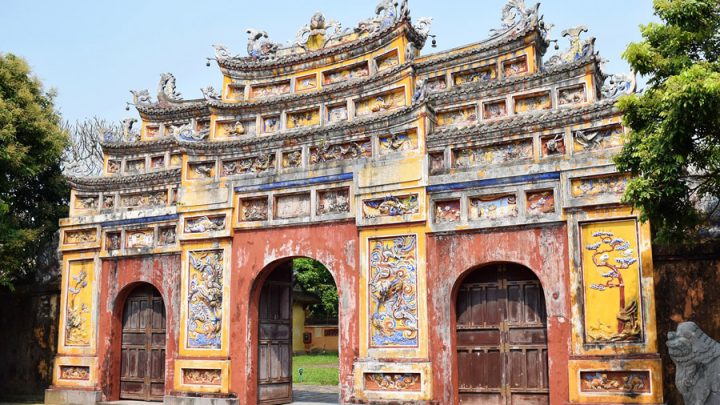
Hue is often a city overlooked by many travellers making their way through Vietnam. It’s unfortunate as this central city is a small yet stunning city to stop in along the Perfume River. It was the capital of Vietnam for 143 years (1802–1945) where Emperors lived. Today you can walk through their residences and see the historic ruins that are being restored as one of the main things to in Hue. In the state that they are currently in there is a sense of calm and beauty.
History is simply everywhere you look in Hue from tombs to the tallest pagoda in Vietnam, Hue is one city that is worth adding to your Vietnam itinerary , history buff or not because Hue is a Vietnam must see. Keep reading, I cover what to do in Hue, things to see in Hue and where to stay.
Table of Contents
Forgot travel insurance? No worries!
It’s still possible to get affordable travel insurance when travelling.
SafetyWing can be purchased in 180 countries and provides coverage for medical, travel delays, luggage, emergency response plus other perks for a third of the price compared to the biggest competitor for similar coverage.
Things to do in Hue Vietnam
Find what to see in Hue for a 1-2 day stop in this historic city and the top attractions in Hue. Many of the most historic things to do in Vietnam are here.
Imperial City
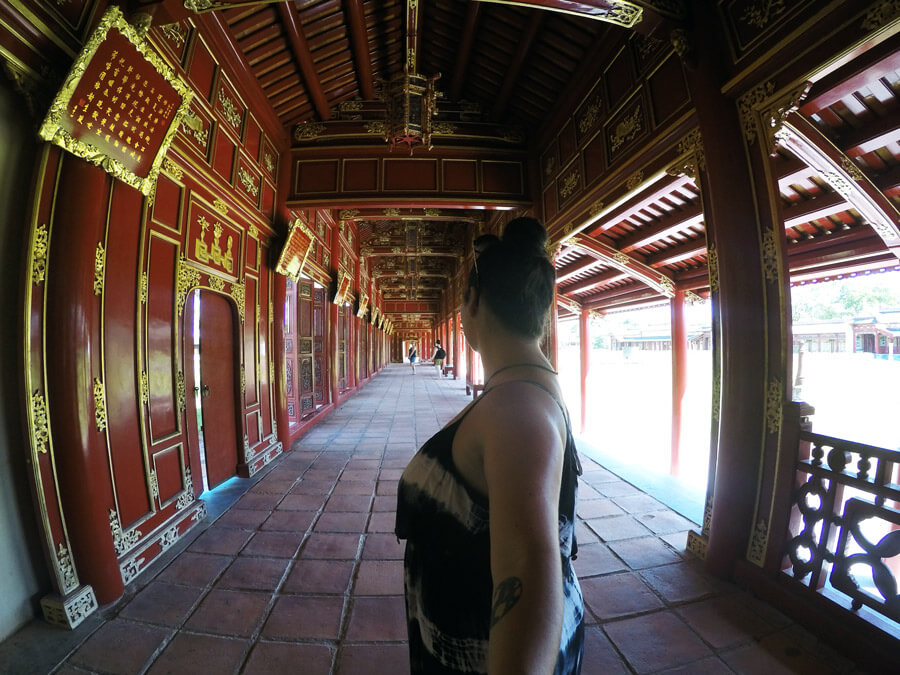
The Imperial City, also known as The Citadel, is where you can start your Hue sightseeing. The Imperial City is a walled city where Vietnam’s Emperors lived with thick stone walls surrounding the interior buildings. It has been damaged from battles but restoration is ongoing. Inside you can see the buildings both damaged and restored with intricate details. I recommend picking up a guide that explains what each building is. The entire city is surrounded by a gorgeous moat filled with water lilies.
Pro tip: Make sure you head to the right gate! There is only one way to enter.
Hai Van Pass
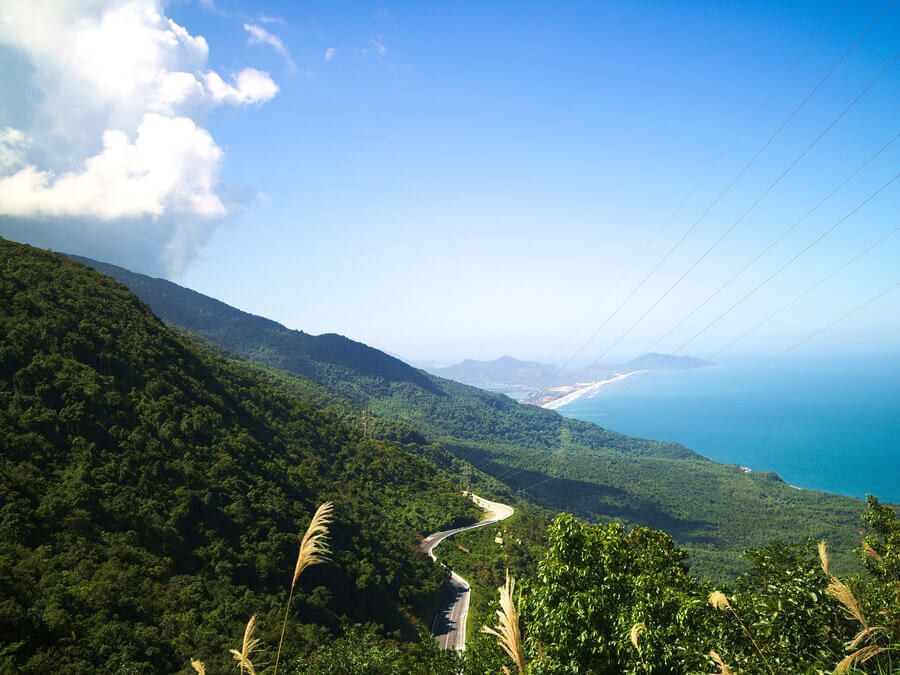
The Hai Van Pass is a route along Vietnam’s coastline that winds up and over a mountain. It’s one of the best things to do in Hue and it’s incredibly popular because of its incredible views of the coast. Many who are motorbiking across the country take this route but if you’re not you can always opt for the option of having a local drive you which is very common to do from Hue.
The road is known for being quite dangerous, with sharp curves that make it difficult to see oncoming traffic, heavy fog and even cows on the road! However, it is still widely driven. If you’re driving there is also the option to take the Hai Van tunnel which was built to make the pass safer. You can also do it the opposite way from Hoi An to Hue .
Thien Mu Pagoda
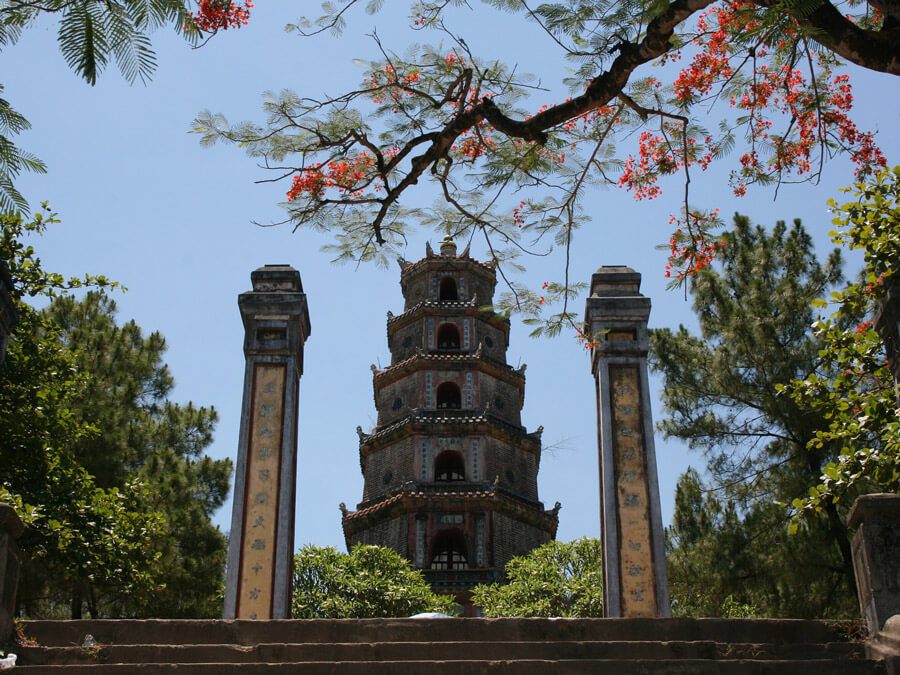
Hue attractions are plenty, but this is one of the top sites. Thien Mu Pagoda is translated to Pagoda of the Celestial Lady, it stands 7 stories tall along the Perfume River on Ha Khe Hill and is one of the best things to see in Hue. It is the tallest religious building in Vietnam and is considered the unofficial symbol of Hue. The temple was established in 1601 but the pagoda wasn’t built until 1844.
The grounds around Thien Mu Pagoda are beautiful to see but this site also holds political significance. When the Catholic government in the 1960’s decided to ‘crack down’ on Buddhists this was the place where Buddhists would meet after 9 were shot in Hue.
Japanese Bridge (Thanh Toan Bridge)
Thanh Toan Bridge, also known as the Japanese Bridge, was originally built between 1740 and 1746 to help transportation to and from the town that lies on the opposite side of the river. It was named after the Japanese Bridge in Hoi An because of its resemblance. Its building was initiated by Tran Thi Dao, the wife of a Mandarin in the Emperor’s court at the time. Today an alter has been erected on the bridge for Tran Thi Dao and many people still cross the bridge to see her tomb.
Tombs of the Emperors
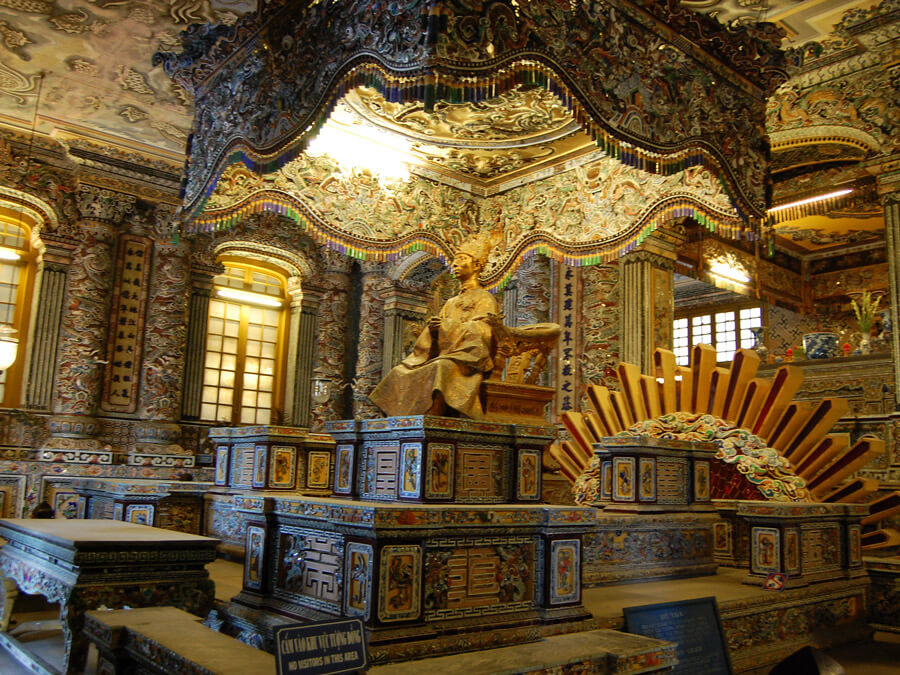
One of the top things to see in Hue are one or more of the tombs. In total there are 7 tombs scattered around Hue’s countryside that house the Emperor’s from the Nguyen dynasty period. The tombs were designed and built during each Emperor’s lifetime and are monuments for 9 of the 13 ruling Emperor’s of the time. The most popular tombs to visit are Minh Mang, Tu Duc and Khai Dinh.
Hue Abandoned Water Park (Ho Thuy Tien Lake)
Photography lovers and explorers will want to venture here. Ho Thuy Tien is a small lake were an abandoned water park sites. It was abandoned in 2004 and is currently still open. It’s quite unique with a large dragon wrapping around a dome shape (dragons are quite important in Vietnamese history) that used to be an aquarium. You can talk around and explore the glass tunnel that once housed fish and crocodiles and get some really cool Instagram-worthy pictures.
Recently some people have been denied entry due to safety but many still get though and it has become well known spots for both locals and visitors to Hue.
Dong Ba Market
Dong Ba Market is the largest market in Central Vietnam and is the perfect spot to see local life. The market is huge selling goods that range from jewelry to food, typical souvenirs and more. There are food courts where you can grab lunch or head up to the second floor to take a peek at clothing.
Hue Provincial Museum
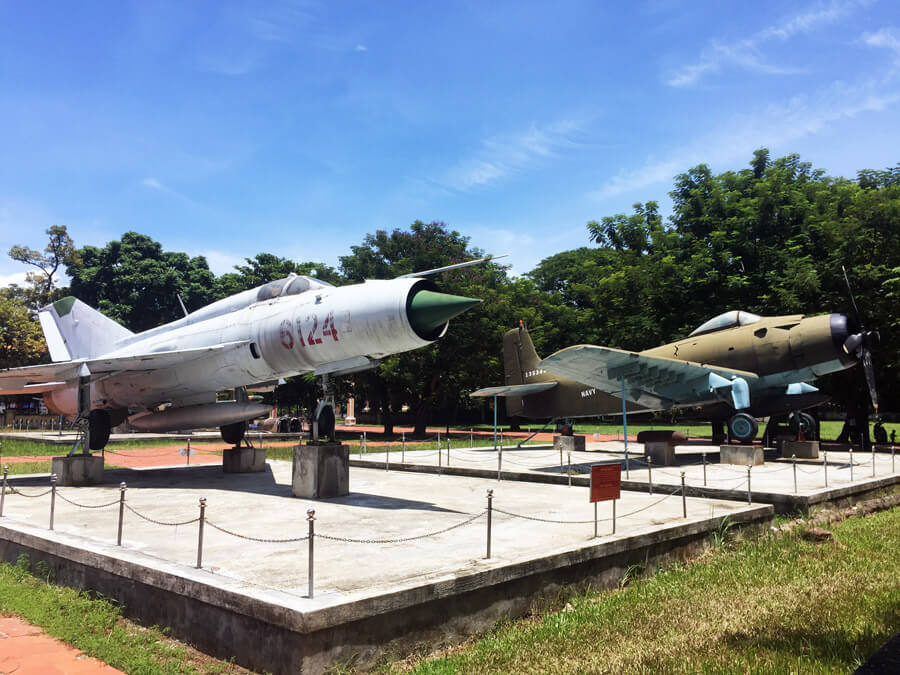
Just a brief walk away from the Imperial City you’ll find the Hue Provincial Museum. Though it is in desperate need of some maintenance if you enjoy history you can enter for only $1 to see the tanks, helicopters and other Vietnam war vehicles up close. Each has an explanation of where and whom it was captured from. If you’re not so much into history you can still see the vehicles as you walk past the grounds.
Bach Ma National Park
To get out of the city and explore some nature, consider taking a half or full-day trip to Bach Ma National Park that lies about halfway between Hue and Da Nang, right where the border between North and South Vietnam used to be.
Bach Ma National Park is filled with hiking trails, waterfalls and even some campsites. French settlers that were well off used to live here but nowadays both tourists and locals alike explore its natural beauty.
Perfume River (Huong River)
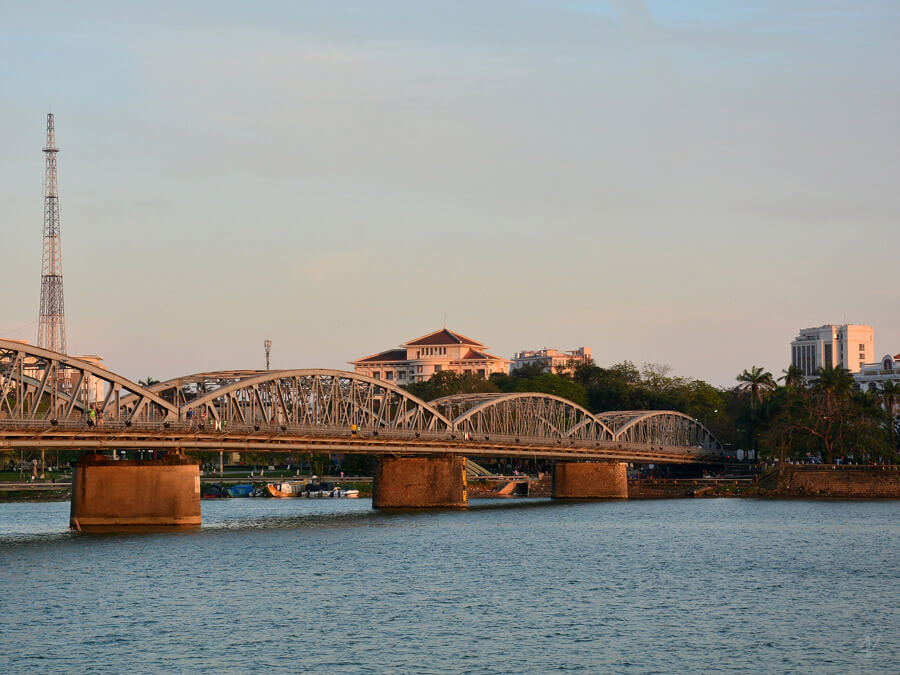
The Perfume River runs through the middle of Hue and can be a relaxing break from city life. Boat tours are available where you can jump off and explore the banks of the Perfume and other areas of Hue. Or simply take a walk along the river at night to find little shops with lanterns lit that weren’t open during the day.
Hue Walking Tour
You can get a good overview of the city in one afternoon if you happen to be visiting on a Saturday or Sunday. Getting to see a city from a locals perspective is always the best way to experience a new place.
Tiger Fighting Arena (Ho Quyen)
Just outside of Hue you can step into the grim past by witnessing Ho Quyen, an old tiger fighting arena that is thankfully no longer in use. Tigers here used to be drugged and have their claws taken out before being put into the arena to fight against elephants, which represented the monarchy.
The tigers were a symbol of rebellion and the act of having them fight and be taken down by the elephants showed spectators that rebellion would not be tolerated.
Alternative Things to do in Hue
- DMZ Vinh Moc Tunnels
- Phong Nga Cave
- Countryside Motor Bike Tour
Hue Accommodation
- Jade Hotel | BOOK NOW: Booking.com
- Than Thien – Friendly Hotel | BOOK NOW: Booking.com
Heading to Vietnam? You’ll love these posts:
- Vietnam Trip Planning Resources
- 51 Travel Tips for Backpacking Southeast Asia
Disclaimer: This post may contain affiliate links which I earn a small commission from and are at no additional cost to you. See my disclosure policy for details. Thank you for supporting my small business!
Disclaimer: Taylor’s Tracks is a participant in the Amazon Services LLC Associates Program, an affiliate advertising program designed to provide a means for us to earn fees by linking to Amazon.Com and affiliated sites.

What are you looking for?
19 best things to do in hue [vietnam] in 2024.
Hue is a popular tourist destination that’s great for anyone choosing to visit Vietnam .
There are so many fun things to do in Hue that it appeals to happy families and broke backpackers alike.
However, it is known most famously for the Imperial City of Hue which has stood for more than two centuries.
And as the previous capital city, it’s had a crucial part to play in Vietnam’s long and illustrious history.
As such, it’s a wonderful place to learn about Vietnamese culture.
So, if you were wondering, “Is Hue worth visiting?”, then I’m here to tell you that the simple answer is, YES!
Let’s get stuck in ...
Travellerspoint
19 awesome things to do in Hue
1. the imperial city.
Even if you’ve got just 1 day in Hue, you need to visit the Imperial Citadel.
It was built back in the early 1800’s under the orders of Gia Long, who was the first ruler of the Nguyen Dynasty.
For a long time, it served as the Imperial Seat of Government, but has longs since lost this purpose.
In fact, it was bombed heavily throughout the 20th century, due to wars with the French and the Americans.
Today, it is the most popular thing to do in Hue, and is a wonderful place to wander around and read up on the city's rich history.
Here are some of the most popular questions about visiting the Imperial City in Hue:
How much does it cost to go in?
The Imperial City entrance fees are as follows:
- Adults: 150,000VND
- Children aged 7-12: 30,000VND
What dress code does the Imperial City have?
According to this press release from June 2017, the dress code in place at the Imperial Palace is meant to be quite strict.
However, we visited in August and there didn't seem to be too many formal checks.
We were walking in shorts and t-shirts and we weren’t stopped. However, we were encouraged not to enter the temples and other sacred places housed inside the Hue Citadel.
Typically, if you do wish to visit such places you should have your shoulders and legs covered, and should not wear any offensive or rude clothing.
What are the Imperial City opening hours?
Between the 22nd April and 15th September, you can visit the Imperial Palace between 8am in the morning and 10pm at night.
These long opening hours make it great for the large amount of tourists who descend on Hue in the summer months.
Outside of this time period however, it is open from 8am till 5:30 am. Except for Thursdays, when it seems to be open til 10pm.
For up to date opening hours, head to their official website and scroll to the bottom of the page.
What does the Hue Citadel look like?
Here is a map of the Imperial City in Hue. It should help you understand where to park and which side is best to enter from. If you have any more questions, then you should check out their official website .

2. Hue Museum of Royal Antiquities
The entrance fee into this museum is covered by the same ticket you used to get into the citadel.
It houses relics from the Nguyen Dynasty and is situated right outside of the Citadel’s walls, making it the next logical place to visit.
When you search online, reviews of the museum are mixed, as much of what’s in there aren’t really “antiques” as you might expect.
But, seeing as it's free, it's definitely worth a look if you're passing by.
3. Tomb of Khai Dinh
The Tomb of Khai Dinh is perhaps the nicest tomb you can visit in Hue, as it has its own unique appeal to it.
The Emperor Khai Dinh actually spent parts of his life living in France, and so become quite fond of French architectural design.
In turn, his tomb strays slightly from the typical Vietnamese design and includes elements from both cultures.
It is also situated on the side of a mountain, offering spectacular views. Having only been completed in 1931, it is also one of the best-kept tombs you can visit.

4. Thien Mu Pagoda (Pagoda of the Celestial Lady)
In case you hadn't already realised, Hue is surrounded by royal tombs and pagodas, so it’s easy to get fed up with seeing them all.
However, the Thien Mu Pagoda is perhaps the most highly favoured pagoda around and is an interesting place to visit.
It was built back in 1844 and still acts as a working monastery. Also, it offers wonderful views over the Perfume Lake.
5. Tomb of Minh Mang
The Tomb of Minh Mang is situated in a beautifully landscaped area which includes lakes and canals.
Emperor Minh Mang oversaw the start of construction on his tomb, but passed away only 4 months in.
It took another 2 and a half years for the work to be completed, and it’s easy to why. With so much care and detail, it really is a wonderful place to explore.

6. Tomb of Tu Duc (Khiem Tomb)
As opposed to Minh Mang, the Tomb of Tu Duc was constructed well before the death of the emperor.
It also took 3 years to construct and is just as nice to explore, and you can also look around the nearby pavilion and lakes.
It’s also interesting to learn more about Emperor Tu Duc whilst you are there.
He had over 100 wives but was never able to father a son (though it was likely down to him becoming infertile due to smallpox, rather than a lack of trying).
7. Bach Ma National Park
Visiting the Bach Ma National Park is actually pretty easy to do from both Hue and Danang as it stretches between both cities.
It was once home to a French Hill Station but is now a popular spot for tourists and locals.
The area is covered with hiking trails and a few campsites if you’re that way inclined. It costs just 40,000 VND to enter the park.
8. Hue abandoned water park (Ho Thuy Tien lake)
Perhaps one of the earliest and most unusual things to do in Hue is to visit the abandoned water park they have nearby.
I’m not too sure on the exact history, but it was almost finished and opened its doors back in 2004.
However, after being open just a few weeks, and having spent about $3 million building it, it shut down.
Since then it’s been left to ruin. It’s hard to see how it couldn't have been successful, as the Vinpearl Amusement Park in Nha Trang does incredibly well.
Either way, if you’re into your photography, this has to be a great place to visit.
9. Head up to Phong NHA
If you want to explore rural Vietnam in it's finest, then Phong NHA is definitely one of the best places to go.
Amongst there things, it includes the best caves to be found anywhere in the country. So, if you're nearby you can't miss it.
If you can't afford he time to go there for a couple days, or if you are flying out from Hue, then you can still do a day trip to Phong NHA.
Here is a useful link to a tour company who can help you get there and back and take you to all of the best sites.
10. Tiger Fighting Aren a (Ho Qu yen)
Just 3 km outside of Hue you come across Ho Quyen, which is a Tiger Fighting Arena built back in 1830.
But don't worry, there’s no fighting going on anymore! In fact, the last one took place back in 1904.
Which is good as well, as this arena still has marks of the grim past (there are tiger claw marks still to be seen inside some of the cages).
Before each fight, the tigers were drugged and had their claws removed so they couldn't fight the elephants that came at them.
This is because the elephant represents the monarchy, whereas the tiger was a sign of rebellion and it had to be crushed.
11. Hon Chen Temple
If you head 10 km upriver from Hue, then you’ll come across the secluded Hon Chen Temple nestled on the banks of the Perfume River.
One of the least well-known things to do in Hue is to visit the Hon Chen Festival which takes place twice a year.
They includes drums and women dancing in brightly coloured clothing (or so I hear).
The festival wasn't on whilst we were there. However, if you are interested then I recommend you check out this article here .
12. The Huyen Tran Princess Temple
The Huyen Tran Princess Temple is located roughly 7km outside of Hue city centre and lies at the foot of Ngu Phong mountain.
The temple is rather lovely in and amongst itself, however, many people visit to also walk all the way up to the Hoa Binh belltower.
It can take a long time to walk up all the stairs, and is not one of the better things to do in Hue when raining as the stairs can get slippery.
However, the panoramic views down over Hue make the walk worthwhile, despite the effort it takes.
I’d recommend having your taxi driver wait for you whilst you visit, as this it’s not a very popular tourist spot so there aren't many taxis around.
13. Go on a sightseeing walking tour
There are a number of walking tours that take place in Hue. Though, from what I can gather, none of them are free.
Though, then again, there's so much to see that they likely are worth paying for.
They are held by local Vietnamese citizens who are best placed to know not only what to do in Hue, but also to explain the rich and vivid history behind each of the attractions.
If this is something that interests you, then there are a few companies who seem to offer the tours, such as this one:
- Beebee Travel
14. Take your own private bicycle tour
Hue is a popular city to rent out a bicycle for the day and to set of exploring.
If you’re sticking to within the main part of the city, then that’s certainly not a bad idea as nothing is within too far a distance.
Also, you could enjoy a nice peaceful cycle up Perfume River.
However, many of the tombs are located at least 10 km or more outside of Hue city centre, so you might need a moped to go and visit these.
15. Thanh Toan Bridge (or Japanese Bridge)
The Thanh Toan Bridge is located slightly more than 10 km outside of Hue, and can be a little tricky to find as it is one of the less touristy things to see in Hue.
However, it is still worth driving out to, and the ride takes you through some really lovely spots.
I’ve taken a screenshot of where to head to below. (I recommend using maps.me to find your way).
Also, the bridge has a rather interesting history that you can read more about here .
16. Perfume River
The Perfume River runs through the centre of Hue and is a popular spot all throughout the day.
In the morning, you’ll see joggers out getting their run in before the rising heat of the day.
Later, there will be tourists roaming either side or taking a slow boat tour down the river itself.
By night, the edges of the river come to life as local vendors open their stalls and start selling their wares.
It’s also a nice place to go and get a bite to eat.
17. Dong Ba market
If you’re looking for somewhere to go shopping in Hue, then the Dong Ba market is your best port of call.
It is the biggest commercial centre in that whole region of Vietnam, and you can buy everything through from classical conical hats to traditional Vietnamese food.
It’s open from 3am through till 8:30 at night, so you have plenty of time to visit.
However, be warned that because you are a tourist, they will try to rip you off.
In fact, some of the prices you hear will sound almost comical at first, before you realise it’s all a part of the game.
I recommend knocking at least 50% off everything they offer and then counter with that.
18. Hue to Danang day trip
Plenty of people choose to go on a Danang to Hue day trip, as Danang is a popular coastal city to stay in.
However, going on a day trip from Hue to Danang is an equally worthwhile experience.
Especially if you’ve got plenty of time and would like to catch a glimpse of the stunning beaches there.
If you’re riding your own moped there, then be sure to take the Hai Van Pass .
It is a mountainous road that offers you some truly stunning views of the Vietnamese coastline.
However, only go if you’re a confident rider and the weather is clear as the pass can be notoriously treacherous.
Alternatively, there's a number of tours you can take, such as:
- Jeep tour from Hue to Hoi An via the Hai Van Pass (and vice versa)
- Scenic day trip from Hue to Hoi An (via the Hai Van Pass and Danang)
19. Hue Festival
The Hue Festival is an incredibly popular event, but you’ll be lucky if you get the chance to see it as it’s hosted only once every two years.
In 2018 it takes place on April 27th and lasts through to May 2nd.
The first festival took place back in 2000 and it is a chance to celebrate the rich historical and cultural values you can find in the nation’s old capital.
Like the Olympic ceremony, the Hue festival is opened with a grand firework display and there’s plenty of events taking place all throughout the rest of the week.

BONUS: Relax!
With so many amazing things to do in Hue, it’s easy to get knackered out and forget to enjoy yourself.
Especially, if like us, you have a rigid schedule of sightseeing every single day.
So, I recommend at least taking a few hours to just relax around the pool and soak up the sun.
We stayed in a hotel called Hue Garden Villa .
It cost only $10 a night each and we had a large modern room, as well as an outdoor pool.
The staff are really friendly as well and give you a free welcome drink upon arrival.
They helped us plan out our days in Hue and also assisted with bicycle and moped rental.
You can find them here on booking.com .

Other top travel tips for visiting Hue, Vietnam
Getting around hue.
As always, the best and cheapest way to visit anywhere in Hue is to rent out a scooter.
It is like this across all of Vietnam, and Southeast Asia in general really!
Fuel is very cheap and you should be able to pick up a scooter in Hue for no more than $5.
Speak to your hotel or hostel about renting one out. Oh, and check out this guide I wrote on renting a scooter in Southeast Asia .
Where to eat in Hue
Depending on your budget, there are plenty of places to eat in Hue.
We chose a few of the budget restaurants located in the main hostel area.
I recommend heading up to the same area and taking a look around. I’ve left a screenshot below.
Oh, and if you’re wondering what to do in Hue at night, then I’d recommend going to this same area. The bars there seem to be open quite late and there’s a fun, buzzing atmosphere.
When to head out
Much like the rest of Vietnam, Hue can become extremely hot once it approaches the middle of the day.
This makes exploring Hue much less enjoyable, particularly the Imperial City which is very much open to the elements.
I’d recommend getting an early start to your day and heading off to the sites as soon as they open, in order to try and beat the sun up.
Then, maybe head back to your hotel for a dip in the middle of the day, before doing the remainder of the sites in the evening.
Remember, in the busy summer months, the Imperial City is open until 10pm, so you might as well go visit later on in the day.
How do you get to Hue?
The cheapest way to get to Hue would be to buy yourself a hop-on, hop-off bus ticket when you start out in either Hanoi or Ho Chi Minh.
This is what we did. It cost just $30 each and allows you to stop off at all of the major places through Vietnam, whenever you like.
Also, I know a lot of people who choose to fly into and out of Hue, to avoid the longer bus journey North.
Or, if you're coming up from Hoi An, then here is a link to a site that offers private transfers the whole way . This will also offer you the chance to see experience the Hai Van Pass on your way in.
Rounding off
Well that’s it, you’re all set.
You should now have plenty of things to do in Hue, so it’s time to go off and make your own memories.
If you’ve been before and have anywhere else to recommend then let me know in the comments below!
Oh, and if you’re heading south from Hue to Hoi An , then here’s a useful article I put together:
- The Best Things To Do In Hoi An
It’s the next logical stop and a great place to pick up a cheap suit!
Or, if you’re heading North from Hue to Hanoi , then be sure to stop off in Phong NHA on the way.
It plays host to the most spectacular caves in Vietnam and is a breathtaking region to explore.

Leave a comment
Let us know what you think.

5 million people can't be wrong
Ho Chi Minh City
Get lost in historic citadels and idyllic landscapes of the imperial city.
The Hue difference
Despite the fast-paced urbanization and cultural assimilation that are raging on in other parts of this Southeast Asian nation, best described as old Vietnam writ large, Hue, as a former capital of Vietnam, takes pride in its long history, atmospheric temples, sublime royal palaces and unique cultural traits that can hardly be found elsewhere in Vietnam. Besides exotic elements of the Imperial City, a walled enclosure within the citadel, Hue is extremely well-known for its cultural heritage elements recognized by UNESCO, one of which is Nhã Nhạc (Vietnamese court music).
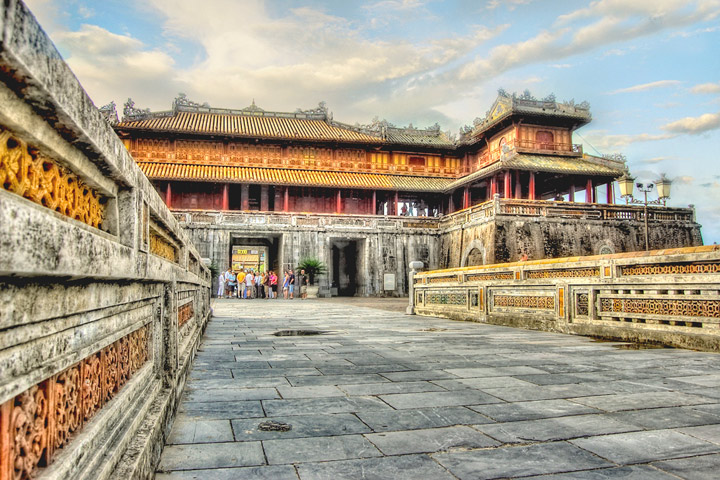
It is imperative that one be able to tell Hue and Thua Thien- Hue apart. When someone says the word “Hue'' in a conversation, it is highly likely they are referring to Hue city itself. Hue city is situated in Vietnam’s central province of Thua Thien- Hue, which is bordered by the more well-known city of Đà Nẵng to the South and the war-torn province of Quang Tri to the North. This article will place its focus on Hue city while not forgetting to suggest some other worth-visiting places in other parts of Thua Thien- Hue province.
Best time to visit
Featuring a tropical monsoon climate , Thua Thien- Hue enjoys wet and dry periods over the year, with the dry season spanning six months, from March to early August, and the monsoon season lasting from late August to January. With 120 kilometers of coastline, the whole province of Thua Thien - Hue is especially vulnerable to devastating hurricanes from the East Sea. Thus, one has to be on their guard when they decide to visit Hue from August to January.
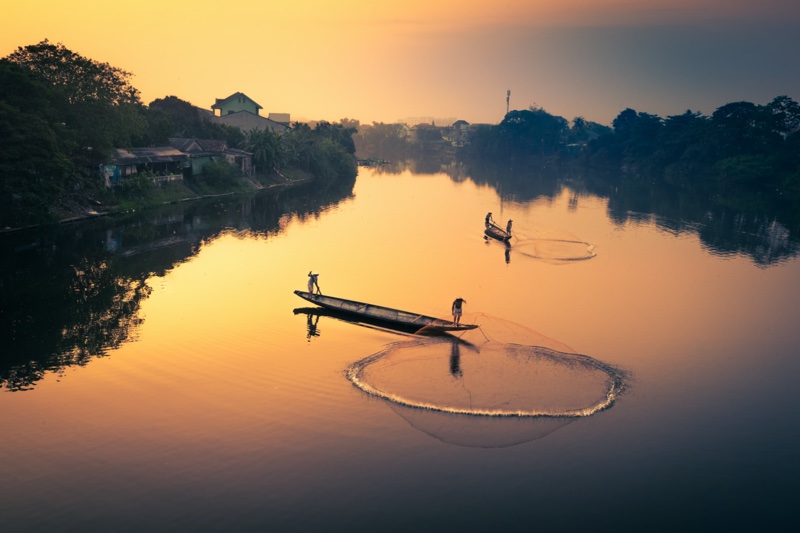
The weather in Hue remains hot from early May to end of September, with temperatures reaching up to 38 to 40 degrees Celsius in May and June. From October to March, affected by the Siberian anticyclone, average temperatures in Hue hover around 20 to 22 degrees Celsius, with lows of 9 degrees Celsius. Thus, it is from January to March that is the best time to visit Hue as the weather may be cool enough while there is little or no rain between these two months.
How to get there
Hue’s Phú Bài Airport connects this city with other major cities in Vietnam through direct domestic flights. Located in Central Vietnam, it only takes at most 1.5 hours to fly to Hue from any part of Vietnam. There are daily direct flights to Hue from the capital city of Hanoi and from Vietnam’s most populous city of Ho Chi Minh. A round trip may only cost VND 2.500.000 (approximately USD 120).
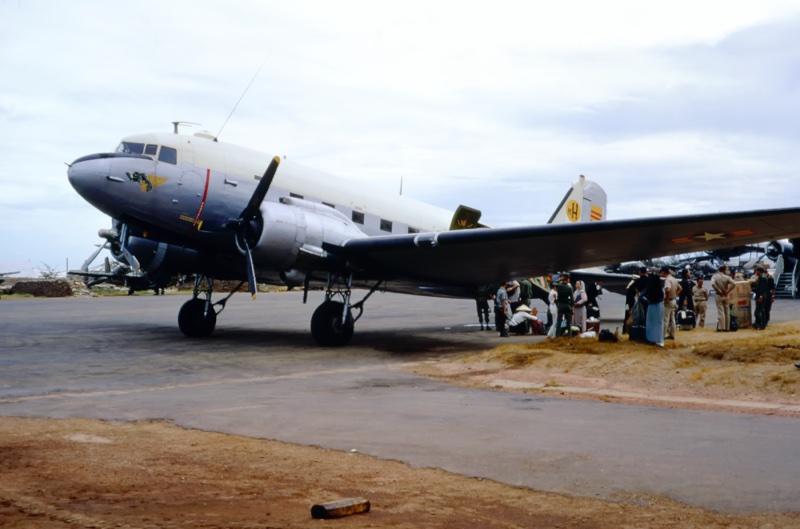
Most travelers would choose this mode of transport to travel to Hue from its neighboring city of Danang. The train ride may last from 2 hours to 4 hours depending on the type of train you choose, and the ticket is pretty much reasonably priced, at VND 80,000 (4 dollars). The route will offer you a stunning view of Vietnam’s coastline as well as Lang Co Bay – one of the most beautiful bays in the world.

Car/motorbike
Hue is highly accessible by car and motorbike. However, please be informed that roads in Hue’s center are relatively small for large cars as most roads have only two lanes.
Where to stay
The fact that Hue is somewhat less developed than its neighboring city of Đà Nẵng and significantly less touristy than Hội An does not mean that there are no high-quality hotels in the former capital of Vietnam. In fact, there are quite a few high-quality hotels revolving around the Imperial City. To name a few luxurious boutique hotels , Hue has Indochine Palace Hue, whose architecture and design are strongly praised by travelers and architects who have stayed here, VinPearl, whose name is already very familiar with Vietnamese people, and Azerai La Residence, a colonial-style villa sitting on the bank of Hương river.
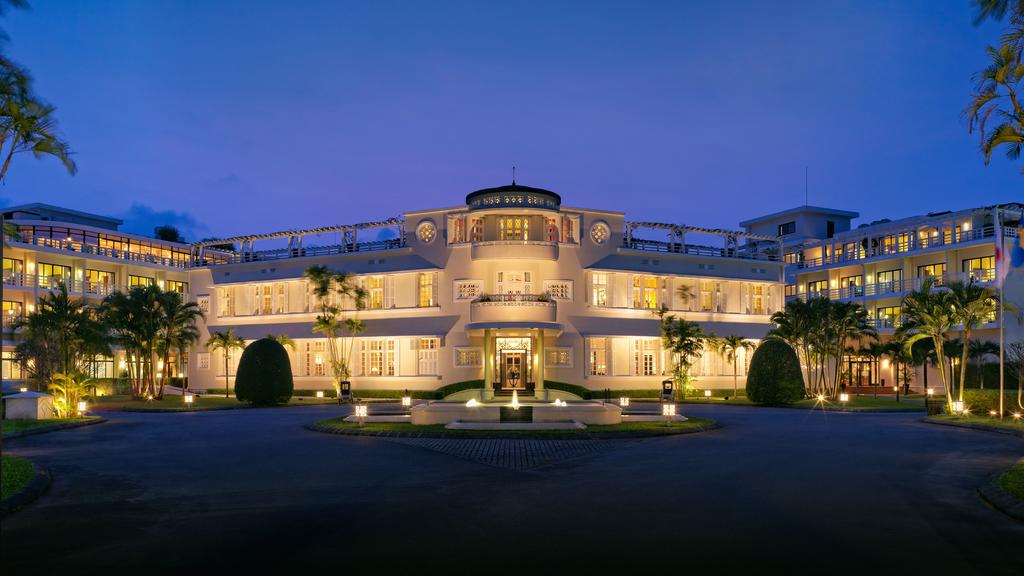
Meanwhile, there are some other 3-star hotels located around the city centre which only cost as much as VND 1,000,000 (~USD 50) per night as well as some small guest houses that only charge you around VND 200,000 (~USD 10) to VND 500,000 (~USD 25). The rise of AirBnB has also diversified accommodations in Hue as many serviced apartments in Hue can now be found on AirBnB.
Places to visit
The complex of hue monuments.
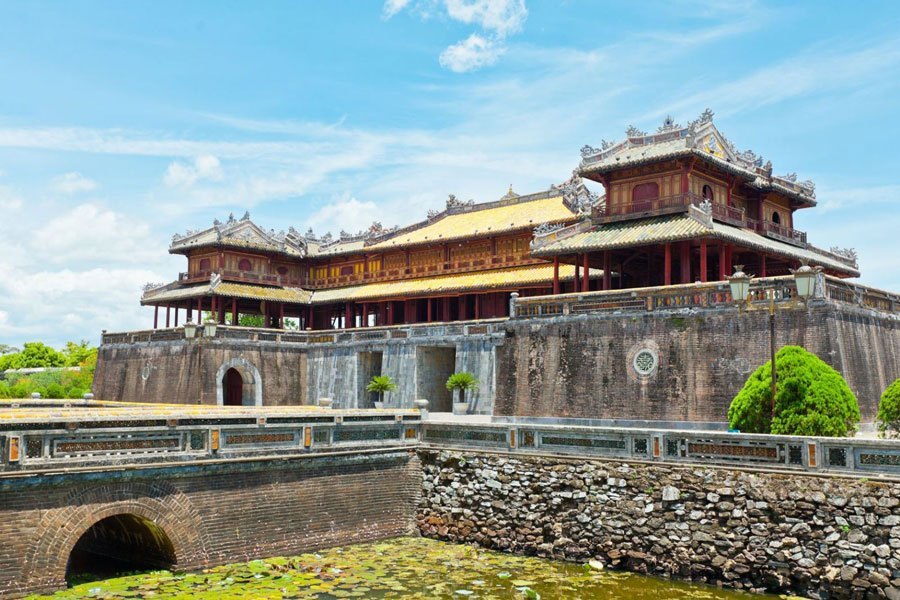
Constructed on the banks of Hương river, The Complex of Hue Monuments is an imperial palace complex at the heart of Hue city, Thua Thien– Hue province. Due to its cultural, architectural and historical significance, The Complex of Hue Monuments was recognized as a UNESCO world heritage site in 1993. Many monuments and ruins, the most recognizable of which is Ngo Mon gate, are featured in the massive complex which was once used by the royal family and their eunuch servants.
Here, time comes to a halt as you meander along the palaces and revel in the harmonious medley of culture and history. A visit to this site may bring you back to the history of old Vietnam as well as offer you a glimpse into Vietnamese history. Don’t forget to bring a big bottle of water and wear a high-quality pair of sneakers!
Khai Dinh Mausoleum
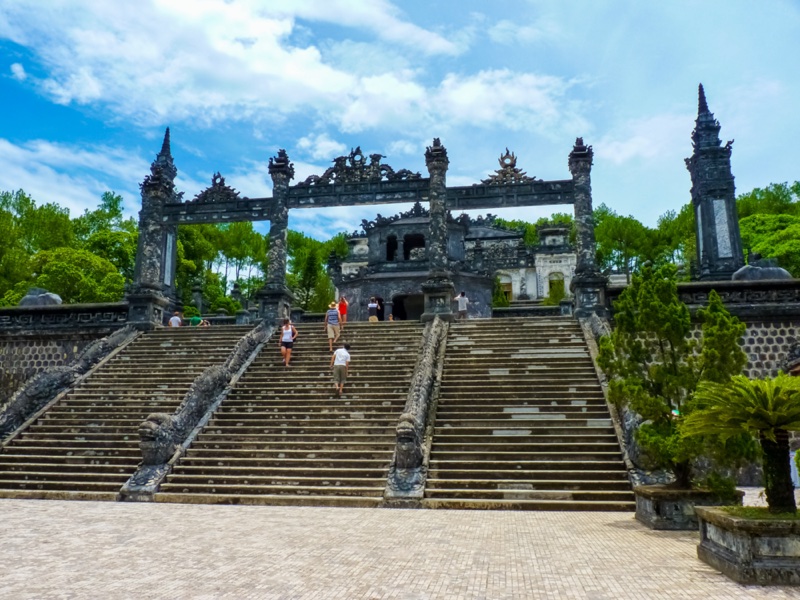
Hue remained the capital of Vietnam by the Nguyễn dynasty during their reign over the country. As the kings passed away, they also wanted to be buried in Hue as they believed this region had good feng shui. Among all mausoleums in Hue, Khải Định mausoleum stands out as the most gorgeous, most stunning and most architecturally valuable one. The mausoleum of Emperor Khải Định, who was deemed an aesthete by many, embodies a perfect confluence of Eastern and Western architecture.
Minh Mang Mausoleum
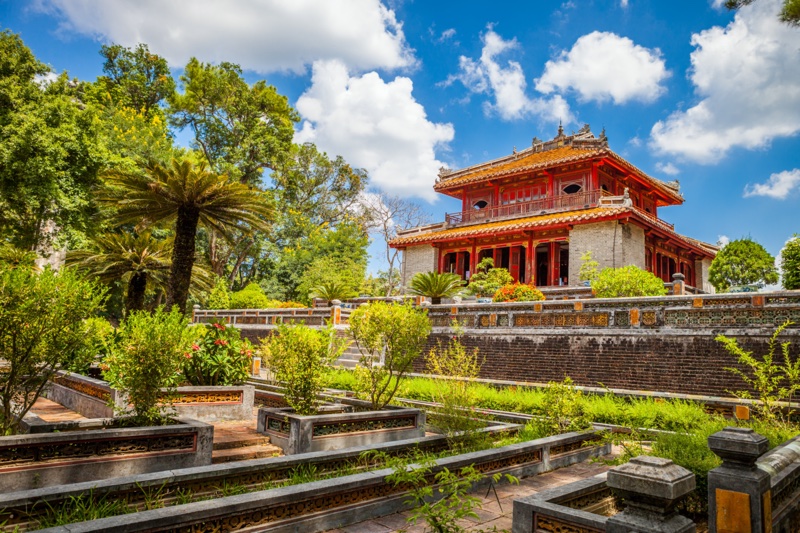
Another mausoleum worth visiting is Minh Mạng mausoleum. While Khải Định mausoleum features an outstanding blend of traditional Vietnamese and French architecture with beautifully carved walls and vibrant colours, Minh Mạng mausoleum has traditional Eastern architecture inspired by Confucianism. This mausoleum is located on Cam Khe mountain, at the place where Ta Trach and Huu Trac rivers merge into one water body named Hương River.
- Thien Mu Pagoda
Irrespective of one’s religious beliefs, Thiên Mụ Buddhist Pagoda is definitely worth adding to his itinerary. This temple, endowed with priceless architectural and religious values, has inspired the works of art of an immense number of Vietnamese artists, poets and authors. The stupa of this temple, Phước Duyên, is an iconic symbol of Hue city. This octagonal tower, which embodies a traditional Mahayana stupa, represents Taoist cosmology, which has a strong influence on today’s Mahayana Buddhist cosmology.
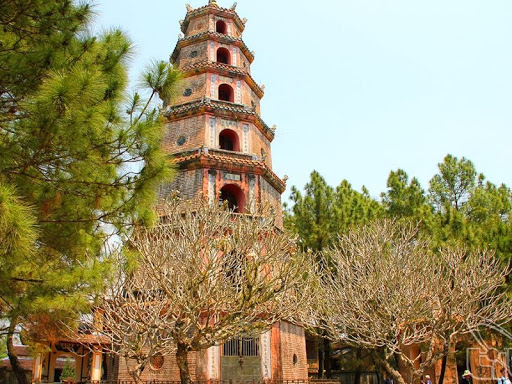
Hue High School for the Gifted (Quoc Hoc Hue)
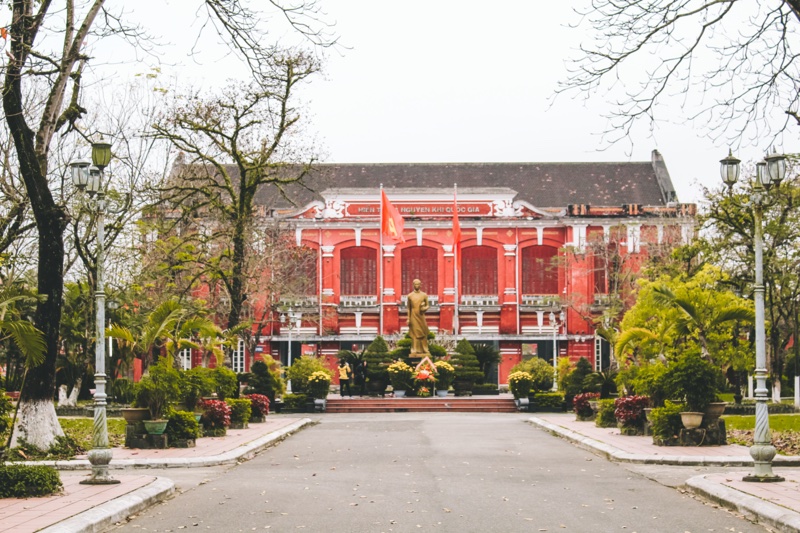
The idea of visiting a school on vacation may not have sprung to one’s mind. However, one should take Hue High School for the Gifted into consideration when they happen to be in Hue. This atmospheric school may fill you with nostalgia for your schooldays. It is the largest high school campus in Vietnam with many large shady trees, benches, and colonial architecture.
See full lists of Hue attractions .
Food to try
Vietnamese cuisine encompasses diverse elements of the culinary culture of Vietnam, which is divided into three categories: Northern Vietnamese cuisine, Central Vietnamese cuisine and Southern Vietnamese cuisine. Food whose roots are traced back to Hue plays a crucial role in the formation of Central Vietnamese cuisine.
In general, Hue cooking places its emphasis on well-prepared dishes with strong aromatic components and a spicy edge, reflecting the preferences of royal families in the past. Bun bo Hue (Hue-style beef noodles), which is the most well-known Hue food, is a perfect example of this argument. There is no room for simplicity in this kind of food whatsoever as it demonstrates intricacy, attention to detail as well as the use of medically beneficial ingredients.
Other than bún bò Hue, bánh lọc (tapioca dumplings) is also another Hue’s well-known food. They are small, chewy tapioca dumplings filled with prawn and pork belly, and are used with diluted fish sauce. One tapioca dumpling only cost VND 2,000 (~ USD 0.1) on average. Also, bánh xèo, a savoury pancake containing a variety of stuffing (pork, prawn and bean sprout) in batter mixed with turmeric powder, is another must-try food. Unlike Mekong Delta’s version of bánh xèo, Hue’s version is smaller in size, slightly thicker, crispier and is used with sophisticated peanut sauce, creating such an aromatic smell.
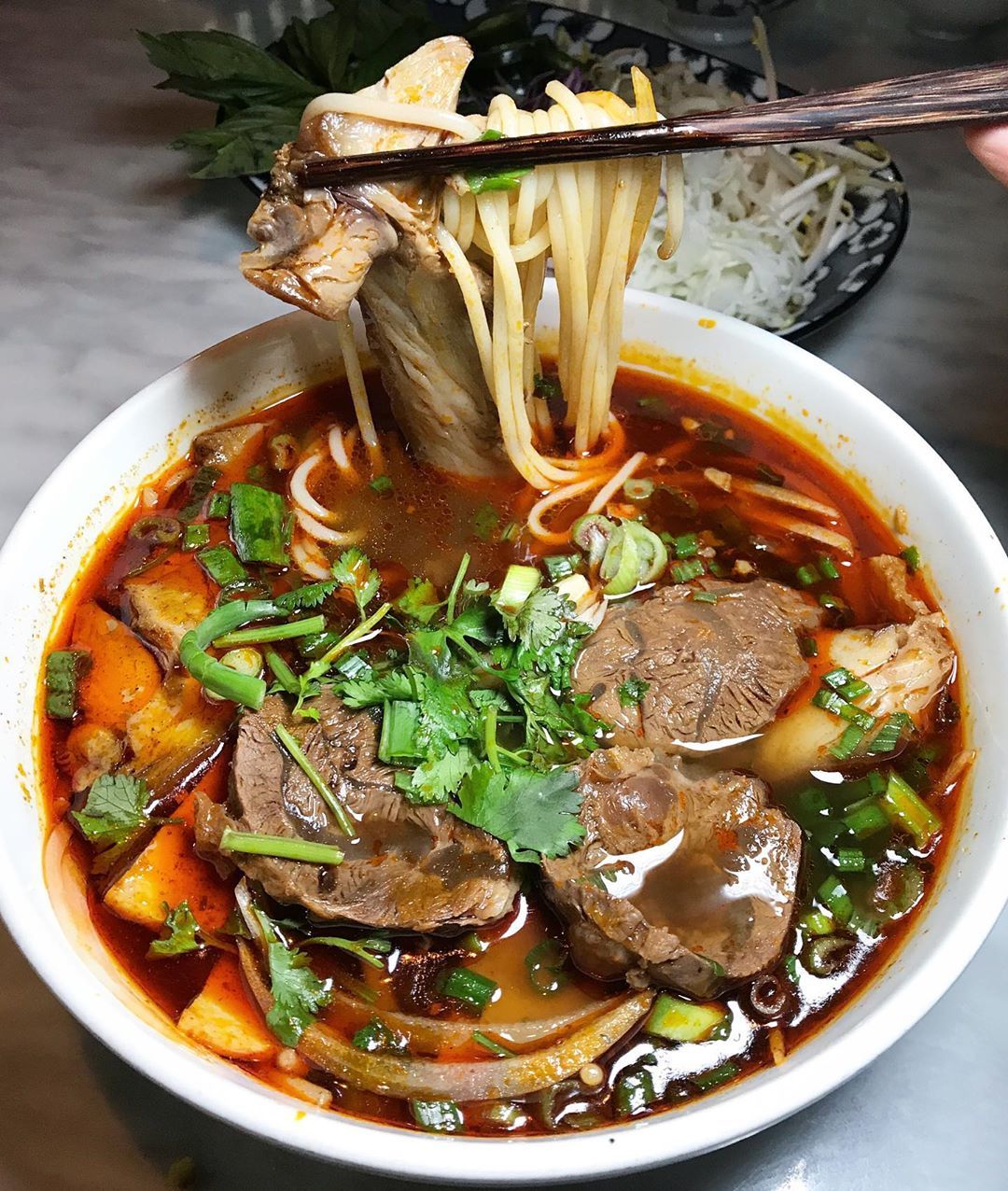
Last but not least, it will be a big mistake if one skips chè cung đình (royal dessert) when they travel to Hue. It is believed that the members of the royal family relished having chè as a dessert. This kind of food in Hue, in contrast to the sweet taste of the Mekong Delta’s version, has a light taste and does not tend to include coconut milk. The most favoured kinds of chè are chè nhãn lồng hạt sen (chè with lotus seed wrapped in longan flesh), chè bột lọc heo quay (chè with roasted pork wrapped in tapioca). Fancy as they may sound, one dish of chè may only cost as much as VND 15,000 (~ USD 0.7).
Popular Attractions
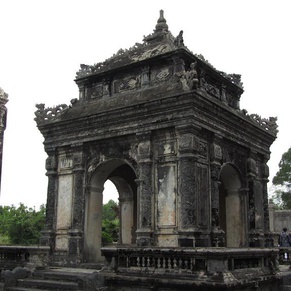
Seasonal Guides
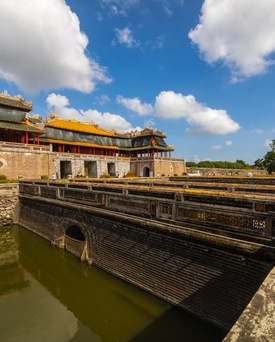
Best Of Hue
See, Eat, Sleep, Shop, Stay - The Best of Hue
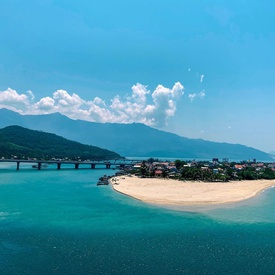
A List Of 10 Most Hospitable Tourist Destinations in Vietnam Post Covid-19 Pandemic
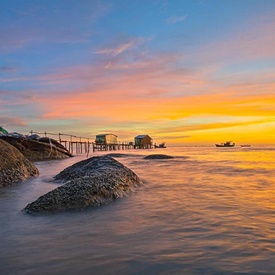
5 Best Spots For Admiring Sunset Throughout Vietnam
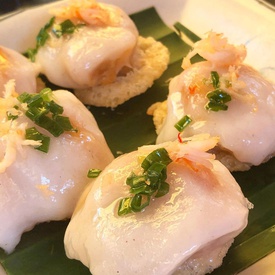
The Top 6 Foods You Must Try in Hue City
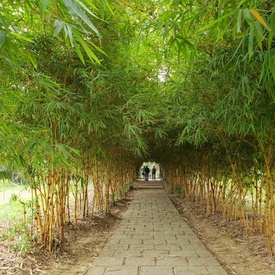
Make a Beeline for The 10 Most Beautiful Villages in Vietnam
Frequently asked questions, what is the open time for hue's citadel.
Learning clearly about the opening hour of the attractions will help you plan your schedule better. Below is the opening time of the sights for your reference:
Summer Time: from 06:30 AM to 17:30 PM
Winter Time: from 07:00 AM to 17:00 PM
What food to try while in Hue?
Hue is a true cuisine paradise where you can find plentiful iconic local specialties. These are the most popular dishes that you can find in every corner of Hue city:
- Hue Rice Dumplings: Banh Beo (Rice Savory Dumpling), Banh Nam (Steamed Flat Rice Dumpling), Banh Loc (Tapioca Savory Dumpling)
- Com hen, bun hen (Baby Clams with Rice or Noodle)
- Bun thit nuong (Hue Grilled Pork Noodle)
- Nem lui (Hue Lemongrass Skewer)
See the 5 must try Hue's delicacies
What are the most famous attractions in Hue?
Coming to Hue, you shouldn’t miss historic monuments, ancient pagodas, and breathtaking landscapes. You can take a look at our recommendations below for the must-see sights:
- Hue Imperial City
- The Tombs of Emperors: Tomb of Tu Duc, Tomb of Khai Dinh, Tomb of Minh Mang
- Perfume River
- Lang Co Beach
- Thanh Toan Bridge
How to get to Hue Airport?
Phu Bai Airport is 15km from the center and there are 2 popular choices to travel to the downtown: taking a taxi/private car or taking a bus. It will save you time and certainly more comfortable by a taxi or private car, while the bus is a more cost-saving option, it is only around VND 50,000/person. You may have to wait quite a long time for the bus, however.
Vietnam's Most Popular Destinations

7 Best Things to Do in Hue, Vietnam [Vietnam Travel Guide]
When looking for what to do in Hue, Vietnam it pays to know more about it. Right in the middle of Vietnam, Hue was the capital for 143 years (1802 – 1945), so there are many cool things to do in Hue. It is a city rich in history. Hue is home to 7 imperial tombs as well as the ancient imperial city. During the Vietnam war, Hue suffered badly.

The “Battle of Hue” was one of the longest and deadliest battles. Along with human casualties, many historic sites were damaged or destroyed. The best things to do in Hue, Vietnam are related to its history, Buddhism, culture and natural environment.
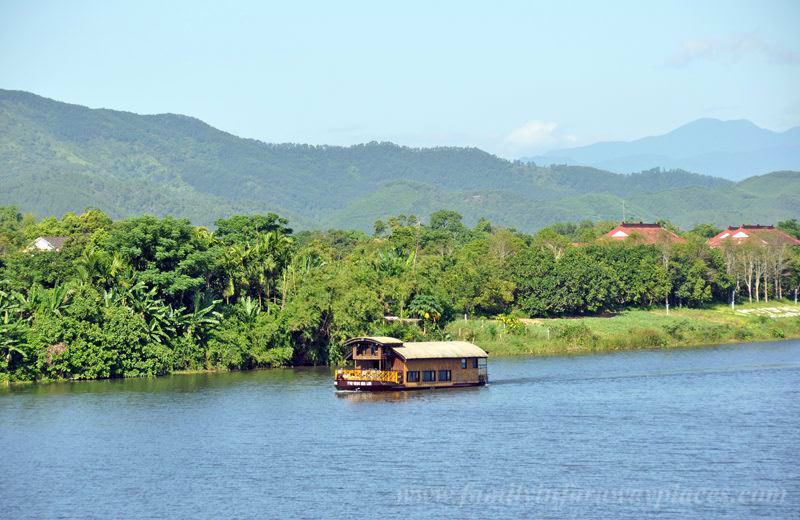
- Travel Guide to Popular Cities in Vietnam – 25 Day Trips you can Do in Vietnam
- 7 Things to Do in Hanoi, Vietnam
- Complete List of Recommended Best Luxury Hotels in Vietnam
- 10 Steps I Took to Quit my Law School to Teach English in Vietnam
- Reasons Why I would Go Back to Vietnam
7 Best things to do in Hue, Vietnam
1. hai van pass in hue, vietnam.
If you are driving to Hue from Da Nang , you have two options. The first is to take the Hai Van Tunnel. Hai Van Tunnel is the longest tunnel in Southeast Asia at a length of 6.28 km. The other option is to take the Hai Van Pass – one of the best things to do in Hue, Vietnam.
If you don’t know what to do in Hue with your spare day. Hai Van Pass is a mountain road which takes you up and down and around the coastline. The views are spectacular, and this is a route that is incredibly popular with people traveling by motorbike in the area. Drivers and tour buses park for a few moments at the highest peak of the pass to take in the view and stretch their legs. Hai Van Pass is known to all travelers as one of the most exciting things to do in Hue, Vietnam.
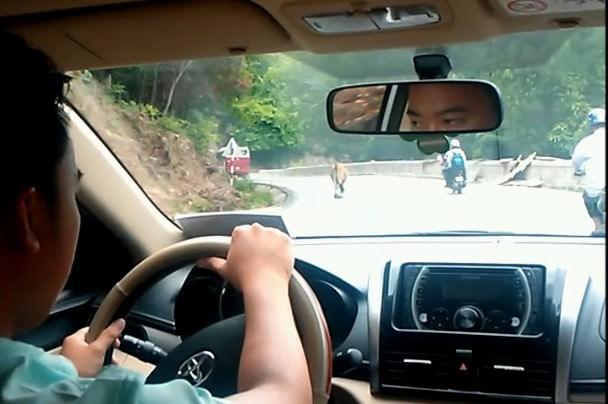
Not only known for its beauty, but the pass is also known for its danger and difficulty (a reason why the Hai Van Tunnel was built). At times the sharp curves make it completely impossible to see oncoming traffic. Often the road is covered in thick fog. There are cement railings to help prevent falls off of the mountain into the ocean, but they are broken in places. Occasionally you pass shrines marking where travelers met their end. If you are not careful, this could become one of the most dangerous things to do in Hue, Vietnam! Not to mention a cow or two and motorists driving like they are racing along a flat country road. Is it worth the trip? You bet!
2. Hue, Vietnam Imperial City
One of the more historic things to do in Hue Vietnam. This walled fortress and palace were once the home of Vietnam’s emperors. Also called “The Citadel” the palace grounds are surrounded by an impressive moat filled with waterlilies. Much of the structure was damaged in battles, but the restoration is ongoing. Once inside you can see different buildings in their original, restored and damaged stages. Once you know about the Imperial City, it’s easy to decide what to do in Hue!
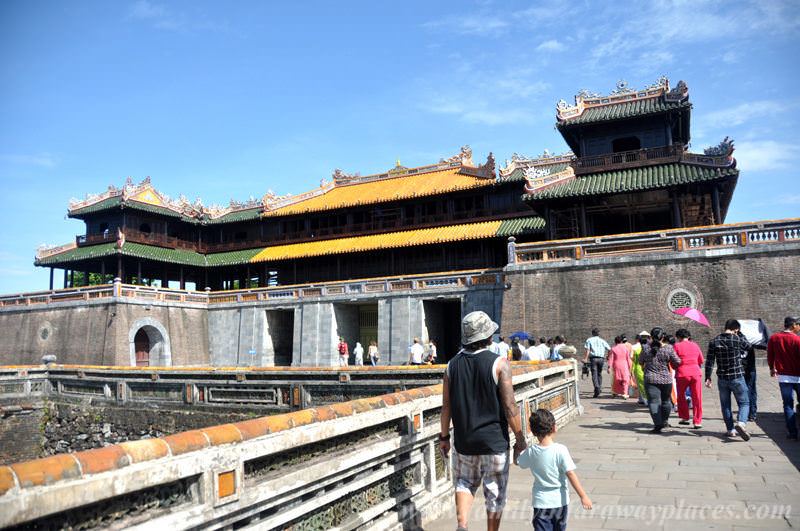
Make sure your taxi driver drops you off at the correct gate! There is only one entrance to the Imperial City but some taxi drivers like to pretend that they don’t know that tourists wish to be dropped off at the main gate.
3. Hue Provincial Museum
Are you wondering what to do in Hue to beat the crowds? Just a little down the street from the Imperial City is the Hue Provincial Museum. The museum is in bad need of maintenance. The grass hasn’t been cut in ages, and there are holes in the walkways. There is an indoor museum with photos and artefacts but few English explanations. Considering the significance of the battles which took place in Hue the museum doesn’t do the memory justice. With just a little effort, this could be one of the most interesting things to do in Hue, Vietnam.
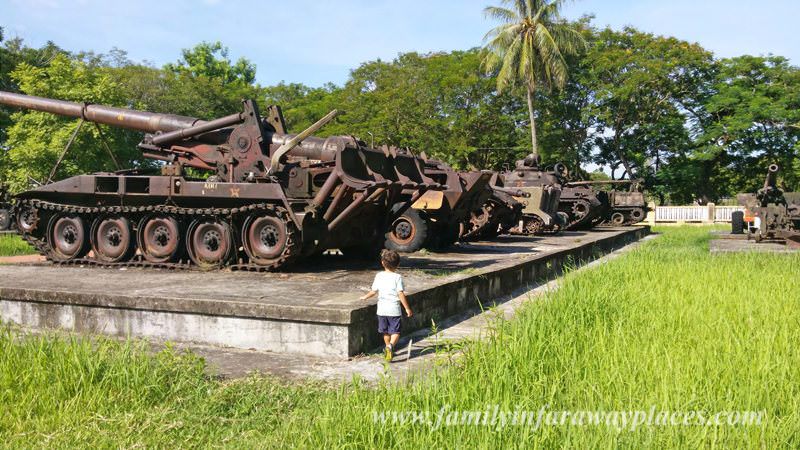
If you are interested in history or wars then the museum is worth a quick visit. It is easy just to pop over if you are already visiting the Imperial City and it costs only about $1. In the front grounds, they have several tanks, planes and a helicopter from the Vietnam War. There are placards in both Vietnamese and English explaining where the vehicle was captured and from whom which are quite fascinating. In particular, children from both local and tourist families seemed to be thrilled to be able to check it all out without the crowds.
4. The Perfume River in Hue, Vietnam
Not sure what to do in Hue that’s perfect for a romantic couple’s day out? Through the center of Hue flows the Perfume River. Many tourists choose to take a boat tour along the river. Passengers can enjoy the river views, have a meal and visit some of the major tourist sites around the area that are accessible by boat.
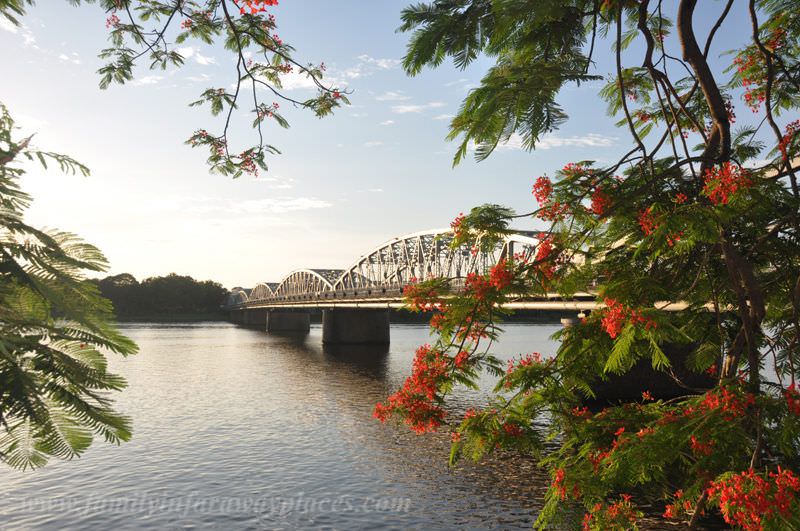
Another way to take in the river is to stroll along the walkways along the river’s edge. In the morning joggers take their morning runs here and in the evening the area becomes transformed. Little shops and restaurants that were closed during the day open at sunset and lanterns are lit.
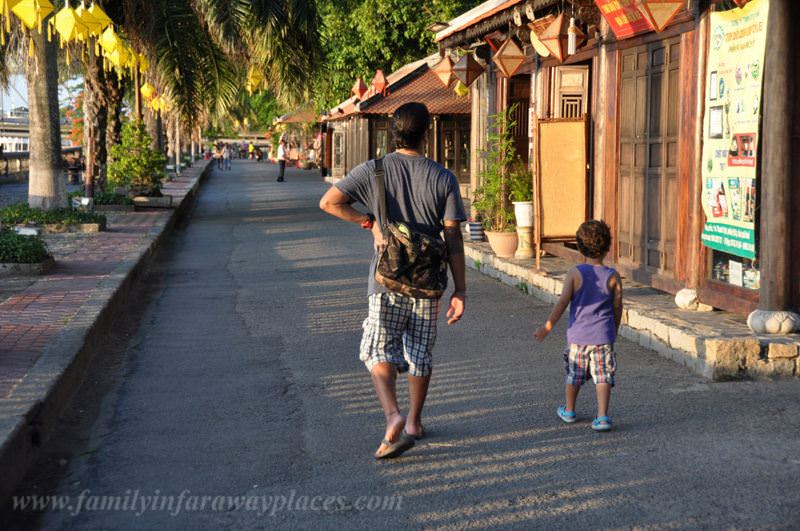
Families gather to chat and play. Vendors sell snacks, and small toys and some musicians can be heard.
5. Khai Dinh Tomb
The Khai Dinh Tomb is the last of the imperial tombs in Vietnam. The tomb took 11 years to build and was completed in 1931. Despite being quite a recent addition, Khai Dinh Tomb is one of the more popular tombs in the area.
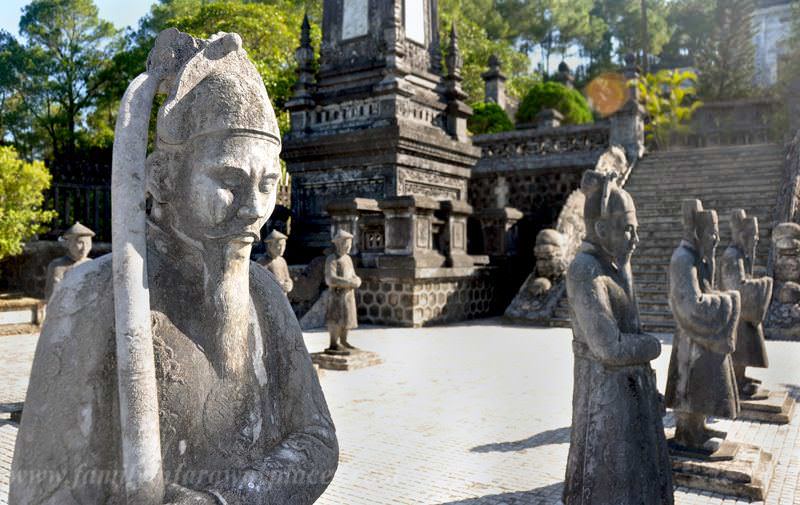
In his lifetime Emperor Khai Dinh spent some time in France. As a result, the tomb is a mixture of both Eastern and Western designs.
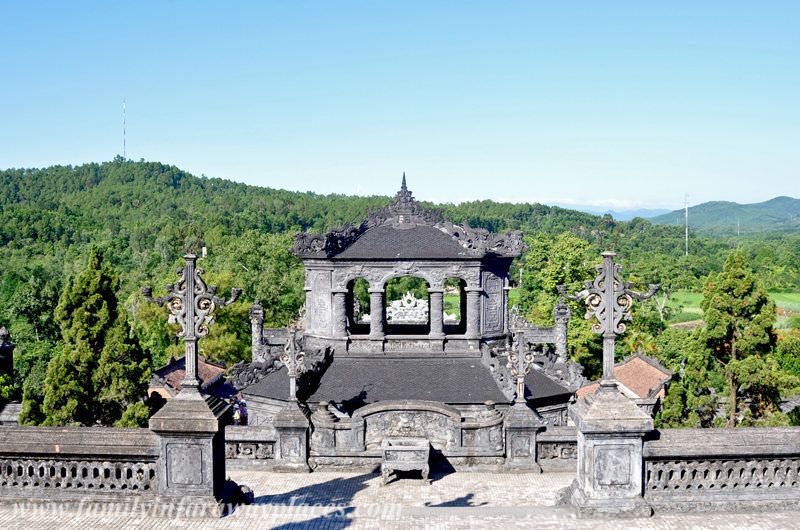
A climb up 127 steps up the side of the mountain will bring you to the temple fortified by statue guards. Once inside visitors are in awe of the walls which the builders adorned with images inlaid in glass and porcelain. This view from the top is one of the most spectacular things to do in Hue, Vietnam.
6. Minh Mang Tomb
How did emperors decide what to do in Hue? Simple, they just built tombs to commemorate themselves! The tomb of Emperor Minh Mang is another of the more popular tombs in Hue. Unlike Emperor Khai Dinh’s tomb which took more than a decade to complete, they completed this tomb in only three years. Emperor Minh Mang started construction of the tomb in September 1840 but passed away around four months later.
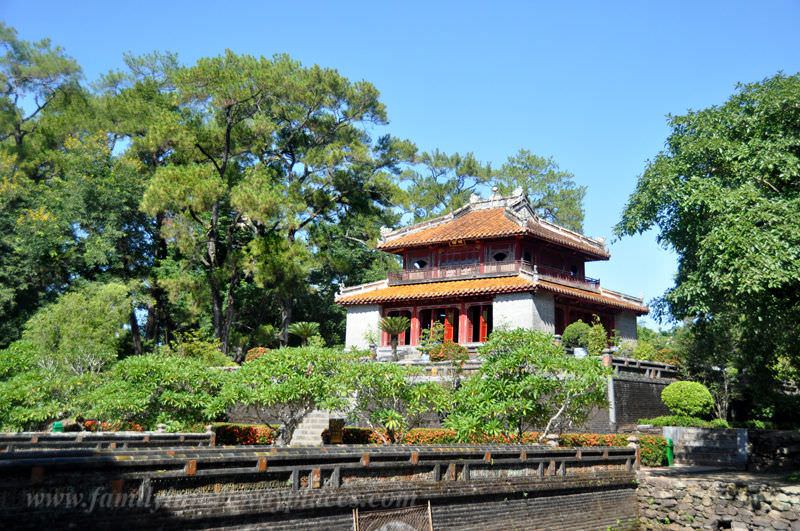
You would never suspect that they had completed the tomb so quickly, though. As well as the beautiful architecture, the grounds include landscaped lakes , canals and gardens. Of all the things to do in Hue, Vietnam this tomb is one of the most beautiful.
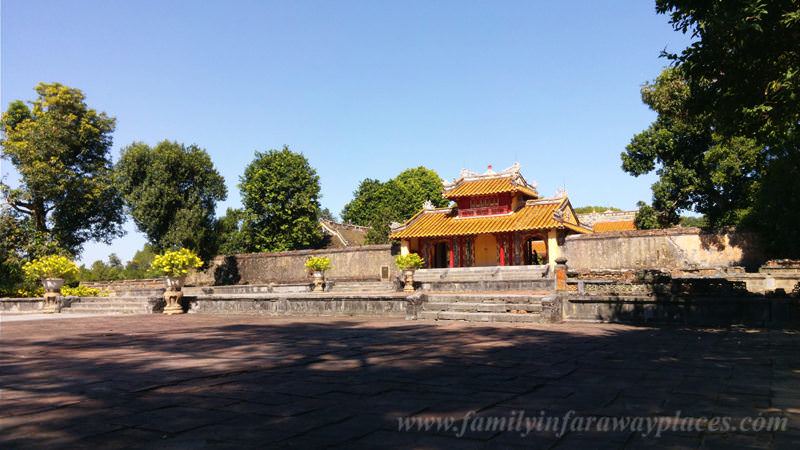
Visitors to the grounds of the tomb can freely explore most of the sites, but they only open the gate to the tomb once a year on the anniversary of Emperor Minh Mang’s death.
7. Thien Mu Pagoda
Overlooking the Perfume River on Ha Khe Hill, the seven-story Thien Mu Pagoda is the tallest religious building in Vietnam. The temple itself was established at the location in 1601, but the tower was later constructed in 1844.
The temple grounds are not only beautiful, but it is also a site of political significance. During the “Buddhist Crisis” of 1963, the Catholic government cracked down on Buddhism in the country, despite the majority of Vietnamese being Buddhist at the time. When the government shot nine unarmed Buddhists in Hue, Thein Mu Pagoda became an organizing point for those involved in the movement. When the government refused appeals for religious equity, Buddhist monk Thich Quang Duc drove to Saigon (Ho Chi Minh City) and in protest, sacrificed himself by setting himself on fire.
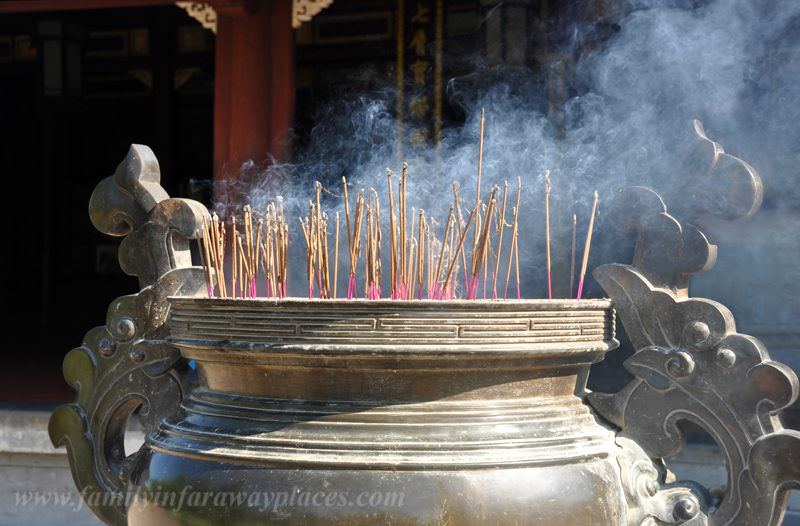
Malcolm Browne captured the event in a world-famous photograph. In the back of the photo, you can see the car which Thich Quang Duc drove. If you don’t know to look for it, you may even miss it, but tucked to the side in a building behind the main prayer hall of Thien Mu Pagoda the car sits on display commemorating those events. A visit top this historic pagoda, with these events in mind, will be one of the more poignant things to do in Hue, Vietnam.
8. Find accommodation in Hue, Vietnam
Where to stay in hue, vietnam, best budget hotel in hue, vietnam – jade hotel.
Jade Hotel is just 1 km from Dong Ba Market and Trang Tien Bridge while Chieu Ung Pagoda is 1.8 km from the property. Phu Bai Airport is 14 km away.
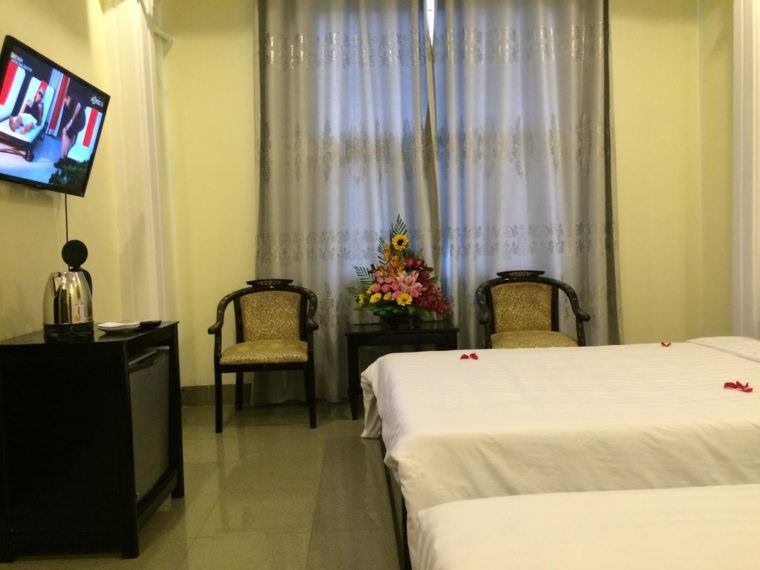
Guests can enjoy a meal at the on-site restaurant, or simply lounge at the sun terrace. The hotel also offers bike hire and car hire and can help you decide which things to do in Hue, Vietnam!
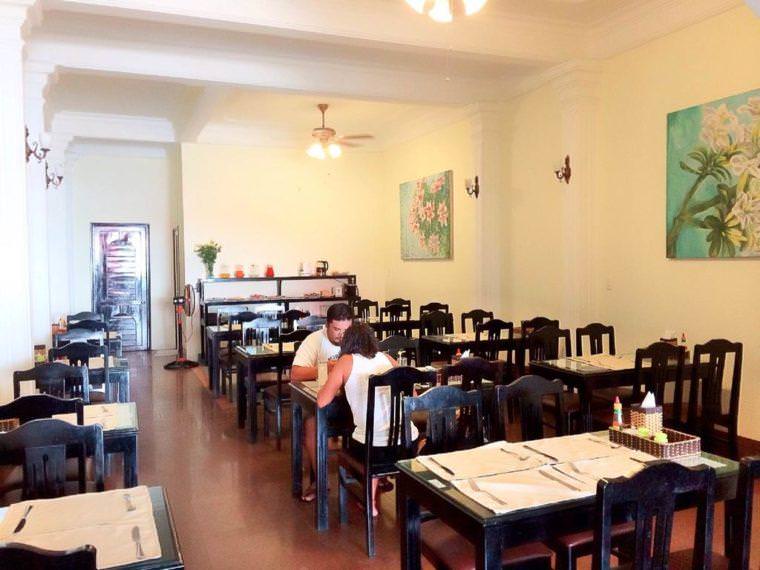
There is a TV for entertainment and a private bathroom with a bath or shower, with slippers and free toiletries provided. This accommodation features free WiFi and private parking.
Best Mid-Range Hotel in Hue, Vietnam – H ue Serene Palace Hotel
Hue Serene Palace Hotel is strategically located within 200 m from the famous Huong River and Trang Tien Bridge. The hotel is just 600 m to Hue Citadel and about 1 km to Hue Train Station. Hue Airport is 10 km away, while Da Nang International Airport is approximately 70 km away.
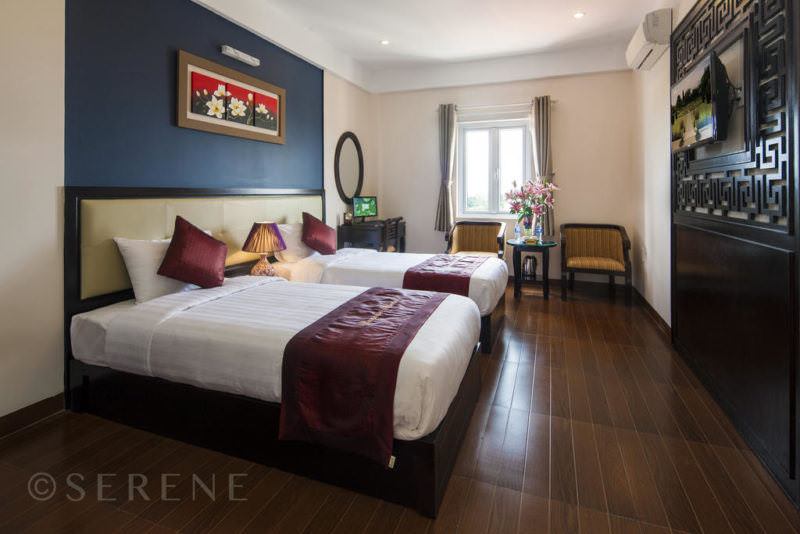
It features modern rooms equipped with a personal computer and offers free Wi-Fi access throughout the property. Parquet flooring, air-conditioning, a wardrobe, personal safe, flat-screen cable TV and seating area are all standard in rooms. They also provide complimentary fruit with tea and coffee making facilities in each room. The en suite bathroom comes with a hairdryer, bathrobes and free toiletries.
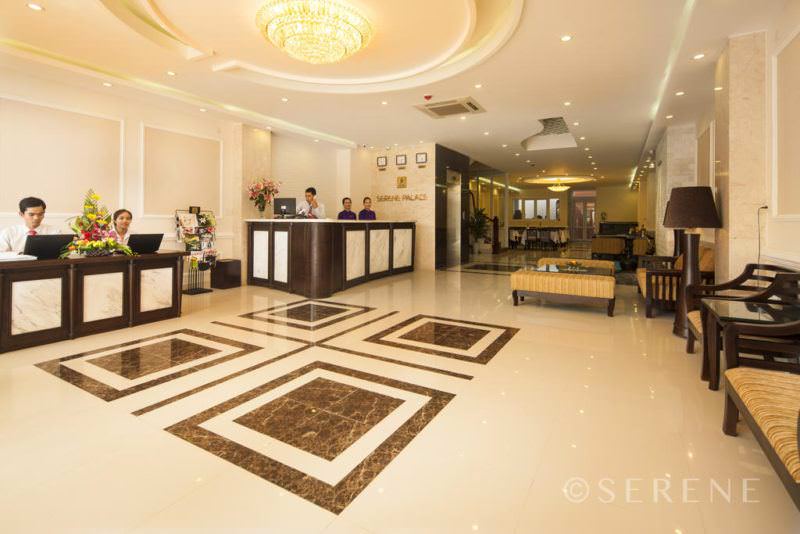
Hue Serene Palace Hotel has a tour desk that can assist with sightseeing and travel arrangements. Luggage storage, laundry, and babysitting services can be requested from the 24-hour front desk. Other conveniences include a business center, currency exchange and bicycle/car rental services.
Best Luxury Hotel in Hue, Vietnam – La Residence Hue Hotel & Spa
La Residence Hue Hotel and Spa – MGallery by Sofitel is a classic colonial villa spread over 200 m on the banks of the scenic Perfume River, 600 m from the Ho Chi Minh Museum, Bao Quoc Pagoda and Hue Train Station. Dong Ba Market is 2.3 km from the hotel, while Phu Bai Airport is accessible with a 17 km drive.
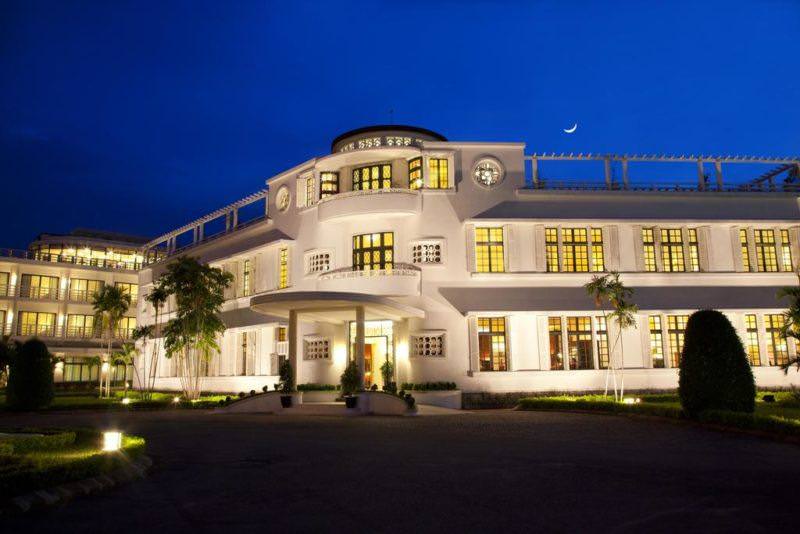
The well-appointed rooms all have individual designs with beautiful Art Deco furniture and spacious terraces. Enjoying views of the city or river, all come with a TV, minibar and private bathrooms. Offering free WiFi, it also has a tennis court, pampering spa treatments and a fitness center. Guests can enjoy meals at the in-house restaurant. If you appreciate luxury, then a stay here could turn out to be one of the best things to do in Hue, Vietnam
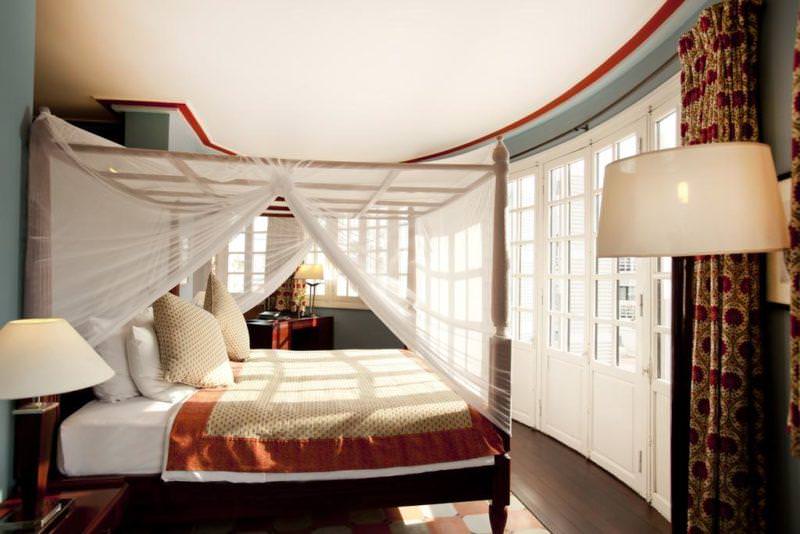
Guests can enjoy a massage at the spa or spend quiet moments at the hotel’s library. The tour desk can arrange day trips and car rentals and they offer the free use of bicycles for guests who wish to explore the surrounding area. Sports facilities that include a half-court basketball court, ping-pong, as well as billiard tables and a kids’ club, are also available.
Hue Vietnam Top Travel Tip:
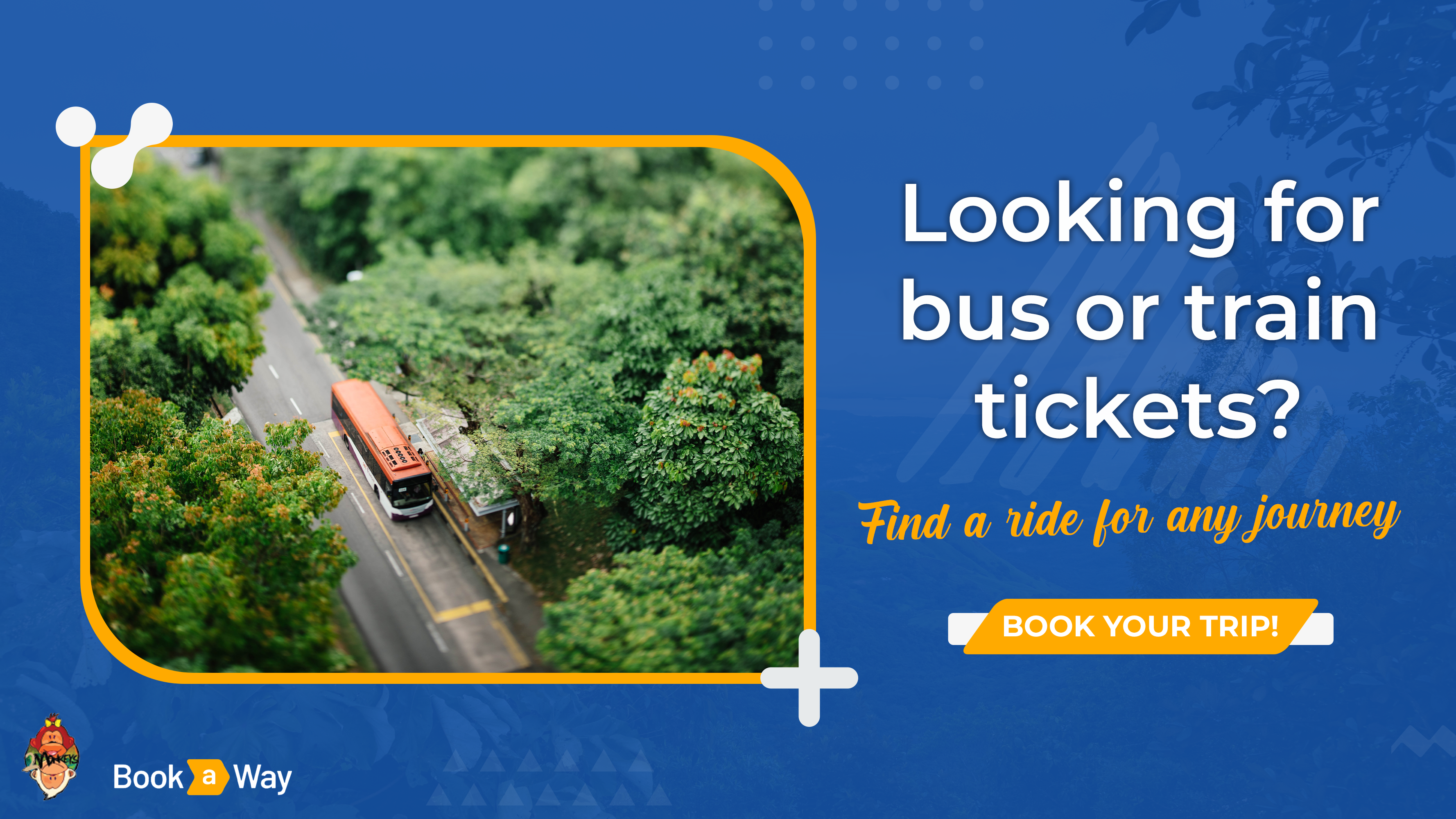
About the Writer

Leave a Reply Cancel reply
Your email address will not be published. Required fields are marked *
This site uses Akismet to reduce spam. Learn how your comment data is processed .
11 thoughts on “ 7 Best Things to Do in Hue, Vietnam [Vietnam Travel Guide] ”
this is amazing ! this is my second day raw vegan , i’m excited and motivated about this good change in my life.
Great blog, Jessica! I’m a Vietnamese born in Hue. Your blog gives a very detailed insight of the city. Apart from historical places, you can also find picturesque countryside, stunning scenery in Tam Giang Lagoon (the biggest lagoon in Southeast Asia). If you plan to come back to Hue one day, I suggest you visit hidden places in Hue that few travelers know. By the way, keep up with your awesome work! Thao Nguyen
Informative.
Great article thank you. We are in Hue now, your tips are very useful.
Another lower/mid-level, great quality homestay in Hue that I and many of my friends/family recommend staying at is Hue Homestay Riverside! Its within the Citadel walls where it’s much quieter as you’re submerged into the culture of Vietnam, yet EVERYTHING you need is seriously just a short walk/bicycle ride away–food, coffee, beer, snacks, household items/appliances, hair salons, shopping, the list goes on and on! Hue Homestay Riverside was ~$20USD/night (they offer an extended-stay discount!), includes free breakfast made just for you at whatever time in the morning you prefer, bicycles to borrow, WiFi, basic cable with some channels showing American movies, and is super clean and has a balcony off the second floor and a rooftop terrace to enjoy! The room my husband and I stayed in had its own private balcony as well. During our stay there in July 2018, they were working on a back area that looked to be some sort of “garden” space–another serene spot to enjoy life in. 😉 They do also offer to do laundry for a very small fee (~$1USD/kg) which, for us, was returned folded neatly on our bed within one day’s time. Hue Homestay Riverside is family owned–the family of three lives on-site and does everything they can to ensure your comfort! Five out of Five stars!
What a useful travel blog, thank you, Jessica. I planned to visit Hue in April and I don’t know whether getting to Hue by shuttle bus or airplane is better. I read an article and it mentioned about xic lo. How about it? Did you ever try it?
I actually enjoyed more the abandoned water park in Hue rather than the imperial city. The Imperial city makes more sense when you take a guide. Otherwise, the stones won’t tell you anything, obviously. That would be my recommendation 🙂
Safe travels, Matt
Thank you for the amazing information posted on this blog. The tour of Vietnam and Cambodia is undoubtedly on everyone’s dream list. At Citrus Holidays we have a Vietnam Tour Packages for you to choose from, all competitively priced.
Great article! I was actually looking for where to stay in Hue, La Residence looks amazing, but probably the Serene Palace fits my budget better. And also thanks for providing some of the city’s historical facts. Did you hire a guide or just figure them out by yourself?
And since you mentioned Da Nang, I was wondering if it is similar to Hoi An.. The architecture and vibe?
Hi Alexis! Da Nang is pretty different than Hoi An. Da Nang is a bit more developed and has the nicer beach these days but Hoi An has the fantastic night market and a slower city kind of feel to it. We stayed in both for about 5 days each and they have their own character and charm. The Marble Mountains are right in between the two as well!
When we went to Hue we hired a driver and he gave us some facts as we drove to each place but he didn’t come with us inside the places. We just did the research on our own about the history but took the drivers advice a bit on which places to go to, when and which places to skip. He was fantastic!
who might this driver be? 🙂 can you let us know?
COPYRIGHT DISCLAIMER: Many of the articles on Two Monkeys Travel Group are guest posts by a number of Approved Contributors and are hosted by Two Monkeys Travel Group. Approved Contributors control their own work and post freely to our site. This includes all text and images that they use within their own work. All contributors are instructed to follow internationally recognised copyright and intellectual property guidelines. Two Monkeys Travel Group takes its own responsibilities very seriously, so if you feel that any part of this work is abusive in any way, please send us an email so that we can investigate - [email protected]
DISCLOSURE: Please note that some of the links above are affiliate links. So when you make a purchase we sometimes make a small commission, at no extra cost to you. The cost to you remains the same, sometimes even cheaper if we have negotiated a special deal for our readers.We use all of the companies we have listed here and that’s why they are in this list, but of course we need to keep Two Monkeys Travel Group running as well as it can, which is exactly what you’re helping with if you do decide to buy or book something through an affiliate link! If you have any more questions about the companies we use or any other companies you’re looking at, just email us and we’ll be happy to help. Please see our full disclaimer page for more information.
Written by Two Monkeys Travel - Contributor
Two Monkeys Travel Group – Community Travel Blog is a travel blog and website. We quickly grew into a valuable source of inspiring travel stories, advice, itineraries and travel guides, with the aim of demonstrating how to live a sustainable life of travel, whilst living your own definition of success. If you'd like to contribute and write a guest post, contact us at [email protected]
11 Best Hiking Treks To Experience in Nepal
Getting the most out of your holiday in bali, 5 best things to do in canggu, bali, indonesia [diy travel guide to canggu], 10 awesome things to do in florence, italy, africa unveiled: discovering the continent’s hidden gems and iconic landmarks, related posts, honeymooners guide to bali, indonesia – tips for seminyak, ubud and uluwatu, visita iglesia in albay, philippines – 7 church in 7 days itinerary, 5 best things to do in saitama, japan [with suggested tours], previous post, 7 awesome things to do in bhutan @cheekypassports, 7 awesome things to do in shiraz, iran @ilmioiran, subscribe to our newsletter.
Receive tips on how you can live a sustainable long-term travel lifestyle!
- First Name *
- Phone This field is for validation purposes and should be left unchanged.

- Where to go
- Place to stay
- What to eat
- Thing to know
- Visas for Vietnam
Traveling to Hue for the First Time (Tips & Tricks)
The imperial capital of Hue has been the capital of a unified Vietnam since 1802 after Nguyen Anh ascended the throne opening the Nguyen Dynasty, the last feudal dynasty in Vietnamese history. Hue ended its mission as the capital of Vietnam in 1945 when the last Nguyen emperor Bao Dai abdicated. Since then, the capital of Vietnam was once again chosen as Hanoi, the ancient capital of Hue became the ancient capital. Hue is a city located on the East coast, a central city located between two big cities, Hanoi and Saigon. The two neighboring provinces of Hue are Quang Tri and Da Nang. Hai Van pass connects Hue with Da Nang and the weathered boundary of the two regions. Together with Pho, you can summarize your Hue travel experiences with information about Hue hotels and motels, places to eat, delicious dishes in Hue, tourist attractions in Hue for your reference.
Table of Contents
The History of Hue
Anyone who has been to Vietnam once must have known that the climate in Vietnam is very different. While in the South it is usually tropical, in the North it is temperate. The climate in Hue is usually hot, humid and it is a combination of the northern climate and the southern coastal region. Hue is one of the regions with many cultural heritages. Up to now, there is no other area with a large number of relics but these relics still retain their original shape as in this ancient capital.
- Top 12 most attractive destinations in Ninh Binh
- Top 10 most beautiful landscapes in Ha Giang Province
- Top 10 most beautiful tourist destinations in Binh Dinh
- Top 10 great places in Sapa you should visit
- Top 12 most attractive destinations in Long An

On the northern bank of the Perfume River is a relic of castles built in a defensive style forming an arc of 11km long. This valuable work includes more than 100 works of architecture, which has truly reflected the king’s life of the Nguyen Dynasty. Among the hills on the southern bank of the Perfume River are very beautiful tombs of Nguyen Kings. Among the most famous are the four tombs, each known with a name that matches the personality of each king and the architectural style of each. These are the majestic Gia Long Mausoleum, the majestic Minh Mang Duc tomb, and Magni Khai Dinh Tomb.

Hue is also an important center of Buddhism. In Hue and surrounding areas still exist, dozens of pagodas were built over 300 years ago and hundreds of temples and pagodas were built at the beginning of the century. In addition, Hue is also considered the origin of royal music and is home to many famous traditional dishes and fine craftsmanship.

It is the only city in the country that still retains the look of a medieval city and intact monarchy architecture. Hue has become a large and invaluable museum. Therefore, the government has ranked the monuments in the ancient capital of Hue as an extremely valuable asset and in December 1993 Hue was ranked by UNESCO as a world cultural monument.
When should travel to Hue?
If the climate of the country is divided into two seasons: dry and rainy, Hue has only two other seasons, namely the rainy season and the low rainy season. The rainy season lasts from September to the end of December, the less rainy season lasts from the end of December to around April. For the rest of the months, Hue weather is quite sunny because Hue is also in the abundant heat radiation and heat high. Tourists come to Hue at different times. If domestic tourists usually come to Hue from around early May to late September, foreign tourists come to Hue from October to the end of April. The most ideal weather in Hue is usually in November. Highlights Hue’s colorful culinary picture lows.

- Around March every year, Hue weather is still relatively cool now, it rarely rains, so you can go to Hue on this occasion, especially families with children and the elderly.
- On the occasion of April 30, Hue often organizes festival festivals with many unique cultural activities, in addition to this occasion there is also an international fireworks festival in Da Nang, you can schedule travel. Hue calendar combined with Da Nang tourism.
Guide to Hue
By private vehicles, by motorcycle.

By Public transport

Currently, from Hanoi, there are only 2 units, VietjetAir and Vietnam Airlines, operating flights to Hue, with Jetstar from Saigon in the afternoon, flight fare depending on time will be about 2,000,000 VND – 2,500,000 VND round trip from Hanoi and around 1,500,000 VND-2,000,000 VND with the afternoon from Saigon. Phu Bai Airport is about 40km from Hue city center, you can use the bus service to take passengers from the airport to the city center for about 50,000 VND / 1 person.

From the two ends of Hanoi and Saigon Station, there are 5 daily Thong Nhat trains departing for Hue according to the train timetable as below, depending on your plan, you choose the train time accordingly.

- SE1 and SE2 trains: [Hanoi 19:30 – Hue 8:48] [Saigon 19:30 – Hue 15:23]
- SE3 and SE4 trains: [Hanoi 22:00 – Hue 10:27] [Saigon 22:00 – Hue 16:39]
- SE5 and SE6 trains: [Hanoi 9:00 – Hue 22:42] [Saigon 22:00 – Hue 5:31]
- SE7 and SE8 trains: [Hanoi 6:00 – Hue 7:00 pm] [Saigon 6:00 – Hue 1:28]
- Train TN1 and TN2: [Hanoi 13:10 – Hue 3:39] [Saigon 13.10 – Hue 12:06]
In addition to the Thong Nhat trains, from Hanoi, there is the SE19 train to Da Nang, which departs from Hanoi Station at 8:00 am and arrives at Hue at around 10:00 am.
Find ways to get Hue easier with Bookaway!
By High-quality Passenger car
From Hanoi and Saigon, there are many high-quality bed buses every day to Hue, open tour buses to Hue, travel time is about 13 hours (from Hanoi) or 25 hours (from Saigon).
Transportation in Hue
Cyclo in Hue is convenient because of its wide and high roof. When needed, it can carry goods or turn on the roof to transport passengers politely and safely. Nowadays, cyclo traffic service is the most attractive and suitable in the city. Using a cyclo vehicle, you can take a built-in roll around this ancient and beautiful city.

By Bicycle / Motorbike
With the advantage of being a tourist city, you can easily find an affordable bike or motorbike. The places for renting bicycles and motorbikes are concentrated on Hung Vuong Street, the distance from Truong Tien Bridge to Hung Vuong intersection with Nguyen Tri Phuong. The second area is Le Loi Street, West Quarter opposite Huong Giang Hotel, streets like Pham Ngu Lao, Chu Van An all have car rentals.

- Vinasun: 0234 3788 788 VND
- Mai Linh: 0234 3898 989
- Sun Taxi: 0234 3989 898
Staying in Hue
If you want to find a quiet, isolated place to have moments of rest when coming to Hue, you will need to leave the central area. Some resorts are built near Thuan An and Lang Co beaches or Thanh Tan hot mineral springs area. If you stay here, you will often determine not to go anywhere because the long-distance travel, going back and forth many times is not really convenient and expensive.

Hotels in Hue
Hue now has about 600 accommodation establishments with nearly 10,000 rooms, 17,000 beds, so there is almost no room fire in Hue.
For the majority of you traveling, often the need only needs a relatively reasonable place to stay because the whole time of the day is actually on the street, with this need, 2-star hotels are quite good and suitable because the price is relatively reasonable (usually only about 300,000 VND). If you want a little bit more quality (can usually be a nicer location, more complete room amenities) you can choose from 3-star hotels.

If you come to Hue in the summer, the weather is especially sunny and quite hot, most of you will want to be indulged in cool water for entertainment now. If you do not choose hotels, resorts near the sea (but far from the center) you can choose hotels with swimming pools in Hue. After a day of hanging out, going to the hotel and swimming is not a bad idea.
Finally, if you have economic conditions, why not try to stay and experience the services of 4-star hotels, 5-star hotels in Hue? Although the cost is high, it is sure that what you get will make you extremely satisfied.
Homestay in Hue
Meeting the needs of young people, those who love to travel but do not have a large budget, the form of accommodation at a local house was born, meeting the needs of beautiful space, good service, but the price is still reasonable. Unlike the traditional form of homestay, which requires sharing with the host, the new homestay style allows tourists to enjoy private space. Most of the homestay today are apartments separate from the owner. In particular, these locations are often beautifully decorated. Normally, a standard homestay will have a beautiful small garden whereby tourists will feel familiar, close, like at home.

Sightseeing in Hue
Referring to Hue, people remember the gentle girl in purple robes and remember the city with a deep, idyllic but memorable beauty. Traveling to Hue, you will admire the ancient beauty of high-value historical sites located in Hue Citadel Complexes such as Hue Citadel, Tomb of Minh Mang, Gia Long Mausoleum, Thien Mu Pagoda, Van Temple, and School of Quoc Ho,… Let’s see the tourist destinations that cannot be missed when coming to Hue.
Tourist places in Hue
The complex of relics of the ancient capital, hue capital.

Cửu Vị Thần Công

Hue Imperial Citadel

Tử Cấm Thành

Museum of Royal Fine Arts
Museum of Royal Fine Arts is a museum at No. 3, Le Truc, Hue City. The main building of the museum is made of wood, has 128 precious wooden pillars, on the pillars are carvings of the four spirits: Long – Lân – Quy – Phụng and more than 1000 poems in Chinese characters. This building is the Long An Palace built in 1845 under the reign of Emperor Hien to the Nguyen Dynasty, the reign of Thieu Tri. Currently, the museum displays more than 300 artifacts made of gold, china, porcelain, and Hue traditional art, costumes of the Nguyen Dynasty, giving visitors an overview of Hue royal life.

Ho Tinh Tam
Tinh Tam Lake is one of the famous landscapes of the capital city, now in the territory of Thuan Thanh ward, Hue city. In the past, the lake was a section of the Kim Long River that was reconstructed, the original name was Ky Te pond. In the 3rd Minh Mang year (1822), the Nguyen dynasty mobilized up to 8,000 soldiers to participate in the renovation of the lake, turning it into a royal residence. After completion, the lake was named Tinh Tam.

Tinh Tam Lake has a rectangular area, with a circumference of nearly 1500m (354 staff of 6 meters). There are three islands on the lake, Bong Lai, Phuong Truong and Doanh Chau. Bong Lai Island, in the south of the lake, in the middle of the lake is Bong Doanh Palace, 3 rooms with 2 wings, matching roof, Hoang Luu ly tile roofing. Electricity was built on the south side, surrounded by a brick railing, in front there was Bong Doanh gate, then Bong Doanh Bridge connects the island with the southern lakeshore. To the East of Bong Doanh Palace, there is the Thuy dynasty Thanh Tam, facing east. In the west, there is Trung Luyen floor, facing west. To the north is the Hong Cu estuary and a bridge of the same name.
On Phuong Truong Island, in the middle is Nam Huan guard, facing south, 2 floors, the roof is covered with royal tile. In the south, there are Bich Tao Gate and Bich Tao Bridge. In the north of the island, there is the Tinh Tam floor, built in the north. In the east, there is Hao Nhien (changed to Nature in 1848), facing east. To the west, there is a Duong Tinh patio facing west. Between the two islands, there is Tu Dat communal house located in the middle of a system of corridors with tiled roofs of 44 rooms, connecting to Bich Tao bridge in the south and Hong Cu bridge in the north.

In the middle of Tinh Tam lake, there is Kim Oanh dyke connecting the east bank to the west bank. To the east of the dike, there is Luc Lieu bridge, 3 rooms with tiled roofs. To the south, the dyke is attached to a 56-room long corridor, in the middle is Bach Tan Bridge. To the south of the bridge, there is a barn Thanh Tuoc for the king’s boat. At the western end of the corridor is the Khuc Ta house, which is connected to another weightlifting house, Khuc Ta-Ha Phong through a small hallway erected above the water. South of this weightlifting house is Doanh Chau Island.
On the corners of Bong Lai, Phuong Truong, there are stone stacks to create imitation paints. Particularly, Doanh Chau Island is shaped like a large floating island on the lake surface. Everywhere around Bong Lai, Phuong Truong, Kim Oanh Dike, and along the lake banks are planted with willow and strange flowers. There is only one type of white lotus planted in the lake.
Tinh Tam Lake is separated from the outside by a rather high brick wall ring. Four doors have four doors: Ha Huan in the south, Dong Hy in the north, Xuan Quang in the east, and Thu Nguyet in the west.
With sophisticated architecture, but very in harmony with nature, Tinh Tam Lake is considered a typical achievement of Vietnamese landscape architecture art in the nineteenth century. The beautiful scenery of the lake created a source of inspiration and became the subject of many famous poems and poems of Nguyen kings such as Minh Mang, Thieu Tri, Tu Duc,… The most prominent is still the poem Tinh Ho Ha Hung in a series of poems praising the 20 beautiful landscapes of the Kinh land of King Thieu Tri. At the same time, this poem, along with the scenery of Tinh Tam lake, was painted in a mirror painting to hang in the palaces.
Since the late nineteenth century, due to the lack of care conditions, the architecture in the Tinh Tam lake area was gradually damaged or destroyed. In 1946, the brick wall ring surrounding the lake was demolished to construct a lower wall ring. In 1960, on the old foundation of Bong Doanh, there was a small octagonal house built to commemorate. During this restoration, a concrete bridge was built to connect Bong Lai Island with the Kim Oanh dyke,…

Phu Van Lau

Hon Chen Palace
Ngoc Tran Mountain was formerly called Huong Uyen Son, after it was renamed Ngoc Tran (meaning jade cup), people used to call it Hon Chen because it was neat and plump like a cup. Therefore, people used to call the shrine of the Holy Mother located in the middle of the mountain is Hon Chen Palace – in the area of Hai Cat village, Huong Tho ward, Huong Tra town.

Hon Chen Palace is a relic cluster consisting of about 10 different large and small structures located in the middle of Ngoc Tran mountain, facing the Huong River, hidden under tall trees. The premises of the entire relic cluster are not very large, the main architectural work is Minh Kinh Dai located in the middle; on the right are the houses of Quan Cu, Trinh Cat Vien, and Thanh Pagoda; on the left is Ngu Hanh Palace, the altar of mandarins, caves of Mr. Ho and Ngoai Canh am. Near the bank of the river, there is also Thuy Phu am. In addition, within that area, there are many altars, many small houses scattered here.
Hon Chen Palace is not only a historical relic but also a scenic spot, a unique cultural attraction that attracts thousands of visitors, especially on the occasion of the festival in March and July of the lunar calendar every year.
Thien Mu Pagoda
Thien Mu Pagoda, also known as Linh Mu Pagoda, is an ancient pagoda located on Ha Khe Hill, on the left bank of the Huong River, about 5 km west of Hue city center (Vietnam). Thien Mu pagoda was officially founded in Tan Suu year (1601), the reign of Tien Nguyen Hoang – the first Nguyen Lord in Dang Trong.

Legend has it that when Lord Nguyen Hoang came to be the retainer of Thuan Hoa and the governor of Quang Nam, he examined the terrain here to prepare for the plot to expand the business and build the mountain. While wandering the horse’s hooves along the Huong River upstream, he caught a small hill rising by the meandering blue water, so the ground was like a dragon looking back. This hill had the name Ha Khe hill.
Local people said that here at night, an old lady in red and green pants appeared on the hill, telling everyone: “Then there will be a true god who will come to set up a temple to gather spirit and make it durable lizard, for the mighty South country”. Therefore, this place is also called Thien Mu Son.
The great thought of Lord Nguyen Hoang seemed to be in tune with the will of the people. Nguyen Hoang was very happy, in 1601 built a temple on a hill, facing the Perfume River, and named it “Thien Mu”.
Tomb System in Hue
Tomb of gia long.
Gia Long Mausoleum also known as Thien Tho Lang started to be built in 1814 and was completed in 1820. The tomb is a complex of many mausoleums in the royal family. This entire mausoleum is a group of mountains with 42 hills, large and small mountains, of which Dai Thien Tho is the largest mountain chosen as the predecessor of the mausoleum and is the name of the whole group.

Minh Mang Tomb
Minh Mang mausoleum is also called Hieu mausoleum built by King Thieu Tri from 1840 to 1843 to bury his father Minh Mang. The mausoleum is located on Cam Khe mountain, near Bang Lang junction, which is the confluence of two streams Huu Trach and Ta Trach forming Huong River, 12 km far from Hue.

Mausoleum of Thieu Tri
Thieu Tri mausoleum, also known as Xuong Lang, is located in Cu Chanh village, Thuy Bang commune, Huong Thuy town. Built by King Tu Duc in 1847 to bury King Thieu Tri. Compared with the tombs of predecessors and successors, Thieu Tri’s tomb has its characteristics. This is the only mausoleum facing the Northwest, a direction rarely used in the architecture of palaces and tombs of the Nguyen Dynasty.

Tomb of Tu Duc
The tomb of Tu Duc was built by King Tu Duc himself when he was still in office, is a complex of architectural works, including the burial place of King Tu Duc located in a narrow valley of Duong Xuan Thuong village, Cu Chanh general, now it is Thuong Ba village, Thuy Xuan ward, Hue city. At the time of construction, the mausoleum was named Van Nien Co. After the Chay Voi rebellion, Tu Duc renamed it Khiem Cung. After Tu Duc’s death, the mausoleum was renamed Khiem Lang. The mausoleum has sophisticated architecture, charming landscape, and is one of the most beautiful tombs of the Nguyen Dynasty king.

Tomb of Dong Khanh
Dong Khanh mausoleum, also known as Tu Lang, is located in the middle of the countryside of Cu Si village, Duong Xuan commune in the past (now Thuong Hai village, Thuy Xuan ward, Hue city). Formerly, Dien Truy Tu was built by King Dong Khanh to worship his father, Kien Thai Vuong. When Dong Khanh got sick and suddenly died. King Thanh Thai (1889-1907) succeeded in the context of the country facing many difficulties and a depleted economy, so he could not build a formal mausoleum for Dong Khanh.

Tomb of Duc Duc
The Tomb of Duc Duc with the name of An Lang is located in Tay Nhat village, An Cuu village, formerly in Huong Thuy district, now in An Cuu ward, Hue city, less than 2 km from the city center; is the burial place of the three kings of the Nguyen Dynasty: Duc Duc, Thanh Thai, and Duy Tan. Duc Duc ascended to the throne in 1883 for 3 days when he was deposed and died. Later, his son, King Thanh Thai (ascended the throne in 1889), built a mausoleum to worship his father, named An Lang. In 1954, when King Thanh Thai died, the body was returned to the present site in the An Lang area and was worshiped at Long An temple. In 1987, the remains of King Duy Tan were buried next to Thanh Thai mausoleum.

Khai Dinh Mausoleum
Khai Dinh’s mausoleum, also known as Ung Lang, is located on the slopes of Chau Chu mountain (also known as Chau E) outside the Hue capital city is the tomb of King Khai Dinh, the 12th king of the Nguyen dynasty. The mausoleum was built in 1920 right after Khai Dinh was crowned. About the architecture of Khai Dinh Mausoleum, later people often set out the traditional architecture of the Nguyen Dynasty because of the unusual mix of East-West and Kim Co architecture, with unique ceramic mosaic artworks.

Tourist places in Hue City
Truong tien bridge.
Truong Tien Bridge, also known as Trang Tien Bridge, is a 402.60 m long bridge, consisting of 6 spans of brow-shaped steel beams, with a span of 67 m each. The width of the bridge is 6m, designed according to Gothic architecture, spanning the Perfume River. The northern bridgehead belongs to Phu Hoa ward, the southern bridgehead belongs to Phu Hoi ward; right in the middle of Hue city.

Huong River
The Perfume River has two sources. The Ta Trach source comes from the Truong Son mountain range flowing northwest through 55 majestic waterfalls, the Huu Trach source is shorter after crossing 14 dangerous waterfalls and reaching Bang Lang junction (Tuan confluence) merging with Ta Trach into the romantic Perfume River. The Huong River is 30km long (if only from Bang Lang to Thuan An estuary), the slope of the water flow is not much different from the sea surface, so the river water flows slowly. The watercolor of the Perfume River becomes greener when it crosses the foot of Ngoc Tran Mountain – Hon Chen Palace, creating a deep abyss.

The Perfume River is beautiful from the source, meandering between mountains and forests, tree hills, bringing the aroma of tropical herbs. The river slowly passed through the green, tree-shaded villages of Kim Long, Nguyet Bieu, Vi Da, Dong Ba, Gia Hoi, Cho Dinh, Nam Pho, Bao Vinh, mingling with the scent of Hue flowers. The clear blue river shimmered like jade under the sun, the Hue boats swept up and down, along with the barbaric, thoughtful, deep melody in the middle of the night. Traveling by boat to see the poetic Huong Giang, listening to the dances and folk songs of Hue in the quiet night sky is the eternal joy of many classes of tourists,…
Ngu Binh Mountain
Ngu Binh Mountain (also known as Bang Son) is 105m high, majestic and balanced. The two sides of Bang Son have two small mountains called Ta Turn Son and Huu On Son. The Nguyen Dynasty, when building the imperial capital of Hue, chose this mountain as a precursor to a massive and solid defense system and renamed it Ngu Binh.

Along with the Perfume River, Ngu Binh Mountain is the second invaluable gift of nature, blending, to create the charming beauty of Hue. For a long time, this beautiful mountain together with the green Perfume River has become a symbol of Hue nature. People used to call Hue the land of Huong river – Ngu mountain, Huong Ngu region.
Dong Ba Market
Dong Ba Market is the largest market in Hue. The market is one of the symbols of the ancient capital, with a history of more than 100 years of construction and development. The market stretches from the foot of Truong Tien Bridge to Gia Hoi bridge with a total area of 47,614 m².

Hue Pedestrian Street
Opened at the end of September 2017, the pedestrian street of Hue includes Chu Van An, Pham Ngu Lao, Vo Thi Sau Streets and operates from 18:00 on 3 weekends. At this pedestrian street, you can enjoy a variety of Hue local dishes, watch street music performances or simply sip a drink with your friends.

Hue Garden House
Hue is not only famous for its charming natural scenery but also especially attractive with the depth of cultural and spiritual beauty embedded in each architectural feature. Along with the mausoleum of thought. Ancient Imperial City, the peaceful and peaceful garden houses here make the “garden city” of Hue.

Built according to the law of “translation” and “feng shui”, Hue garden houses are a collection of an architectural system arranged in the North-South direction. Although the width is different, each house has the same overall architecture, including gate, lane, screen, rockery, shallow pool, yard, house. The gate is often built with bricks, the entrance to the alley is often planted with shady or carefully trimmed tea. The screens are also often built of bricks. After the screen was a shallow pool with rocky rocks, a large yard, and then came to the house. Around the house, there are a lot of trees and flowers all year round.

In that garden house, it is impossible not to mention the old temple house. The communal house is usually made of wood, they are elaborated with many carvings, in the linkage of the house structure, instead of crucifixion is a sophisticated dreaming technique. The communal house has many forms: one room with two wings, three rooms with two wings, five compartments and two lean-tos, a chest house,… a chest is a brief way of saying a pillar, a house with a system of wooden trusses built up according to the most specifications concentration. No matter how big, the school is also completely structured with pegs, wooden mortars for easy assembly and dismantling. The house is displayed in a collapsed mahogany, tea cabinet, hanging diaphragm, matching sentences, and furniture are arranged in harmony with each other, giving the communal house a separate spirit.
Looking at the landscape of a Hue garden house, one easily recognizes the owner’s soul and lifestyle. Hue garden houses show the harmony between human life and plants, spiritual and material life, all complement each other to create a balance in life.
Phu Cam Church
Phu Cam Cathedral is the cathedral of the Hue Archdiocese, located on Phuoc Qua hill, in Phuoc Vinh Ward, Hue city. This is one of the largest, most famous, and oldest churches in Hue. The church today is built in the style of modern architecture, designed by architect Ngo Viet Thu.

Architecturally, the church building ground is in the form of a cross, the tip towards the south, the north end. According to modern construction techniques, the church has a structure, but the decoration is still according to classical Western art. The supports are cast close to the wall, running gradually forward, soft. The four corners of each corner have three pillars extending outward, forming a large enough space to embrace the sanctuary and the altar.
The church’s heart is large, can accommodate 2,500 people attending the ceremony. There are two rows of colored mirror doors located in the upper part of the heart of the church providing light for the interior. The sanctuary is a circle with levels going up, to the top is a circle but smaller with a monolithic marble altar.
An Cuu River
An Cuu is the name of a small river, a tributary of the Perfume River, in the South of Hue Citadel. The river has many names such as Loi Nong, Phu Cam, Dai Giang, Ha Tu, and Cong Quan. The popular name in Hue is An Cuu River. The entire river is about 30km long, starting to take water from the Huong River from the end of Da Vien islet, flowing through Hue City, Huong Thuy district, and then pouring into Ha Trung Lagoon. Since the Nguyen lords chose Kim Long, and then Phu Xuan was the capital of Dang Trong, the two sides of the An Cuu river were the places of residence, garden houses of mandarins and aristocrats. However, at this time the river was still small, many sections were shallow and narrow. In Gia Long year 13 (1814), after surveying the situation and consulting the elders in Thanh Thuy commune, the king was allowed to open up the An Cuu River and build the Than Phu dam below to get water for irrigation pepper and saline washing for thousands of acres of fields in this area. In the 2nd Minh Mang year (1821), An Cuu River was renamed to Loi Nong River. The stele engraved with this name remains. In the 16th Minh Mang year (1835) when Cuu Dinh was cast, the image and name of the river were engraved in Chuong Dinh.
Beautiful temples in Hue
Tu dam pagoda.
Tu Dam Pagoda is a famous ancient temple in Hue; Currently located at 1 Su Lieu Quan street, Truong An ward, Hue city. The pagoda was painted by Zen master Minh Hoang – Tu Dung around the end of the seventeenth century, and then named An Ton (or Tong) pagoda, which means “taking the transmission of the mind as the thread”.

Tu Hieu Pagoda
Tu Hieu Pagoda or Tu Hieu Court is the name of a temple in Duong Xuan Thuong III village, Thuy Xuan ward, Hue city. The pagoda is one of the ancient temples and is a cultural and historical place of Hue’s ancient capital. Tu Hieu Pagoda is hidden in a pine forest in a hilly area of Thuy Xuan ward. The temple campus is about 8 acres wide, the front has a winding water slotting and a romantic landscape.

In front of the temple gate, there is a 3-story tower built in 1896 to be used as a place to store the spectacles according to the decree of the king. The gate of the pagoda was built in the style of a rolling arch, two floors with a roof, and right in front of the paved road to enter the main hall is a semi-circular lake with lotus planting and ornamental fish farming. The structure of the pagoda is in the style of three houses with two wings, the former is the Buddha shrine itself, the second is Quang Hieu Duong. In the back house, there is the worshiping ceremony of the capitalist Le Van Duyet with his wooden horse and sword.
The two sides of the temple courtyard have two steles to record the history of the temple’s construction. The pagoda was built in the form of a word (口), the main hall of three houses, two wings, in front of worshiping Buddha, and behind to worship the Patriarch. The backyard is Quang Hieu street, in the middle of the sanctuary, the left is to worship the Buddhist spirit at home, the right to worship the Thai bishops,… The left backyard is Ta Lac Thien (the monk’s house) and on the right is Huu Ai Nhat (guest house).
Tomb of Thai Giam of the Nguyen Dynasty in the temple grounds
Around Tu Hieu pagoda, there are also many tombs of concubines of Nguyen lords. Due to its beautiful and quiet location, not far from Hue city, this place is a place of outdoor entertainment for Hue youth on holidays and holidays. Tu Hieu Pagoda is one of the ancient temples welcoming domestic and foreign tourists, the largest in the ancient capital of Hue.
Bao Quoc Temple
Bao Quoc Pagoda is located on Ham Long hill on the old land called Thuy Loi village, close to Lich Doi hamlet. From here, looking down to the east is Dien Bien Phu Street (the road leading to Nam Giao flock), and looking north is the train station. The pagoda was founded by the Venerable Master Giac Phong, a native of Guangdong, China, in the late 17th century under the reign of King Le Du Tong and named Ham Long Tu. Then Vo Vuong Nguyen Phuc Khoat bestowed the quartet of Bao Quoc Tu in 1747. There are still gilded yellow plates and willows from that time. During the Tay Son period, the pagoda was used as a factory.

Thien Lam Pagoda
Thien Lam Pagoda was established in 1960 by Venerable Ho Nhan Nhan. Because in 1958, the Church nominated him from Tam Bao to the abbot of Tang Quang Pagoda; After a short time, he realized that the solitary practice of meditating, Tam y Nhat fetching his life by alms was not suitable here, so in 1960 he went to Thuong II village, Thuy Xuan commune, and built a small hermitage in Quang Te hill (now Thuong II Hamlet, Thuy Xuan Commune, Hue City) to practice.

Thien Lam pagoda (also known as “Standing Buddha – Reclining Buddha”) was built in 1960 by monk Ho Nhan with its original shape just a small cup. Up to now, the pagoda is a complex of many architectural works such as statues, tomb towers, Buddha towers, monks’ houses,… in many different positions.’

Different from any of the Buddhist temples of Tonkin with the three-door gate leading to the Zen garden, Thien Lam pagoda opens its door to welcome them with the Nam Tong Buddhist-style welcome gate, gentle but impressive. Entering the pagoda, at the end of the campus on the left is a tall, majestic and elegant white stupa in the sky. The stupa has 2 parts: the lower floor is the main hall; The upper floor adorns the relics of the Buddha Shakyamuni and the monks. It is a Buddhist temple in Nam Tong, but still clear in the space and architectural works of the temple. Not carrying on the thickness as the Bac Tong pagodas on the land of Hue, the pagoda “Standing Buddha – Reclining Buddha” evokes a feeling of “strange”, gentle and calm radiating from what the temple has.
Dieu De Temple
Dieu De Pagoda is located on the bank of Ho Thanh River, Hue people call it the Gia Hoi river, or Dong Ba river, now 100B Bach Dang street, near Gia Hoi bridge. Dieu De Pagoda has an important place in the history of Buddhism in Hue. The pagoda was originally the residence of King Thieu Tri before taking the throne, so it had a very beautiful landscape, spacious garden, and green trees. In 1844 the king was embellished and ordained as the National Self. The pagoda has become a famous place on the land.

Vong Canh Hill
Vong Canh Hill is a 43m high hill in the southwest of Hue city, the foothill bordering the Perfume river. It is located in the mausoleum of the Nguyen kings and opposite the Hon Chen palace established in ancient times by the opposing faction. Around seven hundred meters from Vong Canh hill are Dong Khanh mausoleum, Tu Duc mausoleum, Thieu Tri Mausoleum, Hieu Dong mausoleum (Minh Mang King Wife), Xuong Tho mausoleum (Tu Du’s wife, Thieu Tri’s wife). Tomb of Madame Thanh Cung (wife of King Dong Khanh), Tomb of Mrs. Tu Cung (wife of King Khai Dinh), Tomb of Prince Canh (son of King Gia Long),…

Standing on Vong Canh Hill, one has a panoramic view of many ancient relics and wonderful scenes in a large natural space around, especially the poetic beauty of lyrical. Huong river. The hill sits in the middle of the softest, most tender, and attractive bend of this famous, amorous, and sexy river. This is where rivers and mountains come together to create a magnificent painting space. The meaning of the place Vong Canh is like that.
Thanh Tan Mineral Spring
Discovered in 1928 by French scientists, Thanh Tan mineral spring was quickly researched and applied as a beverage to restore human health. In 1983, this water source was allowed by the Ministry of Health to be exploited as bottled drinking water. However, by the end of 2000, Thanh Tan mineral spring tourist resort became popular and known to many people. Thanh Tan mineral spring tourist area built on an area of 50 hectares. Next to the towering mountains are the adjacent created hills. The green of the mountains and trees has created a relaxing and pleasant feeling from the first minute. Thanh Tan mineral water is located thousands of meters underground, containing Calcium Sulfate and Silicium,… very good for the body. Therefore, this is a suitable destination for many tourists in the chilly weather, changing seasons.

Thanh Tan mineral water tourist area also has a spacious playground for campfire or entertainment at night. After many hours of a soaking, hungry stomach, you will be more delicious with a plate of perch raised with mineral water, deep-fried in lovely tents beside a fragrant lotus lake.
Phuoc Tich Ancient Village
Phuoc Tich ancient village is located on the border between Thua Thien Hue and Quang Tri provinces. According to history books, Phuoc Tich was founded in 1470 under Le Thanh Tong and is surrounded almost entirely by the legendary O Lau river, the river’s water is always blue, making this place almost an island. More than 500 years of existence, experiencing wars of fire and destruction of nature. Phuoc Tich still preserves almost intact the pristine beauty of Vietnamese village life with charming and peaceful landscapes, banyan trees, water wharf, communal yard.

Tam Giang Lagoon
Tam Giang is the confluence of three rivers O Lau, Bo River, and Huong River before pouring into the East Sea. Therefore, Tam Giang lagoon is “symbolic” of the ecological environment of Thua Thien – Hue in the past and present. Not a single tourist comes here, to ignore this famous place.

This is the largest wetland in Southeast Asia, the water surface is 248.7 km2 wide, from the mouth of the O Lau River in the north to the mouth of the Huong River in the south. The lagoon has had many aquatic animals for many generations, most of them in Thuan An estuary, O Lau river mouth, Bo river, Thuy Tu lagoon. Cau Hai. At present, there are 163 fish species, many rare and precious species such as sea bass and eel have been identified. Depending on the season, some fish species migrate into the lagoon to breed such as sardines, sea anchovies,… In contrast, mullet, grouper, and rabbitfish living in the lagoon migrate to the sea to spawn. All year round, fishermen catch on the lagoon about 23 species of fish with high economic value, including thick fish, goby fish, goby fish, barramundi, snapper, fish,…

The surface of the lagoon has natural vegetation, so water birds gather here, forming large bird sanctuaries at O Lau estuary, Dai Giang river mouth, and Sam lagoon. Through monitoring, 34 migratory bird species, 36 settlement bird species, especially 21 bird species are on the list of strictly protected European communities and one species listed in the Vietnam Red Book.
The lagoon facing the East Sea stretches for more than 68 km, separated from the sea only by a narrow strip of sand, through the two estuaries of Thuan An and Tu Hien. Therefore, it can self-clean the water environment and is always rushed inside by the East Sea waves, becoming a large “lung” to regulate the ecological environment for the entire Thua Thien Hue province naturally and regularly.
Dam Thuy Tu
Thuy Tu lagoon is one of three lagoons that make up the Tam Giang lagoon. Thuy Tu lagoon includes An Truyen lagoon, Thanh Lam (Sam), Ha Trung, and Thuy Tu. Thuy Tu lagoon stretches from Thuan An bridge to Con Trai over a length of 33km. The lagoon width varies from 0.5km (Thuy Tu lagoon) to 5.5km (An Truyen lagoon), on average 1.8km, the lagoon depth varies from 1 – 1.5m to 3 – 5m depending on the area. but the most common is 1.5 – 2m. The water surface area of the lagoon is up to 60km. This is a place with many beautiful scenes and famous products.
Dam Chuon is part of the system of Dam Thuy Tu. In particular, the nature of the Chuon lagoon is more wonderful in the early morning and the afternoon with colorful colors.
Dragonfly Lagoon
Dam Chuon in Phu Vang district covers an area of more than 100 hectares, located nearly 15 kilometers east of Hue city center. This is a part of the Tam Giang lagoon system with a fresh and peaceful atmosphere.

Thuan An Beach

Tile Bridge Thanh Toan
Thanh Toan tile bridge is a wooden arch bridge with a tile roof over a ditch of Thanh Thuy Chanh village, in Thuy Thanh commune, Huong Thuy Town, Thua Thien – Hue province, about 8 km southeast of Hue city. This is a wooden bridge that is classified as rare and has the highest artistic value among ancient bridges in Vietnam.

The Thanh Toan tile bridge is built in the way of “the upper house and the overseas” (above the house, under the bridge). The bridge is 43 meters long (18.75 meters), 14 meters wide (5.82 meters), divided into 7 sections, the two sides of the bridge have two rows of wooden platforms and balustrades for sitting back. The bridge is covered with a roof and tile. The first bridge built more than two centuries ago has been repeatedly damaged by storms, floods, and wars. However, after the damaged times, the commune people all repair, embellish and preserve them together.
Thien An Hill – Lake Thuy Tien
Thien An is a place of many pine-growing hills southwest of Hue city, near the tomb of King Khai Dinh. On the top of the hill, there is Thien An Monastery, around the hill area, there is Thuy Tien lake and Ba Vanh tomb, still imprinted with an old suspect. With peaceful scenery, fresh space, Thien An and Thuy Tien are quite interesting weekend getaways. Currently, this area is the entertainment center of Thua Thien Hue.

“Dăm” Stone Waterfall
“Dăm” Stone Waterfall is a small waterfall in Duong Hoa, Huong Thuy town. You can organize with family and friends to come here to have fun, take a cool bath on holidays. From the center of Hue city, there are two roads to the waterfall: one is along the road through the Ta Trach lake project; the second is going in the direction of Tuan Bridge, passing Tan Ba pier. Starting in the direction of Week Bridge, we will easily buy fresh food or some local agricultural products at the countryside market. Meet the bar during tea season, do not forget to visit some roadside orchards, enjoy the scenery while buying this specialty to bring refreshments.
The road to the waterfall is quite unspoiled, so it is very suitable for those who love adventure by motorbike, especially young people. Want to conquer the height, catch the watershed, be very prepared to not slip when walking along the cliffs; You can also have fun in the cool lake below the waterfall. The romantic one goes to pick wildflowers, look for ripe sim,… On the way to the waterfall, there is a small house of Forest Ranger Huong Thuy. The staff members will be the “locals” that provide much useful information about the people and creatures of this area. If you have difficulty in walking, looking for water,… do not hesitate to ask for help.
Huyen Khong Son Thuong
Huyen Khong Son Thuong, located in Cham village, Huong Ho ward, is a famous pagoda, a scenic spot of the ancient capital of Hue. The pagoda belongs to the Theravada Buddhist sect, was founded by Venerable Gioi Duc in 1989. The temple is located in the middle of a green, cool, year-round pine forest, birds chirping. Huyen Khong Son Thuong is located halfway up the mountain with a strange and fanciful beauty. The pagoda does not have a large Tam Quan gate, but the gate is just as ordinary as the gate of a Hue garden house. The temple campus is a green garden with small streams blooming with purple water lilies, precious orchids, porcelain trees, cedars, cypresses,… hundreds of years old, peaceful space.

Truoi Lake with an area of about 400 hectares, a reservoir capacity of up to 60 million cubic meters of water, is the largest irrigation project in Thua Thien – Hue province, to irrigate the fields of Loc Hoa and Loc Dien communes. Phu Loc district. Previously, the area of the lake was a very small Truoi dam to prevent water 50 meters high was built by Thua Thien – Hue province in 1996.

Truoi Lake tourist area is located at the foot of the majestic Bach Ma Range. Coming to Truoi Lake, visitors will see clear blue water surrounded by green mountains, charming landscapes.
Truc Lam Bach Ma Zen Monastery
Belonging to the Truc Lam Yen Tu Zen sect, Truc Lam Bach Ma is the first Zen monastery in the Central region, located at Bach Ma mountain, Truoi lake area, Loc Hoa commune, Phu Loc district, Thua Thien Hue province. At the height of 1450m, the temperature is usually from 19-21 oC, Bach Ma is considered one of the ideal climates. Truc Lam Bach Ma Monastery appeared in the heart of Truoi Lake like a flower, resting its head on the mountain of Bach Ma forest stretching to attract the eyes.

About 30 km from Hue city to the South, to Truoi land, go to Truoi Dam, cross the steep slope on the back of the hill, and a vivid water-ink picture appears. On the other side of the water, at the foot of the sacred mountain, the pavilion, the main hall, the road, the road, the staff, the bell floor, the relic tower shines down on the water mirror of Truoi lake, far away are clouds swirling around The top of the mountain creates a fantastical, pure and peaceful space.
Passing the immense river bed of Truoi lake, about fifty minutes, by small canoes, you will arrive at Truc Lam Bach Ma Monastery. Step up from the 172 steps of the three steps are the three relics of Truc Lam Bach Ma Zen Monastery. Built-in harmony in a whole body of Buddhist architecture and Truc Lam Yen Tu Zen Monastery, Truc Lam Bach Ma also has the very shrine of Buddha sitting under the bodhi tree, behind the main hall is the area. The street is dedicated to the ancestor Dat Ma of the Truc Lam sect. Truc Lam Bach Ma Zen Monastery is a scenic complex in the charming mountainous area that has become a tourist destination for tourists coming to Hue.
Bach Ma National Park
Bach Ma National Park, 60km south of Hue, at an altitude of 1,450m, is a famous resort in Vietnam. On the top of a majestic mountain in 4 green seasons with waterfalls, forest streams, is a temperate climate like SaPa, Tam Dao, Da Lat,… Bach Ma mountain is also a gathering place for many kinds of precious animals and plants. rare in the tropics.

Bach Ma Mountain is famous for its streams and many spectacular waterfalls. Do Quyen waterfall is 400m high, 20m wide. On summer days, on both sides of the waterfall, Do Quyen flowers bloom like two giant carpets of silk flowers. In the center of the resort, there is a Silver waterfall 10m high, 40m wide like a white curtain swaying in the wind.
Standing on the top of Bach Ma mountain, you can get a glimpse of the splendid panoramic view of Hai Van Pass, Tuy Van Mountain, Cau Hai Lagoon, and the shimmering electricity of Hue city at night.
Canh Duong Beach
Canh Duong is one of the beautiful beaches in Thua Thien Hue, about 60 km south of Hue city. Canh Duong beach is 8 km long, 200 m wide, arc-shaped, between the foot of May Tay and the foot of May Dong, the coast has a gentle slope, smooth white sand, clear blue seawater, and relatively windtight. conducive to the organization of various types of tourism and sports.

Lang Co beach is about 8km long, located along National Highway 1A, next to Hai Van pass and 24km from Bach Ma National Park. This is a beach with a gentle coastline, white sand, medium and large waves, the tide rises and falls according to the semi-diurnal tidal regime with a low difference (only about 0.7-0.8m), very suitable for this type. tourism image of swimming, relaxation, scuba diving, and has been identified as an ideal resort for decades. Located adjacent to Lang Co beach is Hai Van mountain – Hai Van Quan, a famous landscape of Vietnam. Along the foothills of Hai Van mountain, Lang Co beach has coral reefs, lobsters, and much high-value seafood. In that area, there is Son Cha Island (a small island), which preserves many kinds of wild fauna and flora.

Behind the beach is Lap An lagoon and Bach Ma mountain range. All of these factors give Lang Co great potential for developing many types of tourism services: resort, scuba diving, wildlife – flora and fauna, aquaculture,…
Lap An lagoon (An Cu lagoon) is located near the National Highway 1A, the section passing Lang Co town, Phu Loc district on the road connecting Da Nang to Hue. The lagoon is located in a quiet beautiful position at the foot of Phu Gia pass with a radius of 15 km2. Surrounding the lagoon is the majestic Bach Ma mountain range, in front of the lagoon is Lang Co Bay.

Cau Hai Lagoon
Cau Hai lagoon is the largest lagoon in the lagoon system of Tam Giang, with a circumference of more than 100km, located in the South – in the territory of Phu Loc district, Thua Thien Hue. To get here, you can go two ways: one is from the intersection of Phu Bai airport, follow Phu Bai – Truong Ha street towards the sea, meet NH 49B, turn right about 30km, is Tu Hien gate, that’s where capture the most beautiful Cau Hai lagoon, or follow National Highway 1A from Hue to Da Nang, to Cau Hai station area will see immediately on the left is Cau Hai lagoon. About 8km more, you will meet NH 49B again to turn left to the Tu Hien entrance.

Suoi Mo or many people still call Mo waterfall is an interesting tourist destination located in Lang Co town, Phu Loc district, about 65km from Hue city. Suoi Mo welcomes visitors with a king fresh and cool primeval forest. This is an interesting place for families who want to escape the central sun during hot days.

Hai Van Quan
In the past, Hai Van Quan was a key strategic location of Thuan Hoa – Phu Xuan – Hue in terms of military and road traffic, which was the southern gate of this land. Hai Van Quan is located at the top of a pass over a mountain range that runs across the sea from the Truong Son range. The top of Hai Van pass is 496m above sea level; 77.3km south of Hue and 28.7km north of Da Nang.

In the first “Du Chi” of our country compiled by Nguyen Trai in 1435, the author mentioned the place “Ai Van”, as a weakness on the road from Thuan Hoa to Quang Nam. And now, together with Lang Co – Bach Ma – Canh Duong, Hai Van Quan is attracting domestic and foreign tourists to visit and enjoy the majestic beauty of mountains and sea.
Mo Waterfall

Kazan Falls

Pâr Le Stream

Vietnam-Laos Border Landmark

Delicious dishes in Hue
It can be said that Hue people come to cuisine, not in a simple biological sense, but to enjoy it with both smell, sight, and hearing. Speaking as writer Nguyen Tuan when he was born, Hue people like to eat with their eyes. But even though they mobilize all their senses for nutrient absorption, the Hue people only need to “eat the fragrance for flowers”, as they often talk about themselves. That serenity can be seen on the tiny duck cake that is almost melting at the tip of the tongue, the thin rice cake leaves, the Nam Pho cake bowl arranged like colorful pictures and Con Hen corn tea. cool, but the aroma follows the dream,… Hue dishes, whether it is a delicacy or a simple folk, make someone taste so delicious once they “suck it up”, to and then forever attached to that unforgettable taste. It seems that through the skillful hands of the woman, the food has been blown into Hue’s soul and a little spirituality.
Hue especially preserves more than 1000 dishes cooked in the Hue style, including the benevolent dishes of the Nguyen Dynasty kings. The menu of dwellers has over a few dozen dishes of the delicacy of delicacy, which are carefully prepared and organized. The folk dishes are very popular among the masses with a rich menu of hundreds of dishes, cleverly prepared by Hue housewives with excellent cooking techniques, attractive flavors, and attractive colors, attaching importance to quality over quality; the art of presenting the dishes is very beautiful, the art of enjoying is exquisite. In addition, if anyone has ever enjoyed a Hue vegetarian meal (dishes made from plants), surely will never forget the pure taste of Hue dishes.
Rice with mussels is a specialty of Hue cuisine. Rice with mussel is presented in the form of cold rice mixed with mussels sauteed in oil and spices, mussel sauce, fish sauce, cabbage, greasy, grilled rice paper, crispy fried noodles, colored chili, whole-grain peanuts, cooked cooking oil, pepper, refined flavors (monosodium glutamate, MSG) and salt.

The mussel rice dish originated as a familiar dish of the people of the fishing village,… from the locality, it was called the sampan people. They live all year round on boats, floating on the river branches with low income, not much income. Fishing nets that can be found in the river like shrimp and fish,… are high-end food, often sold, while inexpensive mid-range like snails, mussels,… make the most of daily meals. Clams are almost always treatable. If you w ant to eat delicious mussel rice, you can go to Han Mac Tu street or to Con Hen, Vi Da to enjoy.
Bun Bo Hue is one of the specialties of Hue, although it is available everywhere. In Hue, this dish is simply called “beef noodle soup”. Other localities called “Hue beef vermicelli” indicate the origin of this dish. The main ingredients of the dish are vermicelli, beef, pork, and a distinctive red broth. In the broth of vermicelli, Hue people often add a little fish sauce, contributing to the unique flavor of Hue beef vermicelli pot. After the beef bone is cooked until cooked, people often add little pork pies or pureed beef rolls. Beef can be thinly sliced, dipped in boiling broth before being placed in a bowl of vermicelli (called raw beef). People often add a little chili powder and spices to the bowl of vermicelli and eat raw vegetables including bean sprouts, herbs, lettuce, baby vegetables, chopped banana corn.
Noodles are not available anywhere, but the appearance of the bun is different in each region. Hue noodles are bigger than other places. There are two types of vermicelli, the vermicelli is usually rolled into small cubes when hungry, but dipping it with garlic lemon chili sauce is great. And the vermicelli used to make pork rolls or crab vermicelli is usually larger.

Along the two sides of the road in Hue, you will immediately meet the very popular but also very delicious noodles, very crowded,… A bowl of vermicelli or vermicelli that attracts customers is thanks to the sweet and fragrant water. The vermicelli pot, a very thin flexible aluminum pot and very cleverly milled by Hue matters, looks like an old copper pot but has a deep and wide mouth. The pot is scrubbed very carefully so it is always bright white and looks very good on the eyes. Eat a bowl of steaming vermicelli, the clear white strands that stand out on it are pink-grown balls (pellets from raw rolls and crab meat), softly simmered hooves, with a hint of white stalks. The price and the green color of raw vegetables, take a little rich fat leopard juice with a little seasoning of the lemon chili fish sauce, you will find it extremely interesting, both spicy, hot, pungent, and hear the sweetness of the vermicelli juice. Of meat running slowly into the esophagus, you will certainly not forget this flavor. There was a time when eating vermicelli brought me to tears at that time to feel how deep the taste of Hue was.

Besides the shops, fixed shops on almost all the streets of Hue city, every morning you walk the streets of Hue you will see Hue girls about eighteen and twenty, shoulder to shoulder. One bun went in groups, the smoke floated away, laughing happily. That was a Hue girl selling vermicelli to customers all over the city. Each person has each look and each flavor, but all Hue and Hue are from vermicelli, from aluminum pots, from fast and smooth gait, and no matter how difficult you are, you will be satisfied when Enjoy a very popular noodle bowl, very cheap, but sometimes very delicious.
If you want to enjoy authentic Hue beef noodles, you should go to the area of Chi Lang Street intersecting with Nguyen Du. There are some famous beef noodle shops here such as O Lieu beef noodle soup, Mu Drop beef noodle soup, Ba Phung beef noodle soup,…
The Typical Cakes of Hue
The Banh Beo consists of three main parts: the cake made from rice flour, the filling to sprinkle on the cake made with pureed shrimp, and the sauce, a mixture where fish sauce is the main ingredient and often poured directly into the cake without dipping. . The auxiliary ingredients of the Banh Beo are usually onion fat, crushed roasted peanuts. Depending on the locality, there are different ways to add or remove this cake, for example, in Saigon, they often leave green beans, sour food, and serve them with molded cakes, small cakes, and filtered flour cakes.

In the Central region, Banh Beo is often divided into two types: Quang Nam Banh Beo and Hue Banh Beo. Quang Nam water fern cake is usually big, thick, served with a paste made of dough including meat, minced shrimp, chives, when eaten with a little scallion, minced chili. Hue Banh Beo is a little different, the cake is thinner, has dried shrimp powder, when eaten with crispy pork skin.
Banh Bot Loc
Tapioca cake is a type of cake from tapioca, filtered for starch, then boiled a small amount of flour, stuffed thoroughly, and made cakes. The filling is usually made of shrimp mixed with spices, can be made with lean pork, or a mixture of shrimp – pork. After being squeezed into the cake, the cake is wrapped in banana leaves (or may not be wrapped) and steamed. This is a popular dish in the North Central provinces and especially Hue.

Banh Nam is a type of cake and typical traditional cuisine of Hue, along with Banh Beo, banh mi. This is a cake made from rice flour that is both delicious and healthy (the elderly, children, and sick people can eat it). full moon day, the first day. In particular, there are rice cakes filled with toad meat, for stunted and malnourished children, as delicious and attractive as shrimp cakes.

Banh Ram It
In Hue, there is a kind of cake that combines two different types of cakes, which are crispy and sticky, but not greasy because it is dipped with sweet and sour fish sauce, which is a little ram. It seems that ramen cake and little cake are two kinds of cakes that do not mix with each other, but through the talented hands of a Hue woman, little ramen has become a folk dish of Hue known to tourists from near and far.

The little ram has two distinct parts: the ram and the little cake. Although the cooking method is different, both parts are made from sticky rice. Sticky rice cakes must be delicious, white, and sticky rice. The glutinous rice is pureed into a powder, mixed with salt, and warm water slowly little by little. Use your hand to knead the dough until it forms a smooth, soft, but not flaky mass, and squeeze it into small balls the size of two fingers. Shrimps whole, chopped bacon, seasoned with sugar, delicious fish sauce, pepper, minced purple onion, add a little oil or fat, simmer for 15 minutes. Rub some cooking oil into your hands, press each dough into a flat shape, take a spoon to scoop the prawns and put them in the middle, and then round them up. Put the cake sparingly in the tray, steam for about 10 minutes after the water boils. The cake is soft and white. Take out the rice cake to cool, cover with banana leaves to prevent the cake from drying, but remember not to cover it to make it sour. Different from cakes, when battering with ramen dough a little less water to make the dough a bit hard. The ramie does not need to be filled, the cake is fried in a greasy pan until it is crispy and dark yellow. Take out the cake and leave it on the absorbent paper to drain the oil. Place a little cake on top of the ram, use the ballast to thin it out, and squeeze it into the ram.
When presenting the plate, the Hue people usually put the little white cake on top and then add a layer of burnt yellow shrimp powder that looks so attractive. The unique feature of the little ram cake is dotted with sweet and sour fish sauce, specially prepared, not too salty, or too sweet, adding the spicy taste of Hue chili slices. The combination of the crispy taste of the ram with the aroma, the softness of the cake, and the sweet and savory taste of the fish sauce has satisfied many diners.
Banh Khoai is poured with ground rice flour blended with water and egg yolk, then added pepper, onion, fish sauce, salt, peeled shrimp, sliced grilled beef (or bird), chopped fat, and raw meat bean sprouts. The cake mold is made of round cast iron, the size of two child’s hands with handles. When customers are eating, the restaurant will set the mold on the bakery. Scoop a scoop of egg powder into the grease hot mold. The sound of the dough and the fat is seductive, the flour is ripe, then pick up a piece of roast beef, a small slice of fat, a few shrimp, put in half of the cake, use chopsticks to turn the rest upside downturn the cake into a semicircle, turn the cake to both sides, then place the plate.

The cake is delicious partly thanks to the broth, a sauce that only good chefs can make. This is the heirloom secret, determining the quality, creating the premium taste of the cake. Hue broth is carefully processed with dozens of ingredients such as semolina, pork liver, sesame (sesame), roasted peanuts,… Thuong Tu restaurant has existed for nearly three or four decades and has become a culinary culture. Hue, captivating tourists, is familiar with the Co Do like mussel rice, the bell of Thien Mu pagoda, the boat of the Perfume River.
Banh Uot Thit Nuong Kim Long
The wet cake is a type of rice paper made with rice flour mixed with filter flour, coated thinner, and used immediately (should be called wet cake, not dried like rice paper). Grilled meat is usually thinly sliced bacon, marinated with pepper, onions, fish sauce, five flavors, and sesame (sesame). After a few hours, the meat is marinated and grilled on a red charcoal stove until it is fully cooked and aromatic. Take this barbecue sandwiched with herbs, bean sprouts, lettuce as a filling to roll wet cake (This dish is almost similar to the style of noodle roll in Hanoi, but in Hanoi is rolled with beef).

The delicious and attractive Kim Long barbecue wet cake is thanks to its special dipping sauce, which is processed by the owners from pure fish sauce, sugar, lemon, garlic, chili,… as a secret passed down generations. Thanks to the unique flavor of the sauce that Kim Long’s popular dish is known to many tourists, it adds a highlight to the colorful culinary picture of Hue.
With such a unique taste, if you have the opportunity to come to Hue, on the way to visit Linh Mu Pagoda by car or boat, do not forget to stop by Kim Long to enjoy this dish rich in the flavor of this homeland.
Bun Thit Nuong
Hue grilled pork noodles served with cucumber, pickles, raw vegetables, roasted peanuts, scallions,… All are put in a bowl and poured broth. Looking at the bowl of vermicelli you will be conquered immediately by many colors, when you eat, you can feel a lot of flavors at the same time such as the gentle sweetness, the greasy taste of peanuts, sesame, the fresh and sour taste of vegetables, or spicy chili,… A harmonious combination of color and flavor.

Coming to Hue without eating spring rolls is very regrettable. The attraction of this famous Hue dish probably comes from a piece of spring rolls that are marinated with a special recipe and then after baking over fragrant embers and broth is made from dozens of originals. Various ingredients such as cooking oil, pork liver, rice powder, sugar, fish sauce, cinnamon chi, anise, and coconut milk. Golden grilled spring rolls with raw vegetables, star fruit, bean sprouts, pineapples, thin sliced green banana slices, and broth are nothing more delicious.

Vegetarian Dishes in Hue
According to incomplete statistics, there are 125 vegetarian dishes in Hue, which shows the richness and diversity of the cuisine of this Kinh land. Hue cuisine has many different styles, divided into many categories such as Royal cuisine, folk cuisine,… In which there is a quite special culinary style here that is Vegetarian Cuisine. The reason that vegetarian cuisine is very developed in Hue is that it is the cultural center of Buddhism in the country.

Hue people believe that vegetarianism is benign and calm, so everyone wants to be vegetarian to maintain their freshness mentally. At first, vegetarianism was limited to the Buddhist temples or families, but today it is no longer the “heritage” of the temple, it has spread to folklore and become. a tourism product. In the process of economic integration and development, Hue has many changes, but the vegetarian custom is still circulated and widely popular among most Hue residents.
Banh Canh Hue
Banh Canh Hue is cooked in flour with fish and pork skin, or with minced meat and pellets,… The process is simple and quick: the broth is boiled in a pot, the dough is finished rolling around a round aluminum tube. cutting board. Use a knife to cut into small pieces, and fall into a pot of hot water. When the dough is just cooked, take it out in a bowl, make a broth with chopped pork, fish and onions, add seasoning and eat it hot.

Nam Pho village, Phu Thuong commune, Phu Vang, about 6km from the center of Hue city, has a profession of selling traditional soup porridge. Although it is also a Banh Canh porridge, it’s completely different from the new generation of Banh Canh. Therefore, if you do not know, it is easy for tourists to get confused,… Starting from Nam Pho, going to Vy Da, going to Dong Ba market, going to Thanh Noi,… The Banh Canh line also sold banh mi, little cake, Banh Nam, etc., which are Hue specialty cakes. Nam Pho is a traditional soup made from rice flour (in the past there was no flour), only crushed shrimp to mix eggs. The soup bowl is flat, the broth is clear and thick, and fragrant,…
Types of tea Hue
Hue is not only attracted by the serene beauty and moss of the temples and mausoleums but when coming here, visitors are also attracted by the richest and most diverse culinary treasure of Vietnam. In which, Hue tea is considered the “heart” dish of many tourists when coming to the ancient capital.
Across the alleys in Hue city, walking a few hundred steps, you found a teabag. And although it is a bag of unnamed seaweed tea, the delicacy, and ingenuity of the smooth, smooth taro teacups, soft filter powder, fragrant corn teacups with a sweet and young sweet taste,… generic by the name of Hue tea that we eat anywhere else.
There will never be enough stomach to taste all the delicious flavors in the Hue tea menu. Because if only the royal tea has up to 36 types, each has its flavor. If you like sweet and fragrant flavors, you can choose lotus seed tea, green bean tea, and if you like fruit, pineapple green tea, pomegranate tea, mulberry tea, and chamomile tea are great choices.
You can enjoy typical tea dishes of Hue at Dong Ba Market, Alley Tea Shop (Hung Vuong Street), with filtered powdered tea wrapped with roasted meat can be eaten at Mo Ton Dich (Thuong Bac Park, Dinh Tien Hoang – Tran Hung Dao intersection, the shop only sells from 4:00 pm), corn tea can be enjoyed at Con Hen.
Chè bột lọc heo quay
Powdered tea is in the form of small round pellets, made of flour, when boiled, the powder is from opaque white to clear white, served with sugar water and this is a tea that is always eaten cold or warm. eat cold. Roast meat filter tea is made from pieces of roasted pork, cut square with small dice (including pork skin, meat) covered with glutinous powder, and then poured into sugar to boil into tea. This tea has both a sweet and salty taste, so it is not greasy to eat.

In Hue, there is a delicious Con Hen corn tea that is not available anywhere. This land has an alluvial ground of several tens of hectares, where people grow corn almost all year round. Corn in Con Hen is delicious because it is grown on a thick alluvial layer that is deposited through each flood.

Chè Hạt Sen
Is a highly refined tea, processed from lotus seeds in Tinh Tam lake. Lotus tea cooked in Hue style is steamed, then cooked with white sugar or clear rock sugar until it boils gently. The sweetness of the sugar is enough to penetrate the lotus seeds and go out to the kitchen. To have a delicious teapot, the cook has to keep watch for the fire to burn just right, stirring, mixing gently, time is just enough for the lotus seeds “not old, not young”. When cooking, lotus seeds will lose their natural aroma. Young cooking, the lotus scent will not radiate.

Chè Khoai Tía
This dish is favored by many guests for its color and taste. The tea is cooked from purple taro, then cooked with coconut water, and let it simmer until it matches. Add the sugar just enough, but not to lose the coconut flavor. Tea is fragrant and sweet.

These are also types of tea originating in Hue for a long time. The tea is cooked softly but still has the beans intact. Soft tea adds crushed roasted peanuts and coconut water. Coconut milk is added later to increase the fat taste of tea, roasted peanuts with a subtle aroma.

Banh Chung Nhat Le
This is a famous dish in Hue and originated from Nhat Le Street in Noi City, where dozens of bakeries are gathered. The cake is fragrant, delicious, and delicious due to the delicate combination of bean paste, meat (fat and lean) with glutinous rice, and spices such as pepper, or onions.

Five-color cake (Bánh In)
Five-color cake, also known as “Banh In”, this family has many types: bamboo shoot cake, glutinous rice cake, fluorescent flour cake, green bean cake, lotus cake,… each cake has the same type of flour as its name suggests. it. The cake is wrapped in mirror paper of all colors but has specific regulations, for example, the green color is hopefully green bean cake, the yellow color is a glutinous cake,… and pressed, the face of the cake is difficult to carve. Tho, Phuc, Loc shapes and wrapped in five-color paper. This is a type of cake to use on Tet, for worshiping and hospitality. Due to its low value, many people prefer it.

Currently, in Hue, there are two famous bakery shops: Hong Phuc shop on Phan Dang Luu Street, Ba Bon shop on Nguyen Thien Thuat Street, especially on the full moon day, the first day of Bao Thanh bakery on Tran Hung street. Dao also sells this kind of cake.
Hue specialties bought as gifts
Hue sour shrimp.
Sour shrimp in the right “tune” must be made from very fresh brackish shrimp, especially the shrimp brought up from Cau Hai. Choose shrimp that are even and relatively large. Shrimps are head off, washed, soaked for a while in alcohol. Then take out and drain, mix well with the additives: galangal, garlic, red pepper, young bamboo shoots, sticky rice, delicious fish sauce. In the additives, galangal plays the most important role, so it must be used more than all. Thinly sliced garlic, sliced chili, long and thin-sliced, separately, and sliced bamboo shoots. Shrimp is best incubated in a ceramic jar. When ripe, bring it together with a little honey. Can add a little galangal and then put it into glass jars or plastic jars. So in a jar of sour shrimp, we see all the colors: white, yellow, pink, red; All kinds of flavors: sweet, fatty, nutty, spicy, sour, bitter, hot, and cool, meaning both positive and negative. All blended to create a seductive fragrance. The incubation process lasts from 7-10 days, but must be kept in a clean, cool room. If more sophisticated, one can bury it in the ground to keep a constant temperature for the fermentation process. The more stable the temperature, the more fragrant and sweet the shrimp are.

Sesame is a marshmallow, made from malt mixed with peanut oil (oil from peanuts), with sesame covered around the candy, cut into small squares (cellophane bags) wrapped in a box. Sesame candy is one of the specialties that has become a cultural symbol of Hue.

Festival in Hue
Thua Thien Hue is a land with cultural traditions, although not as old as in the North, but also has more than 700 years of history. Since the Nguyen Lord placed the capital here until the end of the Nguyen Dynasty (1945), it can be said that Hue is the gathering place of great cultural activists, a meeting place of East and West ideological flows. antique needle. Hue culture has traditionally poured in from the North, according to the people who settled in the new land. Here still exist the Cham people with Indian culture. And later Western culture also had the opportunity to penetrate the Nguyen Lords. The traditional festivals are maintained and developed from those cultural sources.

Festivals of all kinds are a need for cultural activities of Thua Thien Hue People has become a tradition. An overview of the festival and the festival participation of the residents of this region, we will see that the festival in Thua Thien Hue is not as rich as the North, but also quite diverse, there are two types of festivals: bow festival family and folk festivals. The royal festival reflected the ritual activities of the Nguyen Dynasty, mostly focusing on “ceremony” rather than “festival”. Folk festivals include a variety of types, including some typical festivals as follows: Hue Nam Festival (Hon Chen Palace), also known as the procession of the goddess Thien YA Na according to people’s beliefs. In the old Cham Pa, the festival commemorates the births of traditional professions, the festival commemorates the ancestors of the village. During ceremonial occasions, many useful cultural activities such as boat racing, tug of war, wrestling,… are also organized and attract a lot of viewers.
Some tourism schedules of Hue
Tour: hue – da nang – hoi an.
The itinerary will be arranged from the starting date in Hue, depending on where you live, you actively plan to get to Hue on time. This schedule is suitable for renting a motorbike in Hue to run by many places. You can cut the schedule to better fit your plan.
Day 1: Discover the Imperial Citadel of Hue
Wake up around the hotel to find out if there are any vermicelli, make a bowl for breakfast, make a cup of coffee and start exploring Hue. From the hotel, rent a cyclo pass through Truong Tien bridge to Hue imperial city.
Buy a ticket to explore the inner city, because the area is quite large, it may take a few hours or an entire morning to fully explore the citadel. After finishing, go out to find some famous restaurants to enjoy delicious food in Hue. Near the royal citadel, there is Lac Thien restaurant, which is quite famous for Thuong Tu’s delicious cake.
Early in the afternoon, from the center of Hue city, you rent a motorbike to go to Thien Mu pagoda, the road running along the Perfume River is very cool and beautiful. Spend about 1 hour to visit and take pictures at the pagoda, from here running another ten kilometers, you will reach Huyen Khong Son Thuong, a temple located on the mountain with a very beautiful landscape. From Huyen Khong, Son Thuong comes back to Hue to go through some garden houses, if you are interested, you can visit.
In the evening, go back to the center of Hue city, enjoy the typical cakes of Hue. If you go on weekends, you can walk around the night market, drink beer, and listen to music.
Day 2 : Tam Giang Lagoon – Phu Cam Church – Thanh Toan Ngoi Bridge
Get up for breakfast, drink coffee and depart for Tam Giang Lagoon. This place is more than 30km from the center of Hue city, at noon stay to eat at restaurants on the lagoon, rest, and then return to Hue in the afternoon.
In the afternoon, back to the center of Hue city, visit Phu Cam church, and then go to Thanh Toan tile bridge. These are two beautiful places in Hue, not too far away so it is completely possible to go in one afternoon.
Day 3: Bach Ma – Lang Co
This day, You will go to Bach Ma, Lang Co, but the journey is quite far, so you need to go early to return to the center of Hue city.
Get up for breakfast, depart in the direction of NH1A towards Da Nang, when you reach the section near Da Bac, turn to Ho Truoi, here you need to take another boat trip to reach Truc Lam Bach Ma Monastery. The monastery is quite beautiful with its back leaning on the Bach Ma mountain range, face down towards Truoi Lake.
After exploring the Zen Monastery, return to the direction of NH1A to go to Bach Ma National Park, on the way go through Cau Hai lagoon, the largest lagoon in the Tam Giang lagoon system.
Afternoon back to Hue to rest.
Day 4: Hue – Da Nang
From Hue to Da Nang you can go by car or train, all the time is only about 3 hours. However, if you want to admire the wonderful scenery of Lang Co Bay and the beautiful beaches of Da Nang, choose the train option. The train departs from Hue around 10:30 and arrives at Đa Nang at 13:30, you can buy train tickets online and go straight to the station to print tickets on the train.
Day 5 ++: Depending on your time, you arrange to explore Da Nang, or explore Hoi An accordingly.
Related Article: Traveling experience in Ban Gioc Waterfall that tourist should know
Let start your trip to Hue with us! If you have any feedback or need help, please send an email through [email protected] !
Noted : All information and pictures are collected!
One thought on “ Traveling to Hue for the First Time (Tips & Tricks) ”
Trả lời Hủy
Email của bạn sẽ không được hiển thị công khai. Các trường bắt buộc được đánh dấu *
Bình luận *
Lưu tên của tôi, email, và trang web trong trình duyệt này cho lần bình luận kế tiếp của tôi.
- StumbleUpon
Pin It on Pinterest
Winter is here! Check out the winter wonderlands at these 5 amazing winter destinations in Montana
- Travel Guide
- Food Travel
Hidden Gems: 10 Must-Try Bún Bò Huế Spots In Ho Chi Minh City
Published: August 29, 2024
by Idette Nugent
Looking for the best Bún Bò Huế in Ho Chi Minh City? This Vietnamese dish, known for its spicy broth and tender beef, is a must-try for any food lover. While Pho often steals the spotlight, Bún Bò Huế offers a unique flavor that shouldn't be missed. From street vendors to cozy restaurants, the city has countless spots where you can enjoy this delicious soup. Whether you're a local or a tourist, finding the perfect bowl can be a fun adventure. Ready to dive into the world of Bún Bò Huế ? Here are ten places you absolutely need to check out.
What Makes Bún Bò Huế Special?
Bún Bò Huế is a Vietnamese soup with a rich, spicy broth, thick rice noodles, and tender beef. It's a dish that captures the essence of Vietnamese cuisine. If you're in Ho Chi Minh City, these spots are a must-try.
Best Bún Bò Huế Spots in District 1
District 1 is the heart of Ho Chi Minh City, bustling with energy and flavor. Here are some top places to enjoy Bún Bò Huế.
Bún Bò Huế 3A3 Located on Nguyen Thi Minh Khai Street, this spot is famous for its flavorful broth and generous portions of beef.
Bún Bò Huế Dong Ba Situated on Mac Dinh Chi Street, this restaurant offers a traditional take on the dish with a spicy kick.
Bún Bò Huế An Hoa Found on Le Thanh Ton Street, this place is known for its clean, cozy atmosphere and delicious soup.
Hidden Gems in District 3
District 3 offers a more local vibe, with plenty of hidden gems waiting to be discovered.
Bún Bò Huế Xưa Nestled on Vo Van Tan Street, this spot serves a broth that's both rich and aromatic.
Bún Bò Huế O Sen Located on Nguyen Dinh Chieu Street, this restaurant is a favorite among locals for its authentic flavors.
Bún Bò Huế Co Ba Found on Cach Mang Thang Tam Street, this place offers a hearty bowl of soup with a generous amount of beef and herbs.
Must-Try Spots in District 5
District 5, also known as Chinatown, is a melting pot of cultures and flavors. Here are some must-try spots.
Bún Bò Huế Kim Chau Located on Tran Hung Dao Street, this spot is known for its spicy broth and tender beef slices.
Bún Bò Huế 44 Situated on Nguyen Trai Street, this restaurant offers a unique twist on the traditional dish with added seafood.
Unique Finds in District 10
District 10 is a bustling area with many food stalls and restaurants. Here are some unique finds.
Bún Bò Huế 65 Found on Ba Thang Hai Street, this spot is famous for its flavorful broth and fresh ingredients.
Bún Bò Huế 19 Located on Su Van Hanh Street, this place offers a rich, spicy broth with tender beef and pork.
Each of these spots offers a unique take on Bún Bò Huế, making them worth a visit. Enjoy exploring the flavors of Ho Chi Minh City!
Savoring the Best Bún Bò Huế in Ho Chi Minh City
Exploring Bún Bò Huế spots in Ho Chi Minh City offers a delicious adventure. Each place has its own unique twist on this classic dish. From rich broths to tender beef, these eateries showcase the best of Vietnamese cuisine. Trying different spots lets you experience the variety and depth of flavors that make Bún Bò Huế special.
Whether you're a local or a visitor, these hidden gems are worth seeking out. They provide not just a meal but a taste of the city's culinary heritage. So, grab your chopsticks and get ready to enjoy some of the best Bún Bò Huế in town. Your taste buds will thank you for the journey. Happy eating!

- Privacy Overview
- Strictly Necessary Cookies
This website uses cookies so that we can provide you with the best user experience possible. Cookie information is stored in your browser and performs functions such as recognising you when you return to our website and helping our team to understand which sections of the website you find most interesting and useful.
Strictly Necessary Cookie should be enabled at all times so that we can save your preferences for cookie settings.
If you disable this cookie, we will not be able to save your preferences. This means that every time you visit this website you will need to enable or disable cookies again.
- Skip to primary navigation
- Skip to main content
- Skip to primary sidebar
Food Faith Fitness
Nourishing your body, mind and soul
Bún bò Huế (Spicy Vietnamese Beef Noodle Soup)
Share this post
Travel to Vietnam for a spicy, soul-warming bowl of Bún Bò Huế Soup .

Table of Contents
Do you ever feel like you’re caught in an all-too-predictable routine of dinner recipes? There’s nothing wrong with gravitating to easy, comforting meals, but sometimes this can get a bit boring. In these situations, it helps to bring in something bold and exotic to break you out of a monotonous mold.
For instance, if you’re unfamiliar with Vietnamese cooking, why not bring some bún bò Huế into your life? This beef and noodle soup is a classic in its home nation, but it may be your first introduction to Vietnam’s rich culinary legacy. Plus, since bún bò Huế shares some similarities with a hearty beef stew, it’s easy to ease into a new world of flavors.
And if you aren’t too daring with your dinners, please don’t worry! I’m going to leave out some traditional ingredients that may be a bit too hard to find or tough to stomach… like coagulated pork blood.
So, if you’re looking for a filling, comforting, and spicy version of beef and noodle soup, bún bò Huế may be calling your name!
Is Bún bò Huế Healthy?
Bún bò Huế certainly has a lot of protein from the meat and some nutrients from spices and herbs like garlic and cilantro, but is it healthy? Well, there are a few features that may put some health-conscious foodies off when considering this recipe. For instance, beef shanks and brisket have quite a bit of saturated fat, and there’s a considerable amount of sodium in ingredients like fish sauce.
If you’re concerned about the less healthy aspects of bún bò Huế, there are a few simple swaps to consider. First, you could use leaner cuts of beef or opt for pork loin or pork tenderloin to reduce fat content. While not traditional, you could also cut the beef and add leaner proteins like tofu. When making this recipe, it’s also a good idea to look for a low-sodium version of fish sauce. If no low-sodium fish sauces are available, consider swapping with a low-sodium soy sauce or liquid aminos.
How is Bún bò Huế different from Phở?
Foodies “in the know” are probably already aware of phở, but for those unfamiliar with this word, phở is another staple soup in Vietnamese cuisine. Since these recipes hail from Vietnam and incorporate similar ingredients into their broths, it’s easy to see why people frequently ask what makes these soups different.
The simple answer is that phở is a milder and fragrant soup, while bún bò Huế has a bold and spicy broth. Phở also distinguishes itself from bún bò Huế by using thinner rice noodles and featuring the spice star anise as a significant player. While both of these soups often use beef as their primary protein, it’s more common to find bún bò Huế recipes with some pork.
So, if you’re still interested in trying Vietnamese cuisine but are a bit scared off by bún bò Huế’s spiciness, Phở may be the way to go!
INGREDIENTS
- 2 pounds beef shank
- 1 pound beef brisket
- 10 cups water
- 4 stalks lemongrass, bruised
- 1 large onion, quartered
- 2 tablespoons fish sauce
- 1 tablespoon sugar
- 1 teaspoon salt
- 2 tablespoons annatto seed oil
- 1 tablespoon minced garlic
- 1 tablespoon minced lemongrass
- 1 teaspoon chili flakes
- 14 ounces thick rice vermicelli noodles
- 1 bunch fresh cilantro, chopped
- 1 bunch green onions, thinly sliced
- 1 lime, cut into wedges
- Bean sprouts, for garnish
- Fresh Thai basil leaves, for garnish

INSTRUCTIONS
Boil beef, then simmer with spices.
Sauté aromatics and add to broth.
Combine noodles, beef, broth, and garnishes.

FAQs & Tips
If you’d like to get your bún bò Huế ready ahead of time, it’s perfectly safe to put it in the fridge or freezer in airtight containers. However, for the best texture, please cook the noodles fresh just before you’re ready to serve. The broth and meat in bún bò Huế typically last 3 days in the fridge and 3 months in the freezer.
There’s no way to rush cooking tender meat in bún bò Huế. At a minimum, you need to heat this meat for a few hours to ensure it reaches a “butter knife” texture that’ll melt in your mouth. A few other tips you could try include scoring your meat and marinating it well beforehand with salty ingredients like fish sauce.
Yes, bún bò Huế is a fiery recipe from Central Vietnam, named after the city of Huế. You’ll feel some heat thanks to ingredients like the chili flakes. Of course, you could opt to remove these spices from your recipe, but it won’t be authentic bún bò Huế.

Serving Suggestions
One easy way to add an extra dimension of flavor to your bún bò Huế is to sprinkle some crispy onions or shallots as a garnish, to add extra crunch to the marvelous meat. For sides, consider Roasted Veggies or a Kale Salad which are always great options (and great ways to add extra nutrition to this meal). However, if you’d like something more substantial — and you still want to pay homage to Vietnamese cuisine — consider trying out a recipe for Vietnamese Spring Rolls !

Ingredients
- 2 pounds beef shank
- 1 pound beef brisket
- 10 cups water
- 4 stalks lemongrass bruised
- 1 large onion quartered
- 2 tablespoons fish sauce
- 1 tablespoon sugar
- 1 teaspoon salt
- 2 tablespoons annatto seed oil
- 1 tablespoon minced garlic
- 1 tablespoon minced lemongrass
- 1 teaspoon chili flakes
- 14 ounces thick rice vermicelli noodles
- 1 bunch fresh cilantro chopped
- 1 bunch green onions thinly sliced
- 1 lime cut into wedges
- Bean sprouts for garnish
- Fresh Thai basil leaves for garnish
Instructions

Nutrition Info:
Nutrition Disclaimer
Recipes written and produced on Food Faith Fitness are for informational purposes only.

About Eric Esposito
Freelance online writer and amaetur at-home chef always on the hunt for new recipe inspiration.
You May Also Like

Reader Interactions
Leave a comment cancel reply.
Have a question? Use the form below to submit your question or comment. I love hearing from you and seeing what you made!

Rate This Recipe
Let us know what you thought of this recipe:
Or write in your own words:
672 Wine Club
- Motorcycles
- Car of the Month
- Destinations
- Men’s Fashion
- Watch Collector
- Art & Collectibles
- Vacation Homes
- Celebrity Homes
- New Construction
- Home Design
- Electronics
- Fine Dining
- Benchmark Wines
- Brian Fox Art
- Chase United
- Disneyland Resort
- Gateway Bronco
- Royal Salute
- Sports & Leisure
- Health & Wellness
- Best of the Best
- The Ultimate Gift Guide
- Why Iceland Is Making Some of the Best Skin Care and Colognes You Can Buy
From highly concentrated anti-aging serums to a fragrance house backed by a member of Sigur Rós, the nation's homegrown grooming concerns are going global.
Austa somvichian-clausen, austa somvichian-clausen's most recent stories.
- How Lava Rock Diffusers Became the Coolest Way to Make Your Space Smell Amazing
- Robb Recommends: The Summery Fragrance That Smells Like a Fresh Sheet of Paper—in a Good Way
- Share This Article

Related Stories
- Meet Véronique Nichanian, the Woman Behind the Hermès Man
- Lab-Grown Diamond Prices Are Falling. Here’s Why That’s Not a Bad Thing.
Inside the Old-School N.Y.C. Apothecaries Selling High-End Skin Care, Prescriptions, and More
“Iceland’s landscape is exceptional,” says Lilja Fischersund, co-founder of Icelandic apothecary, Fischersund . “The air here is crisp, and the light changes with the seasons, creating an ever-shifting canvas of colors and moods. The natural ingredients we use are a reflection of this environment.”

“Jonsi started experimenting with scents while he was on tour with Sigur Rós, and he noticed the similarities between music and scent—how both can evoke powerful memories,” says Lilja, his sister and business partner. “Our perfumery is now based in the heart of Reykjavik, in the very house where Jonsi’s music studio was just six years ago. Fischersund has become a project where we, as siblings, can each bring our unique artistic sensibilities together. Even our mom and dad are involved, making it a true family endeavor.”
“Our signature fragrances draw from these elements. For instance, our scent No. 101 is inspired by the essence of an Icelandic summer,” Lilja says. “During this short but intense season, plants harness the 24-hour daylight to grow strong and resilient. You’ll find chervil and Arctic angelica sprouting between sidewalks and near houses.”
Part of the brand’s appeal is its ability to draw inspiration not only from the beauty of Iceland, but also from the olfactory power of nostalgia, as Lilja alludes to while speaking about the collective energy of a summer spent in downtown Reykjavik. She tells Robb Report that their fragrances are meant to go beyond scent. “They’re meant to forge a deeper connection, blending nature, memories, and music into a unique experience.” In another of their fragrances, scent No. 54, a heady mix of mountain pine, smoke, vetiver, cedar, leather, and patchouli pays homage to their father’s woodworking shop that they would visit as children.
“We’re fortunate to have access to some incredible ingredients that grow right here in Iceland, like birch, which is harvested in the spring when the sap is running and the leaves are fresh. We also use Arctic thyme, a hardy little plant that grows close to the ground and has a wonderfully sweet, herbal scent.”

But the country isn’t just renowned for its botanical richness. The soil’s special quality is what allows the skin care company Bioeffect to grow its own barley in nutrient-rich inert volcanic pumice, which it uses to fuel its formulas.
The Icelandic brand’s breakthrough came when it developed a method to derive plant-based EGF from barley grown in geothermal greenhouses, allowing it to harvest a pure, sustainable source of the protein. It is most famously used in Bioeffect’s Power Serum , which has been collecting a growing number of high-profile admirers.
Besides barley, Bioeffect touts the power of Icelandic water, renowned for its purity and softness. It is sourced from deep underground aquifers and plays a vital role in their skincare line, which they say contributes to the gentle, hydrating qualities of their formulas.

Bioeffect isn’t the only skincare brand to tap into the unique properties of the country’s water, either. Take Blue Lagoon, the legendary resort where bathers discovered the healing powers of its thermally heated seawater in the 1970s. This unexpected revelation led Reykjavik-based Dr. Grímur Sæmundsen to recruit a team of scientists to research the waters, in which they discovered its high silica concentration as well as a unique microalgae containing powerful antioxidants and nutrients. In 1994, the Blue Lagoon Medical Clinic was established, followed by the development of a Silica Mud Mask in 1995. Then, just a few years ago in 2021, the still-growing skincare line was launched.
Though the Blue Lagoon is technically man-made, it’s fed by geothermal waters that contain the natural compound, silica. It’s what gives the lagoon’s waters their signature milky-blue hue, and make it popular not just among tourists clamoring for a photo, but also for those with skin conditions such as eczema, thanks to its soothing qualities.
Like the other products mentioned here, it’s a way to experience a little of this special country’s magical landscape intimately—and every day.
Read More On:
More grooming.

Robb Recommends: The All-Natural Incense You’ll Want to Burn All Fall and Winter

How Perfumer Francis Kurkdjian Learned to Bottle the Zeitgeist

Robb Recommends: The High-End Bar Soaps That Turn Your Shower Into an Aromatherapy Session

Meet the Wine Club That Thinks Differently.
Receive editor-curated reds from boutique California producers four times a year.
Give the Gift of Luxury
Latest Galleries in Grooming

The 20 Best New Men’s Fragrances of 2024 (So Far)

The 18 Best Hair-Growth Serums for Men, and How to Use Them
More from our brands, tilda swinton on ‘complicity’ with pedro almodóvar, julianne moore and embracing ‘unguardedness’, portland, bhathal family get wnba expansion franchise, obi ndefo, ‘dawson’s creek’ actor who lost his legs after hit-and-run accident, dies at 51, prints of hokusai’s ‘a great wave’ head to auction in september amid a hot market for the work, the best yoga mats for any practice, according to instructors.

IMAGES
VIDEO
COMMENTS
2. Visit Ancient Emperors' Tombs. 2.1. Khai Dinh Tomb. Khai Dinh Tomb, officially known as the Ứng Mausoleum, is situated in Chau Chu mountain, about 10km away from Hue city, Vietnam. The tomb is the smallest, but most costly and recent one in comparison with other tombs of Nguyen royals.
3. Walk along the Perfume River. The Perfume River is one of the most famous waterways in Vietnam and Hue is the perfect place to take it all in. There is a delightful waterfront promenade along the banks of the river and this makes a great place to come for a scenic walk in the evenings.
2024. 1. Hue Imperial City (The Citadel) 11,183. Historic Sites. This former site of the old capitol has a moat and ten ornate gates guarding a palace, temples, gardens and tombs. Its most prominent feature is a tall flag tower. See ways to experience (359) 2024.
The Best Things To Do In Hue, Vietnam. 1) Walk Through the Imperial Citadel (Kinh Thanh) 2) Visit the Forbidden Purple City. 3) Stroll Through the Imperial City. 4) Take in a Performance at the Royal Theatre. 5) Walk Around the Thien Mu Pagoda. 6) Enjoy the Co Ha Gardens. 7) Walk Around the Thai Hoa Palace.
Hue is a city chock-full of stories. The Kings of the Nguyen Dynasty built their feudal capital along Hue's fertile riverbanks and atop its forested hills, but their imperial legacy is just one of many reasons to visit. Hue's refined cuisine is the stuff of legend, and its leafy streets are lined with mossy pagodas, art déco mansions, and ...
Most of Hue's main tourist attractions are set against or within minutes of the river. Hue is home to many sites worth visiting, including emperors' tombs; a number of pagodas, including the famous Thien Mu Pagoda; and French-colonial buildings set along the river. For more ideas on the best places to visit in this ancient capital, take a look ...
8. Visit the Royal Theatre. 9. Journey to Bach Ma National Park. 10. Enjoy panorama view on Hai Van Pass. 1. Explore the Imperial Citadel. Even if you have got just 1 day in Hue, you need to visit the Imperial Citadel as this is the most important site of Hue historical monuments.
1. Hue Imperial Citadel. Without a doubt, the most impressive and best thing to do in Hue is a visit to the Imperial City. In the walled Hue Imperial City, also known as the Citadel, you will find the Forbidden Purple City, dozens of royal tombs, pagodas, temples, royal rooms, a library and a museum. You can easily walk around here for 3 hours ...
Hue is a beautiful city in Central Vietnam that boasts a majestic cityscape where the metropolis is accentuated by the stunning Perfume River. Aside from its beauty, Hue charms tourists with its rich culture and fascinating landmarks.
Day 1 - Street Scenes, Hue Citadel and Imperial Tombs. Morning - Set off early on your first morning to explore the Hue Citadel. As early as you can, take a bicycle or cyclo and venture into the enticing streets surrounding the Imperial City. Photoworthy stops include Nguyễn Văn Trỗi park and Hiển Nhơn gate, tranquil Tịnh Tâm lake ...
Day 1. Rent a bike to get around the city and explore the grandeur of Hue's Imperial Citadel, a UNESCO World Heritage Site showcasing the city's grandeur and history. Dive into Hue's vibrant coffee scene and treat yourself to the unique flavors of Cà Phê Muối or Salted Coffee at a local café.
And now for the fun stuff — what exactly to do in Huế! 1. Go out to the Royal Tomb of Minh Mang first. Vietnamese Name: Lăng mộ Hoàng đế Minh Mạng. Address: QL49, Hương Thọ, Hương Trà, Thừa Thiên Huế. One of the big things to do in Hue is visit at least one of the many royal tombs sprinkled around Huế.
Rather than worrying about crowds of tourists, you really want to keep the weather in mind when planning your trip. Thanks to its climate, Hue is known for being cooler and wetter than many other places in Vietnam. Winter months like February and March can often have quite cool weather, while December and January are considerably wetter.
Nam Giao Esplanade (Esplanade of Sacrifice to the Heaven and Earth) in Hue, Vietnam. Location: Trường An, Thành phố Huế, Thua Thien Hue, Vietnam. Save on Google Maps. 14. Hai Van Pass. Hai Van Pass beach view aboard the Da Nang-Hue train in Vietnam. Location: Đèo Hải Vân. Save on Google Maps.
The 8 Best Things to do in Hue, Vietnam. 1. Explore the Imperial City. Nguyen emperors occupied the Imperial City of Hue for over a century. This walled city is a private complex of buildings that at the time was only accessible by the emperors, their families, concubines, and those granted special permission.
Best Hue Attractions For This 2 day Hue Itinerary. Day 1 - Explore the essence of Hue in the City Center. Day 2 - Visit the Outskirts of Hue to see the Tombs and the Abandoned Water Park. What to eat in Hue. What to Wear (and Not Wear) in Hue, Vietnam. What to Pack for Hue, Vietnam.
Visit the imperial citadel, museums, photograph stunning pagodas, walk bridges across Perfume River, bike around ancient tombs, or get lost in the local market. Here's the list of the best things to do and see in Hue. The number one attraction we enjoyed the most in Hue was the Imperial Citadel.
Best of. Attractions. Eating. Nightlife. Activities. Shopping. Hue, located in the central region of Vietnam, is considered the centre of the national cultural heritage. This ancient town boasts an ancient history. Amongst ancient capitals of the country, Hue may be the only city keeping intact the appearance of historic sites like a UNESCO ...
Imperial City. One of the best things to do in Hue is visit the Imperial City. The Imperial City, also known as The Citadel, is where you can start your Hue sightseeing. The Imperial City is a walled city where Vietnam's Emperors lived with thick stone walls surrounding the interior buildings. It has been damaged from battles but restoration ...
12. The Huyen Tran Princess Temple. The Huyen Tran Princess Temple is located roughly 7km outside of Hue city centre and lies at the foot of Ngu Phong mountain. The temple is rather lovely in and amongst itself, however, many people visit to also walk all the way up to the Hoa Binh belltower.
Hue Imperial City. Imagine stepping back in time to the grandeur of the feudal courts! The Hue Imperial City is hands down the most talked-about attraction that Hue is known for. Serving as the royal seat of the Nguyen Dynasty between 1802 to 1945, the imperial city is split into the inner and outer city, with the Perfume River running in between.
The best time to visit Hue is from January to March. The weather in Hue remains hot from early May to end of September, with temperatures reaching up to 38 to 40 degrees Celsius in May and June. From October to March, affected by the Siberian anticyclone, average temperatures in Hue hover around 20 to 22 degrees Celsius, with lows of 9 degrees ...
Right in the middle of Vietnam, Hue was the capital for 143 years (1802 - 1945), so there are many cool things to do in Hue. It is a city rich in history. Hue is home to 7 imperial tombs as well as the ancient imperial city. During the Vietnam war, Hue suffered badly. The "Battle of Hue" was one of the longest and deadliest battles.
The two neighboring provinces of Hue are Quang Tri and Da Nang. Hai Van pass connects Hue with Da Nang and the weathered boundary of the two regions. Together with Pho, you can summarize your Hue travel experiences with information about Hue hotels and motels, places to eat, delicious dishes in Hue, tourist attractions in Hue for your reference.
Looking for the best Bún Bò Huế in Ho Chi Minh City? This Vietnamese dish, known for its spicy broth and tender beef, is a must-try for any food lover. While Pho often steals the spotlight, Bún Bò Huế offers a unique flavor that shouldn't be missed. From street vendors to cozy restaurants, the city has countless spots where you can enjoy this delicious soup.
INSTRUCTIONS. Simmer. Boil beef, then simmer with spices. Infuse. Sauté aromatics and add to broth. Assemble. Combine noodles, beef, broth, and garnishes.
Iceland, otherwise known as the Land of Fire and Ice, is a small Nordic nation of less than 400,000 permanent residents. Yet its international recognition is outsized, with a robust tourism ...